Passing the torch
Will the Paris Olympic Games set the standard for budget-friendly events?
Planet portfolios
Has climate finance mobilisation now become a global imperative?
Man vs. machine
Can the EU’s Artificial Intelligence Act provide effective regulation?
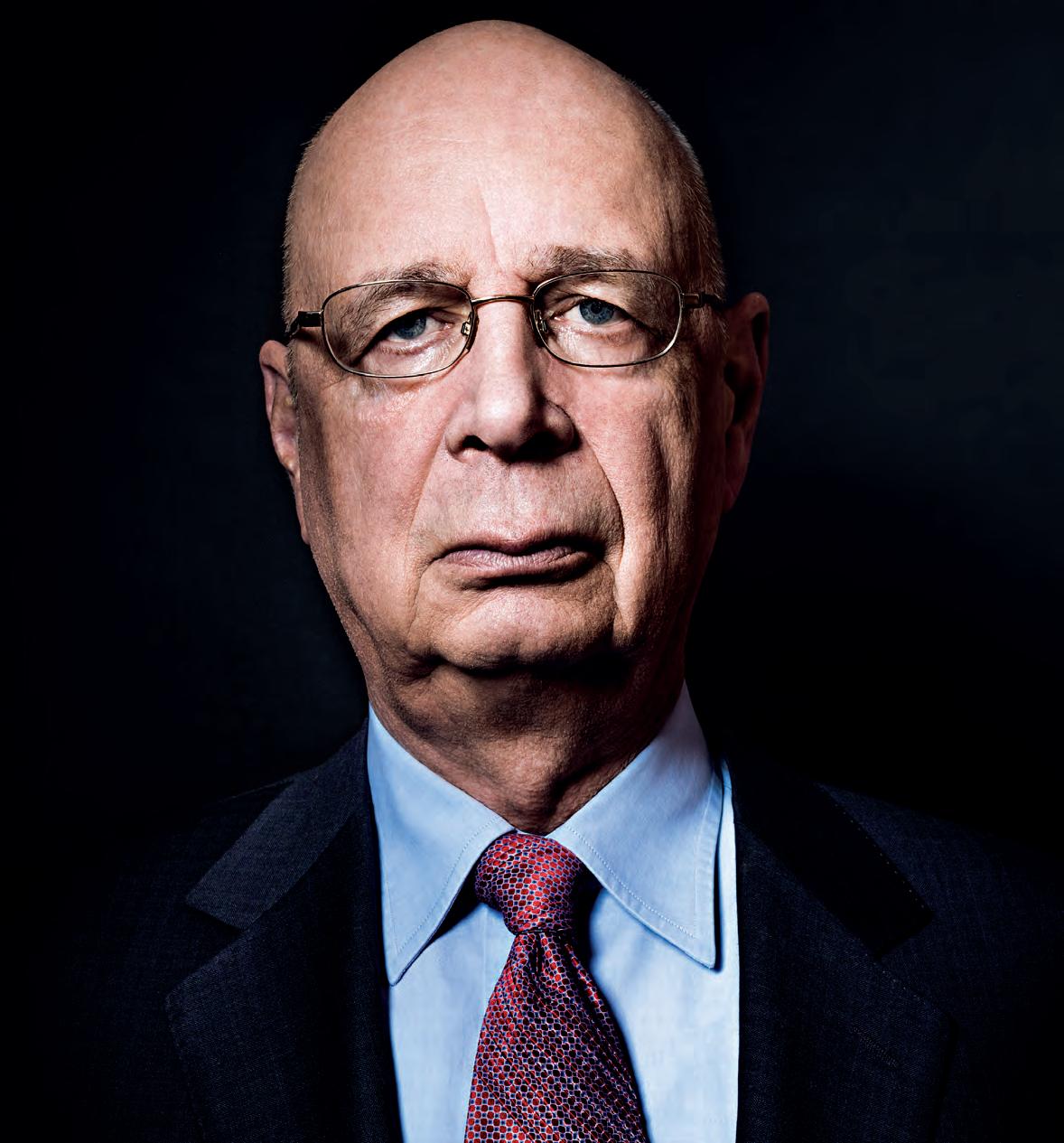




Klaus Schwab, founder of the World Economic Forum, has decided to step down as its executive chairman after more than 50 years. What legacy does he leave?
PUBLISHED BY WORLD NEWS MEDIA
LAWRENCE SUMMERS IAN BREMMER DAVID ORRELL MANUELA FRANCISCO UK £4.95 CAN $15.75 FRANCE €6.50 ITALY €6.50 GERMANY €15.00 BENELUX €10.95 SPAIN €7.00 USA $8.99
DANIEL GROS HOWARD DAVIES
Summer 2024 | worldfinance.com THE VOICE OF THE MARKET Plus ASSET MANAGEMENT ELECTRIC VEHICLES PROXY CONTESTS PRIVATE EQUITY LYNN MARTIN PENSIONS GOLD
THE ORIGINAL INFLUENCER












The Best Investment Bank in Brazil, Chile, and Colombia.
We thank our clients for their trust.

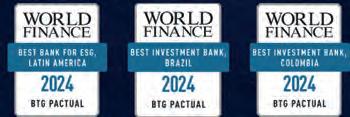

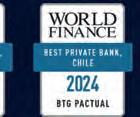

Actively participating in the sustainable development of the economy, o ering customized solutions and innovations with positive impact on society and the planet, with the best ESG (Environmental, Social, and Governance) practices that reinforce our commitment to deliver, in Latin America, the best experience as a Private Bank, Investment Bank, and ESG, aligned with our values.



Management Forum in 1971. He will soon stand down as chairman having helped shape the global agenda over five decades
66 Walking through a storm
The phenomenal growth in the Private Equity market has fallen foul of the Fed’s interest rate rises over the past couple of years, with high borrowing costs knocking investor confidence and leading to a slump
DESIGNER: Sam Millard
REpRoGRaphER: Robin Sloan
pRoDucTIoN MaNaGER: Richard Willcox
WEb aND MobILE DEVELopMENT
Scott Rouse
VIDEo pRoDucER: Paul Richardson
EDIToRIaL: Deborah Cicurel
Antonia Di Lorenzo
Laura French
Courtney Goldsmith
Adrian Holliday
Jemima Hunter
Alex Katsomitros
Claire Millins
John Muchira
Selwyn Parker
Rachel Richards
Hannah Smith
Sara Ver-Bruggen


must implement sustainable policies, businesses must reduce their carbon footprint and investors must choose wisely
114 Lighting the fuse on debt
Over the past 50 years, global debt has tripled, leading many economies into debt distress. To avoid detonating the global debt supercycle, nations must invest borrowed funds wisely and learn to live with less
coNTRIbuToRS: Ian Bremmer
Prof. John Coates
Howard Davies
Vikki Davies
Manuela Francisco
Catherine Gooderham
Daniel Gros
Nick Hodgson
Emma Holmqvist
David Orrell
Maryam Shahvaiz
Lawrence Summers
Peter Vindevogel

accouNTS: Gemma Willoughby
ILLuSTRaToRS: Richard Beacham
Jim Howells
buSINESS DEVELopMENT:
Bryan Charles
Tom Crosse
Michael Harris
Terry Johnson
James Watson
Monika Wojcik
The EU’s recently introduced AI Act is the first piece of legislation aimed at providing a regulatory framework to address the risks associated with the use and misuse of artificial intelligence amid its rapid growth
164 The Seine approach to hosting
Reluctance often creeps into Olympic Committee hearts when factoring in the cost of hosting. However, Paris is looking to take gold this summer with private sector funding and a low build, low spend approach
The information contained within this publication has been obtained from sources the proprietors believe to be correct. However, no legal liability can be accepted for any errors. No part of this publication may be reproduced without the prior consent of the Publisher.
Front cover photo of Klaus Schwab
© Henry Leutwyler/Contour by Getty Images
Editorial on pages 30–37, 74, 112 & 156 © Project Syndicate, 2024
6 | Summer 2024 Contents Summer 2024 x.com/WorldFinance Facebook.com/WorldFinanceMag Linkedin.com/showcase/World-Finance-Magazine YouTube.com/WorldFinanceVideos
World Finance World News Media Ltd 40 Compton Street London EC1V 0BD, UK Tel: +44 (0) 207 253 5100 Web: www.WorldFinance.com Email: enquiries@wnmedia.com © World News Media Ltd, 2024 Printed in the UK - ISSN 1755–2915
38 66 90 114 138 164
9
22
24 Financial History
We look back over the history of currency, from the bartering systems used millennia ago to digital currency today
26 Profile
Lynn Martin is the President of the NYSE, the world’s largest stock exchange. We explore the journey she went on to get there
30 Comment
Daniel Gros on global ‘slowbalisation,’ Howard Davies on global capital rules, Lawrence Summers on the climate crisis and Ian Bremmer on the role of NATO
170 The Econoclast
Immigration is useful, but it doesn’t necessarily equal a better economy
96 Trading
A record-setting rally in gold reinforces its reputation as a safe haven asset to wait out stubborn inflation and geopolitical risk
Despite a market cap in the trillions, crypto is still searching for stable regulatory footing 106 Intellectual Property
The European Patent Office sets its sights on a more equitable patent system for all
108 Africa
Currency reform in struggling nations is necessary to stabilise debt burdens and reverse the exodus of foreign investors
110 Germany
Productivity growth and an aging workforce urgently need to be addressed amid a turbulent geopolitical climate
112 International Development
The weakest economies need ambitious domestic reforms and to do this they require financial and policy support from abroad
44 Regulation
Proposed banking reforms in the US have provoked outcry but could determine a global shift in capital regulations
48 Digital
The transformative effect of technology in Macau bodes well for its banking industry
56 Cooperative
A bank owned by its customers can focus more completely on supporting their aims
58 Nigeria
A challenging macroeconomic environment has tested the nation’s banking sector
62 Sri Lanka
Following its worst-ever crisis in 2022, the country has been navigating a hard path back to recovery
64 Taiwan
Through system optimisation, talent cultivation and sustainable initiatives, one bank has reinvented itself
120 Dubai
Climate change looks likely to exacerbate extreme weather events and recent floods have exposed poor contingency planning
126 India
The natural resources sector is acting as a catalyst for India’s economic resurgence and helping to shape an eco-conscious future
128 Packaging
Sustainable packaging relies on biodegradable and compostable materials
130 Supply Chains
War and climate change are threatening waterborne trade routes with longer transit times adding significantly to shipping costs
132 Proxy Contests
A lack of integrity in corporate elections must be addressed by Congress and the SEC
134 Technology
Immersive VR and mixed reality is contributing to consumers’ desires for more personalised and interactive experiences
72 Private Equity
Prof. John Coates discusses how to tackle the problem of outsized index funds and runaway private equity
74 Debt Management
Meaningful progress in managing debt is within reach for low-income countries
76 Private Banking
Including a look at Nigeria’s new generation of HNWIs and how the future of the private wealth industry is shaping up
80 Pensions
Mexico is moving towards a more inclusive financial landscape with the introduction of several new measures aimed at pensions
82 Luxury Sector
A new generation of consumers will drive the sector to new heights over the next decade
84 Asset Management
An appetite for responsible investing is helping to satisfy ethically minded investors
144 Electric Vehicles
Recent EV market growth has opened up tantalising opportunities for savvy investors
146 Sustainability
The transition to a lower-carbon economy will heavily depend on powerful initiatives and innovations in the transportation sector
156 Clean Energy
Guyana has a unique approach to funding green growth through its vast oil reserves
158 Solar Power
Force majeure events must be considered when investing in solar photovoltaic projects
160 Management
Diversity at the top contributes to unique perspectives and better business outcomes
Summer 2024 | 7 The 2024 World Finance Awards can be seen on pages 122–124 Regulars Markets Analysis Strategy Banking Wealth Management
The Ledger Financial news, expert opinion and analysis of the financial markets
Global Review Analysing the Human Development Index
104 Cryptocurrency





A leading investment and private bank in the Nordics.



Carnegie Private Banking is a leading Nordic investment and private bank. We provide tailored wealth management services to private investors and entrepreneurs, along with access to unique investment opportunities and top-rated equity research.
Our long heritage dating back to 1803 gives us the experience to succeed. We have market leading expertise in stock brokerage, tax, law, pension and financial planning. Based on a holistic understanding of our clients’ individual wealth management needs and objectives, our committed team proactively advises them on their entire financial situation.
Carnegie Private Banking is where knowledge and capital connects.
Visit us: www.carnegie.se/privatebanking

Private Banking


Trading blows
The uK-owned Rubymar cargo ship sinks in the Red Sea following a missile attack by houthi rebels. With an estimated 12 percent of global trade passing through the Suez canal, disruption of shipping routes can quickly become a costly affair, with longer routes transiting the cape of Good hope contributing heavily to shipping costs.
Summer 2024 9 The Ledger buSINESS
FIScaL DIGEST columnists | insights | appointments | mergers & acquisitions | markets | statistics | global review | financial history
NEWS &
A revolution or a risk?




In april, Foxconn – one of Apple’s largest suppliers –announced a surprising shift in its executive leadership team. The company said it would introduce a rotating chief executive position in the hopes of building strong succession pathways and boosting corporate governance by separating the roles of cEo and chair. The move is a significant and fairly unusual step for the world’s largest contract electronics maker. but chairman Young Liu stressed that developing in-house talent is crucial for sustainable development. Through the setup, a rotating cast of cEos “can further understand operations of the company,” he said, by overseeing the six core businesses – including smartphones, personal computers and televisions.
Foxconn joins a small group of businesses that use a rotating cEo system, the most notable of which is Chinese tech firm huawei. Since 2011, the business has rotated its CeO every six months. In 2012, founder ren zhengfei admitted the change was a gamble, “huawei hasn’t found a way to adapt well to a rapidly changing society. Time will tell if the rotating cEo system is the right move or not.” over a decade on, it seems to be working. In April, huawei reported a soaring net profit to outpace rival apple.
Those embracing the rotating cEo idea are quick to point to the benefits. Financial services conglomerate aMTD Group said rotating its cEo would “create a much more diverse workplace” and “bring renewed energy and inspiration.” For paris-based insurtech start-up lovys, a rotating co-CeO role offered the opportunity for increased collaboration and personal development. At Poland’s digital games marketplace Kinguin, founder Viktor Romaniuk believed the shift would “bring fresh perspectives on prioritising and solving any issues the company faces, and overturning these complexities.” however, questions remain. Might the introduction of cEo responsibilities – on top of their current workload – encumber executives? Is six months enough to accomplish substantial innovations? Will they get a fair crack at the cEo whip, or just be kept busy? It will be worth waiting and watching to see whether Foxconn’s rotating cEo – and others like it – stick around long enough to see substantial results. If huawei’s success is anything to go by, the gamble may be worth it.
To REaD MoRE FRoM WoRLD FINaNcE coLuMNISTS, VISIT: www.worldfinance.com/contributors

Big tech is braced for downgrade
After technology giants experienced a boom in profits over recent years, warning bells are ringing. The “surging” earnings momentum that drove their huge growth over the last year is expected to “collapse” over the coming quarters, said UBS Global Research. The bank downgraded its rating of the ‘big six’ tech stocks, including Apple, Amazon, Google-owner Alphabet, Facebook-parent Meta, Microsoft and Nvidia.
The growth in earnings per share (EPS) of these stocks is expected to fall to 15.5 percent by the first quarter of 2025 (see Fig 1), down from 42 percent in the same period this year. The downgrade from ‘overweight’ to ‘neutral’ was not based on extended valuations or doubts about artificial intelligence (AI), Jonathan Golub, chief US equity strategist for UBS Investment Bank, wrote in a note to investors. “Rather, it is an acknowledgement of the difficult comps and cyclical forces weighing on these stocks.” While the warning might seem stark, the decline constitutes a normalisation following unprecedented cyclical waves
Aware that the warning of profit collapse may seem not to take into account factors like the buzz around aI, Golub reiterated it “simply refocuses the conversation on the cyclical nature of this profit cycle, and its pandemic origins.” In fact, while mega-cap tech firms are set to decline, UBS predicts companies that
caused by the pandemic. Tech stocks’ earnings soared in lockdown, driven by demand for personal computers, online shopping and social media, and then declined when the economy reopened. Profits were boosted again in 2023 thanks to a reduction in costs and easier comparables that peaked in the fourth quarter.
did not feel as sharp an impact during covid will perform considerably better. By the first quarter of 2025, gains of 25.5 percent are expected for the so-called ‘rest of tech’ stocks, up from 11 percent in 2024, and 19.4 percent growth for non-tech stocks, up from a decline of 3.3 percent this year.
10 | Summer 2024 The Ledger Summer 2024
insights columnists
VOICE of the maRkEt
TEch+
UBS projections on EPS growth
includes retail, media and home entertainment n Q1 2024 estimates n Q1 2025 estimates
Fig 1
SOURCE: UBS
42.2 BIG tECh+RESt OF tECh+S&P 500 EX- tECh+ 15.5 11.1 25.5 -3.3 19.4
Courtney Goldsmith
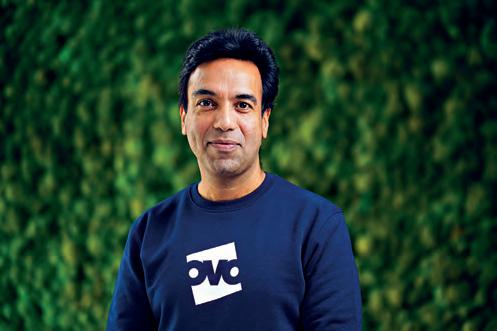
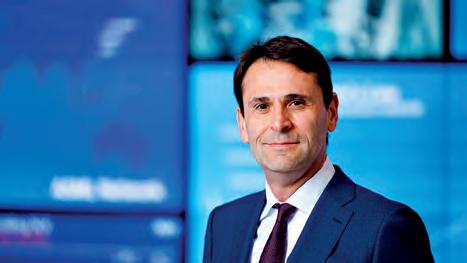 Raman Bhatia CEO
Starling Bank
Raman Bhatia CEO
Starling Bank
British neobank Starling Bank poached Raman Bhatia, CEO of energy firm OVO, to become the group’s chief executive. Founder Anne Boden, who stepped back from the role in 2023, said she believed Bhatia would “take Starling into its next phase of growth.” Bhatia holds an MBA from Harvard Business School, and before working at OVO was the head of digital banking for HSBC’s retail banking and wealth management business in the UK and Europe. Bhatia said he had long admired Starling “because it believes passionately, like I do, in using the power of tech to do the right thing for its customers and its people.”
VoIcE oF ThE MaRKET
Leaving oVo, a tech-led energy disruptor, bhatia brings a unique skillset blending consumer technology, fintech and banking. Starling bank is hoping the experience will drive forward its plan to continue capturing a larger share of the retail banking market. The appointment may also stir excitement for a public listing, which was shelved after boden left.
Christophe Fouquet CEO ASML
Europe’s largest technology company, ASML, welcomed Christophe Fouquet as its new chief executive. Based in the Netherlands, the fi rm provides hardware, software and services to chipmakers for smartphones, cars and more. “I am very happy to be able to write the next chapter of ASML and to continue to build significant value for our shareholders,” Fouquet said at the company’s annual meeting in April. A 15-year ASML veteran, Fouquet replaces retiring CEO Peter Wennink, who oversaw the company’s stratospheric growth, in which its share price rocketed to give it a valuation of more than €300bn.
VoIcE oF ThE MaRKET
Wennink suggested he expects more growth under Fouquet’s leadership. “people have been telling me recently, ‘you are retiring at the height of the company’s form’,” Wennink said. “No, we are not even in the middle.” but Fouquet faces an immediate challenge, with the company firmly in the middle of a trade war between china and the uS.
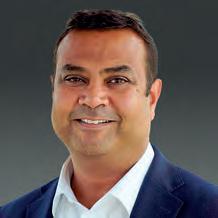 Manmohan Mahajan CFO Walgreens Boots Alliance
Manmohan Mahajan CFO Walgreens Boots Alliance
The global drugstore chain named Manmohan Mahajan as its permanent CFO amid a string of leadership changes aimed at boosting the fi rm’s healthcare business. The announcement, CEO Tim Wentworth said, “solidifies the leadership team that will carry WBA into its future as we look to expand our reach into the fastest-growing areas of healthcare.” James Kehoe, former CFO, stepped down in 2023, and WBA named Mahajan its interim global finance head. He has since “played an integral role” aligning cost structure with business performance, including increasing cash flow and lowering cap ex.
VoIcE oF ThE MaRKET
Since 2016, Mahajan has worked his way up from chief accounting officer at WBA. Strong financial nous will be critical as the company expands beyond its core business in pharmacies. after losing market share to rivals during the pandemic, Wba acquired healthcare services operator VillageMD and urgent-care provider Summit health.
The power of tariffs?

Joe biden has announced several barricades on chinese imports. More than $18bn of chinesemade goods will be hit by fresh US tariff s. But will American voters buy it in an election year? let’s kick away some puffery. china barely sells any electric vehicles to the uS, for example. biden has previously said he does not want a trade war with china. and he does not want more inflationary pressure on US consumers. China’s economy is in bad shape and exporting its way out of trouble, flooding overseas markets with product, is one way of compensating for domestic weakness.
Chinese ‘product’ isn’t the flimsy tat it was two decades ago. Its electric vehicles are well built and skillfully marketed. Earlier this year Elon Musk reportedly told analysts that if trade barriers aren’t established “china will pretty much demolish most other companies in the world.”
as it is an election year that trade gap is especially sensitive. according to the uS census bureau, the US imported $427bn in Chinese goods in 2023 but exported $148bn back. Pennsylvania and Michigan, with big manufacturing and industrial voter bases, tend to appreciate tough tariff talk and sentiment formerly taken up by Trump with gusto, now repackaged by biden.
For Biden, it is a more ‘targeted’ approach in key industries while Trump is about tariff s across the board, not just from China. A major difference. The irony is that many tariff s previously introduced by Trump were unpopular, driving up prices for many working americans, especially those without a college degree. Yet the uS economy is booming.
The problem is the US consumer doesn’t feel the power of ‘Bidenomics’ – yet – as it’s dominated by massive investment in green manufacturing. Nor does the world. Tariff s will feature big in election talk but, really, it’s about trade-off s, political strategy and calculus.
Europe is increasingly importing supercompetitively priced chinese EVs. If it follows the more protectionist uS language then trade stagnation may follow, with more drag on growth. Covid-19 and russia’s invasion of Ukraine was the starting gun. For now, it is all eyes on brussels.
To REaD MoRE FRoM WoRLD FINaNcE coLuMNISTS, VISIT: www.worldfinance.com/contributors
Summer 2024 | 11 columnists
appointments
Adrian Holliday
Reinvigorated pharma


The new raft of blockbuster obesity drugs has been a shot in the arm (or leg) for the pharma and biotech sectors. The so-called GLp-1 drugs have been flying off the shelves, with shortages reported as production has failed to keep pace with soaring global demand. Goldman Sachs has estimated that up to 70 million Americans will be taking these drugs by 2028, while barclays predicts the market for them will be worth $200bn within the next decade. Their success has propelled the share prices of their makers to new heights.
Novo Nordisk, the Danish pharma company behind Wegovy, Saxenda, and Ozempic, became europe’s most valuable listed company this year. Its shares have risen 270 percent since the launch of Wegovy to the uS three years ago. Eli Lilly, uS-based maker of Mounjaro and zepbound (tipped by one pharma analyst to become “the biggest drug of all time”), increased its annual sales forecast by $2bn in its latest results, and is ramping up manufacturing capacity to tackle supply shortages.
With so much at stake, the race is on to fund research and development which can bring new options to the marketplace. Biotech company Amgen’s shares soared after it announced it is trialling a new monthly injectable called MariTide, designed to help patients maintain weight loss long term.
Pfizer is working on once-daily pill danuglipron, and astrazeneca will pay up to $2bn to chinese company Eccogene to license its experimental pill to treat obesity and diabetes. Novo Nordisk has just signed a deal with US biotech firm Metaphore to develop at least eight more therapies for obesity.
As well as lighting a fire under r&D, obesity drugs have also prompted a wave of merger and acquisition activity which is gathering momentum. In December, roche spent $2.7bn to acquire unlisted obesity drug developer carmot Therapeutics. Last year, Eli Lilly snapped up Versanis bio for its drug which stops loss of muscle mass in GLp-1 patients. Investors take note. as the demand for obesity drugs soars, it seems likely that many more of these smaller producers will become acquisition targets in a reinvigorated global pharma sector.
To REaD MoRE FRoM WoRLD FINaNcE coLuMNISTS, VISIT: www.worldfinance.com/contributors
HSBC sells to RBC in Canada deal
Royal Bank of Canada (RBC) completed its acquisition of HSBC Bank Canada for around $10bn. The deal signifies the merging of Canada’s largest and seventh-largest lenders in order to drive growth in RBC’s domestic business and boost its position on the global stage. “RBC’s acquisition of HSBC Canada expands the depth and breadth of our international banking capabilities and builds our ability to connect Canadians to the global economy,” said RBC’s Neil McLaughlin.
“Through this combination, RBC is now exceptionally positioned as the bank of choice for commercial clients with international needs, newcomers to Canada and affluent clients who need global banking and wealth management capabilities.” At times, it was uncertain whether the deal would go through. A deal of this size had not been attempted in Canada’s banking sector since the 1990s, when RBC’s plan to take over Bank of Montreal was blocked by regulators. The deal had to overcome opposition from environment groups and the Conservative Party of Canada. Canada’s Competition Bureau said the deal was unlikely to hurt competition, but
M&a
Synopsis serves up an ace
In one of the largest tech deals to be announced in recent years, semiconductor design and software maker Synopsys is set to acquire Ansys, an engineering and product design software company, in a cash-and-stock deal valued at $35bn. The companies said the deal would create a leader in silicon to systems design solutions. Technology megatrends like artificial intelligence “are requiring more compute performance and efficiency in the face of growing, systemic complexity,” said Sassine Ghazi, president and CEO of Synopsys. Building on the hype around AI, Synopsys’ share price has grown nearly 50 percent. Ansys, which makes simulation software used to help analyse products across a range of industries, was behind the software used to create products from aeroplanes to Novak Djokovic’s tennis rackets.

would “result in a loss of rivalry.” As a condition of the acquisition, RBC agreed to create a global banking hub in Vancouver, donate one percent of net income before taxes to communities and provide $7bn in financing for affordable housing construction across Canada. For HSBC, the deal was part of the bank’s plan to focus on growth in Asia. “The reality is that HSBC Canada only has a market share of around two percent, and we cannot prioritise the investment needed to grow it further,” HSBC group chief executive Noel Quinn said. It follows the bank’s sale of its retail banking activities in France in early 2024.
M&a
Firm’s assets acquired
Labcorp scooped up Softbank-backed Invitae Corp’s assets following the genetic test maker’s bankruptcy. Invitae fi led for voluntary Chapter 11 protection in February, and its estimated assets were said to be in the $500m to $1bn range, while liabilities were in the $1bn to $10bn range. All the bankrupt firm’s assets will be acquired on a going concern basis for $239m in cash consideration and non-cash consideration. The transaction will generate around $285m in annual revenue, Labcorp said, with the “vast majority” in speciality testing areas like oncology and rare diseases. “The agreement with Labcorp marks a significant step in our financial restructuring and supports our efforts to continue to deliver innovative and industry leading products and services for healthcare,” said Ken Knight, president and CEO of Invitae.
The Ledger Summer 2024
mergers & acquisitions 12 | Summer 2024 columnists
Hannah Smith

Furious farmers

Farmers march in protest in Madrid, demanding answers to the many problems facing the agricultural sector. historic drought in the Iberian Peninsula, insufficient government proposals and inflexible eU policy have contributed to gross production value projections of $44bn in 2024, down from $68bn in 2022.
news in pictures Summer 2024 | 13




































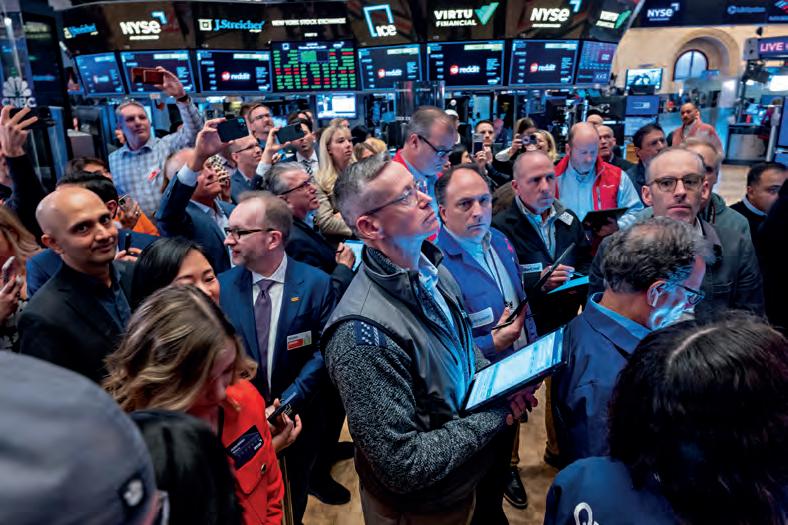
What DORA means for board members
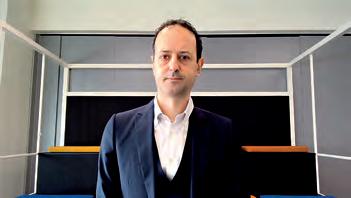
operational t, is the European regulation created to ensure financial services providers across Europe can defend against the ever-changing threats to their IT capabilities. Rather than specifying technical requirements based on the current cybersecurity landscape, it sets the principles for businesses to follow. In this way they can manage the risks presented by GenaI, post-quantum cryptography, and whatever comes next.
“You need to stay at pace with what is happening – you cannot rely on a standardised list of threats,” said Fabio Colombo, Accenture’s Global Cybersecurity leader for Financial Services. “These threats need to be evaluated each year, each quarter, to make sure that you are managing correctly your perimeter and your maturity in this area.”
IPO activity continues to rebound
Markets have kicked off 2024 on a “cautiously optimistic” note, with 287 deals in the first quarter, raising $23.7bn, according to EY’s report, Global IPO Trends Q1 2024 (see Fig 1). By number, the top three sectors for Initial Public Offerings (IPOs) were industrials, consumer and technology sectors. The financial sector, on the other hand, saw a “substantial decrease” in the number of IPOs that performed well.
The trends seen in the first quarter of the year were a “major shift” in the global IPO market share from the past five years, said George Chan, EY global IPO leader. However, he warned, “As 2024 unfolds, participants in the IPO market are entering uncharted territory.” Looking forward, there is significant interest around artificial intelligence (AI). Many of these companies are still in the early stages of funding, but they could bring a wave of IPOs in the coming years.
“IPO candidates are influenced by the recent pivot in investors’ preference toward proven profitability in an altered interest rate landscape and are doing this while facing the
SOURCE: EY
intricate dynamics of an intensified geopolitical climate and the buzz around AI,” Chan said. “To succeed in this shifting environment, IPO prospects must remain flexible and prepared to seize the right moment for their public debuts.”
“one goal of the regulation is to bring enough level of accountability in the financial institution – starting with the board of directors, down to the cEo and then to the c-suite and all employees," he explained. "but the important part is that the board of directors and c-suite and cEo need to be trained.”
This training, he stressed, can’t just be academic: as well as learning about and understanding the latest cyber risks, the board must actively practise managing the threats they pose to their company.
“And you can do that by having these two different forms of exercise,” said colombo. “one is a tabletop exercise, simulating a crisis that is started as a cyber incident. and the second one is by participating as the white team in the threat-led penetration testing that is a pillar of DoRa regulation.”
Although targeted at financial institutions, the act will also affect third parties that provide ICT services to them – including accenture itself. “We studied the DoRa regulation, the RTS, the ITS [the Regulatory and Implementing Technical Standards],” said colombo. “We did a gap analysis because we already have a good set of standards and procedures that come from our global company. but we need to understand if there is any gap or good practice that we need to put in place.”
The act will apply from January 2025.
To FIND ouT MoRE: www.worldfinance.com/videos
Summer 2024 | 15 The Ledger Summer 2024
markets
The trading floor of the New York Stock Exchange
videos
Global IPO activity NumbEr of ipos Fig 1
Fabio Colombo
2,600 2,400 2,200 2,000 1,800 1,600 1,400 1,200 1,000 800 600 400 200 0 2020 202120222023 Q1 2024
Nearshoring hopes far from fruition
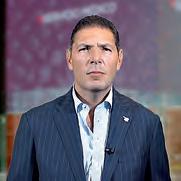
The nearshoring trend has failed to yield the dividends expected for Mexico, according to a recent Reuters report. Rising costs of materials and real estate, as well as creaking infrastructure, have slowed the influx of foreign uS manufacturers bringing their production closer to home in response to postpandemic supply chain disruption.
This was part of the risk matrix that Mexican commercial bank Grupo Financiero Banorte identified in its Zoom Nearshoring report, published in 2023, and discussed by banorte chairman carlos hank González in a video interview with WorldFinance . Industrial growth due to nearshoring represents a structural change, the report said, and a number of challenges could stem that growth before it truly begins: from poor infrastructure putting a hard cap on any real capacity growth, to low educational attainment reducing the effectiveness of local human capital. These challenges, the report continued, must be addressed in a ‘four-helix’ model that includes government, the private sector, education institutions, and society.
“These entities need to work together to maximise the potential benefits of nearshoring,” González explained. “From improving public infrastructure to fostering policies that incentivise investments, the ‘four-helix’ model aims to bring comprehensive development to Mexico.”
"The potential gains of nearshoring for Mexico could reach up to $168bn of additional non-oil exports in the next five years," he said. "Our research department has identified the industries that are most likely to grow due to nearshoring, including agriculture, machinery, and electronics, to name a few. We’re adding 1,200 jobs to specifically support these growing industries, [and] building technological capabilities to create fully digital environments that will serve the needs of newly established companies in Mexico."
but the country is yet to see any real growth or nearshoring benefit. A report by Deloitte found that FDI has remained at three percent of Mexican GDp for the last 10 years, and a minority of Mexican companies have reported any increase in demand due to nearshoring. To FIND ouT MoRE: www.worldfinance.com/videos
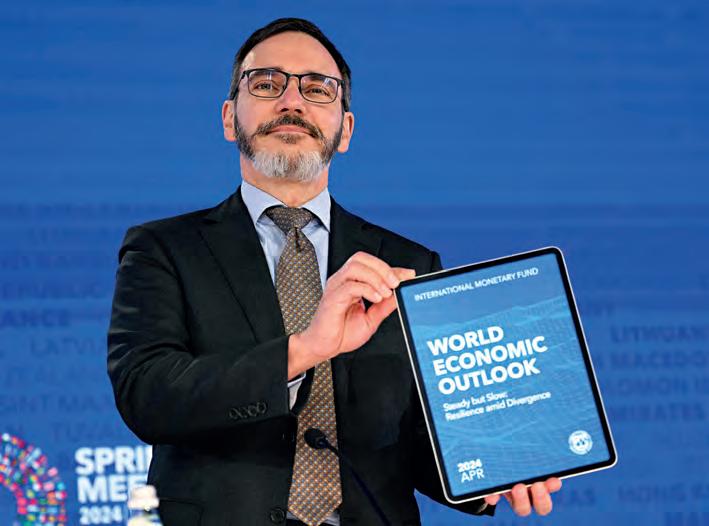
Resilient markets showing growth
but steadily in the coming years, the International Monetary Fund (IMF) said in its World Economic Outlook report in April, largely thanks to the driving force of the US economy. The Washington, DC-based group slightly revised up its forecast of global growth at 3.2 percent for 2024 and 2025, matching the level of growth in 2023. The global economy has shown “remarkable resilience,” said PierreOlivier Gourinchas, the IMF’s chief economist. He cited stronger-than-expected activity in the US, China and other large emerging economies – but not, notably, in Europe. Risks to growth remain centred around inflation, as Gourinchas said progress towards targets had stalled, and there is geopolitical instability in the Middle East and Ukraine.
Going forward, more work must be done to “rebuild fiscal buffers to guard against future shocks, make room for priority investments, and to ensure debt sustainability,” Gour -
With the US fiscal deficit forecast to stay elevated, interest rates and the dollar will also be pushed up, contributing to tighter funding costs throughout the rest of the world. What makes debt levels even more concerning is the fact that history shows governments spend more and tax less during election years.
inchas said. Indeed, US and Chinese fiscal debts were found to be a concern in the IMF’s semi-annual Fiscal Monitor report. In the US, a deficit of 7.1 percent is expected to be recorded next year, while in China, high debt is a concern amid weak demand in the country’s housing crisis. These countries must “address fundamental imbalances between spending and revenues,” the IMF warned. Four years after unprecedented responses to the Covid-19 pandemic, public debt and deficits remain higher than usual – even rising slightly in 2023 after falling in 2021 and 2022. Only half of the world’s economies tightened fiscal policy in 2023, down from about 70 percent in 2022. “Looking ahead, global public debt is projected to approach 100 percent of GDP by the end of the decade,” said IMF director of fiscal affairs department Vitor Gaspar. In China and the US, he said, public debt is now higher and expected to grow faster than prepandemic projections.
Deficits in election years tend to exceed forecasts by 0.4 percentage points of GDP, the IMF reported – and 2024 happens to be an exceptional year for elections, including in the uS, India and the uK . With much at stake, the IMF urged governments to exercise financial restraint in order to preserve public finances.
16 | Summer 2024
Summer 2024 insights videos
The Ledger
Carlos Hank González
V OICE of the ma R k E t
International monetary Fund
Chief Economist pierre-olivier Gourinchas















Building bridges
The Maanshan Yangtze River highway and Railway bridge under construction in Maanshan, Anhui province, China. It is the world’s first threetower cable-stayed bridge with dual main spans exceeding one kilometre and the world's longest steel-girder cable-stayed bridge. The project is expected to cost around $1.3bn.
Summer 2024 news in pictures 18 | Summer 2024
The Ledger
SCI-FI FUTURE
The value of the global AI market is expected to hit $1.3trn by 2030, with generative AI models, self-driving cars, humanoid robots and plenty beyond propelling the industry to new heights. From AI adoption rates by country to the sector’s contribution to global GDP, we look at the stats behind this booming industry, and the business sentiment surrounding its rapid growth trajectory.
AI adoption rates across the globe n Deployed aI n Exploring aI
Projected growth of the global AI market from 2020-2030 n Total n computer vision n aI robotics n Machine learning n Natural language processing
Artificial intelligence market size
Top ways business owners use artificial intelligence
statistics Summer 2024 19
56%
HOW THEy CURRENTLy USE OR PLAN TO USE AI WITHIN THEIR BUSINESS
USD $ BILLIONS
Sou R c E S statista.com, precedenceresearch.com, ibm.com, marketsandmarkets.com, bluetree.digital, goldmansachs.com, mckinsey.com, forbes.com 37% ESTIMaTED coMpouND aNNuaL GRoWTh RaTE oF ThE GLobaL aI MaRKET FrOM 2023 TO 2030 76% oF coNSuMERS aRE coNcERNED abouT aI cauSING MISINFoRMaTIoN 64% oF buSINESSES ExpEcT aI To IMpRoVE cuSToMER RELaTIoNShIpS aND INcREaSE pRoDucTIVITY 58% oF chINESE coMpaNIES aRE uSING aI 14% The FINANCe INDUSTry’S MaRKET ShaRE IN aI $184bn Value of the global aI market in 2024 400 million The number of workers that could be displaced by aI $1.3trn projected worth of the global AI market by 2030 97 million The number of people expected to work in the AI space by 2025 Customer service australia India Spain canada Italy uaE china Latin america uK France Singapore uS Germany South Korea Global 24% 28% 58% 31% 34% 57% 42% 29% 39% 22% 31% 38% 26% 25% 34% 44% 48% 30% 44% 44% 27% 41% 43% 46% 46% 45% 40% 47% 43% 42% Cybersecurity/fraud management 51% Digital personal assistants 47% Customer relationship management 46% inventory management 40% Content production 35% product recommendations 33% accounting 30% Suppply chain operations 30% recruitment and talent sourcing 26% Audience segmentation 24% $2,575 2032 $2,156 2031 $1,807 2030 $1,516 2029 $1,273 2028 $1,070 2027 $900 2026 $757 2025 $638 2024 $538 2023 $454 2022 2020 2023 2026 2021 2024 2027 2029 2022 2025 2028 2030 7%/
projected increase in global GDp as a result of generative aI
$7trn

Together, we achieve more.



As the 8th largest bank in North America by assets 1, we’re fueling progress for individuals, families and businesses. We’re proud to be recognized as Best Private Bank, Best Commercial Bank and Best Retail Bank in Canada; and Best Commercial Bank in the US by World Finance Magazine.
1
As of January 31, 2024
The price to be paid for unsustainability

The Biscay Bridge first opened in 1893. Spanning the estuary of lbao in Spanish basque country, it was a unique design: a gondola, suspended by steel cables from a mechanical trolley running the length of the high bridge, would carry up to six cars and 200 people from one side of the river to the other.
after its completion, many similar bridges were built around the world, but few survive. The biscay bridge, however, has been in continuous operation since it opened. Now a uNESco heritage site, the bridge operates 24 hours a day. It has transported an estimated 650 million people since it opened; its gondola travelling the equivalent of 31 trips around the earth.
And in November 2023, BBK broke it.
“The biscay bridge… is a symbol of the progress of the basque country,” bbK chairman xabier Sagredo told our sister publication EuropeancEoin a video interview. “We wanted to reflect on it, by ‘breaking’ a part of the bridge, how if we do not take into account this concept of sustainable competitiveness, our progress will fail.”
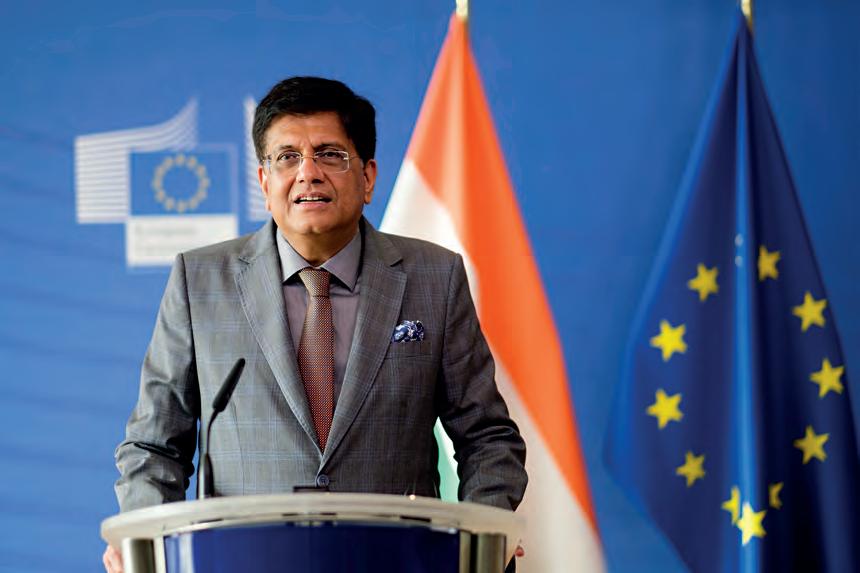
India achieves $100bn investment
bbK is a private banking foundation. once a savings bank, it was forced after the financial crisis to divide into a banking entity (now called Kutxabank) and a banking foundation that divests its investment income into biscay through the largest per capita social work programme in the state.
Sustainable competitiveness is BBK’s guiding principle. It’s a model “that aspires to generate the greatest contribution of value to all its stakeholders and the society in which it operates,” explained Sagredo: sustainability must be at the heart of competition, or we risk a race-to-the-bottom that jeopardises our progress.
“Take a sustainable company and a non-sustainable company. Is it fair to compare the prices they charge? one will be lower, but at what cost to the workers, or environment, or society? It leaves a price to be paid.”
This simple idea – the price to be paid – lends its name to BBK’s latest art installation on the Biscay Bridge: 60 cubic metres of display screens, installed 50 metres above the river, creating the illusion of a broken bridge.
To FIND ouT MoRE: www.europeanceo.com/videos
A trade deal has been negotiated between India and four European countries that will see the world’s most populous country lift a majority of import tariffs on industrial products in return for an investment of $100bn over 15 years. The deal sealed nearly 16 years of negotiations with the European Free Trade Association (EFTA) – an intergovernmental organisation of Switzerland, Norway, Iceland and Liechtenstein – and is part of Prime Minister Narendra Modi’s aim to boost annual exports to $1trn by 2030. It also follows deals inked with Australia and the United Arab Emirates, while another trade deal with Britain is said to be in its final stages.
Trade minister Piyush Goyal confirmed in March that India would lift or partially remove its high customs duties to drive investment in its market of 1.4 billion people. Of the trade deal, he said, “It is a modern trade agreement, fair, equitable and win-win for all five countries.” It is hoped the deal will boost
The news of the landmark trade deal comes as the World Trade organisation forecast a gradual rebounding of global trade in 2024, with a further rise in 2025 as the impacts of high inflation ease. af ter a larger-than-expected 1.2 percent decline in
exports for a range of industries in India, including manufacturing, machinery and pharmaceuticals, as well as driving investment in automobiles, food processing, railways and the financial sector.
The news came ahead of India’s general elections, where, at the time of writing, Modi was seeking a record third term with his Bharatiya Janata party (BJP). Members of the EFTA – which has a combined population of 13 million and a gross domestic product of more than $1trn – also stand to benefit. India is the group’s fifth-largest trading partner, with two-way trade reaching an impressive $25bn in 2023.
In Switzerland, the largest member of the bloc, manufacturers of machinery, transport and luxury goods like watches will see increased opportunities, while elsewhere in the EFTA makers of pharmaceutical and medical devices, processed food and drink and engineering products are expected to benefit.
2023, global trade volumes are now expected to increase by 2.6 percent this year and a further 3.3 percent next year, according to the WTO’s Global Trade Outlook and Statistics report. While geopolitical risks remain, the rebound is expected in large part thanks to growth in trade in Europe.
The Ledger Summer 2024 Summer 2024 | 21 videos
Xabier Sagredo
V OICE of the ma R k E t
indian minister of Commerce and industry piyush Goyal
Uneven progress
The split between rich and poor countries is growing, according to the latest Human Development Index, published by the United Nations. By measuring each country’s gross national income (GNI) per capita, education and life expectancy, the index shows how well and how long people live
1 Switzerland (Rank 1)
Leading the HDI with the highest level of human development was Switzerland. With a score of 0.967, the country boasts a life expectancy at birth of 84 years, and children entering school age now are expected to receive 16.6 years of education. The high score represents Switzerland’s stable government, strong economy and quality education and healthcare, and it exceeds its pre-Covid score. In fact, all 38 countries in the Organisation for Economic Co-operation and Development achieved higher scores compared to their pre-pandemic levels. Since 1990, Switzerland’s HDI value has grown by nearly 14 percent, with GNI per capita growing over 21 percent.
2 Ukraine (Rank 100)
Despite the ongoing war with Russia, Ukraine remains in the ‘high level of human development’ category. However, its HDI fell to the lowest level since 2004. While development has proved resilient, Jaco Cilliers, the United Nations Development Programme (UNDP) resident representative in Ukraine, warned that challenges still lay ahead. “We still don’t know the full impact of the invasion on Ukraine, due to the difficulty of collecting data, particularly in occupied areas,” Cilliers said. “But the overall picture is a challenging one for Ukraine, and action and support will be required to mitigate adverse effects and keep Ukraine on the path to sustainable development.”
3 Chile (Rank 44)
The Latin America and Caribbean region (LAC) improved more than any other region. However, despite the impressive and significant growth, it still failed to reach pre-pandemic levels of progress. Chile notched a score of 0.860, the highest in the region. Nine in 10 people value democracy in the LAC, the UNDP found, but there is growing dissatisfaction, especially among women and vulnerable populations. The region is also experiencing the most rapid rise in political polarisation in the world, and, according to a recent Latinobarómetro survey, trust in institutions has decreased quite significantly, with only one in five people expressing trust in their government.
Ranking in the ‘low human development’ classification, Afghanistan’s Human Development Index was the lowest in the South Asia region. The country achieved its highest ever level in 2019, but in the years since, the score has been knocked back by 10 years. The country’s Gender Development Index (GDI) took a particularly hard hit, with all measures falling over the last year. It comes after the Taliban regained power in Afghanistan in 2021, creating what Human Rights Watch called “the world’s most serious women’s rights crisis.” At the global level, Afghanistan’s Gender Development Index ranks as the secondlowest in the world, above only Yemen.
4 Afghanistan (Rank 182)
22 | Summer 2024 world finance Global Review 3
No data Low Very high high Medium
5 Montenegro (Rank 50)
Montenegro maintained its proud position among the countries with ‘very high human development’ for an impressive seventh year running. The country scored a value of 0.844, which represents a 12.7 percent jump since 2003. The Gender Development Index has also increased by around 65.4 percent in that same period of time.
The Gender Development Index score, which measures the gender differences between female and male, found the value for women on the HDI was 0.833, compared to 0.852 for men. The measure of gender inequality placed Montenegro 33rd out of 166 countries. Women were found to live longer but overall received less time in education.
6
South Sudan
(Rank 192)
At the bottom of the Human Development Index, ranking in next-to-last place, was South Sudan. The country moved up one place from the previous year, but its score has fallen even lower. Between 2010 and 2022, the country’s HDI value fell 6.2 percent, while life expectancy at birth and expected years of schooling inched up slightly. However, the GNI per capita in the period dropped 44 percent. The UN discovered that all developing regions failed to meet their anticipated HDI levels based on the trend before 2019.
“It appears they have shifted to a lower HDI trajectory, indicating potential permanent setbacks in future human development progress.”
7
Hungary
(Rank 47)
Hungary sat within the ‘very high human development’ ranking, with an HDI value of 0.851. After falling in the previous two years, Hungary’s HDI rose in the latest index. However, human development is not plain sailing for the country. The UN’s report cites research indicating that countries with populist governments have lower GDP growth rates. “15 years after a populist government assumes office, the GDP per capita is found to be 10 percent lower than it might under a non-populist government scenario,” it said. Viktor Orbán has led Hungary for 14 years, turning the country into what the European Parliament called a “hybrid regime of electoral autocracy.”
Kyrgyzstan
Moving up one place from the previous year with a score of 0.701, Kyrgyzstan slightly improved its position in the latest HDI ranking. The growth lifted it into the ‘high human development’ category, moving it even closer to other regional peers such as Uzbekistan (106th), Turkmenistan (94th), Azerbaijan (89th) and Armenia (76th). For the most part, the improvement was down to growth in its GNI per capita score, which increased by more than five percent in the period. Positive changes were also seen in life expectancy and in the distribution of human development within the country. However, the gender gap in human development remains a problem issue.
8
(Rank 117)
Summer 2024 | 23 world finance Global Review
1 2 4 5 6 7 8
SOUrCe: hUMAN De velOPMeNT INDe x 2024
The evolution of mon€y
From millennia-old bartering systems to modern-day paper currency, cards and crypto, money has undergone something of an evolution since its earliest days in ancient Mesopotamia. Here we trace the history of currency across the world, and how trading systems have adapted, grown and transformed throughout the centuries to reflect the changing nature of societies.
6,000 BC
3,000 BC

rtering laid the foundations for modernday money more than 8,000 years ago – beginning with Mesopotamian tribes in the Middle East, who would trade produce, labour and other essentials for livestock and vice versa. The phoenicians and babylonians also created their own bartering systems, exchanging goods across cities. Later, as humans began travelling more, spices, shells, precious stones and other goods started to take over.
1816

Exchanging cumbersome physical commodities was eventually replaced by symbolic representations of value. In ancient Mesopotamia, symbols were inscribed onto clay tablets to represent debts, simplifying trading systems as societies grew. This created a new way to do commerce, and paved the way for the emergence of coins and paper money that was to follow more than 2,000 years later.


the ‘lydian Slater’ was the first coin to be officially issued by a government. chinese coins meanwhile featured a hole in the middle so they could be strung together for bigger transactions. coins later began to circulate in ancient Greece; gods were traditionally depicted, until alexander the Great made an appearance, setting the stage for rulers to feature.

1900

In 1816, england adopted the gold standard – meaning notes issued by the bank of England represented a certain amount of gold that owners could exchange for bullion. A British pound was defined as 113 grains of gold, although the rate varied according to the cost of shipping. proponents of the system argued that by limiting the number of notes printed, it would prevent inflation, and give measurable backing to the country’s currency.
countries began adopting the gold standard – including the uS, which introduced the Gold Standard Act in 1900, allowing global trade to flourish. however, governments realised relying on finite reserves would stall growth; Britain stopped using the gold standard in 1931, followed by the uS two years later. It was eventually replaced by the modern Fiat system, meaning money would be backed by the state rather than by physical gold.
1950s

difficult. Around the 10th century AD, merchants in china started to use paper receipts as a lighter way to do commerce. under the Song Dynasty, certain shops were given permission to give out the receipts; the government then started to issue receipts themselves, marking the world’s first official paper currency. This made global trade significantly easier.

Money underwent its next major transformation in the 1950s, when credit cards emerged in the uS – in the form of charge cards issued by the Diners’ Club. In 1958, American express launched a paper charge card, while bank of america introduced the bankamericard. uK banks soon caught on, and debit cards emerged in the 70s and 80s. The launch of point of sale terminals and then chip and pin technology made card transactions easier.
Bitcoin was born in 2009, signifying the world’s first decentralised cryptocurrency. It was followed by multiple others, with annual trading volume in crypto reaching $82.12trn in 2022. Several governments have since piloted their own central bank digital currencies, from China’s digital yuan to Sweden’s e-krona – marking a fascinating next step in a system that first began more than eight millennia ago.
24 Summer 2024 world finance Financial History












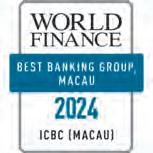
Breaking from tradition
From teaching herself to code to being named the boss of the world’s biggest stock exchange, Lynn Martin is now one of the most powerful women in finance. Can she use her roots in tech and data to bolster the New York Stock Exchange in a time of volatility?
At the turn of the millennium on Wall Street, there was a feeling in the air that anything was possible. The dotcom bubble was growing and companies like Amazon and Google were beginning to reshape how we use technology from a useful tool to an integral part of everyday life. Tech was also fast becoming a key force underpinning financial markets, and someone who was taking notice was Lynn Martin, a programmer at IBM who had just graduated from Manhattan College with a degree in computer science and a passion for writing code. As a lover of puzzles, it was no surprise that Martin soon developed an interest in the mathematics of financial markets, leading her to gain a master’s degree in statistics from Columbia University and leave IBM for the New York Stock Exchange’s (NYSE) derivatives business.
Today, technology is even further entangled in global financial markets, which means Martin’s unique blend of skills and experience make her a fitting boss for the world’s largest stock exchange. When she was named president of the NYSE in late 2021, two decades after beginning her career there, Martin said she was “floored” – and not only because of what the promotion meant for her future. “I was honoured, mainly because I understood the gravity of being asked to do this role as a woman and what it represents to have the confidence of a Fortune 500 CEO and entrepre-
neur whom I have admired for years,” she said, referring to Jeff Sprecher, chair and CEO of Intercontinental Exchange (ICE), which owns the NYSE. The appointment of a woman with Martin’s vast experience and potential opens the door to even more innovation for the exchange, Carole Crawford, chair of the board of directors for the non-profit 100 Women in Finance, told World Finance. Indeed, Martin is the first to admit that her route from computer programmer to exchange boss was not a traditional career path that girls could follow when she was young.
From Commodore 64 to the Big Board
While Martin was growing up on Long Island in Smithtown, New York, her parents did something that changed her life: they brought home a Commodore 64 computer. “That initial exposure to computers turned into a college major, got me my first job, and then created the cornerstone of my career,” Martin wrote in an op-ed for Fortune in January 2022, just as her tenure as president of NYSE began.
Martin’s first full-time job as a programmer at IBM during the dot-com boom put her at the heart of a pivotal moment in the tech industry, and her early experience with technology instilled a lifelong “appreciation for the value of data and what technology can create,” she wrote. This understanding catapulted her from “that girl who loved to code” on Long Is-
Lynn Martin IN NuMbERS
$40trn
The combined market cap of companies listed on the NYSE
$4.4bn
ICe’s exchanges segment’s revenue in 2023
$25trn
The value of the entire NYSE portfolio as of December 2023
23
Years Martin has worked at NYSE and its parent company IcE
land right into the centre of the action in lower Manhattan, heading up one of the world’s most significant exchanges. Her familiarity with technology is one of Martin’s superpowers, and she is keenly aware that succeeding at the NYSE “will require me to look both forward and back, to view the future through the lens of my unique experience and to help guide an iconic institution in an uncertain age.”
Martin came to the top job at the NYSE at a time when the economy was still reeling from the pandemic. Two years in, and while Covidrelated issues are fading, the exchange is under increasing pressure from rival Nasdaq, which beat the NYSE in the battle for initial public offerings (IPOs) in 2023 for the fifth consecutive year.
Lynn Martin
pRESIDENT, NYSE
world finance Profile
26 | Summer 2024
“I don’t accept the phrase ‘We’ve always done it that way.’ Because with that mindset you don’t grow and innovate”
Lynn Martin
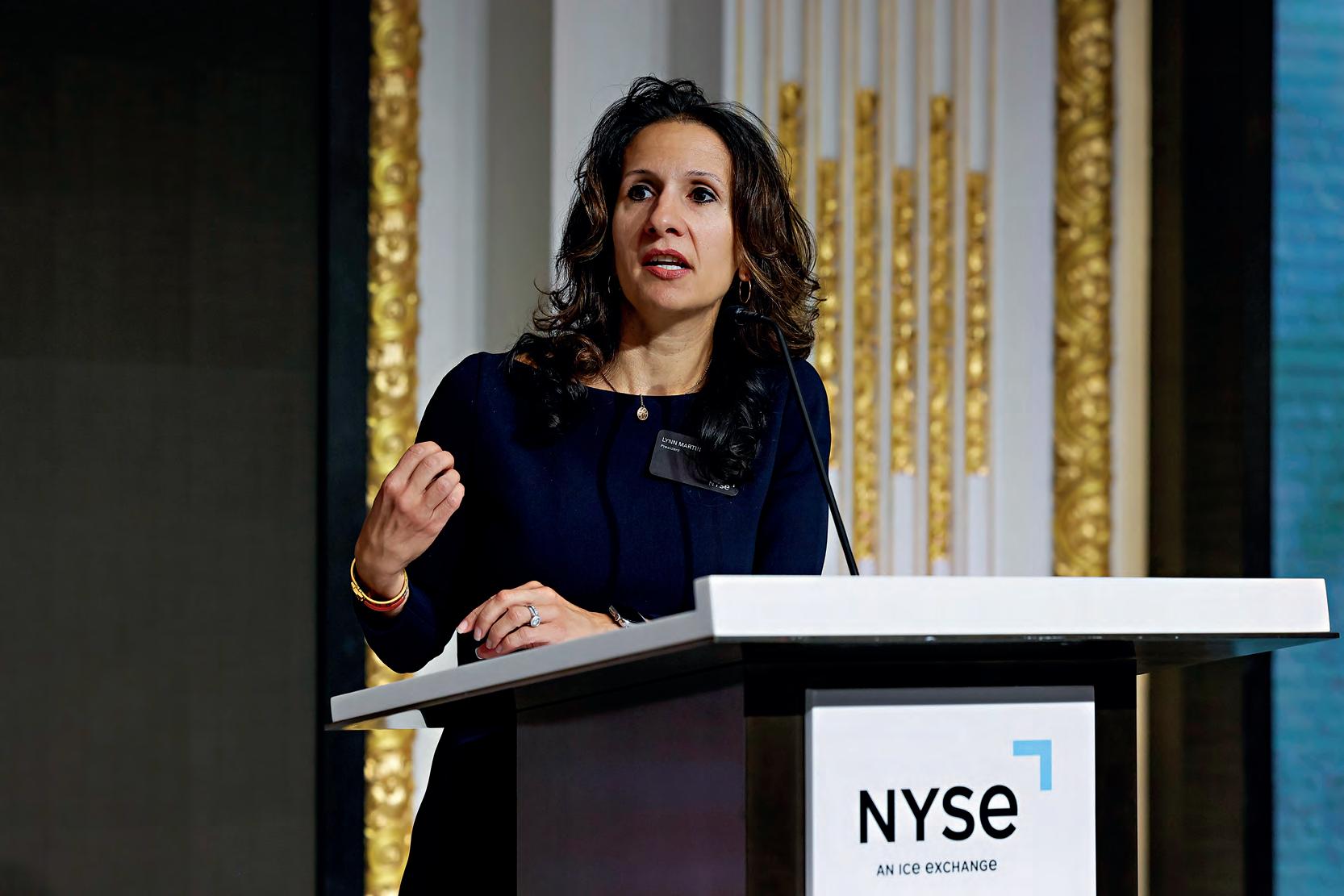
CurriCulum viTAe boRN: 1976 | EDucaTIoN: MaNhaTTaN coLLEGE, coLuMbIa uNIVERSITY
1998 after graduating from Manhattan college in 1998 with a bachelor of science degree in computer science, Martin would go on to gain a master’s degree in statistics from columbia university.
2001
Martin joined technology giant IbM as a consultant within its Global Services unit shortly after graduating. She worked there until 2001, when she made the switch over to the NYSE.
There is also the rapidly shifting landscape for environmental, social and governance (ESG) standards to contend with, and the small task of ensuring that global firms continue to see the US capital markets as the most attractive place to take their business. Martin is tackling the challenges head-on, applying her unique brand of data-driven insights to come up with new ways for the NYSE to work. In ICE’s fourth-quarter earnings for 2023, its exchanges segment posted a 16 percent rise in revenue to $1.1bn, equating to half of the total company revenue in the quarter.
Recalling the first time he spoke with Martin in 2013, just after ICE acquired the NYSE in a massive $8.2bn deal, CEO Sprecher said, “I remember thinking about how bold and determined she was. And I liked that about her.” It is what led him to appoint Martin, who had been working in the NYSE’s listed derivatives
2008
As COO of NySe liffe (London International Financial Futures and options Exchange) from 2008 to 2013, Martin was the main point of contact from an operational perspective.
2013
After spending 10 years across senior customer and business development roles and as coo at NYSE liffe US, Martin was named cEo of the futures and options exchange in 2013.
business at the time, to run Interactive Data, a market data company that ICE bought for $5.2bn in 2015. Although the business had potential, growth was lagging, and Martin was challenged with improving its prospects. She did this and then some, proceeding to double the company’s growth rate and build it into ICE’s multi-billion-dollar fixed income and data services segment. However, considering current market challenges, the NYSE still faces hurdles. Despite earnings from the exchange business helping ICE to beat Wall Street’s fourth-quarter expectations, the listings segment declined by four percent due to a lacklustre market for IPOs. IPO proceeds in the US reached $23.9bn in 2023, according to Jessica Chen and Joel Rubinstein, partners at White & Case, but this was less than half of the $62.6bn in proceeds seen pre-pandemic in 2019.
2015
Following on from ICe’s purchase of NYSE, Martin was named president and coo of Ice Data Services, where she managed the global data teams and also the platforms of the firm.
2022 after taking her next step as president of the Fixed Income and Data Services division, Martin was then named president of the entire NYSE Group, a role she has now held for the last two years.
While 2023 was yet another year of stubbornly low IPOs, experts say the tide could finally be turning this year. So far, 2024 was off to a good start, Chen and Rubinstein said, and what’s more, “the US’s position as a global magnet for cross-border listings has remained undiminished,” with listings like Germany’s Birkenstock on the NYSE securing a market valuation of $8.6bn. “It is hoped that the steady performance observed post-IPO and across US stock markets generally will encourage more companies to pursue IPOs in the coming months,” they added, noting that the Renaissance IPO Index, which tracks the performance of companies that have listed within the past three years, rose 44 percent in 2023, beating the S&P 500. Plus, there is strong interest in the technology sector, where deals involving chipmakers and artificial intelligence (AI) are gathering momen- »
world finance Profile Summer 2024 | 27
tum. In March, social media platform Reddit went public after a long-awaited IPO, and on the first day of trading, shares jumped 48 percent. “The IPO markets are definitely opening back up,” Martin told CNBC in April. “Deals are getting done,” she said, adding that these were “really optimistic signs for the IPO market.”
The issue, then, is attracting them to the NYSE over its rivals. Between January 2018 and July 2023, the NYSE’s market cap for domestic listed companies grew from $23trn to $25trn, according to data from Statista. Meanwhile, Nasdaq’s shot up from $11trn to $22trn. Nasdaq, which has a reputation for being the ‘tech exchange,’ boasts lower listing fees and costs, which can attract smaller companies. NYSE, meanwhile, is associated with a sense of prestige and history – executives who list on the exchange have the opportunity to ring its famous opening bell in front of live traders. Yet as Mark Mandel, chair of Baker McKenzie’s North America capital markets group, told the Financial Times, choosing between the two is like picking between a Bentley and a Tesla: “You won’t go wrong with either, but companies, like people, tend to gravitate towards certain brands.”
Blazing a trail
Becoming president of the NYSE, Martin had big shoes to fill. She replaced Stacey Cunningham, who was the first woman to lead the exchange in its more than two centuries of operation in 2018. Following ICE’s acquisition of NYSE, Cunningham “embraced the challenge to reinvent a global icon,” Sprecher said. The NYSE’s entire portfolio was worth more than $25trn as of December 2023, including four fully electronic stock exchanges and two options exchanges. Running this operation requires a skill set balancing strong leadership with in-depth knowledge of the fundamentals of its systems.
As a leader, Martin is focused on innovation. “I don’t accept the phrase ‘We’ve always done it that way.’ Because with that mindset you don’t grow and innovate,” she said in a NYSE Communications release. In a sign of her openness to new ideas, the NYSE revealed in April that it was polling market participants on round-the-clock trading. The poll followed news of start-up 24 Exchange, backed by Steve Cohen’s Point72 Ventures fund, going to the Securities and Exchange Commission (SEC) for approval to launch the first 24-hour exchange. Such a move could shake up US stock markets, which, unlike cryptocurrencies or even US treasuries and major currencies, don’t operate at all hours.
As someone who has continually been at the cutting edge of a rapidly growing indus-
try – and as a trailblazer herself – Martin is in tune with the bold thinking needed to in novate in financial markets. In 2013, she was named CEO of NYSE Liffe US, the American division of NYSE Euronext’s international derivatives business. Having worked her way up from COO of the firm and senior vice president at NYSE Euronext, the appoint ment made her the first woman to head a US exchange since the 1980s. Martin didn’t know about this milestone until it was pointed out to her in an interview with John Lothian News, but she did not shrug off the landmark moment, saying it made the appointment spe cial “not just from a professional standpoint, but also from a personal standpoint.”
Martin continued, “When I was growing up, my mom and my grandma always used to say to me that I was so fortunate to be born when I was born, at a time when a woman had all the opportunities in the world in front of her. Being reminded of that every day forced me to work hard throughout my life, and it motivates me to continue to work hard, and also to be thankful for any opportunities that are presented to me, because women in the past didn’t always have those opportunities.”
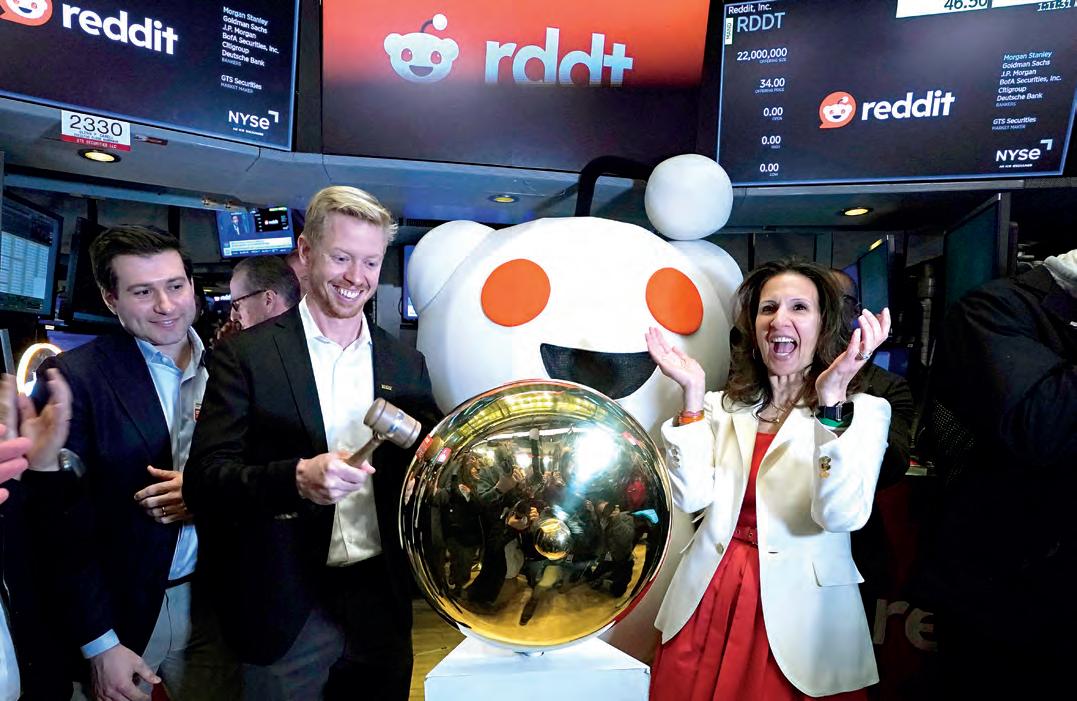
Within global financial services institutions, as of 2021, women held 21 percent of board seats, 19 percent of C-suite roles and just five percent of CEO positions, according to the report by Deloitte, Advancing more women leaders in financial services. While progress has been made over the past two decades, the report’s authors concluded that these efforts must continue, as inaction could reverse hardwon gains by as soon as 2030. “These statistics illustrate that more work needs to be done to advance gender equity across the industry,” they said. To find evidence of this, one does not have to look far. In April, a Wells Fargo employee accused the company of an “unapologetically sexist” workplace, the latest in a slew of lawsuits against large US banks related to their treatment of women employees. Other suits have been lobbied against the likes of Citigroup and Goldman Sachs, the latter of which agreed to pay $215m to settle a class action lawsuit alleging widespread bias against women in pay and promotions.
What’s more, the independent think tank the Official Monetary and Financial Institutions Forum found in its Gender Balance Index 2023 that progress is very slow going. At the current rate, it will take 140 years to achieve parity between men and women in leadership positions in the industry, it found.
However, Deloitte’s report identified an important caveat: when there are enough women in leadership ranks at the organisational level, there is strong evidence for the ‘multiplier effect,’ whereby for each woman
added to the C-suite, there was a positive, quantifiable impact on the number of women in senior leadership levels just below the Csuite. “For decades, companies have focused largely on activities to improve the pipeline for DEI [diversity, equality and inclusion] efforts. Based on our findings related to the multiplier effect it is equally, if not more, important to focus on diversity at the highest levels of the organisation to drive progress and improve the overall pipeline of diverse talent,” said Neda Shemluck, Deloitte’s US financial services industry DEI leader. “In the finance industry, female role models are not just desirable, they are imperative,” Crawford of 100 Women in Finance said. “Their presence not only inspires confidence and ambition in aspiring women but also challenges the status quo, driving much-needed diversity and innovation.”
“Lynn Martin,” she told World Finance, “is a trailblazer whose journey exemplifies the immense potential of female talent and reaffirms the necessity of ensuring representation of women at every level of leadership in the industry.”
The ESG question
One of Martin’s core guiding principles is her belief that ESG considerations are only growing in importance in the US market. ESG is “top of mind for virtually every public company CEO and board of directors,” Martin wrote in Fortune. And the reason was not, she said, government regulations or quotas, but instead “the free market at work.”
Ioannis Ioannou, an associate professor of strategy and entrepreneurship at London
world finance Profile 28 | Summer 2024
»
lynn Martin with reddit CeO Steve huffman ringing the NySe bell

Business School, agreed that businesses – and investors – are recognising the importance of addressing ESG. “The impacts of climate change, resource scarcity, and shifting consumer preferences because of these issues pose significant risks to companies’ operations, supply chains, and overall business models and strategies,” he told World Finance “Therefore, businesses cannot afford to ignore these challenges; addressing ESG issues is crucial for building resilience, cultivating innovation, and maintaining a competitive edge.” Andreas Hoepner, a professor at University College Dublin’s School of Business, identified the biggest ESG issues of the moment as: carbon emissions, the energy transition, the gender power gap and responsible AI. He said these areas of focus are becoming “increasingly important in fundraising and risk management.”
NYSE and ICE are keenly aware of the way the market environment has changed over recent decades. In a note to staff in late 2021, Sprecher outlined what $130trn worth of finance commitments pledged by the private sector to address climate change at the COP26 gathering in Glasgow meant for ICE, saying it “provides great opportunity in many areas of our exchanges segment.”
Today, investors are demanding that companies pay close attention to issues like climate change and diversity, and shareholders are making their voices heard through their investment decisions. “Investors recognise that environmental, social, and governance issues pose genuine risks to a company’s business model, performance, and long-term viability,” Ioannou said. “Therefore, they are
looking for ESG data that effectively captures these risks and enables them to make wellinformed choices.”
As a financial data scientist, Hoepner told , he regularly checks updates on corporations’ individual risks filed with the SEC – which he is seeing more and more of. “Filing risks on key ESG issues and even greenwashing accusations themselves keep rising at considerable pace,” he said.
However, the quality, accuracy and comparability of this data “still leaves significant room for improvement,” Ioannou said. Especially at a time when ‘anti-ESG backlash’ in the political domain has led some companies to take a more cautious approach to ESG issues – at least publicly – to minimise the risk of ideological targeting, Ioannou said. “Given the current political climate, I expect the term ‘ESG’ to become more contested in the US during this election year, even as the approach remains pragmatic and necessary in other parts of the world, with the EU leading the charge,” he added.
Yet despite these challenges for ESG investing, Martin remains a big believer in the work the NYSE can do to boost transparency. It’s an area Martin has direct experience with, having helped to create databases that tracked board diversity, climate risk and other ESG measures as part of her previous role at ICE.
Ioannou said he expects the current quality and accuracy of ESG data to continue improving as issues like climate change, biodiversity loss, societal issues and political division underscore the need for robust ESG risk management, enabling more informed decision-making by companies and investors alike. And with more transparent data will come increased interest from investors. “As these efforts progress, I believe that ESG considerations will inevitably become a core component of investment decision-making,” Ioannou said.
In 2022, Martin put another stake in the ground when she launched the NYSE Sustainability Advisory Council. The council brings together select sustainability leaders within the NYSE community of more than 2,400 listed companies to identify and share global best practices addressing ESG issues. “The NYSE Sustainability Advisory Council is designed to help companies navigate this complex and evolving terrain,” Martin said in a press release about the council’s launch. Chair Elizabeth King added that the group hoped to leverage the power of the NYSE community to “raise all boats and advance the identification, development and adoption of best practices at organisations of all sizes.”
As Martin wrote in Fortune, “The Fearless Girl statue stands vigil outside the NYSE and
reminds us every day that while there is still much work to be done, ESG-driven risk management is here to stay, and will only become a larger factor in the years ahead.”
What is next?
While Martin has taken a tech-led approach to issues like ESG investing, the creation of the Sustainability Advisory Council shows she recognises that it is people working together that make the difference in business. “Data and technology allow each of us to do much more, much faster, but at the core of any successful enterprise is people collaborating toward common goals,” she wrote in her oped. “It is important that we keep this in mind as we move into a future that will demand the best combination of humanity and processing power that we can muster.”
To do this in practice at the NYSE, she takes a collaborative and open approach, inspiring colleagues to work together across business lines in order to inspire innovation and creative thinking. For Sprecher, Martin’s transparency with colleagues was a key reason he has kept her as part of his inner circle. “When she took that job running our data division, I would periodically receive an unsolicited communication from her that told me exactly what was going on in the business,” he said. “She is very organised and she shares a lot of data and information with others. She is very transparent, which builds a level of trust and endearment that very few people really have.”
In 2022, Martin launched a new initiative to build trust further, not only within the NYSE, but within US capital markets on the world stage. “As the world’s largest stock exchange with a storied history of more than 230 years, the NYSE has a unique platform and substantive role to play as a leading advocate for capital formation around the world,” said Martin at the launch of the NYSE Institute. The institute was created to use the NYSE’s resources, expertise and relationships to support public companies, advance sound public policy and foster economic growth around the world. “The NYSE Institute provides us with a new structure to formally advance this agenda and offer a strong voice supporting the innovative work of our listed companies and the markets we operate,” Martin said.
Martin has long used her voice to champion her core beliefs around the values of technology in our modern world, the importance of transparency of ESG risks and the resilience of US capital markets. As her position as president of the NYSE amplifies her voice further than ever before, executives, exchanges and business leaders around the world are sitting up and taking note. n
world finance Profile Summer 2024 29






The hidden costs of ‘slowbalisation’
The imposition of trading tariffs, most notably between the US and China and those sanctions made against Russia, have radically shifted the global trading pattern, but for those who prioritise geopolitical strategy and put up barriers to trade, it could end up costing them dearly
The emergence of an open multilateral trading system that separated trade from geopolitics played a pivotal role in driving the postWorld War II economy. But with trade policies increasingly shaped by geopolitical considerations, a new paradigm is becoming visible.
This trend started with the tariffs that former US President Donald Trump imposed on Chinese imports in 2018, which President Joe Biden’s administration has maintained, and which caused China to impose its own tariffs on imports from the US. Then, in 2022, following Russian President Vladimir Putin’s invasion of Ukraine, G7 countries and the European Union imposed sweeping economic sanctions on Russia, effectively prohibiting exports to Russia and imports of Russian goods. Instead of causing global trade to fall, as many expected, these trade barriers and restrictive measures merely slowed down globalisation, turning it into ‘slowbalisation.’
Remarkably, despite the war in Ukraine and the supply-chain disruptions of the past few years, trade as a percentage of GDP reached a record high in 2022, underscoring
the resilience of the international trading system. In fact, the increases in containershipment prices since 2022 can be attributed to an unexpected surge in the volume of goods being shipped globally. But while it may be tempting to argue that geopolitically motivated measures have had a negligible economic impact, the perceived resilience of global trade can be misleading. Although the recent trade barriers led to higher trade volumes, many of them carry significant costs.
At first glance, the notion that a tariff could boost trade may seem paradoxical. But almost all the tariffs and trade restrictions imposed by the US since 2018 have been specifically aimed at China, leaving imports from other countries untouched. Consequently, imports from China have fallen sharply, while imports from countries like Vietnam have surged. Many consumer products shipped to the US are now assembled in Vietnam and other Southeast Asian countries. But these imports still rely on intermediate inputs from China. Consequently, trade volumes have grown because, while US imports of consumer goods
from Asia have remained consistent, China’s exports of intermediate inputs to its Asian neighbours have increased. Similarly, although Mexico has overtaken China as the leading exporter of goods to the US, its own imports from China have surged by nearly 40 percent since 2018.
Trading tolerance
The electric-vehicle (EV) market illustrates how discriminatory practices can boost trade. Tariffs on Chinese EVs are approaching 30 percent, and US regulations disqualify EVs containing components produced or assembled in designated ‘entities of concern’ from receiving tax credits, effectively excluding Chinese manufacturers from the American market.
By contrast, European EVs are subject to a significantly lower tariff of 2.5 percent and qualify for a $7,500 subsidy under the Inflation Reduction Act when leased. Consequently, Chinese EV exports have shifted to Europe, while European automakers have found success in the US.
world finance Comment
Daniel Gros
DIREcToR oF EuRopEaN poLIcYMaKING aT boccoNI uNIVERSITY
30 | Summer 2024
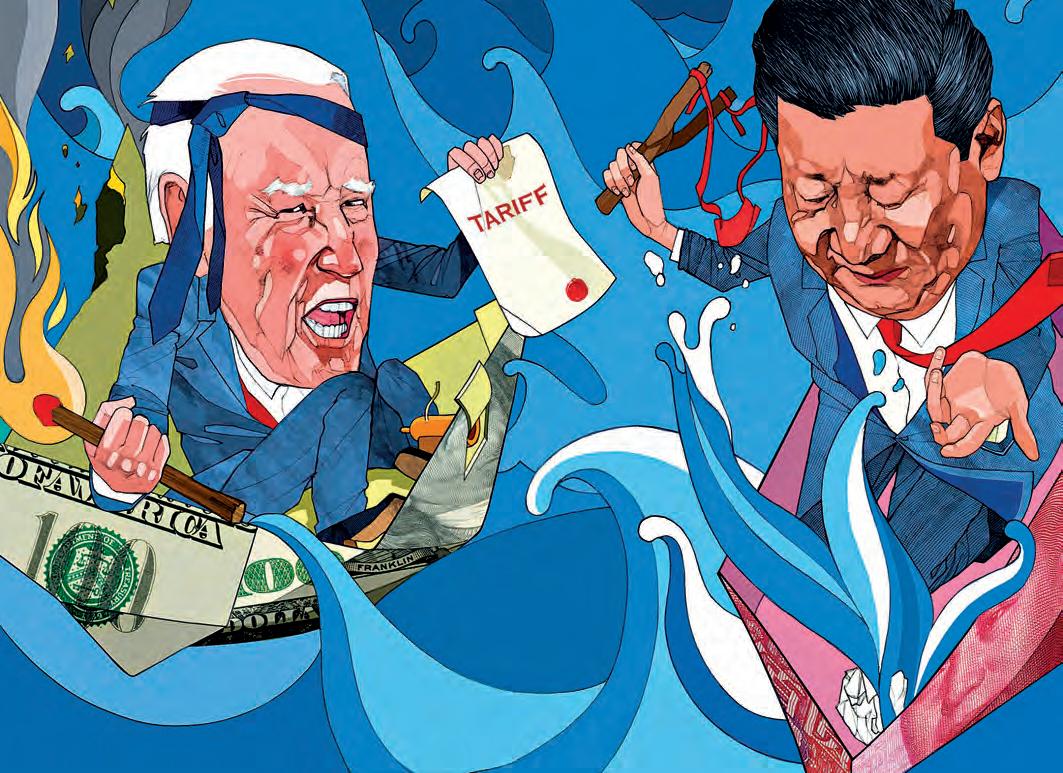
Meanwhile, the EU is undergoing a similar shift. In the wake of Western sanctions on Russia, European exports to Turkey and Central Asian countries such as Kazakhstan and Kyrgyzstan have skyrocketed. At the same time, trade volumes between these countries and Russia have soared. Such methods of circumventing sanctions or discriminatory tariffs result in higher production and logistics costs, as goods must now be shipped to intermediate countries before being transported to the US. Sanctions and discriminatory tariffs can thus boost trade and reduce welfare.
These harmful consequences underscore the importance of the ‘most-favoured nation’ principle that has long been the cornerstone of the global trading system. The concerted efforts to liberalise trade, first through the general agreement on tariffs and trade, and subsequently through the World Trade Organisation, have increased trade volumes and overall welfare thanks to their non-discriminatory approach. By contrast, today’s geopolitically driven discriminatory tariffs and trade barriers explicitly target specific coun-
tries viewed as hostile or as potential threats. Who pays the price? Economic theory – and common sense – provides a clear answer: countries that impose discriminatory trade restrictions end up bearing the costs while the rest of the world benefits. Consequently, the US and China are negatively affected by their tariff war, while Vietnam and Mexico gain by serving as intermediaries.
Similarly, Turkey and Central Asian countries benefit from sanctions against Russia, while the EU foots the bill. This distribution of costs and benefits helps explain the limited international opposition to Trump’s China tariffs. After all, the EU, Mexico, or Vietnam have little incentive to object to a US policy that benefits their own industries.
Consequently, international pressure is unlikely to deter major powers like the US or China from prioritising geopolitical strategies over trade liberalisation. To counter this tendency, it is crucial to make political leaders acutely aware of the adverse effects of trade barriers.
“It is crucial to make political leaders acutely aware of the adverse effects of trade barriers”
As the most open and least geopolitically ambitious of the world’s major economic powers, the EU is likely to recognise this first. But the stakes are much higher for the US and China. The US, in particular, stands to lose the most if it continues its trade war with China. To prevent this outcome, it must change course and return to the non-discriminatory principles that have long underpinned global trade policies. n
world finance Comment Summer 2024 | 31

 Bremmer
Bremmer

Imagining NATO without America
The upcoming US election could have a significant impact for NATO, its outcome potentially shaking up the allegiances of EU member states and threatening Europe’s near-term security
The North Atlantic Treaty Organisation, the most successful military alliance in history, is stronger than it has ever been. Russia’s full-scale invasion of Ukraine in February 2022 underscored NATO’s continuing purpose and value, and the organisation has since added two capable new members: Finland and Sweden. Yet while Russia is steadily losing soldiers, weapons, and its longer-term economic resilience, it is Ukraine, not NATO, that is absorbing Russia’s blows.
What about the future? European leaders know that Donald Trump has a solid chance of winning November’s US presidential election {although his recent criminal conviction may change that}, and that a Trump restoration would cast doubt on the lasting commitment of NATO’s core contributor, along with the credibility of the security guarantees that make the alliance so powerful.
To be fair, the former president has raised some legitimate concerns. After Russia invaded Crimea in 2014, each member state pledged to spend at least two percent of national GDP on defence by 2024. Two months ago, NATO
Secretary-General Jens Stoltenberg announced that, for the first time since the alliance’s birth in 1949, European members will collectively meet that target. But that is only because some states, particularly those closest to Russia’s borders, spend more than their quota. Specifically, 13 of NATO’s 31 members still don’t meet the two percent threshold, and Trump has again called into question their reliability as allies. If they fear Russia so much, he asks, why are they still unwilling to spend two percent of GDP on their own security?
Clear and present danger
Nearly all European leaders recognise the need to spend more, and Trump’s recent taunt that the Russians should “do whatever the hell they want” to under-spenders (who, of course, are among the farthest from the Russian border) has many Europeans wondering what a second Trump presidency might mean for them. Could NATO continue to exist without a clear and credible American commitment?
During ceremonies earlier this month to celebrate the alliance’s 75th anniversary,
Stoltenberg proposed a €100bn five-year fund for Ukraine that would not depend on the outcome of America’s 2024 election. But beyond Ukraine policy, European fears about their lack of readiness have also moved European Commission President Ursula von der Leyen to call for a European defence commissioner.
This would hardly be the fi rst ambitious plan that European leaders have undertaken in recent years. They oversaw the rapid rollout of vaccines during the Covid-19 pandemic, provided emergency relief for governments that needed it, and, after February 2022, launched a costly and complex programme to end dependence on Russia for energy supplies. And they did all this while absorbing the historic numbers of refugees that began arriving around a decade ago.
If they can accomplish all that, why can’t they Trump-proof European security by creating an independent, strongly coordinated European defence industrial policy, supported by the EU budget and the single market? Unfortunately, there are three reasons to be sceptical, at least for the near term.
world finance Comment
oF
Ian
FouNDER
aND pRESIDENT
EuRaSIa GRoup
32 | Summer 2024

The obstacles to security
First, a stronger role for the European Commission in defence and industrial policy will take time to design and implement. During what is sure to be a complicated process, the plan will face opposition from national au-
“A stronger role for the European Commission in defence and industrial policy will take time to design and implement”
thorities who don’t want to surrender control of these policies. That is especially true for members who are concerned that France –the longtime advocate of collective European defence and the only current EU member with nuclear weapons – will have the most power to set the continent’s security policy.
Second, the EU remains deeply dependent on US weapons systems, access to US intelligence, and America’s role as the driving force behind NATO’s interoperability across countries. The continuing threat from Russia will persuade more Europeans than ever to spend more on defence, build intelligence capabilities, and increase the size of their militaries; but these processes will take a decade or more to complete. The present danger won’t allow for such a long transition.
Finally, at least a few European governments would gladly choose alignment with Trump over ever-closer ties with their fellow EU members. Hungarian Prime Minister Viktor Orbán and Slovakian Prime Minister Robert Fico are obvious examples, and in the coming years, we may well see other (and
more systemically important) EU members elect populist, Russia-friendly governments.
Italian Prime Minister Giorgia Meloni has been steadfast in her support for Ukraine, but that might change if Trump returns to the White House. If Marine Le Pen finally becomes president of France in 2027, closer alignment with Trump becomes plausible even in the Élysée, where there has long been a desire for more independent European foreign and security policies.
Beyond the November US election, there’s a longer-term question to consider. If Trump loses, will the drive toward a more isolationist and transactional American foreign policy die with his political career?
Or have new generations of American voters – not old enough to remember the international role the US played, for better and for worse, between 1945 and 2008 – changed American public attitudes toward the ‘global leadership’ that both Democrats and Republicans once insisted the US provide? If so, not even a Biden victory will end the debate within Europe about its own security. n
world finance Comment Summer 2024 | 33









Are global capital rules possible?
Recent updates made by the Basel Committee to its bank-capital rules has sparked vigorous debate leading many to question what these should look like and whether it is even possible for capital rules to adhere to a common global standard
What’s in a name? The final proposals for bank-capital rules were dubbed Basel 3.1, as if to suggest a minor tidying-up exercise – just a few grace notes added to a melody composed long ago. But banks, concerned that the implications would be more severe, spoke of Basel 4, implying not grace notes, but a reworking of the entire composition, now in a major key.
That name didn’t stick. Regulators insisted that it was not a new tune, and that anyone who could sing Basel 3 would have no trouble picking up Basel 3.1. But then, some anonymous practitioner in the American political dark arts came up with the term Basel Endgame, which seems to suggest that someone is about to die. On the eastern side of the Atlantic, the term recalls Samuel Beckett’s play, Endgame, about existential angst and the futility and meaninglessness of human life. Non-bankers might find that to be a good description of the debate over the proper size of big banks’ reserves, which has now been ongoing for many years.
Some countries, like Singapore and Australia, have stopped arguing and just gotten
on with it. In the European Union and the UK, the details are almost finalised. But in the US, the endgame is nowhere near the end – which may even be further away than ever, following US Federal Reserve Chair Jerome Powell’s recent intervention.
Allow me to recount the short version of this tangled tale. It started last summer, when Fed Vice Chair for Supervision Michael Barr put forward some moderately tough proposals calling for sizeable increases in capital. US banks mounted a robust counteroffensive, and now Powell has said that there must be “broad material changes” to proposals that were supported by a majority of Federal Reserve Board members just last year.
The merits of the underlying argument have almost been submerged by the politics. Are some banks right to argue that the Fed’s proposals will put them at a competitive disadvantage internationally? Comparing proposals across countries is very difficult. Barr’s plans, no doubt influenced by the spate of embarrassing US bank failures last year, did envisage a bigger increase in capital than was
planned in the EU, but starting from a lower base. The UK, as ever, is somewhere in between.
Reacting to regulation
Do all these different proposals comply with the original Basel agreement? The Basel Committee will answer that question itself in due time, but it currently looks as though the UK will comply more or less, while the EU will not. Under Barr’s proposals, the US regime would probably have been compliant, and on the tougher side. Now, no one really knows where it will land.
What we do know is that the constitutional arrangements that govern the setting of capital standards for banks are remarkably divergent in the three main Western jurisdictions. In the EU, the European Commission, a political body, holds the pen, because the stability of the single market requires that there not be significant divergences from place to place.
If there were, all banks would be headquartered in the country with the weakest regime and would conduct all their European busi-
world finance Comment
Howard Davies FoRMER DEpuTY GoVERNoR
oF
ThE baNK oF ENGLaND
34 Summer 2024

ness there. Thus, the EU Basel agreements are implemented through directives or regulations that carry the force of law throughout the bloc. Given the circumstances, it is not surprising that the outcome is a deal that may slightly undercut the original Basel agreement. Politicians, as usual, responded to special pleading. The so-called Danish compromise, for example, includes a concession for banks that own insurance companies. It is an open secret that if the European Central Bank was fully in charge, the EU would be compliant with Basel, as the UK plans to be.
Since Brexit, the UK regulator has been alone in the driver’s seat. The government delegated the power to set capital rules to the Bank of England, and though it sometimes sounds as though ministers regret having done that, I doubt the regime will change at this point.
At first glance, the US regime might resemble the UK’s, since the Fed is in the driver’s seat. But the Fed’s board, unlike the Bank of England’s board, is politically balanced, with a majority reflecting the party in power. That
“It will be very difficult to deliver common global standards across different constitutional arrangements”
is why Barr was able to propose his robust package of rules in the first place. But now, argues Peter Conti-Brown of the Brookings Institution, Powell is trying to protect the Fed, rather than the financial system, in the face of strong public criticism. He “appears to prize Fed independence for monetary policy so dearly that he wants to avoid political fights about regulatory policy.”
That argument recalls the longstanding view of Germany’s Bundesbank that an independent central bank should not get into the dirty business of banking supervision. Gordon Brown, as Chancellor of the Exchequer, was acting on the same concern when he moved banking supervision to the Financial Services Authority – which I chaired – in 1997. But then George Osborne chose to reverse the move in 2013.
There are some very strongly held views on both sides of the debate about whether central banks should be responsible for banking supervision. But the way the Basel Endgame is playing out seems to indicate that it will be very difficult to deliver common global standards across different constitutional arrangements.
In Beckett’s Endgame, the character Clov is pathetically desperate to create order out of chaos. “I love order. It’s my dream,” he says. “I’m doing my best to create a little order.” That could be the Basel Committee’s motto as it tries to sell its wares. But like Clov, it may be facing insuperable odds. n
world finance Comment Summer 2024 | 35

 Lawrence Summers
chIEF EcoNoMIST
Lawrence Summers
chIEF EcoNoMIST
The world is still on fire
For all the ramped-up rhetoric on addressing the climate crisis, very little has turned into concrete action. Governments must move away from posturing and turn political will towards averting the worst humanitarian crises
The world is facing the worst five-year span in three decades. Higher interest rates have left developing countries crushed by debt, and half of the poorest economies have not recovered to where they were before the pandemic. Growth is weak across large swaths of the world, and inflation remains persistently high. And behind it all, the thermometer keeps inching up. Last year was the warmest on record, as is true of nearly every month.
For the last several years, world leaders have made big promises and laid out bold plans to mitigate the climate crisis and help poor countries adapt. They pledged that the World Bank would transform itself to work on climate change, and that the multilateral system would get new money and lend more aggressively with the resources it has, including to meet concessional needs.
An agreement between creditors would provide debt relief to countries that most needed it. And where public money was insufficient, the multilateral system would be able to catalyse private investment in developing countries.
Despite the bold rhetoric, 2023 was a disaster in terms of support for the developing world. The private sector collected $68bn more in interest and principal repayments than it lent to the developing world.
Amazingly, international financial institutions and assistance agencies withdrew another $40bn, and net concessional assistance from international financial institutions was only $2bn, even as famine spread. ‘Billions to trillions,’ the catchphrase for the World Bank’s plan to mobilise private-sector money for development, has become ‘millions in, billions out.’
It is little wonder given that World Bank shareholders have not raised capital, substantially changed fi nancing practices, or taken other bold steps.
The International Monetary Fund is on net withdrawing funds from the developing world; the idea of comprehensive debt relief has gone nowhere; and financial defaults have been avoided only by the moral default of slashing both health and education spending considerably.
Getting it right
Setting aside the complex problem of climate change for a moment, world leaders have not even been able to tackle the simplest, most straightforward challenges. War, inflation, and poor governance have brought some of the poorest people – including in Chad, Haiti, Sudan, and Gaza – to the brink of famine, yet the international response has been slow and muted. This is both a humanitarian disaster in its own right and a symbol of our broader inability to act in the face of a crisis.
If the world can’t even get food to starving children, how can it come together to defeat climate change and reorientate the global economy? And how can the poorest countries trust the international system not to leave them behind if that system can’t address the most basic challenges?
Finance ministers, central bankers, and economic leaders recently gathered for the Spring Meetings of the World Bank and the IMF in Washington, DC, where they discussed the global economy and laid out plans to strengthen it. But these efforts will fail if
world finance Comment
FoRMER
oF ThE WoRLD baNK
36 | Summer 2024

rhetoric falls as flat as it did during 2023 in terms of concrete action. Here are four big ideas as to what is necessary:
First; reverse the capital flows, so that the lowest-income countries are receiving more support than they are paying out to private creditors. In the short term, that means expanding the multilateral development banks’ use of innovative financial tools such as guarantees, risk-mitigation instruments, and hybrid capital. In the slightly longer term,
it means stepping up with new money from shareholders – a capital increase for the World Bank and regional development banks, which will require legislative approval in shareholding countries.
Second; transform MDBs into big, risktaking, climate-focused institutions. Development banks have tinkered around the edges with bolder approaches to lending, but it is time for them to scale up those efforts. The wealthy countries that are the biggest shareholders in the multilateral system need to provide the political support for that risk-taking.
to slash its goals for 2024. Stepping up with funding for the several hundred million people without enough food to eat would alleviate a humanitarian disaster and provide evidence to skeptical countries that the international system still can work.
“ World leaders haven’t even been able to tackle the simplest, most straightforward challenges”
Third; fully fund the International Development Association, a highly effective institution that provides much-needed resources to the lowest-income countries. The World Bank’s president has called for the largestever IDA replenishment from donors; given the challenges ahead, the world cannot afford to deliver anything less.
Fourth; tackle food security. Last year, the United Nations was able to raise from international donors only about one-third of what it sought for humanitarian relief, and it had
Half the world goes to the polls this year, from the US and the UK to India and Mexico. Pervasive distrust of governments and their promises is a ubiquitous issue, and we see every day that the idea of an international community is becoming an oxymoron. The conventional wisdom is that foreign policy falls by the wayside as politicians turn their focus to campaigning and to domestic issues that will win them votes.
We dare to hope that historians will look back at the recent meetings as a moment when global leaders seriously addressed global challenges. The problem is not primarily intellectual. Blueprints like that of the G20 expert group we chaired on strengthening the MDB system abound. It is a problem of finding the political will to take on the most fundamental issues facing humanity. n
world finance Comment Summer 2024 37

38 | Summer 2024

The legacy of The original Davos Man
The founder of the World Economic Forum and the brain behind its exclusive annual meeting in Davos, Klaus Schwab, is stepping back from his executive duties – but his impact will continue to ripple through the industry long after he leaves the world stage »
Words by: Courtney Goldsmith
Summer 2024 | 39
every year, thousands of the world’s foremost leaders and business elite trek to the snow-capped mountains of Switzerland. In the Alpine town of Davos, geopolitical issues are hashed out, economic priorities are outlined and revolutionary technologies are debated on the global stage. The World Economic Forum’s (WEF) annual meeting each January is a must-attend event for anyone who’s anyone in the corporate world.
Synonymous with the event itself is engineer and economist Klaus Schwab, its 86-year-old founder. The not-for-profit organisation, created in 1971, was based around Schwab’s vision for socially responsible management, or stakeholder capitalism. This idea, which he became an evangelist for, posits that businesses should serve not only their shareholders but all of their stakeholders, including employees, suppliers and the community. This more inclusive form of capitalism has acted as a guiding principle for the WEF.
As the forum’s influence has grown over the decades, it has become a seismic event on the corporate calendar, with Schwab persuading leaders in conflict to come to the table, encouraging lively debates on emerging technologies like artificial intelligence (AI) and even tempting sceptics of globalisation, like former US president Donald Trump, to make appearances. “The World Economic Forum Schwab founded has become a vital platform for navigating the complexities of the future,” Zafar Jamati from Stone Junction, a STEM-focused press agency, told World Finance
But in May, the WEF announced Schwab would step down from his duties as executive chairman after more than 50 years steering the organisation. At the time of publication, the forum had not revealed who would succeed Schwab, but a deadline was set to complete the change in leadership before the next Davos gathering in January 2025. Schwab’s move comes at a time when many industry commentators are questioning the relevance of the annual spectacle that is Davos. Will his departure further fuel the fire behind those who are calling its future into question, or will a successor provide a necessary breath of fresh air to rejuvenate the WEF for the years to come?

“ThE WEF h A s GI v En A pl ATForm To ThouGhT lE A dEr s on ThE ClIm ATE Cr IsIs”
A global forum is created
Born in Ravensburg, Germany, Schwab had an academic focus to his early career, having attended the Swiss Federal Institute of Technology, Zurich; the University of Fribourg and Harvard University, where he graduated with a doctorate in engineering, a doctorate in economics and social sciences and a master’s degree in public administration, respectively. Schwab has been described as an ambitious and energetic man, and indeed, while he is a survivor of prostate cancer, which he was diagnosed with in 2005, he is still known for his penchant for climbing mountains.
In his corporate career, Schwab served in top management at Swiss machine building group Escher Wyss, where he successfully managed the company’s restructuring before returning to academia to become a professor of business policy at the University of Geneva in 1972. He had a growing interest in business concepts like stakeholder capitalism, which he explored in his first book, Modern Enterprise Management in Mechanical Engineering, published in 1971. That same year, at age 33, he established the European Management Forum, the precursor to the World Economic Forum and the first two-week conference in Davos. The event, pitched at resetting Europe’s economic future, attracted around 450 participants from 31 countries, including top executives from European companies and
professors from business schools in the US. The event gave European business leaders the opportunity to take inspiration from American management practices.
With the WEF, Schwab set out to build a platform where corporate leaders, academics and government officials could meet and collaborate to exchange ideas. “The legacy of Klaus Schwab is to demonstrate the value of a forum where different societal groups – governments, private business, civil society, academics – can come together to debate and solve shared global problems,” Masood Ahmed, president of the Center for Global Development, told World Finance
Davos, particularly, has historically been a place where novel ideas could capture the imagination. In 1973, Italian industrialist Aurelio Peccei was ahead of his time when he said businesses must “reconcile economic development and environmental constraints.” And what began as a gathering of Western leaders soon forged links with the Middle East, China and beyond.
Key global events have taken centre stage at Davos: the summit saw the first ministerial talks between North and South Korea in 1989, and just a year before that it helped to avert a war between Greece and Turkey. But it is not only politics in the limelight; initiatives to combat AIDS, tuberculosis and malaria got off the ground in the Swiss resort town, and more recently the WEF has given a platform to thought leaders on the climate crisis. Davos has also served as the proving ground for the formation of other influential groups and reports, from the G20, founded in 1998, to the Gender Gap Report, launched in 2005 following a pioneering study on gender equality.
40 | Summer 2024 The GreaT Fa rewell
Davos under fire

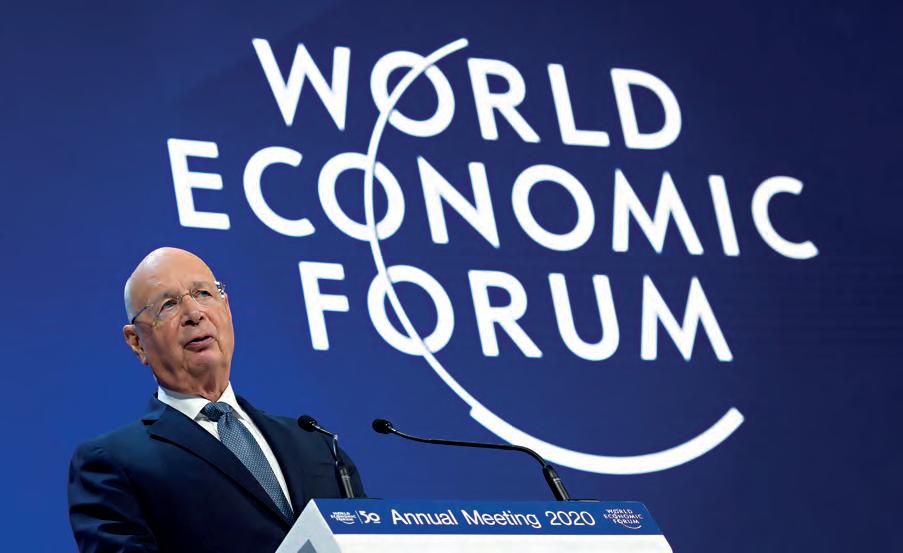
Nestled in the Swiss Alps, the picturesque town of Davos was chosen as the venue for the WEF’s annual meeting as the mountainous resort represents in Swiss and German culture ‘an escape from the everyday.’ Now, the $390m-a-year business is a mecca for C-suite executives and billionaires, as well as political leaders and philanthropic celebrities.
With a mission statement of ‘improving the state of the world,’ the World Economic Forum has always had lofty goals, so it is perhaps unsurprising that it falls short from time to time. On its own website, the WEF admits to weathering criticism about being ‘a gathering of distant elites’ or ‘a futile talking shop,’ but it holds fast that its aim of gathering a diverse group of people together in conversation, including global business leaders as well as academics, activists, youth and civil society leaders, is essential. “To dismiss ‘talk’ is, in professor Schwab’s words, to discount the lifeblood of democracy,” the forum said on its website.
Yet criticism that the WEF fails to make progress on global issues like climate change and wealth inequality remain. Following the 2024 gathering in Davos – which saw 50,000 people descend on the Alpine ski resort, despite there being just under 3,000 official participants – critics said earnest discussions seen in gatherings past had been replaced by status-chasing attendees and engulfed in countless spin-off meetings and spurious sponsored events.
Davos is “no longer about exchanging ideas or forming opinions: the new Davos has become a platform for spreading ideas and pitching to clients, investors or journalists,”
entific director at the Joint European Disruptive Initiative, and Joanna Gordon, executive director of the Global Agrifood Tech Alliance, for Sifted, a media brand for European startups that is backed by the Financial Times. The sheer number of people now attending the event means “the famous magic of Davos” is gone, replaced by a marketing exercise where “one’s importance is measured by the number of likes or selfies at the countless parties one skims,” they argued. “If you are looking for the place where leaders work together to solve the world’s problems, we now have to find something else,” Loesekrug-Pietri and Gordon concluded.
With limited tickets and exclusive spaces for priority businesses, as well as hefty membership and partnership fees, attending Davos has, undeniably, become a status symbol.
The phrase ‘Davos Man’ was coined by Samuel Huntington, a political scientist, in 2004 for “an emerging global superclass” of “gold-collar workers.” In 2022, the phrase was used by Peter Goodman, global economic correspondent for The New York Times in his book Davos Man: How the Billionaires Devoured the World, a scathing critique of the global elite for profiting from inequality, and an indictment of the class of people who Schwab brings together to “improve the state of the world.”
“sCh WA b’s IdE A s ConTInu E To hold
W EIGhT In ThE Wor ld oF busIn Ess”
Elsewhere, there is criticism around the diversity of Davos’ attendees – the ‘Davos Man’ stereotype doesn’t come from nowhere. The 2024 gathering had the highest ever percentage of women participating: of the 3,000 attendees, around 28 percent were women, including 350 heads of state and government ministers, the WEF said. The organisation called this moment a “significant milestone in the 54-year history of the annual meeting,” but many still consider the numbers disappointing.
What’s more, in addition to these external critiques, the WEF has also been forced to contend with criticism in its own ranks. Much of this has centred on the decades of uncertainty around Schwab’s succession plans. Following on from the annual meeting that took place in 2023, The Guardian reported frustration among a number of current and former WEF staffers.
As a group, they called Schwab “a law unto himself” and said he was “unaccountable to anyone inside and outside the organisation.” Many at the WEF have questioned whether he would ever pass the baton. “It is insane that they don’t have a succession plan to build public confidence around,” one long-time staffer told Politico that same year.
And as frustration swirled, the WEF also had to battle with continuous conspiracies about its founder. In April 2024, just before it was announced Schwab would be stepping down, rumours emerged on social media that he had been admitted to hospital, with some even claiming he was dead. Of course, none of these claims were true, and the WEF reported that Schwab’s health was “excellent.”
Summer 2024 | 41 The GreaT Fa rewell
»
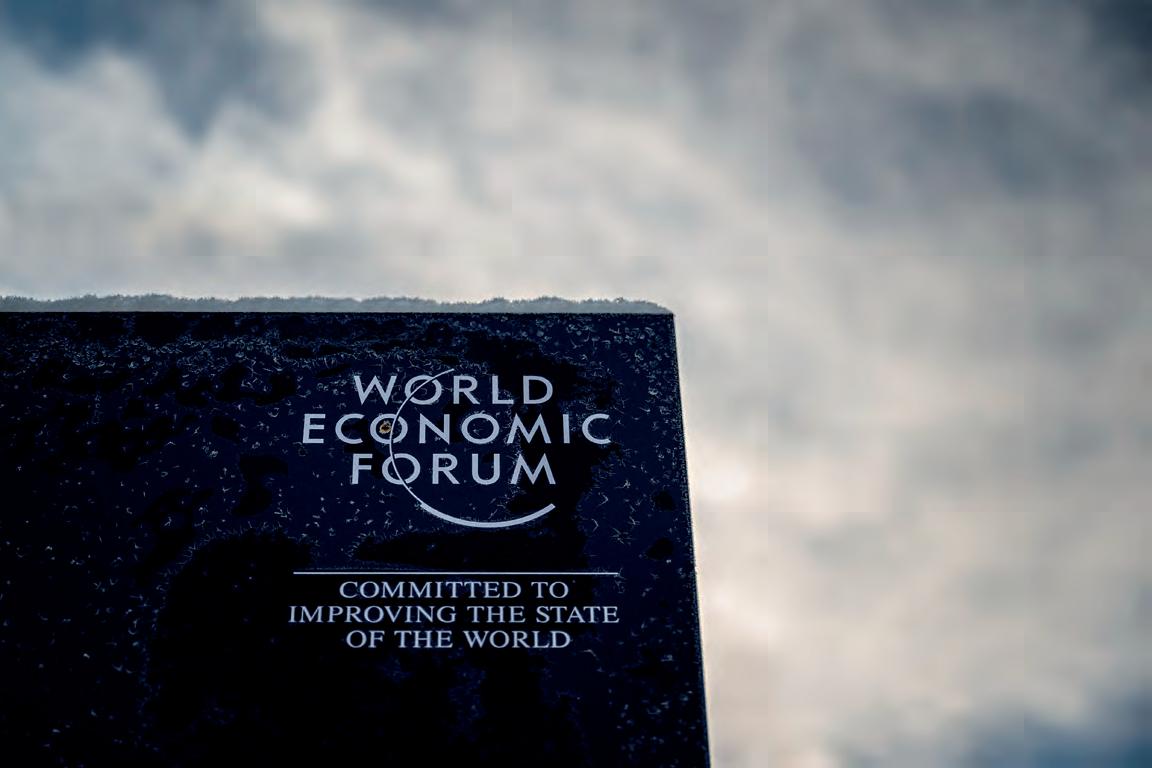
A lasting legacy
Despite the criticism of Davos, Schwab’s ideas continue to hold weight in the world of business. The most influential of these is stakeholder capitalism, or the multi-stakeholder approach. While he didn’t coin the term, he, through the WEF, certainly embedded its popularity in the mainstream.
“Stakeholder capitalism is not new, although it has changed names throughout the years – communitarianism, corporate social responsibility model, broader purpose corporation,” Saura Masconale, assistant professor at the University of Arizona and associate director of the Centre for the Philosophy of Freedom, told World Finance. “The terms change but the idea stays the same: corporations have broader social obligations than just maximising shareholder value.”
But something else has changed: Schwab argued in 2021 that while companies and their shareholders have become stronger over time, the power of other stakeholders has weakened. “Today, the stakeholder concept is ready for a comeback, albeit in an updated, more comprehensive form,” he said. Masconale, an expert in environmental, social and governance (ESG) standards, agreed.
“Today, stakeholder capitalism is largely driven by only one class of stakeholders – the shareholders, who have never been as empowered, largely because of the reconcentration of equity ownership in the hands of a few large fund families,” she said.
The most recent Edelman Trust Barometer, published just before Covid-19 turned the world on its head, found that over half of people (56 percent) believed capitalism was
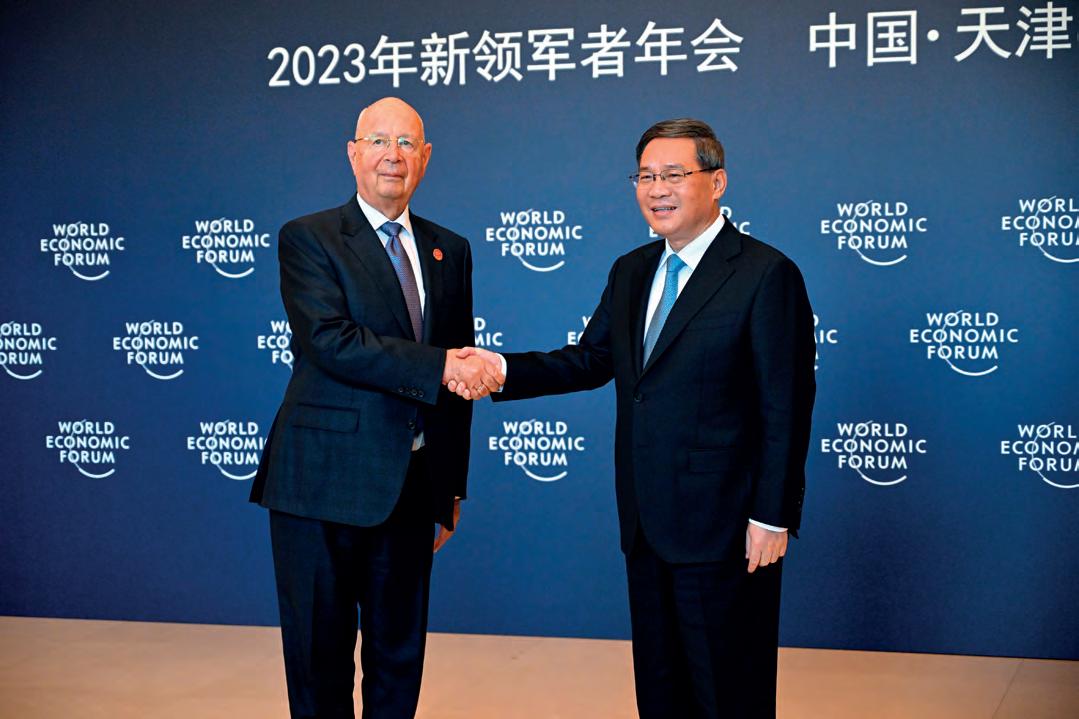
doing more harm than good globally. A whop ping 92 percent of the 34,000 respondents said companies should be speaking out on issues like automation and immigration, and nearly three-quarters said CEOs should lead these conversations.
A modern adaptation of stakeholder capitalism must respond to a new set of challenges across social, economic and health arenas, Schwab said, “and the best response to these challenges would be for all actors in society to consider more than their narrow and shortterm self interest.” The problems society faces are “now more clearly global,” Schwab continued. “Economies, societies, and the environment are more closely linked to each other now than 50 years ago.”
In his new model, people and the planet are at the centre of business, with the four remaining key groups of stakeholders – companies, international community, civil society, and countries and states – contributing to their betterment. “As all of these groups and their goals are interconnected,” he wrote, “one cannot succeed if the others fail.”
Whereas shareholder primacy focuses on narrower objectives like profits or prosperity of a particular company, stakeholder capitalism, in this new guise, focuses on the
“EConomIEs, soCIETIEs, A n d ThE Env IronmEnT A r E mor E ClosEly lIn
interconnectivity and overarching well-being of people and the planet. However, the challenges to Schwab’s new vision for stakeholder capitalism remain the same as ever.
“Without a clear performance metric, evaluating managerial and firm performance becomes difficult,” Masconale said. “When does a manager do good? Is it when she increases profits (requiring cost cuts) or when she saves jobs (increasing costs)? While the trade-offs might not always be so stark, it is uncertain whether asking individuals to act in the interests of others is compatible with markets, which notoriously assume self-interested behaviour and ‘a benign indifference to passions’.”
Another issue is the numerous different interpretations of what ‘stakeholder capitalism’ means. “The failure to recognise those differences has been a source of much confusion and disagreement inside companies and in the public debate,” wrote Lynn Paine, a professor of business administration at Harvard Business School, in the Harvard Business Review
The recent controversy over environmental, social, and governance investing is a case in point.
“Stakeholder capitalism can be more or less than meets the eye – and more or less of a challenge to shareholder primacy – depending on which version is being considered,” Paine said. In addition to stakeholder capitalism, another of Schwab’s enduring ideas is the Fourth Industrial Revolution, a term he popularised in his book of the same name, published in 2016. Schwab outlined the technological revolution society was facing, which he believed would “fundamentally alter the way we live,
42 | Summer 2024
Ed Th A n 50 y E A r s AGo” »
k

work, and relate to one another,” he wrote in Foreign Affairs. “In its scale, scope, and complexity, the transformation will be unlike anything humankind has experienced before.”
Global phenomenon
The Fourth Industrial Revolution, or Industry 4.0, was defined by Schwab as “a fusion of technologies that is blurring the lines between the physical, digital, and biological spheres.” Jamati, from Stone Junction, said the ideas behind Industry 4.0 have been “immensely influential” in the engineering and manufacturing sector.
“Schwab turned Industry 4.0 into a global phenomenon, sparking critical discussions and analysis across engineering, manufacturing and technology for over a decade.” Industry 4.0 is a defining aspect of Schwab’s legacy, he said. “It’s a concept that continues to shape our understanding of automation, connected systems and the future of industrial processes.”
Thanks to the WEF, Jamati said, “artificial intelligence, cybersecurity and the Internet of Things are just a few of the buzzwords that now dominate discussions. The forum’s role in fostering dialogue and collaboration on these technologies will be critical in ensuring a future that benefits all of humanity.”
With the recent explosion in AI technology, the Fourth Industrial Revolution indeed feels more prescient than ever. While Schwab said generative AI had opened up “abundant opportunities” in sectors like product design, content creation, drug discovery, energy optimisation and more, writing in 2023 for Project Syndicate, he said, “At the same time, they may
“sCh WA b’s FI v E dECA dEs AT ThE hElm oF ThE WEF h Av E m A dE hIm A GIA nT In ThE Cor por ATE Wor ld”
prove highly disruptive, and even harmful, to our economies and societies. “Generative AI will change the world, whether we like it or not. At this pivotal moment in the technology’s development, a cooperative approach is essential to enable us to do everything in our power to ensure that the process is aligned with our shared interests and values,” he wrote, calling for urgent public-private cooperation to address these challenges.
In contrast to stakeholder capitalism and the Fourth Industrial Revolution, Schwab’s latest slogan became influential for all the wrong reasons. In the summer of 2020, Schwab launched a campaign for what he called a ‘Great Reset’ of the global economy. Writing in a WEF article, Schwab argued that the “serious long-term consequences” caused by Covid-19, including government debt and unemployment, would exacerbate climate and social crises that were already underway.
A “Great Reset of capitalism” was needed to avoid a sharp economic downturn and to “revamp all aspects of our societies and economies, from education to social contracts and working conditions. Every country, from the US to China, must participate, and every industry, from oil and gas to tech, must be transformed,” he said.
However, his vision was co-opted by conspiracy theorists. An analysis by the BBC said the WEF’s “vague set of proposals” had been “transformed by online conspiracy theorists” into a reimagining of an older conspiracy theory. Building on the ‘New World Order’ narrative that first emerged in the 1960s, they pushed an anti-establishment narrative that the Great Reset was all part of the global elite’s plan to unleash Covid-19 so they could impose lockdowns to deliberately crash the economy and consolidate their power. The WEF told the BBC conspiracy theories like these “replace reason with fantasy. They are a noisy but peripheral part of the public sphere. We encourage rationally grounded, fact-based
An uncertain future
Schwab’s five decades at the helm of the World Economic Forum have made him a giant in the corporate world – and beyond – capable of setting the agenda for the global elite and fostering discussions on complex issues. Yet after years of silence around his succession plans, his departure from the WEF comes at a time when the forum’s influence may be waning. The challenge for any successor, Ahmed told World Finance, “will be to sustain that collective spirit that Schwab created in a world that is increasingly fragmented.”
The WEF’s executive board is now under the leadership of current president Børge Brende, a former Norwegian foreign minister who has been in the post since 2017, but in the absence of a successor at the time of writing, speculation continued to swirl about possible candidates. His children, Nicole and Olivier Schwab, are possibilities as they hold high-ranking positions in the organisation already, as chair of WEF’s Young Global Leaders programme and managing director of the forum, respectively. Current president Brende should also not be discounted. Other names in the hat are Christine Lagarde, European Central Bank president and a trustee of the WEF, who has long been considered a potential candidate; Salesforce co-CEO and WEF trustee Marc Benioff and former British Prime Minister Tony Blair.
Whoever Schwab’s successor is revealed to be, they will not only be tasked with revitalising the World Economic Forum and showcasing the value of the annual summit in Davos, but also with emerging from behind the shadow of a giant. n
Summer 2024 | 43 The GreaT Fa rewell
Klaus Schwab greets chinese premier Li Qiang
Completing the banking puzzle
The introduction of stricter capital requirements for US banks has provoked a backlash that could go on to shape banking regulation across the whole globe
WORDS BY Alex Katsomitros
FEaTuRES WRITER






For fans of American football used to watching advertisements about fast food chains, the last few months have been a crash course in banking regulation, with commercial breaks during NFL games often featuring ads that warn them about sudden hikes in their mortgage rates. And that is just the least aggressive part of a campaign the US banking industry has launched against a reform in capital rules, announced by regulators last summer. “I doubt that people seeing those ads have any idea what they are talking about,” said Michael Ohlrogge, an expert on financial regulation teaching at NYU School of Law, adding: “They might perhaps activate people who have a knee-jerk reaction that all regulation is bad.”
Higher, stricter, harsher
The reform is the latest attempt to buttress the country’s financial system, proposed by the Federal Reserve, the Office of the Comptroller of the Currency and the Federal Deposit Insurance Corporation. It has been named ‘Basel III endgame’ after the Swiss city where the Bank for International Settlements (BIS) that oversees central banks is based. Banks with over $100bn in assets will be obliged to set aside tens of billions more by early 2028. They will also have to include a larger part of losses in capital ratios and will no longer be able to use lower historical capital losses to reduce their capital requirements. US regulators have expressed hope that the reform will reduce systemic risk and improve the US banking sector’s resilience.
The overhaul aims to harmonise US capital rules with international standards. Most developed economies have already imple-
mented capital rules dictated by the Basel Committee on Banking Supervision, which sets global capital requirements. In 2017, the committee reached an agreement for higher capital requirements to address concerns that ‘Basel III,’ a banking regulation package implemented after the credit crunch, had failed to tackle systemic risks. However, the committee’s rules are non-binding and subject to adjustment to national regulatory priorities. In response, US regulators chose to apply stringent standards, particularly in operational risk, which includes novel threats such as cyber crime. One reason is the recent turmoil in the country’s banking system, echoing the darker days of the financial crisis. Three of the largest bank failures in US history took place during the last three years, putting the recovery from the Covid slump and the effectiveness of post-2009 banking regulation into question. The 2023 collapse of Silicon Valley Bank, which albeit small by US standards, held a crucial role in the tech ecosystem, raised eyebrows about the practices of smaller banks. Just a few months later, First Republic, a San Francisco-based bank, followed suit. Crucially, the proposed rules also cover regional lenders previously exempt from strict capital requirements. Banks may also have to increase their capital when regulators expect a recession. What regulators are keen to avert are more bank bail-outs, an issue that caused public resentment in the aftermath of the Great Recession. “Since the real estate market and debt scenarios have started to mimic the pre-2008 crash scenarios, regulatory organisations are trying to prevent a banking sector collapse with strict policies,” said Ethan Keller, president of Dominion, a US-based network of legal and financial advisors.
Fierce pushback
When announced last summer, the proposals sent a shockwave across Wall Street. An analysis by the law firm Latham & Watkins found
THe Fed HAS iNdiCATed iTS WilliNGNeSS To CompromiSe ANd WATer doWN THe moST STriNGeNT ruleS

limit their lending capabilities, hurting the US economy and especially SMEs. The bone of contention is riskweighted assets (RWA), which are measured based on a risk weighting assigned to banks’ operations. As the denominator to determine capital ratios against future losses, low RWAs help banks look stronger financially. Previously, banks were allowed to use their own models to gauge risk, but discrepancies in modelling across the industry have urged regulators to set a common standard to measure operational risk. Critics argue that this will increase capital requirements for mortgages and corporate loans, and even put products such as the hedging contracts airlines use for fuel purchases in jeopardy.
44 | Summer 2024
banking Regulation

“The pushback is justified, because the rules will have costs but no clear benefit,”cial institutions teaching at the University of Austin. Other experts, however, question the validity of the banks’ claims. “If the loans are good loans to make in the first place, why wouldn’t they be willing to fund them with a portion of money from their shareholders,” NYU’s Ohlrogge said, adding: “The kind of loans that capital requirements are going to lead to a reduction in are loans that were bad loans to start with – that is, loans that only make sense to the bank if it can get the profits if the loans perform well, but pass off the costs if they perform badly.” A 2016 BIS study found that increased equity capital is linked to more lending. Critics of banks also argue that their real concern is pay, as higher equity capital will hit executive bonuses based on returnon-equity, and possibly dividends and share buybacks.
Regulators estimate that the new rules will lead to an aggregate 16 percent increase in capital requirements for the largest banks. However, they clarified in their initial pro -
posal that “the largest US bank holding companies annually earned an average of 180 basis points of capital ratio between 2015–2022,” meaning that the hit would be mild at best. The 12 largest US banks sit on a record $180bn of excess common equity tier one capital, a common measure of their financial strength. Several banks and lobbying groups have pushed back against these projections. The Bank Policy Institute, which represents large and mid-sized banks, estimates that the largest ones will have to increase their capital up to 24 percent. Some banks have also argued that they are already financially strong, expressing concerns that higher capital requirements would only lead to higher costs, rather than more safety. The Financial Services Forum (FSF), a group representing the eight largest US banks, estimates that its members had $940bn of capital in 2023, three times more than in 2009.
Another concern is potential loss of international competitiveness. US banks will have to comply with more stringent capital requirements than those their competitors face, currently standing at 3.2 percent for large UK banks and 9.9 percent for EU-based ones. Diminished internal competition could be another unintended consequence if more banks merge to comply with the new rules. One of the regulators, the Federal Deposit Insurance Corporation, has recently proposed reforms that would make big bank mergers more difficult. “Not only do higher capital requirements make US banks less competitive relative to foreign banks, higher capital requirements also make regional and larger US banks less competitive relative to community banks,” said Matthew Bisanz, partner in the financial services, regulatory and enforcement practice of the US law firm Mayer Brown. “Considering EU banks’ existing technology and framework to maintain the Basel framework, this will give them a competitive advantage over US banks,” said Dominion’s Keller, adding: “As this framework means additional costs for training, tracking, and setting aside a specific portion of the capital, the banks will churn out the additional costs from the customers. Hence, smaller banks with Basel Endgame exception will gain a new clientele not willing to pay extra money for US banking conglomerates.”
For its part, the Fed has indicated its willingness to compromise and water down the most stringent rules of the initial proposal, with a final plan expected to be announced this summer. Its chair, Jay Powell, has said that “broad and material changes” are likely and has acknowledged that a balance has to be struck between potential costs and the
stability of the financial system. Other Fed board members are even more sceptical. Two of them, Michelle Bowman and Christopher Waller, have raised concerns over reduced competition, curtailed lending, less liquidity and costlier credit as a result of the changes.
Basel rules under fire
THree oF THe lArGeST
bANk FAilureS iN uS
HiSTory Took plACe
duriNG THe lAST
THree yeArS
The reform has entered the political fray amid the campaign for the forthcoming presidential election. The banking industry has launched a website where voters can notify elected representatives about their concerns. Banks are also lobbying lawmakers to put pressure on regulators. Many republican congressmen and senators have openly opposed the reforms, and a future Trump administration is expected to pressurise regulators to water down the proposals. When the initial proposals were announced last summer, regulators were concerned about recent bank failures, while Biden administration officials were worried about an imminent financial crisis. The reform “reflects the greater political pressure on US regulators and politicisation of US regulation post-Dodd-Frank,” Bisanz said, referring to a post-2009 piece of legislation that reined in the worst excesses of the financial services sector, adding: “The campaign of banks reflects the seriousness of the increase in the capital requirements, as well as the weakened position that US regulators are in after missing the bank failures last year. There also is an element that courts are questioning decisions by regulators.”
More ominously, the overhaul and the resulting outcry have provided ammunition to the many critics of Basel rules. “Basel is so weak that even in the US, where large banks succeed in avoiding strict prudential guidelines, it has historically been so inadequate that the US adopted stricter but still ineffective standards,” said Calomiris. Stricter capital requirements elsewhere and even another overhaul of Basel regulations may be on the cards, as banks and regulators worldwide take notice of changes in US regulation. Ironically, the government of Switzerland, where BIS is based, has put forward proposals to increase capital requirements for Swiss banks after the collapse of Credit Suisse in March 2023. “The more rigorous of capital regulations the US adopts, the more encouragement it provides for other countries to adopt rigorous rules,” said Ohlrogge. n
Summer 2024 | 45 banking Regulation
Bulgarian banks are ready for the Euro adoption
Bulgaria is on the precipice of a historic moment with its accession to the eurozone scheduled for 2025. With euro adoption comes a brighter future for all in the EU state, and strong positions in the EU network show a readiness to embrace it
WORDS BY Petia Dimitrova
all requirements and prepare our information systems accordingly. We will invest additional resources in cyber security enhancements and increase security measures, protections against cyber threats such as hacking, malware, or phishing.





Bulgaria’s accession to the eurozone and the adoption of the world’s second most used currency is a long-anticipated process. This step will positively impact our economy and will be a driver for accelerating reforms, increasing prosperity, and reaching at least the average European living standards. It will offer numerous benefits to citizens and companies, not only by reducing transaction costs but also by improving the investment environment, activating local and foreign investments, with increased investment activity expected to support employment.
Eurozone membership will offer another benefit. Because of the expiring derogation, banks must allocate capital for purchasing Bulgarian government securities in euros and for holding euro deposits at Bulgarian National Bank (BNB), which is highly illogical given that we have been in a currency board for over 25 years. This year, the effect is estimated at approximately BGN400m (€205m) of additional capital, and next year it is expected to double. Instead of guaranteeing risk-free loans to the state, this capital could enable us to increase loans to the real economy by several billion leva.
The ECB will be able to act as a lender of last resort, minimising the risk of bank failures due to a liquidity crisis. Bulgaria will have the opportunity to participate in the decision-making process regarding monetary policy, instead of just being a silent bystander. Although all banks in Europe follow the same laws and regulations, being outside the eurozone, we bear the burden without the benefits.
Adopting the euro is expected to boost Bulgaria’s international trade, especially in agriculture, services, and tourism, as well as in certain manufacturing sectors where Bulgaria has already established strong positions within the EU networks.
In the Association of Banks in Bulgaria,
we plan to launch an educational campaign among citizens, for which we count on the support of BNB and the government, to explain all the benefits of adopting the euro, which will significantly improve the business environment for everyone. Banks, businesses, and the state must unite to communicate clearly and help our clients, our employees, and the society navigate through the abundance of information and counteract misinformation, enabling everyone to understand the advantages of adopting the euro. The euro has already become a part of our daily lives, with a

in euros, and Bulgarian citizens frequently conducting transactions in this currency.
All systems go
Together with other member banks of the Association of Banks in Bulgaria, we have even more initiatives in the field of environmental protection, social policies, and corporate governance, the so-called ESG. The role of banks is primarily to focus on the areas where we can have the most significant impact to achieve positive effects. Banks are key players in the green transformation, accelerating the path to climate neutrality not only through the decarbonisation of our operations but also through prioritised financing of our clients’ projects. Environmental protection is the most visible aspect of these initiatives, but it is far from the only one. We lead in promoting good governance practices, women’s participation in management, and the independence of our control bodies. For us banks it is important to meet
Alongside that preparation, the contribution of the banking sector is extremely notable in digital banking. Habits today differ from those of yesterday because life imposes its own dynamics. The accelerated implementation of high-tech solutions enhances the user experience. Thus, we provide our customers with even higher quality, faster, and more efficient banking services because the foundation of banking is the relationship between the consumer and the financial institution. In this process, the major market players have an advantage because we possess the resources and means to implement various technological solutions and ensure even higher quality and efficiency in banking services. Digital cards, virtual wallets, and QRcode payments are all part of the new reality. However, the speed of technological transfor-
AdopTiNG THe euro iS eXpeCTed To booST bulGAriA’S iNTerNATioNAl TrAde
mation depends on the people in the team. We make significant investments in process reengineering and human resources to create client-friendly applications that enhance the pleasure of interacting with us. The Phygital model is the future of banking. Hybrid forms of banking, a complex model blending digital and physical services, and consumer experience across different channels and platforms – sequentially, in real-time – are what we do at Postbank and what our clients expect. On the other hand, digital payments play a crucial role in stimulating economic growth, innovation, and consumer convenience.
Finally, the euro adoption is a historic moment, and we are well prepared for this significant step. And if there is a system in the Bulgarian economy that is already in the eurozone in terms of requirements, regulations, good business practices, and behaviour, it is the banking system.
So, I can confidently state that we, the banks, will be ready by January 1, 2025. n
46 | Summer 2024
banking Regulation
chaIRpERSoN oF ThE boaRD oF DIREcToRS oF ThE aSSocIaTIoN oF baNKS IN buLGaRIa






Riding the digital wave: Macau’s fintech revolution
ICBC (Macau) has undergone a remarkable fintech makeover, levelling up its digitalised operations by utilising new technologies and optimising its services
WORDS BY Gao Ming


Technology, data and talent are the most important production factors for providing enormous momentum especially, for the development and innovation of financial business. With a small local market, Macao’s banking industry is facing intense and homogeneous competition, and it is hard to benefit from economies of scale. In order to mitigate this, ICBC (Macau) fully utilised its fintech advantage under the auspices of the ICBC Group, and achieved an innovation-driven and digitalised transformation.
A tech-leading strategy
We established the fintech transformation as a corporate strategy, to help deepen the integration of technology, data and financial business, setting up the financial technology and digital development committee to promote the application of new technology and ideas, and to build an innovative, leading and environmentally friendly brand image. We also assembled adaptive teams consisting of members from IT, business and product departments to facilitate the implementation of fintech to banking business, and evaluated the outcomes through a practical, retrospective and participative method.
Riding the wave of fintech development and Macao’s smart city strategy, we aimed to accelerate fintech innovation and iteration by expediting a digital reform on customer service and business channels, and especially on our mobile banking service. We also strived to promote innovation and optimisation of
financial business, working processes and internal management. As a field test of the group’s overseas business, we took the lead to build a best customer service bank, and fostered our competitive advantage through the application of fintech.
Under this tech-leading strategy, we continuously enhanced our service ability and succeeded in winning customers. Our ebanking service accounts for over 80 percent of the whole business, and the online channel played an important role in attracting and maintaining customers. As a result, we continued to stay ahead of our peers in financial products and services.
Digitalised operations
With a view to deepening our innovative technology-driven capabilities and upholding the philosophy of technology self-reliance, we focused on developing technology in support of business development, and upgraded the ECOS technology ecosystem to provide powerful engines for business development. To transform our operation and develop a techdriven and innovation-orientated mode, we utilised data and technology, and this proved to be the impetus to construct platforms and user scenarios, advance products and services, build a user ecosystem, and integrate our online and offline business layouts.
From there, we continued to promote the optimisation of outlets and expanded our customer service channels. Focusing on customers and driven by data, the bank improved the layout of a digital operation system, and rapidly created a new model of full-journey services for customers. As the first bank in Macao to build a smart bank network, and provide services for cross-border e-commerce, intelligent card-issuing and cross-border mortgage data connection, we have become a fintech leader

in Macao’s banking industry. We have also reformed the overall systematic layout of retail outlets, and promoted the upgrading of Macao’s financial service towards a higher level aimed at convenience and efficiency for our customers.
With this in mind, we created a ubiquitous collaborative online and offline service channel system, advanced the integration of mobile banking into the marketing services of outlets, and stepped up integrated online and offline operations. Through the versatile application of different financial technologies, we enhanced customer experience in acquisitions, remittance, wealth management and online bill payments, and covered one-third of Macao residents using our e-payment service. We also took the lead to launch the ‘Greater Bay Area Transit QR code,’ allowing people to ride buses in Guangdong, Hong Kong and Macao with one code, and therefore formed a competitive advantage as the leading bank in Macao’s payment market.
We have continued to enrich financial products by accelerating the construction of
48 Summer 2024
banking Digital
chaIRMaN, INDuSTRIaL aND coMMERcIaL baNK oF chINa (Macau)

THrouGH THe
AppliCATioN oF
TeCHNoloGy
iNCludiNG biG dATA ANd Ai, We upGrAded our riSk mANAGemeNT
the corporate digital finance service platform and building new avenues of the digital operation. As part of the group’s global layout, we fully utilised our advantage of online corporate banking services to develop cross-border and cross-currency fund pool products, and constructed a global cash management system covering 104 countries/regions and 61 currencies, with an annual settlement amount of more than MOP1trn ($124bn).
We are also the first bank in Macao to hold a fintech competition for university students, aiming to cultivate more financial and technological talents for the region.
Securing innovation
We improved our cyber-security capabilities by pooling efforts in asset management, testing and assessment of our systems, cyber-security protection and improving data security. We have followed a systematic approach in enhancing our comprehensive cyber-security protection capability. Further, through the application of technology including big data and AI, we upgraded our risk management
We reGArd THe diGiTAl CulTure AS AN imporTANT pArT oF our CorporATe CulTure
with a comprehensive system that covers risk monitoring, early warning and intervention, with automatic interception of suspicious transactions. We also introduced the latest technology in identity authentication, data processing and made our offices paperless to enhance work efficiency and cut down on waste.
Digitalisation serves as the critical momentum of future development in the banking industry. It is also the key for ICBC (Macau) to foster innovation and stride ahead in the market. Therefore, we will stay committed to seizing future opportunities for digital reform, and continue to come up with bold strategies and groundbreaking ideas for future development.
80% of transactions are completed using e-banking
104 countries/regions covered by ICBC’s global cash management system
Our mission remains clear. We aim to build a ‘digitalised ICBC,’ one that will adhere to improving the capacity to serve our users with comprehensive digital operations, remote service and intelligent risk control. In addition to this, we will continue to digitalise our service platform, operation mechanism and risk control system, with the aim of upgrading customer service, empowering our workforce and enhancing work efficiency and effectiveness. We regard the digital culture as an important part of our corporate culture, and we aim to continue promoting staff training for digital reform, nurturing the talented professionals in our industry. We want to provide staff training for the entire front-to-back office by inviting in experts and visiting professional institutions, in order to cultivate a ‘digital thinking mode’ within the organisation, and in doing so, securing the reputation of being a tech leader in all respects.
The final tenet of our mission is to deepen our application of fintech. We will strive to set up new working processes for online and offline operation, build a new service model for information sharing, integrate clear steps in our workflow, and effectively combine resources to provide timely responses to customer demands.
We have also been paying attention to the breakthrough of generative AI, and will continue to explore the application of large language models (LLM) in marketing, risk prevention and management. Looking to the future, we will stay committed to building a flourishing digital ecosystem combining unparalleled financial services with the real economy, to further promote the upgrading of traditional industries and the development of emerging industries. n
Summer 2024 | 49 banking Digital
The next phase of digital banking
As the digital revolution in banking has grown alongside smartphone adoption, concerns about security and regulation have brought about challenges that risk stymieing innovation
WORDS BY
Antonia Di Lorenzo FEaTuRES WRITER


The proliferation of smartphones and the increasing reliance on mobile technology have created a fertile environment for digital wallets and real-time payments, which are undergoing rapid evolution. This is progressively transforming the banking industry worldwide, especially in the UK, the US and European countries, driven by rising consumer demand and regulatory changes.
E-wallets, which allow consumers to store, manage and transfer their financial assets, offer alternatives for those without access to traditional banking services. Consumers are now accustomed to managing their finances online, whether that is checking balances, transferring funds, or applying for loans. This reflects a fundamental shift in consumer behaviour, where convenience and accessibility dominate. Further, the enhanced security features they offer, such as tokenisation – allowing the digital banking system to identify and process the transaction without exposing the user data – and biometric authentication –the use of unique physiological or behavioural characteristics of individuals for authentication and security purposes – have helped relieve concerns about fraud and identity theft, leading to further adoption of the tech.
A notable trend of younger generations moving towards digital wallets for everyday use has emerged, particularly in the UK and the US. According to the 2024 digital banking statistics in the UK, the number of digitalonly bank account holders is higher among younger generations. More than half of Generation Z (55 percent) – the age group between 18 and 26 years old – and half of millennials (50 percent) hold at least one digital-only bank account in 2024. Meanwhile, just one in five members of the silent generation and baby boomers hold a digital-only bank account (21 percent each) and a third of Generation X (34 percent).
Just under one in five millennials and Generation Zers (18 percent) who do not currently have a digital bank account intend to open one at some point in the future, as well as 15 percent of those in Generation X.
Digital overtakes traditional
According to a Forbes Advisor survey on digital wallets which was revealed in 2023, around 53 percent of US consumers used digital wallets more often than traditional payment methods. Members of Generation Z were the most likely to adopt digital wallets as their primary payment method for shopping (91 percent) and travelling (86 percent).
In the US, technology giants like Apple, Google, and PayPal have set the stage with digital wallets that leverage the cloud to offer seamless, real-time transaction capabilities. These firms, with extensive user bases and access to the latest technological solutions, have made platforms such as Apple Pay, Google Pay, and PayPal household names, offering consumers secure and efficient payment solutions both online and in-store.
Similarly, the UK has seen significant strides in digital wallet adoption, buoyed by a flourishing fintech ecosystem and a friendly regulatory environment. Companies like Revolut, Monzo, and Wise have revolutionised the market with features such as instant notifications, budgeting tools, and competitive rates for international transfers. This recent spate of innovation can in part be attributed to the UK’s Open Banking initiative which fosters innovation and competition.
Overall, while there are similarities in the evolution of digital wallets and payments between the US and the UK, there are also differences shaped by factors such as regulation, consumer behaviour, and market dynamics. Indeed, regulatory-wise, the UK has always been a more conducive environment for the growth of digital payments as the Financial Conduct Authority (FCA) has played a
53% of uS consumers used digital wallets more often than traditional payment methods in 2023
37% of banks have concerns about how generative aI tools will affect security, according to a recent poll
significant role in promoting competition and innovation in the financial services sector. In contrast, the regulatory landscape in the US has been more fragmented, with multiple regulatory bodies overseeing different aspects of the financial industry, which has sometimes hindered innovation.

Accelerated innovation
While the UK is not obligated to follow Europe’s banking regulations like Single Euro Payments Area (SEPA), Payment Services Directive 2 (PSD2) and Payment Services Directive 3 (PSD3), these mandates have still accelerated innovation and adoption of digital banking in the UK. The US has not experienced the same rate of adoption of new financial capabilities as the UK, in many ways because European banking and payment regulations have not been as influential overseas. US consumers are increasingly flocking to digital banking and payments and with country-wide regulations expected this will likely accelerate in the coming years.
In this regard, global financial technology company Sopra Banking Software CEO Eric Bierry said that especially in the US, there is a large market demand for instant payments, with key players in this space including Zelle, The Clearing House’s RTP network, Visa Direct, Mastercard Send, Venmo, Paypal and Square processing more than $900bn in annual real-time transaction volume. On the other hand, in the UK, while the Faster Pay-
50 | Summer 2024
banking Digital
THe uk HAS SeeN SiGNiFiCANT STrideS iN diGiTAl WAlleT AdopTioN

ments across many UK banks for more than 15 years, recent proposals seek to make instant payments even more secure for consumers as fraud and scams increase.
Alex Reddish, managing director of the UK fintech business Tribe Payments, highlighted that while the UK and Europe may be nearing saturation with digital banking, the evolution of the sector is far from over. “Continued innovation, regulatory developments, and shifting consumer preferences will shape the future of banking in Europe and the UK, ensuring that the industry remains dynamic and responsive to future demands,” he claimed. Reddish pointed out that on the other hand in the US, the largest financial services market in the world, some progress is likely to be much slower, although the market has always shown its ability to adapt quickly and leapfrog phases like contactless payments which the UK and Europe pioneered.
Partnerships between technology companies, financial institutions and merchants have also played a crucial role in promoting the adoption of digital wallets. “These collaborations have expanded acceptance networks, raised awareness about the benefits of mobile payments, and incentivised consumers with rewards and discounts,” Reddish added.
Security remains a top concern
Looking ahead, both the US and the UK are likely to see further innovation and growth
despite these advancements, challenges re main, particularly in the realms of cybersecurity and regulatory space. According to a data breach report released by IBM in 2023, cyber attacks disproportionately impact the financial services industry, which is second only to the healthcare industry in terms of cost per breach.
they nonetheless worry about how generative AI tools will affect areas like security and the banking workforce overall. Banks will need to devote time to not only onboarding AI tools themselves, but also educating teams and consumers about their impact. While banks will certainly face challenges integrating GenAI into their businesses, it also offers them an
“Regulations will pose another challenge to US and UK banks. As requirements continue to evolve and new policies come into play, banks must stay up-to-date to ensure compliance. After the failure of a series of banks last year, regulators are set to introduce several new policies this year that aim to prevent something like this from ever happening
According to Bierry, regulators are likely to focus on policies protecting consumers and their financial data this year, especially as innovative financial products and services emerge in the era of open banking and AI.
Likewise, Maureen Doyle-Spare, head of asset and wealth management and insurance at UST, a US digital transformation solutions company, highlighted that security is paramount because digital wallets contain so much sensitive financial data, which makes them very attractive targets for cyber attacks.
THe reGulATory
Chris McGee, managing director of the financial services practice at global management and technology consulting firm AArete, stressed that security remains a top concern in both regions, and the need for cybersecurity remains a major trend in digital banking. “Banks are using AI to evolve digital banking in several areas, including security detection. AI can detect fraud and other potential risks faster than ever before while helping banks comply with a growing number of regulations. AI will increasingly play a key role in protecting customers’ assets and personal data and, crucially, in earning customers’ trust, especially as customers continue to explore the use of digital wallets to pay for goods and services.”
Likewise, Bierry revealed that one of the biggest challenges that both US and UK banks will face will be around generative AI. “Banks see clear business value with AI, but
“Robust encryption, multi-factor authentication, and vigilant monitoring are essential for safeguarding user information. Additionally, interoperability also poses challenges, as seamless compatibility among various digital wallet platforms is crucial for enhancing the user experience. Furthermore, scalability is a pressing concern, as advanced infrastructure is needed to handle increasing transaction volumes without compromising speed or reliability,” she said.
Modernising existing and outdated banking infrastructure poses a significant hurdle for banks and fintech companies across the globe. Both markets in the US and the UK are likely to face similar challenges to reach their full digital banking potential. Aside from market differentiation difficulties due to the commoditised nature of digital banking services, neobanks will have to navigate regulatory frameworks primarily designed for traditional banks, which can be resource intensive and slow down innovation.
High customer acquisition costs and low per-customer revenue also present profitability challenges. n
Summer 2024 | 51 banking Digital
lANdSCApe iN THe uS HAS beeN more FrAGmeNTed
Reflections on 30 years of banking in ASEAN’s heart
What does it mean to be the first? Pioneers, early adopters, innovators. However you think of them, those willing to take a chance and lead the way can blaze a trail for others to follow




baNK
Ti Eng Hui cEo, baIDuRI


As Baiduri Bank celebrates 30 years serving our customers in Brunei, we reflect on some of the ‘firsts’ we have achieved during this time. There are several worth noting. We were the first bank in Brunei to offer internet banking in 2001, followed by mobile banking services in 2007. We were first to offer in-store and in-mall banking seven days a week, and the first to launch internationally accepted Visa Electron debit cards, Mastercard Electronic CashCards, and Visa payWave in the country. Additionally, we were the fi rst and only bank to provide money remittance services through Western Union and to introduce multi-currency ATM dispensing in euros and US, Singapore and Brunei dollars. We were the first to receive PCI-DSS certification for card payment systems and processes, and to offer online securities trading through our subsidiary, Baiduri Capital.
Building a solid foundation
We are incredibly proud of our achievements since Baiduri Bank was established in 1994, including weathering the storm of the global pandemic and proving our resilience to external shocks. Soon after launch, the business positioned itself as a key player in Brunei’s financial sector. Initially focusing on corporate and private banking clients, Baiduri Bank soon expanded into retail banking to meet the needs of its fast-growing customer base. By the end of the 1990s, Baiduri Bank had opened several branches and a finance arm, becoming a leader in automobile finance in Brunei.
More recent milestones include our relocation in 2020 to new headquarters, designed with environmental sustainability in mind. The building attained the Green Mark Certified Award from the Building and Construction Authority of Singapore in recognition of
its innovative green features. Later that same year, we undertook a brand refresh to better communicate Baiduri Bank’s strengths and values, ensuring that we stay ahead in a changing world.
Investing in digital transformation
We aim to keep setting trends as our business evolves to remain fit for the future. One key theme we continue to embrace is digital transformation. As early innovators in online and mobile banking, in 2022 we took our own digital capabilities a step further. We partnered with Temenos to replace our legacy systems with a new cloud-based core banking system designed to improve operational efficiency. This collaboration made Baiduri Bank the first bank in Brunei to operate its core banking platform in the cloud under the SaaS model.

miNdFul oF
Last year we added a new digital wallet, Baiduri Qpay, to our suite of digital payment services. We also introduced a first-of-its-kind e-Marketplace initiative, Maribali, in collaboration with a local SME. Maribali offers a platform for local businesses to market and sell their products and services online with secure and convenient payment options. We are also currently developing API-based microservices which allow us to smoothly integrate legacy and cloud applications, improving service delivery and personalisation.
Improving the customer experience
We have made all these investments in digital transformation with the customer in mind. Our aim has always been to provide personalised and efficient banking. Digital banking platforms and mobile apps improve the customer experience, while automation and AI streamline operations, reduce costs and increase accuracy. We use robotic process automation to make our operational processes more efficient and reduce the time spent on routine tasks. Our AI chatbot Emmi was an industry first, and has helped us create higher-quality customer interaction and
CyberSeCuriTy THreATS ANd THe Need To GuArd dATA CAreFully
For instance, we saw a 169 percent increase in live chats through our platform between 2022 and 2023.
Of course, with all opportunities may come risks, and we are especially mindful of cybersecurity threats and the need to guard data carefully. We have included robust cybersecurity and testing into our digital solutions right from the start to protect customer data and build trust in our digital services.
We also recognise that not all our customers will have the same level of access to or comfort with digital tools. Technological disparities can widen the gap between different user groups. We want to promote both financial and technological inclusivity so our customers can enjoy all the benefits of banking’s digital revolution.
Supporting a greener future
Another key theme we focus on is sustainability and green finance. There is growing regulatory support for sustainable finance in the ASEAN region, and we note that global regulators have, quite rightly, been increasingly focused on protecting consumers from ‘greenwashing.’ Banks offering green finance prod-
52 | Summer 2024
banking Digital
WORDS BY

are taking a growing interest in sustainability, but implementing green finance solutions can be costly and resource-intensive. The reputational risks associated with greenwashing could be high, so we believe the banking sector should ensure its green finance initiatives are genuine and impactful.
In Brunei, the oil and gas sectors have long been a cornerstone of the economy. As sustainable investing gains momentum, we recognise the need for a dual strategy: supporting the energy transition within the oil and gas sector and promoting economic diversification in line with Wawasan Brunei 2035. We urge businesses to explore new growth areas and identify how they can both contribute to and benefit from the evolving ecosystem that supports the leading sectors of the future.
Baiduri Bank is committed to a more sustainable future. We have a comprehensive range of corporate social responsibility (CSR) initiatives focusing on environmental sustainability and empowering micro, small, and medium-sized enterprises (MSMEs). Our efforts include promoting environmental awareness and supporting local businesses with platforms like the Maribali e-Marketplace and the Baiduri Enterprise Hub, a co-working space for MSMEs and budding entrepreneurs. We also support the adoption of green technology through our EV
charging stations, established in partnership with QAF Auto and Porsche. Additionally, we engage in community projects such as the Mengalinga volunteerism app and environmental conservation efforts like the ‘Zero to Hero’ workshops.
Nurturing our human capital
In addition to environmental sustainability, we also think about sustainability in the context of our greatest asset – human capital. Our people are the key to our success, and we understand the importance of supporting their growth and development. To build a more resilient workforce and a more sustainable business, we need to be both agile and adaptable. Business dynamics have shifted worldwide, especially post-pandemic, and talent management has changed with it. It has never been more important to foster a culture of continuous learning and development and recognise the individual contributions of our colleagues.
bAiduri
bANk eNviSioNS A FuTure mArked by CoNTiNued iNNovATioN, SuSTAiNAbiliTy, ANd STrATeGiC GroWTH
Since the start of 2022, we have been working hard to upskill our people across our organisation through several initiatives and programmes aimed at nurturing leadership capabilities.
For example, our Leadership Academy and Emerging Leaders Mentoring Programme are designed to identify high-potential employees and provide them with the necessary skills and training to succeed in senior leadership roles. Participants in these programmes receive comprehensive development opportunities, both technical and professional, through mentorship and diverse learning experiences.
We have also significantly increased our investment in training hours. This includes a variety of technical learning and certification programmes, as well as leadership courses, employee wellness initiatives, and ad-hoc workshops and e-learning courses.
Investing strategically in our employees has boosted engagement levels above Asia Pacific and global benchmarks. Our focus on internal talent development has also improved retention and employee satisfaction. By equipping our team members with essential skills and supporting continuous improvement, we build a more efficient business and deliver better service to our customers. This, in turn, boosts business performance and gives us a stronger competitive position in the financial services market.
Our vision for the next 30 years
What will the next 30 years hold for our business? Looking forward, Baiduri Bank envisions a future marked by continued innovation, sustainability, and strategic growth. Our primary focus is on enhancing and fortifying our domestic presence, while preparing for potential expansion to diversify our market base. We will leverage regional economic opportunities as they arise.
Our digital transformation journey is set to continue, as we upgrade our digital banking services and make the most of the exciting developments we are seeing in AI. As always, our priority is customer-centric innovation. We have plans to further improve our personalised banking solutions and continue to support local MSMEs. We are also committed to sustainability and supporting community initiatives through our CSR activities that are aligned with global sustainability goals.
Baiduri Bank boasts an impressive financial record over the last five years, particularly during turbulent times for the global economy. We attribute our success to the strong foundations we have built, and the legacy of excellence we have cultivated over the past 30 years. We are excited to see what the next 30 years will hold, and what new ‘firsts’ we will achieve. n
Summer 2024 | 53 banking Digital
iduri platform
A mainstay of the Dominican economy
Banco de Reservas’ internationalisation has opened up fresh business opportunities for the Dominican Republic and broadened the development of its communities
WORDS BY Samuel Pereyra cEo, baNRESERVaS








The international expansion of Banco de Reservas became a reality with the opening of a representative office in Madrid in January 2023, which was consolidated with the installation of two more offices, located in New York and Miami, in the last four months of that year. With the implementation of this initiative, the financial institution placed itself in a strategic position to attract better investment and business opportunities to the Dominican Republic. With capital produced by Dominicans living abroad and their offspring, in addition to boosting the country’s international trade, the opening of these branches has contributed to the economic, social, and cultural development of its communities.
Highlighting the impact of the bank’s international expansion, these new representative offices have received a large number of requests for services from the Dominican diaspora in those cities. The task of the financial institution is to manage and expedite these requests for banking procedures that are finally completed in the Dominican Republic.
In Miami, for example, the office of the Junta Central Electoral Dominicana (Dominican Central Electoral Board) has reported an increase in the number of Dominicans requesting credentials and national identity documents. The increase is related to the interest in acquiring personal or corporate banking products or services with Banreservas. The origin of 60 percent of imports to the Dominican Republic comes from the US, especially from Florida, and particularly from Miami, where Banreservas’ representative office maintains the focus on businesses with responsible companies, promoting direct transactions through Banreservas.
An attractive portfolio
With these actions, Banreservas has positioned itself in other markets to offer a broad and attractive portfolio of international solutions for its clients, such as mortgage programmes for the acquisition of homes in their country. To date, these offices have served more than 17,000 customers with requests for information on products and services, data update procedures, among others. Likewise, more than 5,000 new clients have been enrolled, more than 7,000 savings accounts have been opened, and 307 mortgage loan applications have been processed for more than DOP1.4bn ($24.3m).
It is evident that the products and services are related to the bank’s goal of reaching out to Dominicans and satisfying their banking needs, regardless of where in the world they reside. In March 2024, Banreservas held its first real estate fair in New York (Washington Heights) and Massachusetts (Lawrence), which generated much interest from Dominicans residing in the US to acquire homes in the Dominican Republic, managing a value of more than DOP8.5bn ($146.6m), equivalent to some 1,800 properties. Some 4,000 people were in attendance at these events, of which 3,000 went to New York, and the rest to Lawrence.
In addition to the business derived from this internationalisation, Banreservas has launched two apps to facilitate the sending of remittances from Europe and the US, as well as the constant promotion of foreign investment, especially with the recent celebration of its first mortgage fair in the US.
Importance of remittances
Remittances have a great impact on the Dominican economy. It was for this reason that Banreservas launched its remittances app in Europe in January of this year, and two months later in the US. This allows hundreds of thousands of people to send remittances

iNNovATioNS, boTH For iNTerNAl improvemeNTS ANd vAlue propoSiTioNS To CuSTomerS, oriGiNATe From diGiTAl THiNkiNG
to their families and relatives in their country of origin. At the end of the first quarter of this year, data showed an increase in the bank’s share of the domestic remittance market. Already in 2023, it exceeded 38.54 percent of participation among multiple banks and held 8.91 percent of the total market.
Between 2020 and the end of February 2024, more than 8.4 million remittance transactions were received through Banreservas and its extensive network of allies, representing $2.568bn.
These achievements can be attributed to the fact that Dominicans living abroad – based on the product of their work and sacrifice –contribute to the development and balance of the Dominican economy and the welfare of their families through their remittances.
54 | Summer 2024
banking Digital

Digitalisation strategy
Banreservas is immersed in achieving one of its main strategic focuses, which is its digital transformation, creating the basis for a transversal adoption in the organisation, and generating a revolution in the organisational culture. This is a process to manage the paradigm shifts required by this type of challenge.
The bank is focused on providing people – the central character of the success of this change – with the necessary tools to shape their mindset (design thinking, digital first). To achieve this, it implements new ways of working (agile methodologies) and creates collaborative spaces so that these new formats can be exercised and refined (innovation lab, immersive innovation programmes).
Undoubtedly this organisational change is accompanied by technological implementations that allow us to support, scale the digital transformation and increase our ability to adapt, such as: robotisation, big data, cloud, DevSecOps and artificial intelligence. The bank has invested great efforts in the defini-
tion of a robust architecture, and in the modernisation of the application park, to be able to adopt emerging technologies and provide work teams with an ecosystem that enables them to implement disruptive ideas in a short time.
With this strategy, innovations, both for internal improvements and value propositions to customers, originate from digital thinking, with an interactive roadmap that enables recurring adjustments to achieve better results and add increased value. We have teams dedicated to the digitalisation of internal processes, focused on generating operational efficiencies and improving productivity.
All this dynamism requires work teams focused on expanding the offer of 100 percent digital products and services of the largest Dominican bank in assets, which results in the constant improvement of the user experience, in
all non-face-to-face channels, such as: mobile app, web, chatbot and ATMs, among others. This combination of operational efficiency and customer value creation has allowed us to evolve from a process automation strategy to a strategic innovation model.
Boosting speed
Banreservas is interested in boosting the speed of digital transformation to continue impacting financial transactions. As part of that process, since August 2020, the bank has promoted digital development, seeking agile, secure, and user-friendly services that manage self-service, and of course, offer a memorable experience for customers.
This process involves concrete initiatives such as the implementation of:
Dual branches: They provide customers with a unique service experience, combining the best of face-to-face and digital, so they can conduct their banking transactions at the speed they need. Open in Santo Domingo (2021) and Punta Cana (2023).
Banreservas MIO electronic payment account: 100 percent digital account that is requested only with the customer’s ID card from a cell phone, and through which it is possible to make transactions through a mobile application, streamlining payment channels.
Banreservas virtual assistant, Alma: Digital customer service channel, to make service inquiries, complaints, and product requests in a self-assisted manner, through automated conversations via WhatsApp.
Digital token: Digital authentication mechanism, using a code generator to authenticate transactions easily and securely.
Banreservas digital account: Savings account in Dominican pesos that can be easily requested from the Banreservas app without the need to go to a commercial office, supporting banking penetration.
Pre-approved credit card by app: Customercentric and digital service that generates credit card pre-approvals for customers through the Banreservas app.
Sponsored data: Banreservas is the only Dominican Bank that includes free data consumption, thus promoting financial inclusion and facilitating the insertion into the financial system of all Dominicans.
Internationalisation, the development of transformational projects aimed at digitalisation, and the support to the main Dominican productive sectors, keep the oldest bank in the country as the leader of multiple banking in the Dominican Republic. Banreservas remains the main support of the economy and of foreign investments currently generated for the Caribbean nation. n
Summer 2024 | 55 banking Digital
We HAve TeAmS dediCATed To THe diGiTAliSATioN oF iNTerNAl proCeSSeS
Financing the economy, the mutualist way
Financial performance and mutualist efficiency: the Crédit Mutuel group is stepping up to serve the collective interest
INTERVIEW WITH Isabelle Ferrand cEo, coNFÉDÉRaTIoN NaTIoNaLE Du cRÉDIT MuTuEL



What is your analysis of Crédit Mutuel’s performance in 2023?
In 2023, the Crédit Mutuel group achieved a record performance, with net revenue of €4.6bn, which was an increase of 8.4 percent, demonstrating strong sales capacity and its operational efficiency as well as financial stability.
In a complex economic environment marked by persistent inflation and changing monetary policy, these results attest to the effectiveness of Crédit Mutuel’s diversified universal banking and insurance model and the relevance of its strategic choices in serving the collective interest.
We are allocating more than 90 percent of revenue to reserves for development in order to offer the best possible quality of service to our customers and members through innovative, useful and solidarity-based offers and, more generally, through actions that benefit society as a whole.
Our group relies on the efforts of its 84,600 employees and 20,000 elected members via its local networks to serve its 37.8 million individual, professional and corporate customers in France and Europe.
We can see that the crisis is accelerating transformations, in particular awareness of the environmental and climate emergency. How does the group integrate this challenge and step up efforts in its strategy?
In view of the issues of global warming, loss of biodiversity and damages caused by exposure to climate hazards, we are stepping up our eco-responsible initiatives and offerings to support our customers with their ecological and energy transition projects.
Strongly committed to the decarbonisation of the economy and the protection of biodiversity, the group continues to implement sectoral policies with the objective of contributing to carbon neutrality in accordance with the Paris Climate Agreement. This is reflected in particular in the publication of decarbonisation targets in the context of the group’s membership of the Net-Zero Banking Alliance (NZBA).
In addition to strong strategic ambitions, in 2023 the Crédit Mutuel group continued to integrate climate and environmental risks into its overall risk management and developed a methodology for assessing its customers’ geographic exposure to climate hazards.
The group is reducing its exposure to activities with high social and environmental impacts: by moving away from unconventional fossil fuels; by ceasing to finance coalfired power plants and mining operations; by strengthening its climate commitments and sector policies in sectors with high carbon intensity; and by continuing its commitments in key sectors given its business model, such as the agricultural and wine-growing sectors, as well as in the agri-food and residential sectors.
How is your engagement in the regions concretely reflected?
The group continues to fully play its role in financing the economy by supporting the needs and projects of all its customers and members, particularly the most vulnerable, both in bancassurance and through its many other services. The purpose of a bank, particularly a cooperative bank such as Crédit Mutuel, is to stay as close as possible to its customers and give them support at every stage in their lives.
THe muTuAliST model eNAbleS uS To reSpoNd To THe eXpeCTATioNS oF THe CurreNT erA
Our decentralised organisation facilitates short decision times, enabling us to be highly responsive to all our customers’ needs. This regional prox-
imity enables us to make quick decisions based on our insight into local realities. This support for economic development in the regions is part of our approach as a financial partner over the long term. It includes support also through our private equity structures (more than €4.8bn in equity in 600 innovative or highgrowth companies).
€4.6bn
Crédit Mutuel group’s net revenue in 2023
37.8m
Number of customers crédit Mutuel serves
84,600
Number of crédit Mutuel employees
The quality of our customer relationships is also a priority – in 2024, the group has again been ranked number one by BearingPointKantar for customer relations in the banking sector. The commitment of our employees and elected directors and investment in new technologies are the strengths of our group in addressing the challenges of today’s world. Within the Crédit Mutuel group, we build success day by day in each of our local co-operative banks and network branches, serving everyone.
More generally, how does the mutualist approach serve as a response to the challenges ahead?
The mutualist model enables us to respond to the expectations of the current era. Our values are based on proximity, with a regionally rooted organisation serving development in general and that of economic players, enabling us to provide the best possible service to our customers.
The solidity afforded by this model gives the group the means to act in support of the economy and also to engage in social and environmental initiatives. Because the group is a co-operative bank with no shareholders, it only has its customers to satisfy. This is a guarantee of its independence and freedom of action. It is also a differentiating factor and underpins the strength of its commitment.
Our aim is to remain profoundly mutualist, useful and supportive, at the service of members, customers and society. Our founding aims were mutualist and this approach remains central to everything we do. We want to remain efficient and supportive – always enhancing our performance so that we can also enhance our support. n
56 | Summer 2024
banking Cooperative
Transforming Africa’s Trade
Afreximbank champions Africa’s long-term growth and prosperity.
For 30 years, the Bank has been deploying innovative structures to deliver financing solutions that support the transformation of the structure of Africa’s trade, accelerating industrialisation and intra-regional trade, thereby boosting economic expansion in Africa.
Subsidiaries:
Specialized Initiatives:

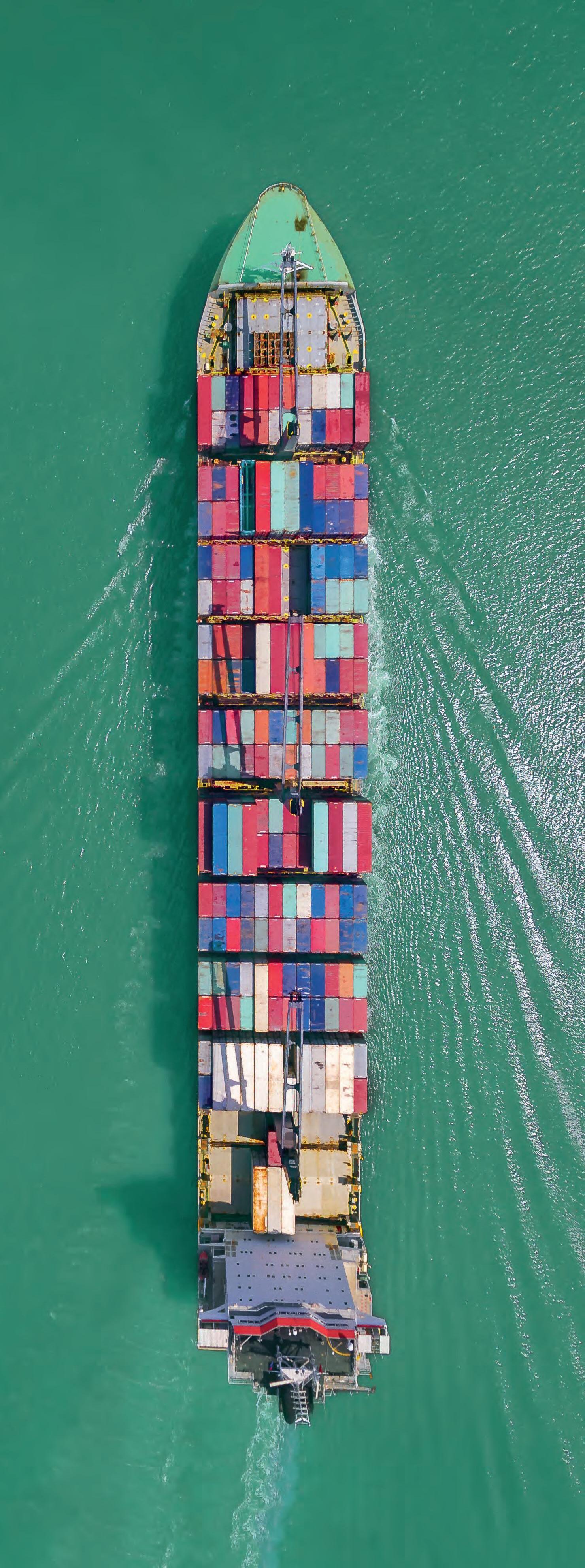
Like, comment and share Afreximbank content
ATG Initiatives: Discover more @afreximbank.com
Zenith leads the way
Despite Nigeria’s myriad economic challenges, Zenith Bank has successfully implemented several innovative strategies to navigate the landscape and remains the country’s leading bank
WORDS BY
Dr. Adaora Umeoji GRoup MaNaGING DIREcToR/cEo, zENITh baNK








Zenith Bank has always demonstrated the agility and resilience of a powerhouse financial institution with a special pedigree. Today, this tenacity and grit are being tested more than ever due to persistent macroeconomic headwinds in the home market. Despite these challenges, the bank is defying the odds and soaring to greater heights.
In 2022, Nigeria was Africa’s largest economy, boasting a gross domestic product (GDP) of $472.6bn. However, the devaluation of the Naira in 2023, prompted by the floating exchange rate policy, resulted in the country relinquishing its top spot. However, Nigeria has demonstrated astuteness in navigating through turbulent economic waters, intensifying efforts to reclaim its status as Africa's leading economy.
The government is proactively addressing key issues such as inflation and the complexity of multiple exchange rates. Notably, these efforts have started to bear fruit, with the Naira appreciating significantly against the dollar – from NGN1,525 in early February to NGN1,136 in mid-April, marking a significant recovery. This resurgence underscores a growing confidence among investors, buoyed by the Central Bank of Nigeria’s (CBN) adept handling of the foreign exchange market.
Recent policy changes, such as the elimination of fuel subsidies and the unification of exchange rates, complement these efforts. These measures have allowed market forces to play a more decisive role in determining the exchange rate, enhancing transparency and addressing previous market distortions. The appreciating value of the Naira is clear
evidence of the positive impact of granting greater autonomy to market mechanisms within the foreign exchange sector.
Additionally, recognising the need for comprehensive economic recovery, the government is tackling deeply rooted challenges, particularly in revenue generation. President Bola Tinubu has established a panel to reform Nigeria’s tax laws and fiscal policies to enhance revenue generation while curbing excessive borrowing. The committee’s objective aligns with the administration’s Renewed Hope Agenda, striving to foster sustainable development and achieve a minimum tax-toGDP ratio of 18 percent within the next three years without impeding investment or economic growth. This vision is pivotal in Nigeria’s journey towards building a trillion-dollar economy within the coming decade.
The recent recapitalisation programme of the banking sector by the CBN further complements these efforts, ensuring that the financial services sector is robust enough to support the nation’s economic ambitions. This initiative will strengthen the banking infrastructure, providing a solid foundation for Nigeria’s aspirations to become a trilliondollar economy.
A challenging environment
Nigeria’s economic challenges in recent years have significantly impacted the banking sector. Rating agencies, including S&P Global, have raised concerns that high inflation and interest rate hikes could exert pressure on asset quality and operations. Furthermore, the depreciation of the Naira has necessitated an increase in gross loans, potentially elevating the risk of non-performing loans, especially for smaller banks.
For Zenith Bank, the challenging macroeconomic environment has been a test of resilience. The bank has excelled, maintaining and strengthening its position as the most
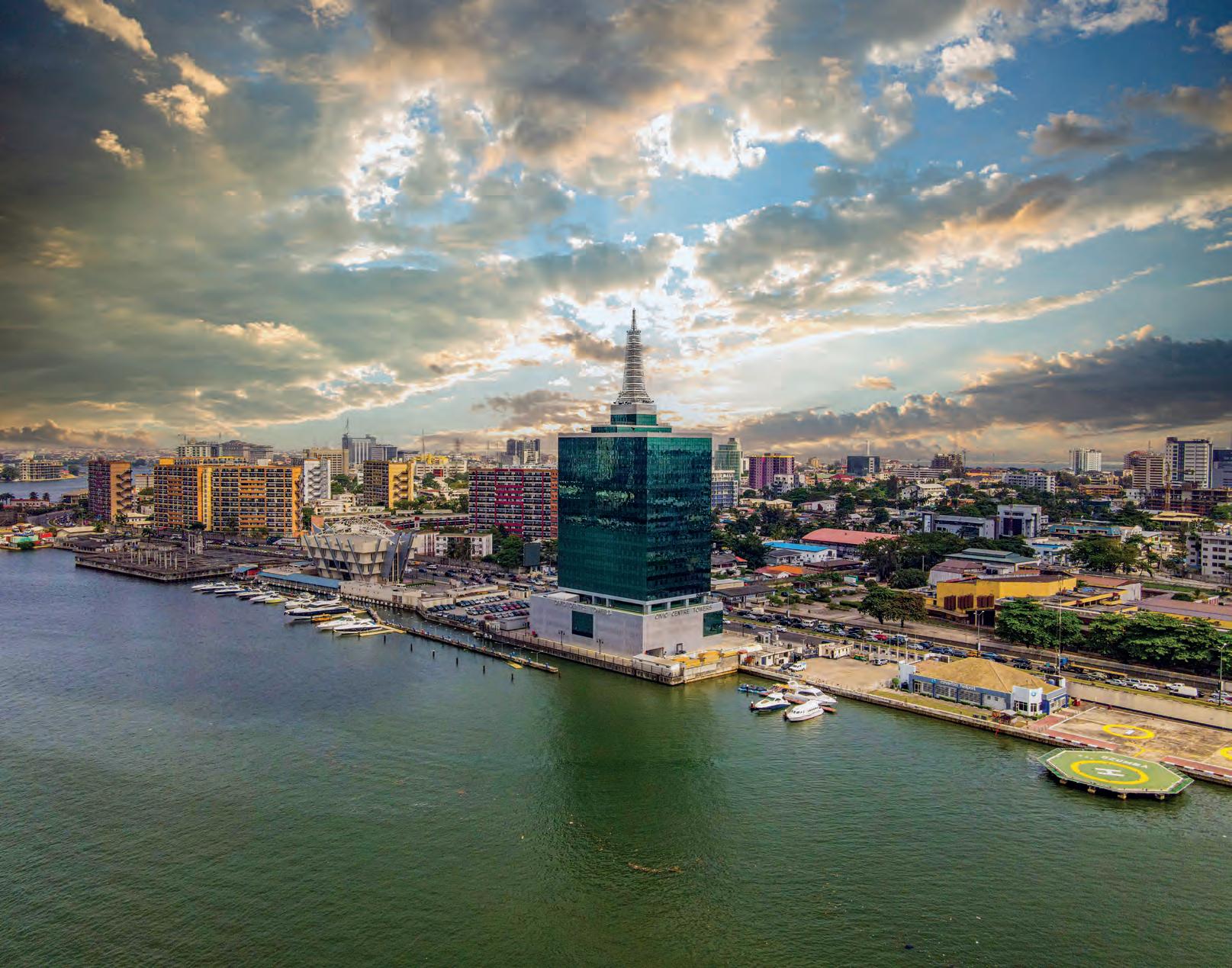
Nigeria’s current GDP
33.2%
Nigeria’s inflation rate in March 2024
highlight Zenith Bank reaching new heights as Nigeria’s most profitable financial institution with triple-digit growth in profitability. This impressive performance came after the bank sustained its net interest margin at 7.3 percent.
Over the year, Zenith Bank achieved a 180 percent increase in pre-tax profits, reaching NGN796bn ($693m), up from NGN284.7bn ($248m) in 2022. This feat marks a recordbreaking growth in profits, realised under challenging conditions. Importantly, it has solidified its leadership in Nigeria’s highly competitive banking sector, with a robust balance sheet that expanded by 66 percent to NGN20.4trn ($17.7bn).
58 | Summer 2024
banking Nigeria
victoria island, lagos, Nigeria

($957.7m) compared to NGN540bn ($470.2m) in 2022. Non-interest income, on the other hand, stood at NGN918.9bn ($800m) compared to NGN381bn ($331.7m) in the same period in 2022.
There is no doubt that Zenith Bank has thrived and achieved astronomic growth over a generation through bespoke financial products and services, superior customer service, digital transformation, innovation, and unparalleled investment in technology. The past months have proven the bank’s supremacy in strategy execution and its ability to navigate challenges and turn them into opportunities.
Two scenarios stand out. First is the bank’s exposure to the public sector. Given that Nigeria’s economy is heavily dependent on oil revenues, low crude oil production coupled with volatile crude prices in the international markets has led to a slump in earnings.
ever, it was the standout performer, posting an astounding 884 percent increase in pre-tax profit to NGN92.6bn ($80.5m).
Another highlight is the stellar performance and rapid growth of the retail market segment. Although individuals and households may have experienced reduced disposable income due to inflation, this has not shaken the confidence of customers in the Zenith brand. As part of its strategic objectives, Zenith Bank aims to become the leading retail bank in Nigeria.
ZeNiTH
bANk reCoGNiSeS THe imporTANCe oF SmeS ANd THeir SiGNiFiCANT uNTApped GroWTH poTeNTiAl
Last year, it made a significant leap, with retail customer numbers increasing to 36.4 million from 29.5 million in 2022. Retail deposits have also risen,
now constituting 46 percent of total deposits creased by 77 percent to NGN7.04trn ($6bn)
Placing the retail segment at the centre of long-term growth, Zenith Bank prioritises customer engagement and value innovation. The bank understands that due to intense competition, attracting and retaining retail clients demands creative thinking. Part of Zenith Bank’s strategy includes developing customer value propositions unique to each customer sub-segment. For effective delivery, the bank has built an extensive network of over 500 branches and deployed an everexpanding array of digital channels driven by cutting-edge technology.
Finance for all
Zenith Bank is also aware that it is imprudent to think of retail customers without considering the unbanked and underbanked. Nigeria has made tangible progress in driving financial inclusion. Nevertheless, the percentage of adults with formal financial services only stands at 65 percent, according to EFInA, a financial sector deepening organisation. Of »
Summer 2024 | 59
this, only 52 percent have a bank account. This falls significantly below the CBN target of 95 percent. To integrate the 28.8 million Nigerians excluded from the formal banking system, Zenith Bank has deployed extensive agency banking services. Currently, the bank boasts over 94,000 agents spread across 36 states and 774 local government areas. This vast reach ensures that the bank has a touchpoint in every location.
Physical touchpoints characterised by human interactions remain a fundamental aspect of banking today and even into the future. However, digitalisation has brought about inevitable disruptions. Zenith Bank was the first to acknowledge the transformative power of digitalisation in the Nigerian market. This explains why technology remains one of the bank’s major pillars, alongside ‘people’ and ‘service.’
For Zenith Bank, investing in information and communication technology (ICT) infrastructure to create innovative products and solutions has been essential. Becoming a trailblazer in digital banking has been central to transforming customer experiences and building a solid brand. The bank leverages different channels, including Mobile App, Unstructured Supplementary Service Data (USSD), WhatsApp (ZIVA – Zenith Intelligent Virtual Assistant), internet banking, automated teller machines, and points of sale. Throughout its operations, the bank continually re-engineers its digital platforms to effectively meet the needs of its numerous customers in terms of ease of use, safety, and convenience, thereby making transactions more seamless.
Today, the bank is reaping the benefits of its ICT investments. Digital onboarding, robotics, and enhanced cybersecurity measures have played key roles in facilitating growth in new accounts from 1.2 million in 2018 to the current 36.4 million. Apart from facilitating increased customer acquisition and loyalty, the bank is respected as an industry leader in customer experience. Internally, processes are characterised by speed and efficiency. The bank’s uninterrupted operation during the Covid-19 lockdowns is a testament to its prevailing digital culture.
Driving digital
Embracing and embedding an unrivalled digital culture means that Zenith Bank is always ahead of its peers in terms of innovation. In an industry with about 30 banks, Zenith Bank
ZeNiTH bANk remAiNS
uNSHAkeN iN iTS
purSuiT oF GroWTH
has demonstrated a strong track record of versatility in launching new products to cater to an ever-evolving market. Z-Woman, a product specifically targeted at women-led businesses across all sectors, is a clear example. This unique loan product offers the most competitive interest rates in the market and is available to businesses that are majority-owned by women. Through this product, Zenith Bank has extended about NGN50bn ($43.5m) in loans to five million Z-Woman customers. Tabul is another innovative solution designed to transform the customer experience at restaurants with simplified ordering and payment processing.
While Zenith Bank is responsive to changing market needs and ready to innovate, it has not lost focus on two other key market segments – small and medium enterprises (SMEs) and corporates. SMEs, in particular, are critical. Data shows that in Nigeria, there are over 36.9 million SMEs, constituting approximately 97 percent of businesses and contributing 48 percent of the GDP. Despite their large numbers and importance to the economy, particularly in terms of job creation, SMEs have not received the desired attention. Studies show that approximately 80 percent of SMEs in Nigeria face significant challenges that hinder their survival and progress. Limited access to capital and poor business practices have been identified as key causes of mortality before reaching their fifth anniversary.
Zenith Bank recognises the importance of SMEs and their significant untapped growth potential. For this reason, the bank has been at the forefront of providing them with the necessary support. This includes bespoke offerings, access to loans, and sector-based training. A standout product specifically designed for the needs of SMEs is SME-Grow My Business.
Zenith Bank believes in shared growth with SMEs. The bank has built partnerships that enable it to provide low-interest rate loans to SMEs. These partnerships also help build capacity and deepen knowledge. A case in point is the bank’s partnership with Google, which helps expose SMEs to the digital world via free Google listings. It also helps improve their management capabilities through quarterly capacity-building training.

60 | Summer 2024 banking Nigeria
»
Dame Dr. Adaora Umeoji, OON Group Managing Director/CEO, Zenith Bank

banking industry remains vulnerable to infrastructure deficit. Early this year, banking operations were among many that were impacted by a widespread broadband internet connectivity disruption caused by damage to an undersea submarine cable. Services on electronic and digital platforms were the
However, this cut had little to no negative impact on Zenith Bank’s services. This was because the bank has invested in robust systems and established strategic partnerships with leading internet service providers who helped reroute traffic via alternative internet circuits. This ensured that services remained available even at the peak of the disruption.
THe bANk HAS beeN A pioNeer iN SuSTAiNAbiliTy SiNCe beGiNNiNG iTS jourNey A deCAde ANd A HAlF AGo
Retrospectively, the cable cut was a red alert reinforcing the bank’s approach to investing in reliable and scalable IT infrastructure that can handle a high volume of transactions and withstand technological failures. A clear example is the ongoing IT overhaul programme dubbed ‘Project Tiger,’ designed to deepen the overall digital payments suite and offerings, creating multiple channels for digital service
Zenith Bank has made risk management the bedrock of its operations. A culture of risk awareness permeates the entire organisation, underpinned by impeccable leadership and strong governance structures. This has resulted in comprehensive risk management mechanisms. These include a risk appetite statement that serves as the cornerstone tool to align overall corporate strategy, capital allocation, and risk. Part of the tool’s watchlist includes the nature of the threat, controls/ mitigants, residual impact, and early warning mechanisms for each risk. Ultimately, the bank deploys a hybrid and holistic approach to protect the safety of customers’ assets and the
As a responsible corporate citizen, Zenith Bank remains committed to improving the social, economic, and environmental wellbeing of its stakeholders. This commitment is demonstrated through an elaborate corporate social responsibility strategy focused predominantly on healthcare, education, skill development, and other initiatives with maxi-
Summer 2024 61 banking Nigeria
NiGeriA HAS mAde TANGible proGreSS iN driviNG FiNANCiAl iNCluSioN
Propelling a nation towards sustained growth
Sri Lanka rebounded from a huge economic crisis due to timely measures. Sampath Bank led the post-crisis recovery with strategic lending, SME support, digital innovation and community initiatives
WORDS BY Ajantha de Vas Gunasekara ExEcuTIVE DIREcToR/cFo, SaMpaTh



The year 2023 will be remembered as a period of great transformation for Sri Lanka as the nation embarked on the arduous journey of rebuilding from the ground up following its worst-ever economic crisis in 2022. Well-timed macro prudential measures implemented by the authorities, including the normalisation of monetary policy and the relaxation of import restrictions, saw the resurgence of all major economic sectors in the latter part of the year. Other key indicators, such as the progressive easing of inflationary conditions, strengthening foreign reserves and stability of the exchange rate in 2023, also provided further assurances regarding the improving health of the Sri Lankan economy.
Skillfully manoeuvring to the cyclical shifts in the broader economic landscape, the local banking sector remained at the forefront of the country’s economic expansion. However, having been subjected to prolonged economic shocks in recent years, it became increasingly clear that the banking sector was strained to the limit and unable to withstand further pressures.
Against this backdrop, the foresight exhibited by the government, the regulator and the International Monetary Fund in shielding the banking sector during the Domestic Debt Optimisation (DDO) programme is indeed commendable. Excluding the banking sector from the domestic debt restructure has helped to preserve the capital adequacy of banks, and been instrumental in empowering the sector to drive credit expansion in order to fuel postcrisis rejuvenation.
Drawing from past experiences, Sampath Bank opted for a cautious approach to credit expansion, with lending activities undertaken mainly on high-priority and systemically important sectors outlined in the national devel-
opment agenda. Significant accomplishments in this regard include the funding of a 15 MW wind power project and the involvement in a syndication to finance Sri Lanka’s largest ground-mounted solar project to date – a 100 MW endeavour slated to begin in the first quarter of 2026.
Targeted campaign
Considering that the SME segment remains the backbone of the Sri Lankan economy and its resurgence is vital for sustained GDP growth, a targeted campaign was initiated to cautiously support SMEs operating in the tourism and export-orientated manufacturing sectors via the concessionary credit lines issued by the Central Bank, the Ministry of Industries as well as the special Asian Development Bank (ADB) credit line. To complement these efforts, the bank unveiled ‘Sampath Export Partners,’ a dedicated unit to assist export-orientated SMEs and start-ups with export-related documentation as well as to enable them to access market information and business networking opportunities. Meanwhile, recognising the lack of financial maturity within the SME sector, specialised advisory services were further enhanced with the bank’s Credit Nursing Unit (CNU), entrusted with the responsibility of instilling greater fi nancial discipline among SME customers.

SAmpATH
At the same time, responding proactively to the country’s need to boost trade, Sampath Bank’s trade facilitation services were significantly expanded in 2023, while ties with global partner networks were further strengthened to aid in Sri Lanka’s push to rebuild global trade links that were compromised during 2022. Sampath Bank further reinforced its digital superiority in 2023, with the launch of several industry firsts, among them the groundbreaking new interface to en-
able remote accounts opening via QR for the first time in Sri Lanka. Another major development that proves Sampath Bank’s desire to leverage technology to benefit the nation and its people was the historic partnership with UNICEF – Sri Lanka, wherein Sampath Bank was appointed as the ‘Facilitating Bank’ for the distribution of funds to mothers from low-income families and caretakers with young children facing challenges in accessing proper nutrition and healthcare services amid the prevailing economic crisis in Sri Lanka.
Flagship initiative
The bank continued to demonstrate its concern for the underserved community through its flagship community initiative – the ‘Wewata Jeewayak’ tank restoration programme. The year 2023, which marked the 23rd year of operation for the Wewata Jeewayak programme saw the bank deepening its investment with a total of five new projects being undertaken – the highest number in a single year. Hand in hand with these efforts, the
62 | Summer 2024
banking Sri Lanka
baNK
bANk’S TrAde FACiliTATioN ServiCeS Were SiGNiFiCANTly eXpANded iN 2023

bank’s long-standing oceanic ecosystem restoration campaign – ‘A Breath to the Ocean’ – was further expanded to focus specifically on turtle conservation and coral restoration.
In 2023, Sampath Bank garnered several prestigious awards, solidifying its position as a leader in the banking sector. Internationally, it was recognised as the ‘Best Bank in Sri Lanka’ at the Euromoney Awards for the fifth time, and at the Asiamoney Best Bank Awards, it secured honours for ‘Best Bank for CSR, Sri Lanka’ and ‘Best Bank for ESG, Sri Lanka.’ Domestically, Sampath Bank was lauded as the ‘Most Loved Banking Brand’ and ranked in the top 10 ‘Most Loved Brands’ at the LMD’s Brand Annual Awards 2023.
The bank’s prowess in banking technology was acknowledged at the LankaPay Technnovation Awards, where it received a Gold Award for Financial Institution of the Year for the ‘Best Digital Payment Strategy’ and several Silver and Bronze accolades for its digital payment strategies and customer convenience initiatives. At the Infosys Finacle Innovation
iN
2023, SAmpATH
beCAme A SiGNATory To THe
NATioNS
Awards, Sampath Bank shone, winning Platinum for innovative solutions like the ‘Tourist Fuel Pass,’ ‘Export Repatriation Process’ and ‘Touchless Cash Withdrawal,’ and Gold for its ‘Moratorium Process.’ These awards underscore Sampath Bank’s commitment to excellence and innovation across various banking domains, both nationally and internationally.
In 2023, Sampath Bank became a signatory to the United Nations Global Compact (UNGC), thereby formalising its commitment to support the UNGC’s 10 universally accepted principles in areas such as governance, human rights, labour, environment, and anticorruption, by undertaking to integrate them into the bank’s policies and practices, and in doing so contributing towards the UNGC vision to promote responsible business conduct and address pressing global challenges.
Structures strengthened
Meanwhile, faced with the risk of employee attrition in 2023 as the economic crisis-induced pressures gave rise to skilled migration out of the country, Sampath Bank moved swiftly to retain key personnel. Remuneration structures were further strengthened and the succession-planning programme revamped to focus on targeted talent development for middle management and executive grades, supported by extensive training and knowledge-sharing workshops to address persistent skill gaps. Coaching and mentoring initiatives were further intensified, enabling identified high performers to be offered promotions and job rotation assignments to inspire them to advance their career journeys within the bank.
Despite internal and external challenges, Sampath Bank delivered a strong financial performance for FY 2023, recording a total operating income of Rs91bn ($281m) for the year. A key achievement in the current financial year was the 68 percent reduction in impairment charges attributed to the combined impact of improving economic conditions as well as the buildup of additional provision coverage. This was the result of prudent provisioning strategies adopted in 2022 to account for risk elevated exposures within the bank’s loan and advances portfolio.
Buoyed by the substantial reduction in collective impairment charges, Sampath Bank’s net operating income shot up to Rs70.8bn ($219m) in the year under review, substantially higher than the Rs48.2bn ($132m) recorded in the previous financial year. And despite inflation-induced high operating costs, the bank’s profit before taxes (PBT) expanded by 98 percent year-on-year. Sampath Bank’s balance sheet position further strengthened in FY 2023, marked by 16.4 percent improvement in the asset base. The bank closed the current financial year recording strong improvements across all capital ratios, while improved profitability during the current financial year helped to bolster the bank’s total equity to Rs148bn ($456m) as of December 31, 2023.
Through the commitment to prioritise the wellbeing of stakeholders, while consistently delivering strong financial results, Sampath Bank has yet again proven its unending commitment to support Sri Lanka and its people in their path to economic empowerment.
Summer 2024 63 banking Sri Lanka
n
bANk
uNiTed
GlobAl CompACT
Colombo, Sri Lanka
Centennial legacy, magnificent transformation
Discover how a Taiwanese government-owned bank, which has been established for more than a century, reinvented itself in an increasingly tough business environment through three major strategies
INTERVIEW WITH
Paul C. D. Lei
chaIRMaN, MEGa baNK


The reinvention of a long-established Taiwanese government-owned bank, facing challenges in a tough business environment, would likely involve innovative strategies to adapt and thrive. Embracing digital transformation to stay competitive in the rapidly evolving financial landscape through, for instance, more investments in digital banking platforms, mobile apps and online services would be one of the strategies a bank might employ.
Other challenges include the diversification of services to offer a broader range of financial solutions, which could help mitigate risks associated with fluctuations in specific markets and industries while tapping into new revenue streams, as well as the incorporation of sustainability and social responsibility into business practices to attract socially conscious customers and investors. Social responsibility is gaining significant traction in the financial landscape, contributing positively to society and the environment.
By aligning with global sustainability goals and demonstrating a commitment to corporate social responsibility, the bank can enhance its reputation and differentiate itself in the market. These are the key strategies put in place by the Mega International Commercial Bank/Mega Bank, which came into being as a result of the merger of the International Commercial Bank of China and Chiao Tung Bank, effective on August 21, 2006.
Formerly known as the Bank of China (later renamed as the International Commercial Bank of China) and the Chiao Tung Bank during the late Qing Dynasty and the early Republic of China, it has made significant contributions to the internationalised deployment of Taiwanese manufacturers and enterprises, industrial upgrades, and activated economic development through its global presence and extensive remittance network. Presently, it plays a leading role in Taiwan’s banking industry including international trade and
foreign exchange operations, international syndicated loans, project financing, and startup and entrepreneurial investments, among other things.
Leveraging the advantage of its global presence and correspondent banks, the bank has made immense contributions in supporting domestic companies to expand internationally, upgrading industries, and promoting economic developments. In recent years, by following in the footsteps of peers in advanced countries, the bank has dedicated all efforts to optimising corporate governance and promoting sustainable development.
Mega Bank is headquartered in Taiwan, with overseas operations mainly in Asian countries. The group is focused on developing emerging markets and countries in Southeast Asia, and as of the end of 2023, has 108 branches in Taiwan and 39 overseas operations in 18 countries/regions. Among the 39 overseas locations, Mega Bank has 31 overseas branches and sub-branches, three overseas representative offices and marketing offices, and five subsidiaries and branches in Thailand.
Chairman Paul C. D. Lei holds a Cornell Ph.D. in Economics and took office in June 2023. He told World Finance that Mega Bank cannot rest on its laurels. He expects all employees to adopt a proactive attitude of “facing challenges and embracing changes” to tackle various obstacles, including geopolitical conflicts, escalating inflation, and intensifying competition in the financial landscape.
Lei also outlined three major strategies, which include the implementation of environmental, social and governance (ESG) principles, systems optimisation, and nurturing talents, aiming to lead Mega Bank into another century of glory. Mega Bank also actively develops new financial products and has launched marketing projects to continuously promote business development, to respond to market dynamics, meet customer needs in real time, and adapt to technological and digital financial trends.
Mega Bank also continues to strengthen research and development, deepen various digital financial services, seek cross-industry cooperation opportunities, expand service
meGA
bANk HAS beeN CulTivATiNG A CompreHeNSive CulTure oF CompliANCe
scope and develop new customers. While Mega Bank is actively investing in digital financial research and development, it has also applied for financial patent protection. As of August 31, 2023, a total of 564 new patents and a total of 116 invention patents have been approved by the Intellectual Property Bureau of the Ministry of Economic Affairs, for a total of 680, which ranks it first among public stock banks.
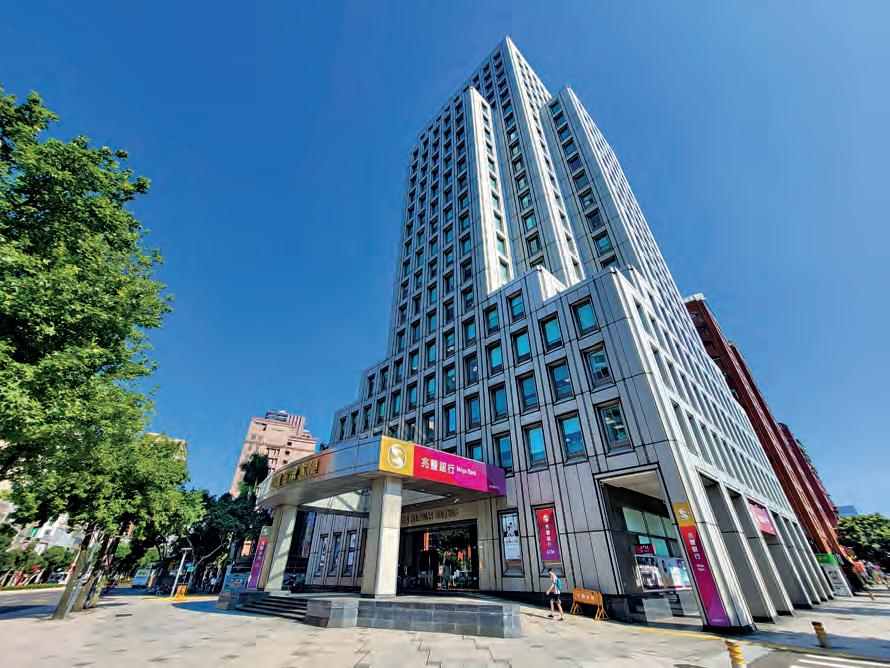
Committing to net zero
Mega Bank places great emphasis on global climate change and carbon reduction initiatives. It has set targets aligned with the Science-Based Targets initiative (SBTi) and Taiwan’s 2050 Net Zero Emissions Goals. It not only aims to reduce 25 percent of greenhouse gas emissions by 2030 but also to achieve net zero emissions by 2050.
It has planned an ‘Environmental Sustainability Pathway’ by implementing systematic carbon reduction measures and introducing various international ISO standards and green building solutions to enhance its operational environmental and energy management efficiency. Currently, three of its selfowned office buildings have obtained dual certifications for ISO 14001 environmental management and ISO 50001 energy management systems.
Moreover, Mega Bank incorporates sustainable business concepts into financial product design, as well as investment and financing approval systems to encourage Taiwanese enterprises to prioritise and implement ESG practices. In line with the Fi-
64 | Summer 2024
banking Taiwan

Finance 3.0’ policy, it offers various sustainable-related financial products and services, effectively guiding its customers towards low-carbon transitions. For example, it provides venture capital loan projects focusing on renewable energy and job creation, consumer credit products for green buildings and maternity support, issuance of green credit cards, and investment in green energy technology industries amplifying Mega Bank’s core business impact on positive sustainable finance.
System optimisation
In response to the rapid changes of the digital era and challenges of outdated core host system architectures, Mega Bank has initiated a five-year core host system transformation plan from 2021. Starting from the perspectives of users/customers, employees, and senior bank management, it has gradually adjusted the traditional ‘big core and small peripheral’ system architecture to a ‘lightweight core and micro-services’ architecture.
108
Mega bank branches in Taiwan
39
Mega bank locations overseas
nt$31bn
Mega Bank’s post-tax net profit in 2023
also cares for the physical and mental health of its employees, obtaining ISO 45001 certification for occupational health and safety management systems in 2022.
the transformation of the consumer finance business as an example, credit loans have been streamlined with an online application platform while ensuring personal data security and privacy protection. Mega Bank has introduced the Autonomous Use of Personally Related Data (MyData) platform and integrated personal data functions with the bank’s IXML (Financial Electronic Certificate), simplifying the loan approval process with the i-Loan Approval Management system. Leveraging automated preliminary review and data analysis, along with the development of a ‘Loan Value Model Calculator’ for data-driven portfolio evaluation, the bank aims to deliver a satisfying lending experience to its customers.
Talent cultivation
On the other hand, its employees in this happy enterprise reciprocate with enthusiasm and dedication to their work. In 2023, Mega Bank achieved a post-tax net profit of NT$31bn ($960m), with each employee contributing an average of NT$5.11m ($158,130). The post-tax earnings for the first quarter of 2024 reached NT$9.9bn ($306m). As Mega Bank is a systematically important bank (DSIBs) in the Coalition of Movers and Shakers on Sustainable Finance, Mega Financial Holding, its parent company, has been selected for inclusion in the ‘TWSE RA Taiwan Employment Creation 99 Index’ and ‘TWSE RAFI Taiwan High Compensation 100 Index’ for many years. With such honourable achievements, it is no surprise that Mega Bank has been rated as Taiwan’s Best Commercial Bank by World Finance magazine for two consecutive years.
However, these are not the most important achievements for Lei. In his vision, Mega Bank should be “a happy Mega Bank for its employees; a friendly Mega Bank for its customers; a profitable Mega Bank for its shareholders; and a sustainable Mega Bank for Taiwan.”
Establishing a compliant corporate culture that balances profitability and risk is crucial for the long-term success and sustainability of any financial institution. In recent years, Mega Bank has been cultivating a comprehensive culture of compliance, balancing short-term profitability, business expansion, and risk management.
Meanwhile, it has introduced key middleware components, including applications, data, reports, and monitoring, to achieve the long-term goal of core host system transformation. This allows frontend services to be applied flexibly and to respond to business needs swiftly, meeting customer demands. Taking
Lei emphasised that employees are the most valuable assets of an enterprise, and a primary aspect of implementing ESG is taking good care of them. Immediately after assuming office, Lei took steps to ensure an immediate increase in employee remuneration and increased meal subsidies and maternity benefits. These measures, which resonated deeply with the employees, show Lei’s commitment to supportive leadership and a positive work environment.
Developing clear ethical standards, implementing a comprehensive compliance framework, fostering a culture of compliance from the top down, providing ongoing training and education programmes to ensure that employees have the knowledge and skills necessary to comply with regulations and internal policies, as well as implementing solid risk management practices, are only some of the strategies put in place to ensure a balanced approach that helps to protect the interests of stakeholders while maintaining regulatory compliance and upholding ethical standards.
The implementation of the Global AML and Sanctions Programme aims to enhance the effectiveness and sustainability of the overall anti-money laundering system. With a solid foundation in place, the bank further strengthens its overseas profitability and business development, giving its overseas branches a significant boost. n THe
Indeed, Mega Bank is deeply committed to fostering a happy workplace. Apart from offering competitive salaries and benefits, it promotes effective communication channels between labour and management through employee dedication surveys, human rights due diligence investigations, and labour-management meetings. Furthermore, Mega Bank
Summer 2024 | 65 banking Taiwan
mAde immeNSe CoNTribuTioNS iN SupporTiNG domeSTiC
eXpANd
bANk HAS
CompANieS To
iNTerNATioNAlly
left One of Mega Bank’s branches



tHe priVate eQUitY stOrm

after years of unprecedented growth in private equity with the sector playing a crucial role in funding business, a rise in interest rates along with regulatory concern would indicate that it is not all plain sailing. John Muchira reports »
66 | Summer 2024

Summer 2024 | 67
On April 22, Nathanaël Benjamin was in an ominous mood regarding the state of the private equity (PE) market. In a speech delivered at a Bloomberg event, the Bank of England (BoE) Executive Director for Financial Stability Strategy and Risk was blunt when bringing attention to the industry that has grown in size, complexity and interconnectedness. From the speech titled ‘Not-soprivate questions,’ it was crystal clear that regulators are reaching convergence: the PE industry has ballooned to levels that could pose threats to the global financial systems, yet it continues to operate in opacity.
“Shining a light on the current dynamics in the private equity market is crucial at this juncture, given the important role the sector plays for the real economy,” said Benjamin. He added that making sure the financial system evolves in a way that is conducive to safe and sustainable financing practices is essential for durable economic stability.
For Benjamin, a member of BoE Financial Policy Committee, current realities facing the PE market have converged to present the ideal moment to focus the spotlight on the industry. Notably, recent developments have the potential to disrupt the supply of funding to real economy companies. Besides, they have the potential to cause systemic institutions, including banks, to experience significant and correlated losses due to exposures linked to private equity.
“These dynamics, as well as exogenous shocks, could all be amplified by vulnerabilities in this sector, such as opacity and interconnectedness across institutions and markets. So this is typical financial stability ground. That’s why we care,” he stated.
Clearly, these are not the days when regulators turn a blind eye on the PE market. Having achieved exponential growth over the past two decades, the industry is floundering. Up until two years ago, the PE market had managed to thrive riding on a model built on cheap financing and leverage. However, the confluence of higher borrowing costs, market volatility and economic uncertainty has brought about considerable challenges for the PE ecosystem. These challenges have regulators ringing alarm bells.
“Clearly debt markets have impacted returns,” says Mike Donaldson, CEO at South Africa-based RMB Corvest, a pioneer in private equity that is 100 percent focused on equity investing, with PE being its primary
asset class. He adds that while PE has encountered headwinds in recent times, what is indisputable is that PE has matured into a multi-trillion-dollar industry that is absolutely critical in driving growth of businesses and job creation.
The PE growth trajectory
That PE has achieved phenomenal growth is evident. Data indicates that globally, assets under management in the private equity sector have increased significantly over the past decade from $2trn in 2013 to $8trn in 2023. The industry, however, remains relatively small compared to the public equity market, whose size stands at $100trn and banking sector balance sheets at $98trn.
In the US, PE firms generate vast economic output. They create 12 million jobs and contribute 6.5 percent of the gross domestic product, amounting to $1.4trn. In the UK, the sector plays a crucial role in funding businesses, with around $313bn actively invested in companies. British Private Equity and Venture Capital Association data show that last year, UK businesses backed by PE and venture capital (VC) employed 2.2 million workers (1.9 million are PE-backed only), collectively earning $94bn. More notably, suppliers to these businesses employ an additional 1.3 million workers. Overall, this is comparable to the entire education sector’s workforce.
The situation is similar across other regions including Asia-Pacific, Latin America and Africa. In Asia-Pacific, for instance, PE investments have been on a growth trajectory, hitting a five-year high of $244bn in 2021 according to KPMG. In recent months, however, investments have plunged to $84.7bn. In Africa, the PE industry has emerged as a lifeline providing alternative routes to growth for companies that may otherwise have struggled to achieve the requisite scale. PE and VC investments in Africa soared 66 percent in 2022 to $7.7bn according to S&P Global Market Intelligence data, the highest aggregate value for the region.

$2trn
privATe equiTy Aum iN 2013
$8trn
privATe equiTy Aum iN 2023
66% riSe iN pe ANd vC iNveSTmeNTS iN AFriCA iN 2022
6.5%
68 | Summer 2024 it’s a Private Matter
Gdp ACCouNTed For by pe iN THe uS THe vibrANCy oF CApiTAl mArkeTS iS FACiNG reAl THreATS From privATe equiTy FirmS
oF

“The flow of PE investments has been healthy in Africa and continues to facilitate growth for many businesses for which bank credit was not easily accessible,” notes Paras Shah, Managing Partner at Bowmans Kenyan office. He adds that the majority of the deals in the continent are relatively small, ranging between $15m and $25m. This, however, reflects the small nature of the market.
Visibly, PEs have unleashed their pooled financial war chest to snap up valuable companies in pursuit of handsome returns within the shortest period possible. Companies in industries like software, communications, IT and media, semiconductors, health and pharmaceuticals, renewable energy and agriculture have attracted massive investments across the globe. It has been a similar case for sectors like financial services, transport, fast moving consumer goods and tourism and hospitality.
The growth of the PE industry and its expanding tentacles of influence is also bringing about another phenomenon – migration of highly qualified professionals from industries like banks and insurance to PE ventures. Banks, in particular, are feeling the weight of the exodus with erstwhile employees now becoming direct competitors or clients. More alarming, however, is that banks are witnessing an increase in default rates of leveraged loans. Though unclear how deep the malady runs, for banks that are overly exposed the risks have the potential to blink red.
Into the unknown
After years of sustained growth, the PE market has over the past two years been sailing in uncharted waters. The rosy growth that had been witnessed in prior years started to crash in 2022, and continued last year. The root cause of the crumble: the Fed’s rapid increases of interest rates, the sharpest since the 1980s. The Fed’s aggressive approach to arrest stubborn inflationary pressures has had contagion effects, instigating hikes across the globe.
“The strong growth and attractive returns of the private equity asset class over the last 10 years has occurred during a period of low interest rates. However, since the start of 2022 interest rates have increased substantially,” observed Benjamin. He added that markets are not expecting for the foreseeable future a return to the low levels seen in the recent past.
High borrowing costs have inevitably exposed the PE industry’s soft underbelly. Apart from sapping the confidence of investors, it
THe SHeer SCAle ANd Speed oF rATe riSeS lAST yeAr, ANd THe uNCerTAiNTy ArouNd THAT, WAS A SHoCk For THe iNduSTry
has brought about excruciating challenges. Evidently, it has been a season of slump across all matrices for PE cutting across fundraising, dealmaking and exits. The ripple effects are being felt across the whole ecosystem. Desperate companies – a majority being small and medium-sized companies (SMEs) – in need of growth capital cannot attract financing.
General partners (GP) who manage funds are feeling the squeeze in terms of management fees and carried interest dry up. Limited partners (LPs), the investors into the private equity funds who include sovereign wealth funds, insurers, pension funds, foundations, and wealthy individuals, among others, are in a state of despair, with funds returning the lowest amount of cash since the financial crisis 15 years ago. The “majority of PE houses have not realised their core investments during these cycles and have chosen to hold for longer,” explains Donaldson.
Global consultancy firm Bain & Company’s 15th Annual Global Private Equity Report clearly captures the reality of the PE industry in recent times. The report contends that echoes of the 2008 global financial crisis have reverberated loudly. However, the industry has never seen anything quite like what has happened over the last 24 months. “The sheer scale and speed of rate rises last year, and the uncertainty around that, was a shock for the industry in 2023,” said Hugh MacArthur, global private equity practice chairman at Bain & Company.
Confidence was the first casualty of the Fed’s jacked rates, something that left the PE industry gasping for air in terms of investments, according to the report. In 2023, buyout investment value dropped to $438bn, a 37 percent nosedive from 2022 and the worst total since 2016. When compared to 2021’s peak, it was 60 percent down. Overall deal count dropped by 20 percent to around 2,500 transactions. Against 2021 highs, deal count was down 35 percent. The malaise infected regions across the world, with North America, Europe and Asia-Pacific experiencing
Summer 2024 69 it’s a Private Matter »
» significant declines. While dealmaking was badly off, exit activity fared even worse as rising interest rates and macro uncertainty left buyers and sellers at odds over valuations. In fact, exits have propelled to the pinnacle and have become the PE industry’s most pressing conundrum. Apart from seizing up and stanching return flows of capital to LPs, they have left GPs sitting on an aging $3.2trn of unsold assets. This accounted for a staggering 28,000 companies in which PEs cannot exit.
Notably, the median holding period for a buyout has also increased and now stands at 5.6 years, way above the industry norm of about four years. In 2023, the businesses that held for a lengthy four years or longer comprised 46 percent of the total, the highest since 2012. The plunge in exit activity saw buyout-based exits drop by 44 percent to $345bn by value globally. The number of exit transactions fell by 24 percent to 1,067 during the year. A drop in exits was recorded across all geographies.
“Breaking the logjam will need GPs to take charge of their destiny in terms of how they can manage portfolios in order to generate increased distributions for LPs,” noted Rebecca Burack, head of the global private equity practice at Bain & Company.
This is critical, and somewhat urgent coming on the backdrop of PE funds returning the lowest amount of cash to investors last year.
Data by US-based investment bank Raymond James Financial shows that distributions to LPs totaled 11.2 percent of funds’ net asset value. This was the lowest since 2009 and stood well below the 25 percent median figure across the last 25 years.
No way out
Inabilities by PE funds to exit and return capital to LPs had a battering effect on fundraising. The silver lining is that new fundraising contributed an impressive $1.2trn to the stunning $7.2trn in fresh capital the industry has accumulated since 2019. That, however, was the only positive. This is because the amount raised last year was actually the least the industry has pulled in annually since 2018. More tellingly, it was down 20 percent from 2022 totals and almost 30 percent off the alltime high in 2021.
The biggest contributing factor in fundraising plunge is that low returns have prompted LPs to become overly selective on any new redistributions. In essence, LPs are opting to carry out thorough due diligence seeking to zero in on GPs that have over the years demonstrated resilience in returning capital. “Assuming patient capital, the returns
should materialise once markets re-rate,” explains Donaldson. Investments, exits and fundraising challenges have put the PE industry at a crossroads. The situation has been exacerbated by a whole basket of dry powder that cannot be deployed due to slowdown in dealmaking. According to S&P, global private equity dry powder soared to an unprecedented high of $2.5trn in 2023 from $2.3trn in 2022, an eight percent increase. Notably, 25 PE firms held 21.8 percent of the dry powder, 19 of which were headquartered in the US. Apollo Global Management led all other firms, with $55bn in uncommitted capital available to its private equity strategies. Other firms sitting on record levels of dry powder include Blackstone, KKR, Carlyle Group, CVC Capital, Warburg Pincus, Brookfield, Bain Capital and Advent International, among others.
“The accumulation of dry powder is an indication that firms have been facing challenges in looking for deals. There haven’t been that many targets,” notes Shah. He adds the economic uncertainties have created a scenario in which investors are more restrained and selective. The dynamics have also been complicated by the valuation gap, which has been one of the primary impediments to dealmaking in recent months. Due to high interest rates, vintage PE assets have faced the risk of valuation mismatches at exit. To a large extent, this explains the increase in the median holding period for a buyout.
The valuation quagmire has forced GPs and LPs to seek solace in the secondary market in pursuit of liquidity. Yet even here, increased supply has put downward pressure on the prices and valuations. Research by US-based financial services firm Jefferies shows that secondary volumes stood at $112bn in 2023 compared to $108bn in 2022, representing a four percent increase. Robust buyer demand, significant supply of both LP portfolios and GP-led opportunities and stabilising market conditions drove secondary volume higher. Of importance to note is that although pricing overall had improved due to rising public valuations, only one percent of LP interests were priced above the net asset value (NAV) of the company portfolio.

“Sustained high interest rates in 2023 altered investors’ required return on capital and limited their use of leverage, resulting in a mere one percent of funds pricing above NAV, and many older, tail-end interests trading below 75 percent of NAV,” states a report by Jefferies.
Undoubtedly, it has been a turbulent period for the PE industry on all fronts. This, however, did not stop the execution of some earthshaking deals last year. A majority of the top deals closed were valued at below $1bn. Only about a quarter were valued at more than $1bn, according to Pitchbook.
The $13.5bn acquisition of Japanese conglomerate Toshiba by PE firm Japan Industrial Partners stood out among the topmost deals. The transaction was nothing short of groundbreaking. It marked the end of a 74year era for Toshiba as a listed company. It also gave the struggling conglomerate a new lease of life. Toshiba was just one of a growing number of take-private deals.
iT HAS beeN A TurbuleNT period For THe privATe equiTy iNduSTry oN All FroNTS
Others included Silver Lake with the participation of CPP Investments paying $12.5bn to acquire Qualtrics, an experience management company, and Stonepeak paying $7.4bn to acquire Textainer, one of the world’s largest lessors of intermodal containers. Other notable deals in 2023 included Roark Capital paying $9.5bn to acquire Subway, one of
70 | Summer 2024 it’s a Private Matter

the world’s largest quick service restaurant brands, and Apollo agreeing to buy out the shareholders of Univar Solutions, a commodity and speciality chemical distributor, at a cost of $8.1bn.
The fact that PE firms are increasingly becoming vultures devouring publicly listed companies is among the reasons why regulators are shining the spotlight on the industry. Globally, the vibrancy of capital markets is facing real threats from PE firms. A survey conducted by US-based multinational law firm Dechert last year paints a clear picture. In the survey of 100 senior PE executives in the US, Europe and Asia, 94 percent said they have plans to pursue take-private deals. In 2022, only 13 percent had take-private ambitions.
The enormity of PE devouring publicly listed companies is unprecedented. Over the past three decades or so, the number of listed companies in the US has plunged by more than half from about 8,000 to less than 4,000 currently. A large number have been taken private by PE firms. In the first quarter of this year alone, there were 21 take-private deals according to audit firm AY. “This underscores the degree to which PE firms continue to perceive opportunities and mispricings despite tremendous recent gains in public equities indices,” stated Pete Witte, EY Global Private Equity Lead Analyst.
The end of the tunnel Unplugging companies and taking them away from the hawk-eyes of regulators and public scrutiny is fuelling the culture of opacity in the PE industry. The effect is that concerns are now mounting that this has the potential to cause tremors, even quakes, on the global financial systems. PE cross cutting links with the banking sector, insurance, pension, sovereign wealth funds, private credit markets and leveraged lending is adding to these fears. “This intricate web of connections adds to the notable lack of transparency, making it difficult to assess financial stability risks,” noted Benjamin.
PE portfolio company bankruptcies is another area of grave concern. The devastation of high interest rates has extended to portfolio companies. In the US, for instance, S&P data show that bankruptcy filings by PE and VCbacked companies surged to 104 last year. This was the highest annual total on record, representing 174 percent growth over the 38 filings in 2022 and accounted for more than 16 percent of all US bankruptcy filings. Bankruptcies in the healthcare sector were among the highest, totalling 17.
That the past two years have been distressing for the PE market is not in dispute. The industry, however, is starting to see some light at the end of the tunnel. Easing borrowing costs
over THe pAST THree deCAdeS or So, THe Number oF liSTed CompANieS iN THe uS HAS pluNGed by more THAN HAlF
and a renewed interest from lenders has resulted in a rebound in activity. The trend is projected to gain pace in the coming months. “With rates set to moderate in coming months there is a greater sense of stability,” noted MacArthur. He added that despite the positive signs, cautious optimism overrides prospects in the immediate and medium term.
The first quarter of 2024 offers a glimpse. S&P data show that PE and VC deal value stood at $130.6bn during the period compared to $124.3bn for the same period in 2023, representing a 5.1 percent increase. With 60 percent of GPs expressing optimism on 2024 prospects compared to 34 percent last year, the industry believes the worst is behind it, and probably over.
The PE industry is looking into the future with renewed potency. Generative artificial intelligence (GenAI) is already shaping up as one of the game-changing tools that are bound to define how the industry operates. The rate of GenAI adoption is proving to be phenomenal. Some 74 percent of PE-backed firms are currently either using AI solutions in their transaction processes or are piloting potential solutions. These cut across making investment decisions, carrying out due diligence, analysing market trends and patterns, streamlining back-office functions to enhancing privacy and safeguarding against cybersecurity.
For the PE market, adoption of smart technologies is not the only necessity. The lessons of the past two years have shown that discarding the principles of measured risk in pursuit of short-term profits can be counterproductive. This reality, coupled by regulators’ resolute view that the PE market must grow in a safe and sustainable manner, is bound to force the industry to change its modus operandi. What will not change, however, is the foundation under which the industry stands – private. n
Summer 2024 | 71 it’s a Private Matter
Too much power: the problem of private equity
Index funds and private equity have outgrown their purpose and undermine the legitimacy of American capitalism, argues a Harvard academic and former SEC executive
Prof. John Coates
haRVaRD pRoFESSoR






As a Professor of Law and Economics at Harvard Law School, as well as former Acting Director for the Division of Corporation Finance for the US Securities and Exchange Commission (SEC), John Coates doesn’t mince his words when it comes to regulating the wildest beasts of modern capitalism. In his latest book, The Problem of 12: When a Few Financial Institutions Control Everything, he explores the origins of a quiet revolution in American finance. ‘Big Four’ index funds such as Vanguard and BlackRock control more than 20 percent of the votes of S&P 500 companies. Private equity firms, the likes of Carlyle and KKR, have amassed trillions of assets while removing from public markets and scrutiny an increasing number of firms. This is the titular ‘problem of 12’: a few financial institutions hold dangerously outsized sway over US politics and finance.
Professor Coates sat with World Finance ’s Alex Katsomitros to discuss how we arrived at this crucial juncture and what regulators and policymakers can do about it.
How did index funds and private equity grow so big?
Index funds are growing faster than the economy, the stock market and even the companies they own, because they offer a remarkably good product: a low-cost way to achieve diversified investment in the equity, debt and alternative markets. They have a track record of 50 years of outperforming most active managers, even before fees.
It is not simply retail investors who benefit from the product, but most large institutional investors, including pension funds and endowments. They also enjoy enormous economies of scale. That allows them to lower fees even more. Today, you can get close to zero costs.
The combination of growth and concentration coming from economies of scale means that the top index funds now own 25 percent or more of all US-listed companies. Private equity funds are also growing faster than the economy and public capital markets and enjoy enormous economies of scale and access to information. They are constantly buying and selling companies, raising funds, exchanging ownership stakes with other investors. They also run credit funds. So they are responsible for an excess of 25 percent or more of all fee-generating activity for Wall Street. They are the biggest players positioned to harvest information across the entire capital market, and they use that information to time exits, entries and fundraising.
You argue in the book that index funds and private equity have practically become ‘political organisations.’ How did that happen?
The politics arises because of concentration. If the industry only consisted of many dispersed firms, like the mutual fund industry 30 years ago, I don’t think they would be significant political players. But the index funds have grown at the largest scale, especially the top three or four. So the problem is that 12 people largely control the outcomes of votes at shareholder meetings for public companies.
When Exxon had a proxy fight a few years ago, the dissident was able to elect directors to the board over the objection of Exxon. They had a very different political agenda, but they were able to do that because the index funds supported them. Currently there is a debate going on over labour policy at Starbucks and other companies. Again, index fund votes are largely determining how those struggles are playing out. So it is the concentration of voting power in a small number of funds that gives them enormous power through the
shareholder control process, and with a different result than 20 years ago.
Private equity is different. Their power comes from controlling about 15–20 percent of the entire US economy. About eight or nine percent of US workers work for private equity, even if they don’t know it, because part of the structure of private equity is to make no disclosure. It is difficult to find out who owns what. But they make important choices about how the companies they operate are run, and they have political effects.
Currently in Boston there is a hospital chain that private equity bought out a few years ago. They took on financial risk, and it is probably going to go bankrupt in the next few weeks. That is going to shut down major hospitals in Boston, depriving people of basic healthcare. That is putting a spotlight on the role of private equity not just in that sector, but other parts of the economy too.
You also claim that private equity is not really private anymore. Why is that?
Private equity was originally private in the sense that most of the capital that early buyout funds were raising was from a few wealthy individuals. The SEC limited the number of investors, preventing funds from raising money from lots of institutions. They also had ‘lookthrough’ rules, which meant that if a fund raised money from other funds, it could be a problem. That changed in the 1990s. Now SEC reports show that their principal investors are institutional investors: pension funds, endowments, other funds. So the ultimate economic beneficiaries whose money is being managed are millions of people. A typical private equity fund is no longer managing money just for a few people, but for the public.
It is effectively the same type of capital formation process that goes into a public company, but through a different set of channels, which don’t trigger a requirement to register with the SEC. In fairness, they don’t list the shares of their portfolio companies. So in that sense they are still private, but the ultimate economics are more public.
72 | Summer 2024
wealth management Private Equity
WITH
INTERVIEW
12 people lArGely CoNTrol THe ouTComeS oF voTeS AT SHAreHolder meeTiNGS For publiC CompANieS
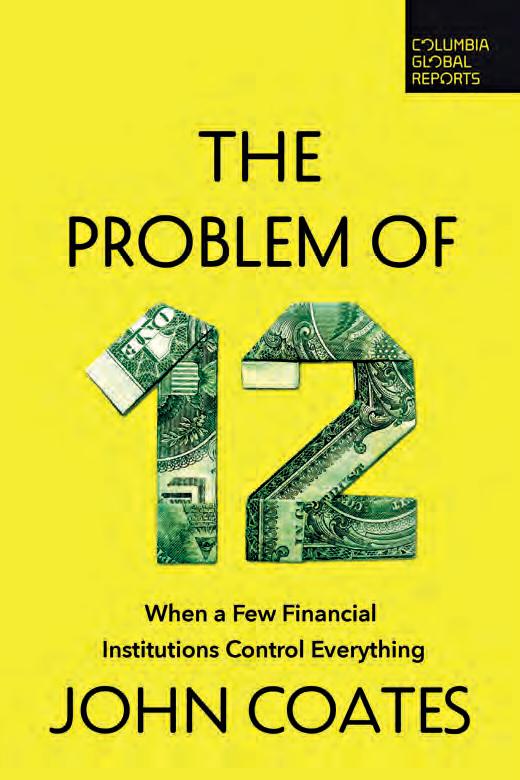
Should they be regulated like public companies then?
I don’t think their structure lends itself to taking public companies’ disclosures and dropping them onto private equity. However, there is a public interest in how they are being run, what risks they are taking, and whether that generates returns that compensate investors. The reason is that US pension funds, especially public pension funds, face relatively light oversight. So if private equity is doing a large part of the investing for those pensions, ultimately US taxpayers are on the hook if the pension funds’ money is not well invested.
Private equity occasionally goes through periods when the risks they take don’t generate returns. When they buy a company, they borrow money and that debt creates financial risk. Some private equity funds generate other kinds of harm through the way they run the kinds of companies
A TypiCAl privATe equiTy FuNd iS No loNGer mANAGiNG moNey juST For A FeW people, buT For THe publiC
they increasingly own. Today, they are active in professional services, healthcare, service businesses regulated in ways that make some disclosure a good idea for the industry.
I wish it was as simple as doing the same thing as with public companies, but I don’t think that would be a good model. Most of their operations are portfolio companies that don’t have the capacity to produce quarterly reports or engage with investors. It would be odd to require that kind of detailed reporting when the only exit would happen several years later. So a reporting regime is a good idea, but not the public company regime.
If this is a problem of market concentration, isn’t breaking them up the standard regulatory response?
If we are talking about an excessively concentrated product market or service market, antitrust or competition policy has often been the way we respond. But it is not the only way. Take early dominant players in sectors that at the time were high-tech, like electricity and water. Companies that provided what we now call utilities enjoyed massive concentra-
tion. We didn’t try to break those up. Sometimes we did, and sometimes there were limits on size.
iNdeX FuNdS Are GroWiNG FASTer THAN THe eCoNomy, THe SToCk mArkeT ANd eveN THe CompANieS THey oWN
Another path is to regulate them and allow them to provide benefits because they enjoy economies of scale. This is ultimately the problem. If you break up companies that enjoy efficiencies at great scale, and therefore concentration, you are imposing greater costs on the people who benefit from their services. It will be more costly for 12 index funds to function than four, so they won’t be able to do the same job at the same price.
Isn’t it worth paying that price?
Maybe, but another way to go would be to say: ‘okay, we don’t mind that they are so big and concentrated, but we don’t want them to use their power in ways other than their basic utility, which is to invest in a low-cost, diversified way.’ On the regulation side, they have already started to take the first step themselves by being more transparent about how they go about making voting decisions on behalf of other people. They now report quarterly, although they are only required to report annually. I don’t know why they can’t report in real time; the technology is available for that. I would encourage them to go even further.
More importantly, they have started, at least in principle, to give their investors the option to pick different policies for them to follow about how to vote. So far, the policies are very similar to each other. Over time for this to work, policies will have to become more varied. There is also a question of whether they will follow the instructions, but this is a work in progress.
The closest analogy is thinking of them as quasi-government agencies. We don’t want to have multiple central banks, that is a contradiction: two central banks are not better than one. What we want is more accountability and transparency.
Would you pin your hopes on a Biden or a Trump administration to address this issue?
Any government that doesn’t obey the law, I don’t have any faith in. I may not love the Biden administration all the time on every issue, but they follow the rules. With normal Republican and Democrat candidates, I might have a different view, but Trump has zero commitment to the rule of law. Once you say that, there’s nothing else to say. n
Summer 2024 | 73 wealth management Private Equity
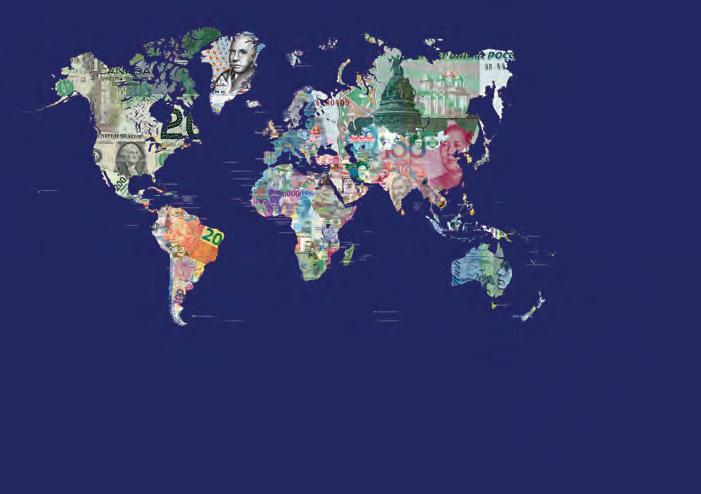
Tackling the world’s hidden-debt problem
There are several challenges surrounding debt in developing economies but with enhanced transparency, improved creditor reporting and better debt management systems, progress can be made
WORDS BY Manuela Francisco
GLobaL DIREcToR FoR MacRoEcoNoMIcS, TRaDE aND INVESTMENT, WoRLD baNK
entry and reconciliation. The newly designed software could also allow for input from creditors on loan disbursements and payments, as suggested by the 2023 UNCTAD Trade and Development Report. This would enable the real-time generation of World Bank International Debt Statistics and other statistical reports, based on fully validated data.








From the Covid-19 pandemic to advancedeconomy interest-rate hikes, developments over the last few years have left many developing economies struggling to repay their debts. But the problem might be even bigger than the world realises, as many sovereign debts are hidden, undisclosed, or opaque. This prevents policymakers and investors from making informed decisions. Some low-income countries have made progress on disclosing their debts: the latest Debt Reporting Heat Map shows a rise in disclosure from 60 percent in 2021 to 80 percent today. But some countries have regressed, and significant gaps and weaknesses remain. For example, information might not be released swiftly enough or in adequate detail, and countries might disclose only central-government debts, leaving out other public and publicly guaranteed liabilities. Consider domestic debts: many low-income countries, shut out of financial markets, have resorted to issuing such debt to meet their financing needs – often without reporting these instruments. Similarly, opaque currency-swap lines are being used to prop up heavily indebted borrowers. The World Bank’s 2021 report on public-debt transparency in low-income countries anticipated both of these trends. Boosting debt transparency requires action in three key areas.
Dealing with debt
First, we need to improve the software that records and manages public debt. Just as individuals use internet banking to manage their personal finances, governments rely on specialised software to manage their debt portfolios. But whereas advanced economies design their own systems – typically as part of an integrated information-technology solution that manages budgetary, accounting, and treasury processes – most low-income countries rely on ‘off-the-shelf’ software subsidised by the international community. These arrangements are often inadequate to deal with countries’ increasingly complex debt portfolios, let alone to deliver comprehensive, timely debt reporting. This became starkly apparent during debt-reconciliation efforts under the G20’s Common Framework for Debt Treatments beyond the Debt Service Suspension Initiative. The debt records of the four countries that applied to the Common Framework – Chad, Ethiopia, Ghana and Zambia – were sometimes incomplete and often inaccurate. To resolve these issues, Excel spreadsheets had to be manually reconciled – a months-long process that significantly delayed restructuring negotiations. We recommend creating a task force to coordinate the design of better debt-management systems. With the involvement of all the main service providers, task-force members would standardise debt definition and computation methods, and lead the development of user-friendly IT solutions. That way, national authorities could focus on debt analysis and management, rather than remaining bogged down by data
The second crucial measure needed to strengthen debt transparency is the creation of incentives for public borrowers to disclose their debts at both the national and international levels. This will require reforms of national legal frameworks as well as efforts by multilateral organisations to promote debttransparency initiatives. Already, the World Bank’s Sustainable Development Finance Policy includes debt-disclosure incentives for low- and lower-middle-income countries receiving support from the International Development Association. This has contributed to improvements in debt reporting and coverage in more than 40 low-income countries. Debt restructuring also creates opportunities to implement such incentives. The necessary and often arduous debt-reconciliation process can be used to provide detailed information on outstanding debt, as in the case of Zambia. It also gives countries a chance to wipe the slate clean and organise their debt records from scratch. Eligibility criteria for the provision of debt relief could include minimum transparency requirements to encourage the provision of data until debt relief is fully provided.
The third area where progress is needed is improved reporting by creditors. To facilitate transparency in official bilateral lending, creditor countries should follow the recommendations of the G20 Operational Guidelines for Sustainable Financing, such as improving data collection and publishing more information on new and existing loans. Bilateral creditors should publicly disclose both outstanding debts and the core terms of foreign exposure, including direct loans, guarantees, and Export-Credit Agency insurance.
The US Treasury’s loan-by-loan repository offers a good model for creditors seeking to boost the transparency of their portfolios. To support these efforts, creditors should avoid including confidentiality or secrecy clauses in new loan agreements, as a 2022 World Bank paper argues. Among the debt challenges facing low-income countries, strengthening debt transparency is one where concrete and meaningful progress is within reach. Success will require a combination of practical technical solutions and full cooperation from every stakeholder. n
74 | Summer 2024
wealth
Debt Management
management


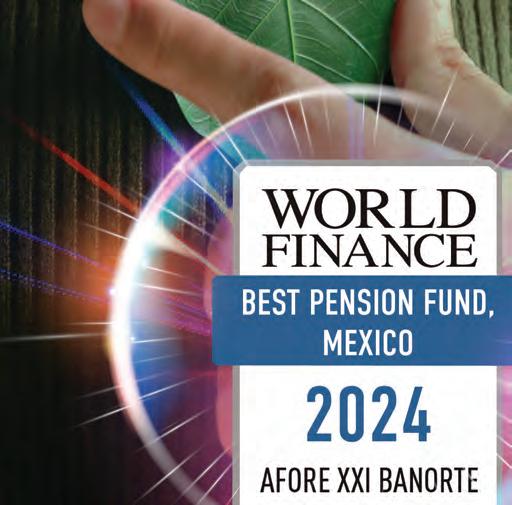









www.xxi-banorte.com
The democratisation of wealth management in Africa
Africa is home to a new generation of tech-savvy, affluent and HNWI clients. First Bank of Nigeria Limited is taking a growth path to attract sophisticated investors seeking a deeper, more demanding relationship
Idowu Adebayo Thompson
GRoup ExEcuTIVE & GLobaL hEaD,
baNKING & WEaLTh






World Finance gets the low-down on the future of the private wealth industry in Nigeria, as FirstBank wades deep into hyper-powered tech, artificial intelligence, and highly dispersed client ambitions. What are the risks and responsibilities – and how are these safeguarded for this demanding, switched-on client base?
The high-net-worth client business catering to Africa’s growing affluent population is super-competitive. What challenges does this pose for FirstBank, and how are they met head-on?
Africa is home to 135,200 high-net-worth individuals (with $1m or more in investable assets), 312 centi-millionaires ($100m in investable assets or more), and 21 billionaires. Summed up, the bank is faced with the challenges of anticipating and responding to the changing investment and wealth management needs of well-educated and well-travelled individuals who routinely benchmark the bank’s products and services against those of offshore service providers.
So how is this demand met?
We combine a mix of highly personalised service delivery and technology to enhance the client’s experiences with us. We seek to attract the affluent next gen and new money – both to sustain business growth and leadership in the private wealth industry. We leverage technology as an enabler but not to replace humans wholly in the client experience.
What do clients want, in your view?
Speed and competence in service delivery. Our approach has been to focus on the client’s journey, and to seek the most creative ways to make their customer experiences both more
personable and rewarding at the right cost. This is achieved by providing highly competent support and leveraging the right technology and tools.
What of political stability, crucial for client risk confidence?
Political instability and governance issues can undermine confidence in the banking system. Affluent individuals can always invest in other jurisdictions to safeguard their wealth.
So how does FirstBank negotiate these tensions?
Political instability anywhere – either remotely or directly – shapes the responses of the players in any market. Private wealth organisations in Africa are no exceptions. These tensions guide how we organise ourselves and also respond to changes in the market.
Is it about a different attitude?
Tensions pose a serious challenge to developing sustainable business models. At FirstBank Private Banking and Wealth Management, we see opportunities where others may focus on challenges. We do this by anticipating high impact changes that could affect personal wealth, and by providing our clients with seamless investment and wealth management solutions to protect and grow their wealth. FirstBank also maintains a presence in the UK providing options for those with offshore banking, mortgage and asset-based lending, and investment needs. A well-trained private banking team sits in this jurisdiction and caters to the needs of these clients.
Where is the Nigerian economy seeing most entrepreneurial growth and potential – and how does FirstBank frame itself as a trusted player in this space?
In the private banking and wealth management business specifically, there are new growth areas in tech and innovation. More private equity firms are showing greater interest in our markets now. Inflows to start-up and tech firms were estimated at $4.5bn in

2023 though this was a decline on the 2022 figures in response to some of the headwinds experienced in some African markets. This sector, however, continues to remain very relevant.
Due to Nigeria’s oil exports, fluctuating oil prices and its impact on the Nigerian Naira, currency volatility is part of life. How does FirstBank manage guidance to clients?
The private banking and wealth management business seeks new growth areas and in turn, more contemporary sources of wealth outside the traditional resource driven areas. We help our clients articulate long-term financial goals and offer a range of investment, wealth management and lifestyle interventions to support these goals. We encourage our clients to adopt risk-mitigating strategies in building investment portfolios to ensure the sustainability of their wealth, while leveraging a range of solutions like mutual funds, fi xed income (investment) as well as estate planning (fiduciary) working conjointly with proprietary product partners in FirstBank and our holding companies.
What is the FirstBank view of the Nigerian economy for the next three to five years?
In the recent past we have seen several policy changes aimed at placing the economy on track. With a 600 basis points upward adjustment in the monetary policy rate and in
76 | Summer 2024
wealth management Private Banking INTERVIEW WITH
pRIVaTE
MaNaGEMENT, FIRSTbaNK

turn higher lending rates, there is guided depreciation of the local currency with a focus on promoting price discovery and stability in the value of the currency. These changes have come with challenges and especially for clients who are constrained to deal with rising inflation (33.69 percent) as of April 2024. It is expected the various government interventions would impact the economy positively with stronger outcomes and a high degree of stability in the next three to five years.
African banks need to offer investment options that match changing values without compromising on profitability. How is this managed?
By being more agile and less reactive. Recognising new growth opportunities while simultaneously protecting the core of their businesses. A good example is the adoption of a well-defined digital wealth management application to cater to a wider and potentially profitable upper affluent base, and to attract the millennial and Gen X future wealth cohorts.
Your competitors aren’t just banks now but fintech and IT companies. With so much blurring of lines, how do you plot a long-term strategy?
Africa is home to seven unicorns – companies with a valuation of more than $1bn. Our longterm strategy is to leverage the distinct advantage of our own franchise – a deep knowledge of the market backed by our long and enviable
135,200 hNWIs in africa
21 billionaires in africa
What about corporate governance structure and practices, in relation to board composition?
The bank has an internal governance framework built around best practices and regulatory standards. There is a significant increase at board level understanding of the HNWI and ultra-HNWI business. This is evident in the stronger levels of advocacy and a heightened interest of its role in our overall enterprise strategy.
Are African regulators moving fast enough to support the future digital landscape changes? Is it always a game of catch-up?
We HAve SeeN SeverAl poliCy CHANGeS Aimed AT plACiNG THe eCoNomy oN TrACk
history, stretching back more than 130 years. We offer solid competence to our private banking and wealth management, institutional and commercial clients. The bank continues to invest heavily in technology as we target more opportunities in adjacent areas for growth.
African countries often compete to attract foreign direct investment (FDI). A favourable tax regime can be an incentive for foreign investors, especially for tech entrepreneurs. Does FirstBank want to see change for clients here?
The government has a policy framework around this with several designated free trade zones listed across the country offering varying incentives to companies ranging from tax breaks to preferential access to regulatory interventions and more.
Tech privacy makes headlines daily. What security and confidentiality safeguards for client peace of mind are in place?
The private wealth business model recognises the high need for confidentiality as distinct from secrecy which may exist outside of regulatory ambits. Chinese walls are built around sensitive data (static and non-static) leveraging technology. We invest in the training of personnel for an in-depth appreciation of the needs and requirements for confidentiality for a highly personalised private banking and wealth management business.
Yes. Most of the regulators in the key markets in Africa have a clear stance and view of the role of digitisation. However, there is always room for improvement.
What are the tensions between strong corporate governance, profitability and long-term client trust?
The bank would never sacrifice the trust of its long-term clients or indeed its corporate integrity in the pursuit of profit. We are absolutely woven into the fabric of society in the markets we operate.
The balance of taxes and incentives are particularly important in the African banking landscape. Has the government got the mix right?
These are choices dictated by practicalities and the needs of the sovereign. Nigeria has and would continue to pursue an optimal mix of attracting offshore investors while also ensuring the viability of its local industries.
What can the Western financial services industry learn from African players?
Where are African players clearly ahead, do you feel?
Resilience. Banking is a business of managing risks and less about avoiding risks. The ability to deliver despite the intervening uncertainties.
Which financial services companies do you admire most, regardless of jurisdiction?
Other than FirstBank, personally it would be the DBS (Development Bank of Singapore).
A practical example of a financial institution that surmounted deep-seated challenges to transition from a conservatively traditional bank to a nimble and opportunity-seeking business reputed to be Asia’s safest bank. n
Summer 2024 | 77 wealth management Private Banking

A new generation in banking
With emerging technologies rapidly changing many different industries, BNL BNP Paribas remains committed to its approach, which focuses on promoting growth, sustainability and technology while leading a competent new era of bankers
WORDS BY Luca Bonansea
hEaD oF pRIVaTE baNKING aND WEaLTh MaNaGEMENT, bNL bNp paRIbaS






After the Covid-19 pandemic health emergency, the global balance has been deeply marked by the outbreak of conflicts in Ukraine and the Middle East and rising tensions between China and Taiwan. All this has made the overall scenario more precarious, opening a period of geopolitical instability and uncertainty. It has been referred to – several times – as a ‘polycrisis.’
Today, in order to survive global competition, radical change programmes must be implemented by adopting strategies that ensure, on the one hand, effective economies of scale to increase productivity and improve the economic performance and, on the other, a real positive impact on communities while at the same time fostering a structured energy transition.
We are experiencing a phase where significant phenomena influence our sector. In a similar scenario, knowing how to adapt quickly to change and to understand the new needs rapidly and effectively is fundamental in order to offer ‘added value’ to the customer. Here is an example (but we could make many others). We think of the accelerative effect that artificial intelligence has had and how it will continue to shake up many fields across the most varied sectors, obviously including the financial industry. This means changing production and distribution processes. This means disrupting business models that have worked so far but which risk becoming inefficient if they do not exploit new technologies, processing in real time huge amounts of data to generate useful insights to customise client needs, working deeply on people’s reskilling. It is certainly a complex scenario but at the same time intellectually very stimulating. Within BNP Paribas, the ‘technology’ component is one of the three pillars of our business plan, together with ‘growth’ and ‘sustainability.’
And with reference to artificial intelligence, today we already have in use more than 700 use cases for applying artificial intelligence in the BNP Paribas group in various departments of the company. The main challenges in our industry are: mindset, people, skills and technology. We firmly believe that to make the difference it is necessary to invest in the continuous training and excellence of our bankers and our team of specialists. In addition to this training activity certified by the best Italian and foreign universities, it is necessary to invest in generational turnover through the inclusion of young collaborators alongside expert colleagues with greater skills.
AT leAST Four diFFereNT GeNerATioNS oF proFeSSioNAlS operATe iN THe privATe bANkiNG ANd WeAlTH mANAGemeNT iNduSTry
This allows new expertise and new skills to proliferate throughout the company, which is indispensable for easier conversations with the new generations (new generations that will also be our new customers in the very near future). The ability to observe and understand the evolving contexts within our industry is a necessary requirement to effectively manage the assets of our customers, especially in a complex and dynamic world
78 | Summer 2024
wealth management Private Banking
It is a series of meetings and debates on the territory that includes, in addition to the presence of our bankers and our clients, the participation of experts in the sector, university teachers and entrepreneurs. Their points of view and their experiences allow us to bring to the debate an effective reading of the main challenges brought about by the new context.
The distinctive elements of our model
More generally, the speed with which new behavioural and social dynamics take root, especially following the pandemic, and the rapid development of new technologies, especially those related to artificial intelligence, require an acceleration in the process of adapting the banking sector.

6,700 professionals employed by BNP Paribas’ Wealth Management
€430bn assets under management (as of March 31, 2024)
that changes rapidly. The role of our bankers on the territory is crucial. The bankers of BNL BNP Paribas Private Banking & Wealth Management need not only a deep understanding of the financial markets, but specific expertise on our entire range of investment services and solutions. They require above all a strong ability to listen to the needs, requirements and objectives of our customers so that they can develop a real strategic plan that integrates all the components, even the very complex, of the medium and long-term prospects of the company and of the family. This is an activity that requires skills and teamwork and this is why several specialists in various fields and geographies (including credit, real estate, wealth planning, legal and tax advice, asset management, real estate advisory, investment banking and trustee services advice) support our bankers.
We also worked to create specific meetings dedicated to understanding evolving contexts, to interpreting the main elements of changing geopolitical scenarios, to reading emerging trends and characteristics.
THe mAiN CHAlleNGeS iN our iNduSTry Are: miNdSeT, people, SkillS ANd TeCHNoloGy
At BNL BNP Paribas, programmes to ensure this acceleration are structured as part of our Growth Technology Sustainability (GTS) business plan and have already made it possible to take important steps to transform the company, making it leaner, enabling faster decision-making capabilities, and allowing it to stay in step with the times. This activity certainly touches the entire area of technological infrastructure development, allowing for the digitisation of most products and services in order to simplify the customer journey of our clients. It also affects other aspects that aren’t just related to technology.
For example, we recently launched an important ‘social plan’ dedicated to generational turnover, targeting roughly 900 voluntary redundancies with incentives for over 750 hires. This plan therefore provides for a turnover rate in line with others in our industry, with roughly 85 percent of colleagues leaving us being replaced (for the network, the replacement rate will be 100 percent) and enriching the company with new skills and expertise needed to meet the new industry challenges.
The generational transition also concerns the professionals of Private Banking and Wealth Management and is one of the strategic pillars of our department, representing an important factor in our growth plan in Italy. Over the next 10 years this will become a major challenge in the country, since almost one out of every three bankers is over 50. Now, at least four different generations of professionals operate in the Private Banking and Wealth Management industry: from baby boomers to GenZ, through GenX and Millennials.
Our strength, the international reach and leadership position of BNP Paribas in Wealth Management in Europe are excellent drivers
to attract the best professionals who work in this field and want to invest in the growth of their skills.
Nurturing talent
Moreover, to be recognised as a point of reference and a place at which to achieve career goals, it is necessary to continue dedicating great energy to create a stimulating and attractive working environment, able to offer a structured career path that guarantees respect for diversity and inclusion, where the work/life balance is a constituent element of a sense of belonging and pride, together with the values of our brand.
If I had to summarise the essential elements that distinguish our team, I would certainly say the ability to listen to the needs of our customers, the specialisation of our bankers to build ‘tailor-made solutions’ able to handle even very complex needs, and a clear and shared vision on our development plan in private banking and wealth management in Italy. We surround ourselves with professionals who, coupled with ambition and entrepreneurship, have intellectual curiosity, are able to navigate new ideas and concepts in their field and who are open to new technologies.
The new generation of bankers must have a strong sensitivity to impact investing and sustainability-orientated investment solutions. We believe that our customers have the extraordinary power to have a positive impact on our planet and on communities and our ambition is to support them in their projects to make this happen.
We are part of an international group that provides an integrated and structured platform of transversal and vertical expertise. Globally, BNP Paribas’ Wealth Management combines excellence in wealth management with more than 6,700 professionals and €430bn of assets under management (data as of March 31, 2024).
Our ‘One Bank’ model provides our customers with cutting-edge solutions allowing the wealth management and corporate & investment banking teams to work synergistically to bring ‘the entire bank to the customer’ in a single moment. This mindset to work in a transversal and integrated way is part of the DNA of our group and is based on trust, collaboration and the sharing of knowhow and skills. The ultimate goal remains to bring our customers high value-added proposals, supporting them in all phases of the life cycle and ensuring a very deep level of customisation of financial solutions (including co-investment activities with us on exclusive deals).
The new generation of bankers must be able to move in this ecosystem using expertise, leadership and kindness. n
Summer 2024 | 79 wealth management Private Banking
A look at Mexico’s new pensions reform
Afores hold an important position in Mexico’s economy and recent reforms aim to bring about a more inclusive financial landscape for its citizens by implementing a new mixed model for its pension system. Might this model become a new standard for troubled pension systems around the world?
WORDS BY David Razú Aznar cEo, aFoRE xxI baNoRTE





On May 1, a major new reform was introduced to Mexico’s pension system, which included the guarantee of a 100 percent replacement rate for pensions of below-the-mean-wage workers in the individual account scheme, with an additional fiscal cost to be initially financed by the creation of the Welfare Pension Fund, WPF (Fondo de Pensiones para el Bienestar). This reform is not an isolated event – the country’s retirement system has very recently undergone several transformations to correct aspects of the defined-contribution scheme while strengthening it.
Previous problems and reforms
The original Mexican pension system of the Mexican Institute of Social Security (IMSS) operated under a defined benefit, pay-as-yougo scheme until 1997, when, prompted by Mexico’s economic and demographic shifts, a significant transformation occurred. That year, Retirement Funds Administrators (Afores) were established, marking the shift to a defined-contribution scheme, with retirement savings through individual accounts managed by the Afores. Subsequently, public sector employees were integrated into the Afore system in 2007 (they contribute to another institute, ISSSTE).
The 1997 and 2007 reforms, although helpful in coping with the rising and unsustainable fiscal costs of pensions, presented several drawbacks in terms of coverage. First, for those who did not remain in the old system, minimum contributory years to gain the right to a pension were raised from 10 to 24, a problem in a country where workers contribute on average only 43 percent of their active life to social security. Additionally, the minimum guaranteed pension (MGP) for those who did qualify for a pension was less than
25 percent of their average wage and very few workers were expected to get a pension above it. When the first generation of the Afore system filed for a pension in 2021, 24 years after the implementation of the scheme, only a few of them were going to actually receive it and they would mostly get the very low MGP.
Facing these immediate problems, the administration of President Andrés Manuel López Obrador introduced two critical reforms. In 2019, the Welfare Pension for Senior Citizens (Pensión para el Bienestar de los Adultos Mayores) was established, providing a non-contributory pension funded by the federal government to all individuals aged 65 and over. Later, a reform to the Afore scheme in 2020 increased mandatory contributions that will gradually rise from 6.5 percent of wages in 2021 to 15 percent in 2030, reduced Afore managing fees by 30 percent to a cap aligned to an international reference, enhanced the MGP, and decreased the number of weeks needed to qualify for a pension (from 750 in 2021, to rise gradually to 1,000 by 2031).
An overview of the new measures
The new pension reform approved this year was also supported by President López Obrador. It intends to further strengthen the system by increasing the pension to equal the last contributory wage to all workers earning a salary lower than the current IMSS average of 16,777 Mexican pesos a month (around $1,000 at the current exchange rate), provided they are subject to the Afore system and are at least 65 years old. If the worker takes an earlier retirement the pension remains unchanged. Additionally, they must fulfill the years of contribution requirement for a pension.
THiS reCeNT reForm iS pArT oF AN AmbiTiouS peNSioN proGrAmme oF THe CurreNT FederAl GoverNmeNT AdmiNiSTrATioN

Level of mandatory wage contributions by 2030
6.5%
The 2021 mandatory wage contributions
In Mexico’s pension system, workers save their contributions as well as their employers’ and the government’s into individual retirement accounts managed by Afores. Upon retirement, their monthly pension comes from this saved amount. If the balance is not enough to reach the MGP, the government subsidises their pension as soon as the worker’s savings are insufficient, so that they receive the MGP. Now, with the 2024 reform, the Solidary Supplement will be added to the MGP so that the pension is equal to the last contributory wage.
The government will ensure this benefit through the so-called Solidary Supplement
The Solidary Supplement therefore creates a new fiscal obligation to be financed, precisely, by the WPF, which is set to start with an initial capital of 64bn Mexican pesos (around $3.8bn). The fund will draw on a variety of sources, like proceeds from the liquidation of the National Agricultural Development Fund and real estate revenues generated by the National Fund for Tourism Promotion, among others. One issue that sparked debate in the
80 | Summer 2024
wealth management Pensions

10 years after they had the right to them, in cases where those accounts have been inactive for a year. The new laws of IMSS, ISSSTE and the Institute of the National Housing Fund for Workers previously stated that accounts in such a situation would be disposed of by their corresponding institutions, provided they created a reserve to return the funds to workers or their beneficiaries in case they eventually claimed them. Under the new legislation, those unclaimed accounts will go to the WPF, which will be established by the Ministry of Finance as a public trust fund at Mexico’s Central Bank (Banco de México). The obligation remains to create a reserve to ensure that refunds can be made to workers or their beneficiaries whenever claimed.
Fact check: unravelling speculation
More than a few media outlets and commentators sparked a heated debate at the time of the legislative process by asserting that the new measure implied an unlawful expropriation of workers’ savings by the government. This assertion proved to be false, as the new law clearly establishes that property rights of the workers over the assets are imprescriptible and the reform merely represents a shift in
the institution managing them for those who meet the mentioned criteria (it is estimated that the resources to be transferred to the WPF add to less than 0.5 percent of the total managed by the Afores). In other words, unclaimed funds previously managed by social security institutions will now be managed by the WPF, with the same obligation of maintaining a reserve to pay any claims that may arise. In fact, the pre-reform system never failed to return any claimed funds, due to the reserve created; there is no reason to believe that with WPF this would be otherwise.
The benefits of the reform
THe CouNTry HAS CreATed A uNique miXed model, WHiCH briNGS AbouT A more iNCluSive ANd robuST eNviroNmeNT
The number of beneficiaries receiving the Solidary Support Aid is projected to grow from 8,529 individuals in 2024 to approximately 2.7 million by 2050. The amount of the supplementary subsidy each pensioner receives is expected to average 4,592 Mexican pesos per month (around $275). To ensure sustainability, the reform includes a provision for an actuarial review of the funding sources every eight years, enabling adjustments in case the projected figures fall short.
Key takeaways from the pension reform
This recent reform is part of an ambitious pension programme of the current federal government administration, which has showed a stark determination in going the extra mile in retirement benefits.
Complementing the 2019 and 2020 changes with the latest in 2024, the country has created a unique mixed model, which brings about a more inclusive and robust environment: it now has a universal non-contributory pillar which is very important for a labour market characterised by high informality – that is, low density rates of contributions. At the same time, it has reduced the years of contributions required to gain access to a pension, favouring the first generations of workers under the Afore system, who would otherwise fail to even reach a pension.
Additionally, the reform passed in May 2024 assures that those first generations of workers reaching a pension in the individualaccount, defined-contribution system, receive pensions with a 100 percent replacement rate if their wage is below average. In a country like Mexico, where half the population still works under informal schemes, this measure may very well be a missing incentive for more workers to seek formalisation.
Regarding the funding of the reform, the WPF provides a sustainable financial source for at least the next decade. It is a good provision of the law however, to mandate an actuarial assessment and an eventual replenishing through additional sources after eight years of operation. This will allow for adjustments to be made in case they are necessary at that time.
By taking the best elements of both noncontributory and contributory schemes, the new Mexican mixed pension model represents a significant advancement in the labour conditions of the country and, very importantly, it not only preserves but actually strengthens the Afore system. This is very relevant, as besides being an optimal and worker-aligned management system for retirement funds, Afores have an important role in the Mexican economy, currently representing domestic savings equivalent to 20 percent of the country’s GDP. Before the new model, this number was estimated to rise to 35 percent by 2040, but now the estimate is as high as 56 percent of the GDP of that year. This is no doubt good news not only to the workers but also to the financial environment and economic stability of Mexico. n
Summer 2024 | 81 wealth management Pensions
mexico City
From tradition to transformation
The great generational transfer of wealth coupled with a strong outlook in China and the Middle East heralds a positive new era for the luxury sector
WORDS BY Niccolo Ricci
cEo, STEFaNo RIccI









In 2023, the luxury sector demonstrated robust growth, despite facing global economic complexities, an overall slowdown in consumer demand, and inconsistent performance across different markets. Bain & Company reported a global market value of €1.5trn, with personal luxury goods reaching €362bn – a four percent increase at current exchange rates and eight percent at constant rates. Notably, menswear emerged as a rapidly expanding segment, driven by the demand for high-quality, classic pieces reflecting brand heritage – a trend corroborated by our group’s recent results.
Entering 2024, the luxury sector faced additional hurdles, including adapting to a swiftly changing digital landscape and combating counterfeiting while upholding ethical supply chains. The geopolitical environment, including the Russia-Ukraine war and most recently the Israel-Palestine conflict, has also presented challenges for sector growth. Despite these obstacles, the sector has demonstrated resilience, emphasising its ability to thrive amid volatility. As the year progresses, luxury brands must continue to navigate geopolitical and economic challenges, technological shifts, and evolving consumer preferences. This adaptability is essential as brands aim to meet the sophisticated demands of a global consumer base seeking authenticity, sustainability, and exceptional quality.
Navigating new norms
The luxury market is experiencing significant changes in 2024, influenced by economic shifts and an evolving demographic profile. The Knight Frank and Douglas Elliman 2024 Wealth Report highlights a 4.2 percent increase in global ultra-high-net-worth individuals (UHNWIs), with notable growth in North America, the Middle East, and Africa.
This surge provides luxury brands with opportunities as $90trn in assets is set to transfer from baby boomers to their children, setting the stage for millennials to become the wealthiest generation ever.
However, capturing this wealth requires more than traditional strategies and this becomes even more imperative in the face of Bain & Company’s prediction that younger generations (Generations Y, Z, and Alpha) will emerge as the predominant consumers of luxury goods, accounting for nearly 85 percent of global purchases by 2030 (see Fig 1).
Today’s affluent consumers, especially millennials and Gen Z, demand authenticity, sustainability, and ethical practices from luxury brands, reshaping the market’s landscape. These consumers are not just looking for prestige but also for a genuine commitment to social values and environmental responsibility.

Sustainability has become a crucial aspect of luxury branding. The younger generation’s environmental concerns are prompting luxury brands to adopt sustainable practices and transparently communicate these efforts, moving sustainability from a trend to a business imperative and an integral part of their global legacy.
remArkAble SHiFT
ToWArdS eNHANCed iN-STore eXperieNCeS
€1.5trn
Estimated global market value of the luxury sector
Digital transformation is also critical. As wealth mobility and younger consumers’ digital fluency increase, luxury brands must integrate advanced technologies such as AI to enhance online and in-store experiences. AI can enable brands to drive design with data insights, authenticate products, optimise supply chains, and much more. These innovations are not just about keeping pace with technology but are crucial for connecting with a digitally native audience, thereby ensuring that luxury brands remain relevant in an ever-evolving market landscape.
85% of global purchases by 2030 will be made by Generations Y, z and alpha
Additionally, ac-
nessing a remarkable shift towards enhanced in-store experiences. Monobrand stores, in particular, are leading this change. In our group’s experience, personalised clienteling has been instrumental in attracting luxury consumers who are eager to return to face-to-face interactions, thereby demonstrating a preference for a more tailored and intimate shopping experience. This era is about leading change, not just adapting to it. Luxury brands that can effectively harness shifts in wealth demographics, consumer expectations, and technological advancements are set to succeed. The evolving luxury landscape continues to demand a blend of exclusivity, responsibility, innovation, and authenticity, all tailored to meet the diverse needs of a global consumer base, just as it has in the past.
On-trend in China
China has been a reference for luxury goods for decades and the diversity within China’s regions plays a critical role in shaping the luxury market. For example, while mainland China has shown strong performance postreopening, emerging economic challenges
82 | Summer 2024
wealth
Luxury
management
Sector

into a duty-free island by 2025, which could significantly alter the luxury retail landscape.
Furthermore, Bain & Company forecast that by 2030, Chinese consumers are expected to reclaim their pre-Covid-19 position as the leading nationality for luxury goods, accounting for 35–40 percent of global purchases. Additionally, mainland China is anticipated to surpass the Americas and Europe, becoming the largest luxury market worldwide, representing 24–26 percent of global purchases.
While the luxury sector faces a complex array of challenges in 2024, the opportunities within China’s expanding and evolving market are significant. Brands that can navigate these complexities with strategic agility, a strong digital presence, and a commitment to sustainability are likely to outperform and continue to captivate the sophisticated and increasingly diverse luxury consumer base in China and beyond.
Must-haves in the Middle East
The Middle East is experiencing significant economic growth, driven by government investment of energy sector revenues into new economic areas. This is fostering a notable increase in wealthy families in the region.
Global luxury goods market
Projections suggest that by 2027, the number of high-net-worth individuals (HNWI) in the Middle East will increase by 82.4 percent, and UHNWIs by 33 percent, exceeding the global growth rate.
In addition to these trends, the Middle Eastern luxury goods market, primarily driven by the UAE and Saudi Arabia, is expected to double in size from nearly €15bn in 2023 to €30–€35bn by 2030. Saudi Arabia, in particular, is rapidly becoming a major hub for luxury, with Vision 2030 playing a pivotal role in transforming the country into a luxury destination. The country plans to develop nearly 500,000 square metres of luxury commercial real estate in Riyadh alone, including three major shopping malls. This development is aimed at retaining the luxury expenditure of Saudi nationals within the country, which is expected to grow significantly. Additionally, the proposed luxury destination in the Red Sea by Neom is anticipated to bring substantial economic growth to the area.
This burgeoning growth sets the stage for the Middle East to become an increasingly important market for luxury goods, potentially comparable to established markets such as the US, Europe, and
China. The emphasis on creating a regional luxury shopping paradise, coupled with massive economic transformation initiatives, positions the Middle East as a vibrant landscape for luxury brands looking to expand their global footprint.
Redefining the industry
In 2024 the luxury sector is on the brink of a significant transformation, offering a wealth of opportunities for forward-thinking brands. To thrive, companies must innovate, evolve, and resonate with the shifting dynamics of the luxury market. The foundation of this transformation lies in understanding and engaging with the new generation of consumers who demand both authenticity and innovation.
Over the next decade, the fusion of traditional luxury values with cutting-edge technology will redefine the industry, creating a new era that appeals to a more diverse and sophisticated global audience. Brands that leverage data-driven insights, embrace seamless omni-channel experiences, and expand into emerging markets will be at the forefront of this evolution. Overall, the future of luxury is about more than just quality products; it’s about creating strong long-lasting relationships with consumers and offering them personalised, meaningful experiences that they connect with deeply. n
Summer 2024 | 83 wealth management Luxury Sector
CompANieS muST iNNovATe, evolve, ANd reSoNATe WiTH THe SHiFTiNG dyNAmiCS oF THe luXury mArkeT
n
n other
SIzE, bY TYpE, (uSD $ bILLIoN) n Fashion & apparel n Jewellery & Watches n perfume & cosmetics
Wines & Spirits
Fig 1
2022 2023 2024 2025 2026 2027 2028 2029 2030 2031 2032 342 354 366 383 399 412 421 437 451 468 487
SourCE: market.us
Sustainability is in our DNA
Discover how KBC Asset Management is leading the charge in sustainable investing, integrating ESG principles into its strategies, and pioneering responsible investment solutions for a better future
 WORDS BY Frank Van de Vel
chIEF INVESToR SuppoRT oFFIcER, Kbc aSSET MaNaGEMENT
WORDS BY Frank Van de Vel
chIEF INVESToR SuppoRT oFFIcER, Kbc aSSET MaNaGEMENT
market. In 2019, all our Responsible Investing funds in Belgium obtained the ‘Towards Sustainability’ label, an initiative of Febelfin (the Belgian Financial Sector Federation).
Remaining on top of things





KBC is an international banking and insurance group with 42,000 employees and 12 million clients across Belgium, Slovakia, Hungary, Bulgaria and the Czech Republic. KBC Asset Management NV (KBC AM) acts as the group’s investment arm, working with 2.8 million retail and institutional investors, developing products for intra-group distribution and providing investment fund sales and advisory support. At the core of our dayto-day motivation lies our motto ‘Everyone invested all the time’ and our mission remains clear: make investing a healthy financial habit for everyone, keep clients feeling comfortable when investing and so keep them invested, and do this in a personalised, though efficient way.
Sustainability is key
It is clear that the world has shifted towards sustainability. This trend can’t be stopped because it is driven by ethical concerns, financial incentives, protecting the environment, and making sure workers are healthy and happy. It has become a crucial focus for businesses and investors across the world.
At KBC Asset Management, we integrated sustainability into our overall corporate strategy. The basic condition for sustainability is financial resilience and vice versa. Only by focusing on long-term sustained financial performance and strict risk management are we able to honour all our commitments.
Our customers also want to contribute in this area. Responsible Investing (RI) is a way of allowing clients to combine their financial goals with their concerns for the environment, society and corporate governance. The impact of global warming is one of the greatest challenges the world faces and will have a significant and lasting impact on economic growth and prosperity. As a large financial institution, we want to play a leading role and be a significant lever in the process of transition to a more sustainable society and a low carbon economy, by working together with all stakeholders. Since 1992, KBC has adapted its sustainability policies to reflect changing insights. It is also the year we launched the first Responsible Investing fund in Belgium. We regularly bring new solutions to the market and our methodology has become increasingly stringent. KBC Asset Management was also the first financial institution in Belgium to have its own Responsible Investing research unit.
Fully in line with our sustainability strategy, all Responsible Investing funds have been fossil fuel-free since November 2017. And in May 2018 KBC launched Pricos SRI, the first SRI pension savings fund on the Belgian
KbC breathes sustainability at Kbc asset Management we take our commitments seriously. We developed a stringent RI methodology and we offer a range of investment solutions that contribute to:
• Achieving specific targets relating to eSG and a reduction in greenhouse gas intensity (co2)
• achieving the united Nations Sustainable Development Goals
• Ensuring that companies that specialise in controversial activities (tobacco, gambling and weapons) are excluded
We are, and remain, a pioneer regarding Responsible Investing. That said, it is a strategic choice to keep on top of the developments in our industry. That includes being future proof in a lot of areas: up-to-date methodology, investment solutions that take the current sustainable challenges into account and providing state-of-the-art reporting. In fact we recently updated our Responsible Investing methodology with a much bigger role for biodiversity due to the impact of global warming. A new biodiversity policy is being added whereby companies with serious controversies over land use and biodiversity will now be excluded, as well as companies with activities that have a negative impact on biodiversity and that do not take sufficient measures to reduce their impact.
Keep evolving
42,000 Employees at Kbc
12 million clients Kbc serves
The world of Responsible Investing is evolving rapidly. Not only are our clients’ expectations changing, the regulator has also published clarifications on the various legislative initiatives and the quality standard of the Towards Sustainability label has also been tightened. This is why KBC Asset Management screens its Responsible Investment methodology annually to comply with the most recent developments. Responsible Investing stands or falls by its credibility. Therefore the sustainability policy and criteria are monitored by the Responsible Investing Advisory Board, which is fully independent of KBC. The body consists of leading academics from several universities, who are experts in fields like human rights, business ethics, biology and ecology. We give our clients a transparent view of their investments. For example, a Responsible Investing dashboard was set up in the clients’ mobile application, where they can track the goals of their Responsible Investing funds. This report is accessible to every investor. We want to be the reference and stay one step ahead of the competition. KBC Asset Management will continue to move alongside the markets and the preferences of its clients to keep its services up to date. We will continue to work towards a sustainable and responsible future, that keeps everyone invested, all of the time. n
84 Summer 2024
wealth management Asset Management




You demand services and solutions that reflect your ambitions. Our private bankers do much more than that. They propose solutions so you can align your wealth with what matters to you.


VISION
The bank for a changing world This advertisement is for informational purposes. It is not an offer for the purchase or sale of any financial instrument, investment product or service. BNP Paribas, a French Société Anonyme with a capital of 2.499.597.122 Euros, Head Office 16 boulevard des Italiens, 75009 Paris, France, registered under number 662 042 449 RCS Paris, registered in France as a bank with the French Autorité de Contrôle Prudentiel and regulated by the French Autorité des Marchés Financiers (AMF). © BNP Paribas (2024). All rights reserved.
TURN
POSSIBILITIES INTO
Harnessing the power of AI in asset management
UOB Asset Management (UOBAM) is among the pioneers in Asia in using artificial intelligence (AI) and machine learning (ML) to enhance investment performance. By combining these innovative tools with established processes, the company has been able to leverage the best of traditional and modern investment techniques
Paul Ho
hEaD oF INVESTMENT TEchNoLoGY, uob aSSET MaNaGEMENT






AI and ML have the potential to modernise and transform the fund management industry, enabling, among other things, the processing and analysis of vast amounts of stock data and counteracting human bias. UOBAM, a Singapore-headquartered company with around $23bn of assets under management, saw the potential in these techniques at a relatively early stage and has built up five years of experience in this area. The decision to go down this path and to invest in the people and systems needed to make the vision a reality was a bold one, but the strategy has started to reap rewards. Notably, two of the company’s flagship funds that use AI and ML tools more than doubled returns versus their respective benchmarks in 2023. World Finance spoke with fund manager Paul Ho, Head of Investment Technology at UOB Asset Management, about the company’s development and adoption of AI and ML, its experiences so far, and how the application of these tools might be extended in future.
UOBAM began exploring AI and ML in 2019, before many in the Asian asset management industry were doing so. What thought processes were driving this move?
UOBAM has for some years shown a commitment to technology-driven customer services and business initiatives. In 2019, for example, the firm started development work on UOBAM Invest for Corporates and UOBAM Invest for Individuals. These are highly innovative robo-advisory platforms designed to
offer new and easier ways to invest digitally. The platforms were subsequently launched in 2020 and 2021, respectively. Around the same time, UOBAM watched with much interest when big data, AI and ML started to be discussed to supplement human analyses. Consequently, a project was initiated within the company to test whether such tools could be used to help generate above-benchmark portfolio returns in a reliable way. The tests proved positive, and as a result we started to use them formally within our asset management process in 2020.
What were the key challenges associated with adopting an AI model, for example, in recruiting the right people?

Innovation naturally means change, so the key challenge to adopting any form of innovation is the ability to institute a shared objective of future-readiness and a culture of experimentation across the entire organisation. At UOBAM, one way this was achieved was to implement the T-shaped team structure as recommended by the CFA Institute.
This structure is based on the understanding that investment teams and technology teams can find it difficult to work together, given their different skill sets. By establishing an Invest Tech team that comprised both functions, UOBAM has been able to align all stakeholders and bridge the gap between traditional and modern approaches to investment management.
And what were the main risks that you perceived?
The risk is of course that the AI model and AI-Augmentation process does not deliver the desired results. But part of experimentation is the acceptance of failure and uncertainties. And the key to overcoming such risks is patience and rigour. After going live with our
refinements along the way.
How do funds managed by UOBAM benefit from application of the AI-ML model?
UOBAM’s AI-ML model helps to enhance our Asia Equity portfolio returns in four key ways: coverage, predictability, neutrality and scalability. There are over 25,000 stocks listed in Asia Pacific, and it is impossible for a team of analysts, however diligent, to adequately research even a small percentage of them. UOBAM uses AI-ML tools to ingest billions of data points and analyse thousands of variables related to the Asia equities universe. In this way, patterns are detected that can help predict a stock’s return potential.
The model also helps to offer an alternative to preconceived strategies such as style, geographic or technical investing. By offering an unbiased perspective, UOBAM’s model helps to prevent unfamiliar market events from being disregarded or overlooked. Finally, UOBAM’s AI-ML model can be adapted to fulfil different investment tasks. The reliance on empirical data means that it is possible to improve not just stock selection using these techniques, but also asset allocation, hedging and risk management.
86 | Summer 2024
wealth management Asset Management
INTERVIEW WITH

UOBAM’s AI-Augmentation framework is different from other asset managers; it combines human expertise and AI-generated insights in a disciplined and structured way. All stock picks generated by either the manager or the machine are scored according to their ability to outperform the benchmark. Risk constraints are included to ensure that portfolio risks are managed at all times. Portfolio performance is then closely tracked to enable models to be refined as part of a human-andmachine learning process.
Two of UOBAM’s flagship funds – the United Asia Fund and the United Greater China Fund – use AI and ML tools to enhance investment performance. How have these funds performed in recent years and to what extent can their performance be attributed to AI? AI-Augmentation was introduced into the Asia Equities fund management process in the third quarter of 2020. Both the United Asia Fund and the United Greater China Fund slightly underperformed their respective benchmarks in 2022, but strongly outperformed in 2021, 2023 and in the current year to date.
In both cases, our investigations found that the weaker 2022 performance was due to inconsistencies between the model and manager input. These inconsistencies have since been corrected, leading to stellar performances in 2023 and so far in 2024. Both funds are currently in the top quartile versus peers on a year-to-date, one-year and three-year basis, and are rated five stars by Morningstar. The United Greater China Fund won the Refinitiv Lipper award for Best Fund over Three Years in the Equity Greater China category in 2023.
What measures have you put in place to ensure strong governance of your AIAugmentation framework?
At UOBAM, the Data and Digitalisation team looks at implementing group-wide AI and Data Analytics (AIDA) procedures. These are to be adopted by all AIDA project teams
in the firm, including those from the investment technology teams. These procedures prescribe the necessary steps, gates and related documentation across all stages of the machine learning model lifecycle that the project team needs to adopt. This includes having an independent peer review step during the model development stage. The governance of our AI-Augmentation framework is undertaken by a region-wide Investment Technology Committee. This committee oversees the launch, development and ongoing performance of all AI-Augmentation funds.
What external factors, such as an evolving regulatory environment, do you need to be aware of when employing AIML tools?
As we operate in the regulated financial industry and embed AI in our products and processes, we need to be aware of developments in this fast-evolving technology and related tools. We closely monitor updates from our regulator, the Monetary Authority of Singapore, and adhere to its Fairness, Ethics, Accountability and Transparency (FEAT) principles in the responsible use of AIDA.
What potential do you see for extending the AI-Augmentation framework into other areas of investment management going forward?
We have started to apply the framework to asset allocation decision-making. The United Singapore Dynamic Income Fund (USDIF), launched late last year, uses AI techniques to allocate across multiple Singapore asset classes including real estate, fixed income and equities. Similar techniques can eventually help with regional and sector-based allocation decisions. AI-Augmentation is also being tested for applicability in our Asia Fixed Income portfolios.
UOBAM has been working with Google on advanced hedging models. What have you achieved from this collaboration to date? Last year, we collaborated with Google on a proof of concept to investigate how more advanced algorithms could be used to improve hedging decisions. The results were encouraging, and we are planning further collaborations with Google and other technology firms to continue to build out UOBAM’s AIAugmentation capabilities. Our AI journey is really still in its early days. n
Summer 2024 87 wealth management Asset Management
y TD 10.53%10.48% 1 MSCI AC Asia e x Japan Index. y TD as of March 31, 2024 202120222023 2024 y TD united Greater china Fund 5.32% -23.85% 5.89% 8.19% benchmark2 -7.66% -22.74%-2.53% 4.13% Excess returns vs bM 12.98% -1.11% 8.42% 4.06% 2 MSCI Golden Dragon Index. y TD as of March 31, 2024
re meS
Is sustainability still relevant in 2024?
Sustainability investing has undergone a mini identity crisis in the past few years. While sentiment towards this megatrend may appear low, the majority of investors recognise its importance
BY Oliver Hackel


Sustainability investing faced considerable headwinds during the last two years, but public perception and actual lived reality diverge wildly when it comes to the subject of ESG. In the wake of having gone through an arguably much-needed identity crisis, the sustainability megatrend remains just as intact as ever today. The importance of sustainability to investors and business leaders is edging further upward in 2024. All that is needed is to search for a replacement for the three letters E, S and G.
Sustainability sentiment in the cellar
The sustainability fi nance industry was exposed to a harsh climate over the last two years. In 2022, we even found ourselves having to diagnose an identity crisis. The echoes of that identity crisis haven’t faded away yet, particularly in the US, where green financial assets are politically under fire – a situation that will tend to intensify further in 2024 due to the stark polarisation in the US and in the midst of the US election campaign that is heating up.
Although the anti-ESG media drumfire has probably already diminished lately, sustainability sentiment is still in the cellar. But there are actually no grounds for this, at least not with regard to the return performance of sustainable investment strategies. Thanks to their disproportionately high weighting of technology stocks, they outperformed in 2023, making up for their relative weakness in 2022. Strict sustainability investors, how-
ever, will view that at most as a nice side effect because in their eyes, the primary objective of sustainability strategies is not necessarily to outperform the broad market, but to earn more or less the same return as before but with less risk.
a comeback | at least in terms of performance MScI World index vs. Sustainability indices

Sources: bloomberg, Kaiser partner privatbank
CompANieS HAve AN iNCeNTive To operATe more SuSTAiNAbly WHeN THey Are beiNG moNiTored more CloSely by ANAlySTS
Whether a devout ESG disciple or merely an investor with a preference for sustainability, investing sustainably is still well liked. It has proved to be much more popular on this side of the Atlantic than it is in the US. This is reflected not least in net flows in and out of sustainable investment funds. While Europe has continued to register constant net inflows in recent quarters, the capital flow in the US already changed direction back in 2022, and the momentum there is still negative. Whereas 55 mutual funds with an ESG focus were launched in the fi rst half of 2023, only eight were rolled out in the second half of last year. At the same time, the universe of sustainable investment funds in the US has actually shrunk
in the meantime because more than two dozen funds closed down during the last two quarters. And the political headwinds continue to blow. In January, Republicans in New Hampshire even introduced a bill that would make investing state funds in line with ESG criteria a felony punishable by up to 20 years’ imprisonment. By the end of last year, a total of 18 US states had enacted some form of antiESG legislation. Some of the laws prohibit the ‘discrimination’ of companies that sell fossil fuels and firearms while others instruct state pension funds not to take ecological and social factors into account in their investments.
transatlantic rift | no sustainability crisis in europe
Capital flows into sustainable investment funds
Perception and reality
However, the reality of politics in the US also includes the following observations. Comparable anti-ESG bills were proposed in 19 states but were not adopted, and four states enacted pro-ESG legislation. Furthermore, a Bloomberg Intelligence survey of 250 institutional
88 | Summer 2024
wealth management Asset Management
SENIoR INVESTMENT STRaTEGIST, KaISER paRTNER pRIVaTbaNK aG
WORDS
Sources: Morningstar, Kaiser partner privatbank
70 80 90 100 110 07/2023 01/2022 01/2023 07/2022 MSCI WorldMSCI World ESG Leaders 01/2024 200 180 160 140 120 100 80 60 40 20 0 -20 Europe USA Rest of world 2023 2022 2021

investors and 250 top-level corporate executives also reveals that public perceptions regarding the sustainability of the sustainability trend are worse than the actual lived reality. Asked if the US political pressure on sustainability investing is prompting them to change their investment strategy, more than half of the investors surveyed (54 percent) said they were now focusing even more on ESG aspects than before. Roughly one in three (31 percent) said they were not going to change their approach. Asked additionally about their spending plans for the next two years, the majority of both groups of respondents said they would increase their sustainability budgets, but what’s more, 38 percent of institutional investors and 23 percent of businesses even want to expand their sustainability budgets by over 20 percent. The clear conclusion of the study is that sustainability investing is not going away anymore.
resistant | sustainability has come to stay Question: has the recent anti-ESG wave changed your investment approach?
54% of investors are now focusing even more on ESG aspects than before
55
Mutual funds with an ESG focus were launched in the first half of 2023
now more than ever? | the majority plan to increase sustainability budgeting Question: What are your ESG budget plans for the next two years?
Label sought | ‘esG’ is no longer acceptable in polite society
Google search interest in the term ‘eSG’ (100 = maximum interest)
Sources:
Sources: bloomberg Intelligence, Kaiser partner privatbank
The vast majority of investors and fund managers implicitly or explicitly factor climate and social risk factors into their decisions these days. However, not all of them want to utter the letters E, S, G anymore, including BlackRock CEO Larry Fink, who once rode atop the ESG wave a few years ago. He now asserts that “the term ESG has been weaponised,” but his avoidance of using that expression has not changed his attitude about the sustainability issue. In fact, BlackRock’s latest bet – its acquisition of infrastructure specialist Global Infrastructure Partners –fits excellently with this megatrend because a substantial part of worldwide investments in infrastructure over the next decade will likely be funneled into projects for sustainable energy production, decarbonisation, and the necessary grid infrastructure.
Source: Google Trends, Kaiser partner privatbank
Sustainability research has an impact
If investors today are already intensely interested in sustainability issues and will become even more so in the future, that is a good thing for our planet because they appear to be indirectly prodding businesses to reduce their greenhouse gas emissions. This theory is corroborated by a study that was conducted by researchers at the University of Leeds and Durham University. They investigated what happens when research departments of brokerages close or merge and the number of analysts covering a company decreases as a result. They discovered that as soon as a company is covered by fewer analysts, its greenhouse gas emissions start to increase.
The researchers identified four primary channels as the cause of this correlation: 1) fewer critical environmental questions raised during conference calls, 2) higher costs for institutional investors to monitor a company’s ESG performance, 3) fewer investments by companies in cleaner environmental technologies, and 4) less concentration and managerial leadership on sustainability issues.
republiCANS iN NeW HAmpSHire eveN iNTroduCed A bill THAT Would mAke iNveSTiNG STATe FuNdS iN liNe WiTH eSG CriTeriA A FeloNy
Conversely, the study shows that companies have an incentive to operate more sustainably when they are being monitored more closely by analysts. In an era in which the focus on sustainability is intensifying (and budgets for sustainability research are growing), less sustainable companies are likely to increasingly get blacklisted by investors in the future and are bound to come under pressure on the stock market if they continue to rebuff and defy the sustainability megatrend. Viewed objectively, pressure from investors is working much better than headlines in the media would subjectively lead one to believe. n
Summer 2024 | 89 wealth management Asset Management
bloomberg Intelligence, Kaiser partner privatbank
Higher focus than before No effect Temporary slowdown Stopped ESG strategy 100% 80% 60% 40% 20% 0 Investors Executives Increase >20% Increase 1-20% Unchanged Decrease 1-20% Decrease >20% 0 20 40 60 80 100 2020 2021 USA Germany Switzerland 2022 2023 2024

90 | Summer 2024
buildiNG climate-prOOf PORtFOlIOS
With relentless disruption to the atmosphere and surrounding ecosystems, the climate crisis has never been so concerning. As 1.2 trillion tons of ice slip away each year and temperatures continue to rise to alarming levels, we are past the point of no return and immediate action to mitigate climate change seems to be the only viable option left, Jemima Hunter reports >>
Whether it is wildfires, rising sea levels or catastrophic storms, climate change is leading us into a new and terrifying territory. People, communities, ecosystems, and economies are already battling with the continuous onslaught of climate change, which is putting immense pressure on all fronts. In response, increasing investments in renewable energy, sustainable infrastructure and climate resilience are looked at in order to limit the damaging effects and defend the future of our planet.
There is now, more than ever, a serious demand for climate resilient investments which have the potential to greatly influence the course of business and industries globally. However, there is still a need for awareness and attention to ensure that these investments are being appropriately prioritised and implemented across all kinds of industries.
In a world where a lot of the time incentives are vital to action, building frameworks that support sustainable practices and investments on a larger scale relies heavily on the engagement of governments and policymakers. Opting for easy investments may supply quick profits in the short term but taking on climate resilience is an investment for the sustainable abundance of our planet and its inhabitants, in terms of environmental health and financial stability. At present, only two percent of private climate finance is going into resilience.

Which, ultimately, is not enough to deal with the threats of climate change, where greater resources and attention are needed. To really face the climate crisis, we have got to look at the bigger picture, beyond just acknowledging existing threats like carbon emissions. This involves examining every angle of these risks, while enforcing strategies which will lessen the threats brought about by extreme weather and physical hazards.
The world needs policies that work, and not only work but encourage businesses to invest in ways to withstand climate challenges, which means having a true understanding of what those challenges are.
Neutralising the threat
It is difficult to ignore the massive risk carried by climate change in today’s financial world. It is not just an environmental issue anymore; rather a threat to the stability of our entire financial system. Imagine if something happened to disturb large agricultural regions that cause food shortages and price spikes, and how this would impact a variety of industries affecting supply chains, consumer spending and thus the global economy.
According to the intergovernmental panel on climate change “the magnitude and rate of climate change and associated risks depend strongly on near-term mitigation and adaptation actions, and projected adverse impacts and related losses and damages escalate with
Summer 2024 | 91
»
every increment of global warming.” Supporting this observation, an alarming report, backed by 243 scientists from over 60 countries, warned that even with substantial reductions in greenhouse gas emissions, we are on course to witness a temporary 1.5°C increase in temperature within the next two decades. It is these figures that make you realise how easy it is for our world to continue on its current course without any adaptation or strong mitigation initiatives and eventually crumble. Climate-smart economies offer us a chance to avoid a bleak future by being prepared for any situation, while knowing how to deal with the consequences.
Reports from the 2023 Edelman Trust Barometer survey confirmed that 93 percent of respondents from 14 countries agree that “climate change poses a serious and imminent threat to the planet.” So, although it is obvious there is an awareness of the need for climate resilience, the current state of climateresilient investments shows a contrasting picture. While a number of regions have seen considerable progress in renewable energy infrastructure and sustainable agriculture, there are still many challenges remaining for research, development and support. Financial incentives are weak, access to climate data and risk assessment tools is limited, there are uncertainties over regulations, and we lack benchmarks for evaluating and comparing climate resilience across different investment opportunities.
These concerns persist due to a combination of factors. Often, the reason for poor financial incentives is because governments and organisations prioritise other sectors or lack the necessary funding. A lot of the time climate data and risk assessment tools have limited access because of the little investment in research and development of data collection infrastructure. Regulations are unclear as a result of complex policies and the differing agendas of various stakeholders, while the lack of benchmarks is often because frameworks are either not widely acknowledged or there is difficulty in maintaining consistent resilience indicators. Neglected issues like these make it problematic for investors when assessing the potential risks and returns of climate-related projects, making for an even less likely investment.
However, among challenges lies opportunity. According to a report by the Boston Consulting Group (BCG) and Global Resilience Partnership (GRP) it was said that for every dollar a company invests in resilient operations and adaptation it can result in financial benefits ranging from twice to 15 times the initial investment. All things considered, taking climate resilience into account with

investment decisions means investors would contribute to the sustainability of our environment where it is highly valued while also having a chance to improve their financial performance in the long run. World Finance spoke with the Chief Investment Officer of the Pollination Group, Diana Callebaut, about the current state of climate resilience and the role of finance in combating these atmospheric threats.
“Investing in resilient operations is critical for ensuring assets and investments are fit for purpose for the impact of climate change. There is no drawback for long-term investors and only benefits, ensuring assets are able to continue operations,” Callebaut explains.
In recent years, more corporates, financial institutions, and institutional investors are starting to look more closely at the physical and transitional risks associated with climate change. They are publishing climate transition plans with a goal of reaching net-
zero emissions while factoring the transition risks into how they decide where to invest their money.
Callebaut continues; “The prevalence of dedicated climate resilience private funds is relatively limited; however there is a significant amount of investment on an asset look through basis in thematic and/or diversified private market funds. For example, owners of infrastructure assets such as airports and ports are aligned with ensuring the longevity of their assets adapting to the impact of climate change. Nice airport has parallel runways, partially built in the sea, making them vulnerable to rising sea levels and rough seas during storms. The operator proactively completed maintenance capital expenditure on existing embankments and sea dikes to strengthen and protect the airstrips on the maritime side of the airport.”
investing in resilient operations is critical for ensuring assets and investments
are fit for purpose
Suggested by Callebaut, there have been proactive measures taken by asset owners to adapt to the impact of climate change and protect their assets from risks such as rising sea levels and storms. However, even with this progress, there are still issues preventing us from investing more money in transitioning to low-carbon economies effectively. Coordinating global carbon pricing remains a challenge, and while initiatives like the Task
92 | Summer 2024
iNveSTiNG iN resilience »
ThE YAwNiNG climate fiNANCiNG GAp

$1.15trn
aMouNT aLLocaTED ToWaRDS MITIGaTIoN FINaNcE bETWEEN 2021 AND 2022
Force on Climate-related Financial Disclosure (TCFD) is making headway in improving disclosure standards, these hurdles with data gaps, analytical tools and inconsistent metrics still exist.
Going forward, the financial system appears to need a thorough reset in order for it to incorporate climate risks and opportunities into central banking, regulation and market practices. Financial markets have the ability to help fuel the transition to a low-carbon, sustainable future by aligning market practices with climate goals.
In fact, we have already witnessed a number of initiatives which have been effective in incorporating climate risks into their strategy. These include creating green bonds, which finance eco-friendly projects, evaluating the resilience of financial institutions’ portfolios against climate-related risks through stress tests, and considering environmental, social, and governance (ESG) factors when making investment decisions.
A wise investment in resilience now is expected to pay dividends for later years by allowing investors to protect the environment and reap significant financial rewards, especially in light of the growing financial costs associated with climate change and natural disasters.
$2trn
ESTIMaTED ShoRTFaLL IN pRIVaTE FuNDING FoR NExT-GENERaTIoN cLIMaTE TEchNoLoGIES
The climate financial outlook
In the words of the Pollination Group, “Climate investments seek to slow the pace of climate change whereas climate resilient investments focus on adaptation and mitigation of the impact of climate change.” It is for this reason that both are so important to take into account when it comes to protecting our planet and preventing any further irreversible damage.
The Global Landscape of Climate Finance Report from 2023 provided information on how proceeds from green bonds are used in a variety of industries, including waste management, buildings, infrastructure, forestry, and other land use. Following a 28 percent growth, reaching $173bn between 2021 and 2022, the question remains, where do these proceeds really end up? Looking at how funds are used to address severe environmental issues more closely, let’s consider how these resources have been distributed among these sectors and what areas warrant more attention.
Funding disparities in agriculture: Despite their potential to reduce emissions, agriculture still receives disproportionately low funding, comprising less than four percent of total mitigation finance.
Allocation of mitigation finance: In recent years, mitigation finance has made great
progress, amounting to a total of $1.15trn between 2021 and 2022. According to the report, transportation projects seem to benefit the most from investments, receiving 29 percent, while energy projects account for 44 percent of the total.
Challenges with adaptation finance: Despite reaching a record high of $63bn, resources for adaptation are still far short of what is expected to be needed. The majority of the funding for adaptation initiatives comes from governmental sources, with minimal contributions from the private commercial sector.
Deficiency of AFOLU sector financing: The AFOLU sector, which is very vulnerable to the effects of climate change and has a desperate need for adaptation measures, has a financing deficit, with an aggregate total of just $7bn.
After examining how these funds are allocated, it becomes clear that there needs to be a more equal distribution of resources and a concerted effort to give priority to sectors with the biggest potential for impact, to appropriately address environmental concerns.
Private and public financing
According to Evergreen Climate Innovations, when it comes to receiving capital from private and public sources, there is a seemingly big gap in how it is distributed. Despite the organisation’s efforts to support impactful technologies and businesses, clean energy and climate technology are only receiving a tiny fraction of early-stage investments, a contrast to the $40bn invested in climate technologies through private funding back in 2021. It is hard to know for sure why this growth hasn’t continued a steady increase, but it might be that investor priorities have shifted, or the returns may not have been consistent enough and the easy option is favoured.
Although the amount of public investment allocated to climate change varies enormously depending on government priorities, policies and budgets respective of their region, many countries have been providing more funding to climate-related matters with some allocating large amounts of their budgets to initiatives such as renewable energy development, climate adaptation projects and research on climate change mitigation strategies. As of right now, the largest channels of international public finance supporting climate resilience and mitigation, particularly in developing countries, include the Green Climate Fund (GCF), the Global Environment Facility (GEF) and the World Bank-administered Clean Technology Fund (CTF).
While public investments for climate change are making a difference, advocates push for greater private investor involvement. Deloitte’s Centre for Financial Services
Summer 2024 | 93
GlOBAl TrACK eD ClIMATe FINANCe AverAGe eSTIMATeD ANNUAl NeeDS 2050 (US $ BN) n Climate finance n Estimated needs in the average scenario* SOUrCe: Statista, WMO State of the Global Climate 2023 * Average scenario for 1.5̊C pathway 2030 2021-22 2011-12 364 1,256 2050 8,976 10,769 iNveSTiNG iN resilience » Fig
1
FSI Predictions 2023 Report estimated a $2trn private funding shortfall for next-generation climate technologies to reach the target of capping global temperatures at 1.5°C above pre-industrial levels by 2030 (see Fig 1).
In a conversation with World Finance, Climate Safe Lending Network shared its views on what collaborative efforts are needed to effectively address climate challenges.
“During our Banking on Climate Justice initiative – which helped in part outline the rationale for why integrating a climate justice lens into climate transition planning is a non-negotiable component for any climate action given the systemic nature of the challenge – we noticed that cross-sector partnerships were the most effective mechanisms for addressing climate justice and therefore the climate crisis.
Building relationships between traditional and non-traditional financial institutions, as well as with the public sector, can help create new avenues for financial flows, and enable money to get where it is needed, when it is needed, for the true length of time it is needed – collaborating to overcome barriers such as loan term lengths, investment size, interest rates, etc.”
Climate finance hotspots
Geographically, developed economies continue to account for the majority of climate finance mobilisation, with the US, Canada, Western Europe, East Asia and the Pacific leading the way. China in particular has demonstrated exceptional efforts in mobilising domestic climate funding, outperforming the combined efforts of all other nations.
In terms of government involvement in market sector investment, initiatives are underway to collaborate with industries and communities to broaden viable possibilities. In fiscal year 2022, FEMA in the US pledged around $3bn for 748 resilience projects across states and territories, corresponding with international standards. Similarly, the UK government set aside £5.2bn for flood and coastal projects, as well as £750m for the Nature for Climate Fund, which intends to better resilience to climate change. Meanwhile, in Australia, the federal government is driving investment partnerships with large companies such as IAG and National Australia Bank. While private finance accounts for nearly half of total climate finance, the volume and speed of private investment falls short of what is required. Developed economies have shown greater success in mobilising private finance compared to emerging markets and developing economies. Essentially, there is a real

funding and the growing demand for climate finance, particularly in developing and lowincome economies, to address the challenges of climate changes successfully.
Climate resilience efforts for disclosure
As investors, stakeholders, businesses, and regulators recognise the financial implications climate change could cause, they are pushing harder for transparency in how institutions handle climate risks. Undoubtedly, climate change threatens to drain billions from global economies in the forthcoming decades, primarily through wreckage inflicted by extreme weather events. With that, it is becoming clear that the economic toll of physical climate risks will far outweigh adaptation risks irrespective of scenario or timeframe.
Together, we must make sure our communities are equipped to handle whatever nature throws our way, pressing us to look beyond the world’s carbon fixation. Despite its importance, focusing solely on carbon reduction may overshadow other aspects, such as investing in strong, safe infrastructures to cope with such extreme weather events.
Just as no two snowflakes are alike, cli-
Clean energy and climate technology are only receiving a tiny fraction of early-stage investments
communities in completely different ways, which means there is no one solution.
Solutions need to be developed and customised to the needs of each community to adequately address the challenges they face. Building resilience starts at a local level, which means it requires a collective effort from all areas to develop and invest in robust infrastructures that protect lives and businesses.
“For us, one of the more tangible realities of where we believe greater attention and resources need to be directed are on local climate resilience efforts and the reality of how climate justice needs to be seen as a necessary integration into core strategic designs for societal and financial stability. Practically, this means investments that support people currently most impacted by climate effects, prevent future societal and environmental damage, and shift towards locally centred, climate resilient economies,” shared the Climate Safe Lending Network, on the need to increase attention and resources for local efforts.
One of the biggest problems standing in the way of action on climate change is that uncertainty surrounds the issue. We are uncertain about data collection, the nature of the Earth’s climate system, predicting scenarios and decision-making when it comes to the socioeconomic and political aspects. However, it is not just about the uncertainties themselves, as it is human nature to fight against uncertainty. The real challenge is about communicating these uncertainties and recognising
94 Summer 2024
iNveSTiNG iN resilience
»

the tools we have at our disposal or tools we may need to produce to limit the effects of climate change.
Proactive policies and incentivising strategies are essential in overcoming these uncertainties by providing us with a clear direction and motivation for collective action towards a more sustainable future. Governments can implement measures that encourage investment in resilient infrastructures and promote sustainable technologies. For instance, offering tax breaks or financial incentives for climate resilient projects can spur private sector involvement. Additionally, public-private partnerships can streamline financing and implementation processes for resilient infrastructure.
According to the Climate Safe Lending Network, policies are necessary because of the current inadequacies in the structures of financial institutions, which fail to incentivise climate-resilient measures. Through their network they have actively collaborated on a range of policy recommendations aimed at expediting climate resilience through initiatives like Banking on Climate Justice and an open letter to the Basel Committee on Banking Supervision. Most of these recommendations revolve around ensuring that policy is used not only to accommodate but also encourage new investments in climate resilience at a local level. The multi-stakeholder organisation emphasised the necessity of ensuring that all existing financial activities and investments do not exacerbate environmental deterioration and climate risk without transparency.
“Despite the reality of the need for policy, it is important to recognise this should never be used as an excuse for inaction within financial institutions, particularly given the undeniable realities of climate risks institutions face to their own financial stability and that of the clients they serve. Furthermore, given the political influence of many financial institutions, they have a responsibility to leverage their influence in supporting, rather than opposing laws and regulations that foster climate resilience,” commented the Climate Safe Lending Network.
The technology outlook and solutions
With technology taking the fast lane, there is a big demand for its role in managing climate change. While some technologies aim to cut emissions and prevent the climate crisis from worsening by using renewable energy sources like solar power, hydropower and wind energy, others are geared towards pre-emptively protecting against potential climate change impacts. These solutions include the development of early warning systems, sea walls and the cultivation of drought-resistant crops.
According to the IPCC’s Climate Change 2022 report, digital technologies hold promise in supporting the fight against climate change and meeting sustainable development goals. With this, the report explains how climate technologies like sensors, robotics and artificial intelligence have the potential to reduce the consequences of climate change by improving energy management, increasing energy efficiency, and promoting the use of clean energy sources, creating more economic opportunities.
When we look at technological developments within fields like water resource management, agriculture, and urban planning it is clear that solutions like rainwater harvesting, green infrastructure, sustainable transportation systems and efficient irrigation systems are instrumental to economic growth, social equity and environmental preservation.
There was fear that development for climate technology investments might come to an end when the world hit a storm with Russia’s invasion of Ukraine, the accompanying energy crisis in Europe, global economic turbulence, and market decline. Yet investments
in climate technologies were growing in spite of the difficulties. Global investments in clean energy technologies are said to have hit a record level, with a substantial amount of funds going toward energy storage technologies, renewable energy projects, and the construction of sustainable infrastructure.
However, while technology appears to play a vital role in improving the impacts of climate change, that’s not to say it doesn’t bring its own challenges. For instance, the use of digital technologies and devices contributes to more e-waste, which can in turn lead to further environmental hazards; automation of certain tasks by technology causes job losses in traditional sectors, adding fuel to the fire for socioeconomic disparities. Another pressing concern is the widening of the digital divide, further marginalising communities with limited access to technologies. With this in mind, the use of technology to address current climate issues must be properly governed to prevent exacerbating them.
As the climate crisis is a multifaceted challenge, our response must be too when formulating a plan of action. The Paris Agreement, aimed at limiting global warming to well below two degrees, is proof that we are serious about confronting climate change. But now it is time we moved from rhetoric to action, as our actions today will determine the future we leave behind for generations to come.
From disparities in climate finance to the need for progressive technologies and resilient infrastructures, the solution lies solely in the collective efforts of individuals. If governments create policies and incentives for sustainable investments, businesses reduce their carbon footprint and invest in renewable technologies, investors choose green investments and communities engage in climate education and awareness, together these small actions will account for a substantial reward. One is a healthier planet and another, a greater long-term financial stability with less risk of major financial losses. Once financial endeavours are entirely aligned with climate objectives, we will witness a whole new dynamic between our economies and the environment.
Developed economies have shown greater success in mobilising private finance
Like how dropping a pebble in a pond creates a ripple effect, over the course of life, every variable and action influences the outcome, which makes it all the more important to be mindful of our choices and the impact they have on our planet. The sooner we realise everyone plays an equally important role in mitigating the effects of climate change, the sooner we can combine efforts to write our future as we envision it. n
Summer 2024 | 95
iNveSTiNG iN resilience
Gold shines in 2024 amid geopolitical tremors
Gold is the all-season safe haven and gold bugs today have many reasons to celebrate. After years of lacklustre performance, the yellow metal finally broke out to a new all-time high in 2024. What is behind the surge? asks Rosen Traykov, Senior Writer at XMTrading
Gold is regarded as the ultimate store of value. But over the years, the king of safe haven trades has largely been neglected as markets have favoured risk assets in search of above average, or alpha, returns. Until 2024 – the year that sparked a record-setting rally in the price of the yellow metal.
Investors kicked off the year with the expectation that the US central bank, the Federal Reserve, will cut interest rates at least six times. This belief turned out to be a false conviction. But that did not prevent gold from rocketing higher even as markets today know they are not going to see their dreamed-up narrative play out in real life.
Economics as the reason
Gold is a non-yielding asset, which means that it does not generate a passive income to its holders. But gold increases its appeal whenever there are prospects for changes in the fixed-income landscape. Why is that? High interest rates help generate attractive fixed-income returns. The US dollar, for example, has the ability to yield returns, which get higher when interest rates go higher.
That is part of the reason why investors may choose to increase their dollar holdings in a high-interest rate environment. But when that tide shows signs of turning, money managers can pivot to gold in bets to capture better returns on their investment.
A low-interest rate environment is generally beneficial to gold because it diminishes the opportunity cost of holding a non-yielding asset. In other words, investors are not going to miss out much by offloading their dollar positions.
Further, stubborn inflation in the US has upheld the hedge-against-inflation narrative
for gold. Once markets realised that consumer prices were not going to go down without a fight, they were quick to rush back to the yellow metal, boosting its price in the process.
History as the reason
If history has taught us anything about gold, it’s that it’s a safe haven asset. For hundreds of years, gold has been valued based on its scarcity and investment appeal. Unlike fiat currencies, which can be inflated due to the issuance of new amounts, gold tends to retain its value and remain stable in the face of inflation pressures.
This intrinsic property makes it a reliable store of wealth in times of excessive, or ‘runaway,’ government spending, rising inflation, and clouded interest-rate prospects. And in 2024, market participants saw it in action. When investors worried over the stability of the global status quo, they chose to scoop up loads of the precious metal.
The upside trend was not without any hiccups along the way though. Anytime there was a shift in expectations, gold prices would react. If markets suddenly believed economic pressures were easing and rate prospects were bright, they would pare back their gold bets, leading to price declines. One market participant, however, was not that easily convinced in the downside scenario.
Central banks as the reason
Central banks are institutions set up to manage and control the money flow in the economy. They are mainly tasked with the responsibility of maintaining price stability and healthy levels of employment.
These are also the entities that print money. They are the only legal institutions which

iF HiSTory HAS TAuGHT uS ANyTHiNG AbouT Gold, iT’S THAT iT’S A SAFe HAveN ASSeT
have the authority to issue and regulate a nation’s currency. Central banks oversee the printing, minting, and distribution of banknotes and coins. And they are some of the biggest buyers of gold.
Gold is a mainstay asset for any central bank reserve because of its stability, liquidity, and potential returns. The World Gold Council – a leading gold-focused trade association – estimates that around one fifth of all gold mined throughout history is held by central banks. In 2023 alone, they purchased more than 1,000 tons of gold, crossing that threshold for the second year in a row. Consistent central bank purchases are placing a stable floor under gold prices.
To better understand the scale, all the gold ever unearthed is around 212,000 tons. One way to picture that is that it’s the equivalent of roughly 64,200 Tesla Cybertrucks. For the curious minds, the biggest holder of gold today is the US government, owning more than 8,100 tons worth over $600bn, while the entire gold market is worth roughly $16trn.
96 | Summer 2024
markets Trading

Geopolitics as the reason
Geopolitical risks are a major driver for upside swings in bullion. There are only a handful of assets considered safe havens during uncertain times and gold is the long-standing number one among them.
In the current landscape of geopolitical tremors in the Middle East, markets fled to the perceived safety of gold, helping buoy its price as soon as the first signs of trouble appeared in early October 2023. The turmoil between Israel, Gaza, and adjacent or involved powers shook up the global investment landscape and prompted a massive reshuffling of assets as investors rotated their portfolios to risk-averse mode.
Historically, when geopolitical tensions escalate, traders and investors pivot away from risky assets, such as stocks, and increase their allocations to gold as a hedge against unknown risks and possible global shake-ups.
Supply and demand as the reason
Gold prices are moved by a mosaic of factors, including all the ones listed above. But supply and demand stand out as a keyway to gauge investor appetite for bullion and even anticipate where the metal might be headed next.
ArouNd oNe FiFTH oF All Gold miNed THrouGHouT HiSTory iS Held by CeNTrAl bANkS
Supply and demand trends underpin how gold performs. When supply outstrips demand, prices may move lower as there is more gold available than markets are looking for. And vice versa – when demand outweighs supply, prices may chart an upward trajectory because there is not enough for everyone who wants a piece.
A recent example is the pronounced demand from Chinese customers who were on the hunt for a safe place to park their cash amid a meltdown in the local property market. Furthermore, the Chinese stock market has been in a notable slide this year, prompting fiscal interventions from officials in efforts to shore up confidence and provide stability. Chinese investors flocked to gold as a way to protect their cash and allow for upside amid a troubling market environment at home.
Is it different this time?
Gold’s rise this year has one curious attribute that makes it different than similar increases in the past. This time the US dollar is rallying
212,000
Tons, the weight of all the gold ever unearthed
$16trn
Value of the gold market
together with it. Usually, whenever gold would gain ground, it would do so at the expense of a weakening greenback. This is because gold and the dollar have an inverse correlation – when one rises, the other tends to fall. But the forex space has been dominated by dollar strength in recent months.
The American currency has surged this year, outperforming just about every one of the major currencies, such as the euro, the British pound, and the Japanese yen. This resilience is underpinned by the higher-forlonger rate narrative. In other words, interest rates staying elevated is keeping the US dollar well-bid and floating relatively high on the forex board. But that is not stopping gold from rising as well. In the span of early October 2023 through mid-April 2024, gold added more than 30 percent to its valuation, crossing the never-before-seen level of $2,400 per troy ounce. The spectacular rally eclipsed nearly every other mega-cap asset’s performance. America’s broad-based S&P 500 index climbed just over 20 percent in the same period.
What about silver?
Silver is often referred to as ‘poor man’s gold’ for its role as a more affordable safe haven alternative to gold. The global silver market is gravitating toward a capitalisation of roughly $1.5trn, or more than 10 times less the overall valuation of gold.
Despite the big price-tag difference in these two markets, silver did not enjoy a breakneck buying momentum when gold whizzed through a full-on buying bonanza. In fact, it missed out on a record-setting rally while gold was having one.
Apparently, investors did not favour silver and chose to stick to the classic choice anytime uncertainty rattles broad markets. But that does not mean there can’t be a catch-up play for the smaller haven trade. All it would take is for investors to decide that the gold market has become frothy and that a correction is on the table. Given the smaller market capitalisation, it would take less capital inflows for silver to peak at a new all-time high, compared to the financial muscle needed to keep pushing gold prices to new records. n
Summer 2024 | 97 markets Trading
The fintech evolution
Led by industry experts, SquaredFinancial has ambitions to harness technological innovation to provide a groundbreaking experience for traders and investors alike
Philippe Ghanem FouNDER & cEo, SQuaREDFINaNcIaL


Over the past few decades, finance and technology have intersected, sparking a revolution in the way we manage, invest, and trade our assets. A new era of accessibility and innovation has been introduced; it has redefined traditional brokerage models and has since greatly impacted financial services and online trading and investment.
Leaders around the world are challenged to integrate technology into their strategies and plans, in order to meet the evolving needs of their clientele. Philippe Ghanem, Founder and CEO of fintech firm SquaredFinancial, stands at the forefront of this revolution, pioneering a vision to transform his online brokerage firm into a one-stop shop for investors around the world. Today, SquaredFinancial is a renowned online gateway that offers investors and traders around the world access to the world’s most popular financial markets.
Leading the fintech frontier
Ghanem’s vision for trading extends beyond traditional brokerage offerings. He founded SquaredFinancial in 2005 out of Dublin, driven by his fascination about technology and fuelled by the idea of changing people’s perception of trading. By leveraging the power of technology, SquaredFinancial aims to revolutionise the investment landscape, providing a comprehensive range of products and services in one place. From cutting-edge trading tools, market analysis and state-of-the-art trading platforms, to banking-like conveniences such as debit cards and fi xed deposit accounts, the company is dedicated to simplifying and enriching investor experience and making trading the financial markets accessible to all. Whether it is trading stocks CFDs, forex CFDs, or cryptocurrencies CFDs, or accessing expert market views and analyses, SquaredFinancial aims to provide a seamless and integrated experience for its clients, as well as
the proper education and knowledge of the markets and their drivers, that will help them make informed decisions.
With over two decades of experience in the trading and financial industries, Ghanem showcases a wealth of expertise and innovation. Widely regarded as an innovator and visionary in global financial markets, Ghanem has built a reputation for founding and nurturing financial services companies grounded in his deep understanding of trading systems. His strong belief in the power of innovation and technology has fostered strong customer relationships and paved the way for innovative products and services. At SquaredFinancial, Ghanem leads a team of industry experts who share his passion for trading, ensuring that education, analysis, and expert views form the cornerstone of the company’s wealth of expertise offered to their global clients and investors, a rich know-how that will help them elevate their trading experience.
Quality over quantity
We live in a fast-paced digital world submerged with information, where quality is often dimmed by quantity. However, Ghanem believes that true success lies not in the overwhelming volume of content that people encounter in their traditional and digital feeds, but rather in the originality, relevance, and impact of what is produced and how they react to it and interact with it. In every sector or industry, consumers are interested in authenticity, reliability, and value.
Whether it is in product development, content creation, or customer service, prioritising quality fosters trust, loyalty, and distinction. Ghanem is keen on investing time and resources into creating ideas and delivering exceptional experiences and quality service. Which is why, in its pursuit of excellence,

SquaredFinancial is committed to quality that lasts, building long-term partnerships with its clients and stakeholders.
Ghanem is a strong believer that excellence and personalisation are the pillars to positioning his company as a leader in the financial industry. In today’s competitive investment landscape, where products and services are often similar, tailored customer service and support are key in creating trust and loyalty. SquaredFinancial offers investors innovative products with competitive pricing and conditions, alongside high security and transparency. The company understands that supporting clients goes beyond resolving issues.
SquAredFiNANCiAl AimS
To revoluTioNiSe THe WAy iNveSTorS ACCeSS ANd mANAGe THeir FiNANCeS
The team strives to offer them an exceptional and localised support that encompasses understanding and anticipating their needs, empathising with their challenges, and providing tailored solutions with efficiency and proactivity. Each interaction becomes an opportunity to exceed expectations and build trust. This dedication to quality service not only resolves issues but also transforms customer challenges into opportunities to strengthen relationships.
98 | Summer 2024
markets Trading INTERVIEW
WITH

Resilience of the trading industry
The financial markets are historically known for being volatile, subject to fluctuations driven by a host of factors, from geopolitical events to economic indicators. In such a dynamic environment, resilience is key to success. Ghanem understands the importance of adaptability, guiding SquaredFinancial through with determination and insight. By embracing innovation and technology, the company has emerged stronger than ever, well grounded, and led by industry experts.
The rise of fintech has brought a new era in finance, disrupting traditional models and democratising access to financial services. From mobile banking to robo-advisors, fintech innovations have reshaped the industry landscape, empowering consumers and investors alike. Ghanem recognised the transformative potential of fintech early on, laying the groundwork for SquaredFinancial to thrive in this rapidly evolving ecosystem.
Since its inception, the company has been guided by a sole vision; to revolutionise the way investors perceive the trading industry and engage with financial markets. Under
Ghanem’s leadership, the company has pioneered a range of innovative solutions designed to simplify the investment process. From its intuitive mobile trading platform to advanced market analysis tools, SquaredFinancial is committed to making trading accessible to investors of all backgrounds and experience levels.
With great knowledge
Empowering investors with knowledge is crucial to SquaredFinancial’s values. Ghanem recognises the importance of education and transparency in fostering trust and confidence among clients. Through a range of educational initiatives, including podcasts, webinars, seminars, and analyses, SquaredFinancial provides clients with the tools and information they need to make informed investment decisions. By simplifying the intricacies of the financial markets, the company empowers investors to take charge of their financial futures.
In today’s interconnected world, diversification is essential to mitigate risk and try to maximise returns. Ghanem understands the
by
embrACiNG iNNovATioN ANd TeCHNoloGy, THe CompANy HAS emerGed STroNGer THAN ever
importance of spreading risk across diverse markets and asset classes, helping investors navigate volatile market conditions with confidence. Through innovative investment strategies and expert market analysis, SquaredFinancial empowers clients to build diversified portfolios according to their financial profiles, tailored to their individual risk tolerance and financial objectives.
At the heart of SquaredFinancial’s innovation strategy lies the power of AI and big data analytics. Ghanem is a strong believer in the potential of these technologies to revolutionise the investment landscape. By leveraging AI algorithms and advanced data analytics, the company gains valuable information about market trends, identifying investment opportunities and risks. From in-depth analytics to algorithmic trading strategies, SquaredFinancial can stay ahead of the curve and accompany its clients on their trading journey.
EMIs and big tech
As the financial landscape evolves, the role of Electronic Money Institutions (EMIs) has become increasingly prominent. EMIs leverage technology to offer innovative financial services. Ghanem is aware of the potential of EMIs to drive innovation and efficiency within SquaredFinancial, which is why the company aspires to create a one-stop shop for investors, offering innovative financial services and breaking the lines between traditional banking and fintech. By harnessing the power of big tech and AI, SquaredFinancial aims to revolutionise the way investors access and manage their finances. Beyond healthy trading, Ghanem is a passionate advocate for impact investing, championing the alignment of financial goals with societal benefits. Impact investing seeks to generate positive social outcomes, addressing global challenges such as social inequality and sustainable investment. By leveraging the power of data-driven decision-making, SquaredFinancial aims to identify investment opportunities for all to promote economic inclusion, help reduce inequalities, and create meaningful impact. n
Summer 2024 | 99 markets Trading
New pathways to profit
In the fast-paced forex market, forward-thinking brokers such as FBS are committed to finding profitable new opportunities for their clients

Diego Lima
paRTNERShIp MaNaGERS TEaM LEaD, FbS


Forex trading – the act of buying and selling global currencies – is thought to date back as far as the Babylonian period, some 4,000 years ago. From its humble barter-based beginnings, the forex market has grown to become one of the biggest and most liquid of all financial markets, with a daily trading volume of $6.6bn. The dawn of the digital age has made forex trading more accessible than ever before. In the pre-Internet era, trading was something of an exclusive and limited club, where social connections and deep pockets were prerequisites to investing. Now, an internet connection is all that is needed to start trading. In just a few short clicks, traders can check real-time currency rates and view how their investments are performing. Online brokers have helped to further open the world of trading to a wider community, by providing user-friendly platforms on which to trade,
traders’ fingertips, investing is becoming more democratic and more diverse. But as Artificial Intelligence (AI) and algorithmic trading begin to rapidly reshape this fastpaced and changeable market, finding a path to profit has never been so complex. In these turbulent times, the right brokerage firm can make all the difference to a trader’s investment journey.
Seizing new opportunities
The forex market is experiencing a period of considerable change. Advances in AI technologies are transforming the industry as we know it, while a post-pandemic influx of novice traders has seen the market become an ever more competitive place for established brokers. Increasingly, brokerage firms are looking to set themselves apart from other players in the online trading space, offering enhanced, mobile-friendly trading platforms, expert educational resources and attractive partnership programmes.
For more experienced traders, some of the most valuable advice a broker can share is on new ways to potentially increase their profits – and some of these opportunities don’t even involve trading, at all. In recent years, Introducing Broker (IB) programmes have become a popular way for traders to generate additional income. In an IB programme, an individual acts as an intermediary – an ‘IB’ – between a broker and other traders, introducing potential clients to the brokerage firm in exchange for a commission.
This kind of collaborative venture can prove lucrative for clients looking to boost their income stream, as it allows traders to earn money outside of their direct investments. The client, or ‘IB,’ promotes their broker’s services to potential new traders, and once the secondary client signs up with the broker, the IB receives a commission on the trades that they make from that point onward.
“The FBS IB programme presents a compelling opportunity for individuals looking
100 | Summer 2024

$6.6bn
Daily trading volume of the forex market
27 million active traders using FbS
widespread misinformation, advice from experienced financial professionals can make all the difference to those new to online trading.
“We offer a variety of educational resources on different online platforms to empower our traders,” Lima explains. “Beginners can make use of our forex guidebook, which offers a crash course in trading essentials. We also continually refresh our website with the latest market analytics and websites, and we host a series of educational webinars on our YouTube channel, with insights from real, experienced traders.”
Access to clear and comprehensive information can help new and inexperienced traders to make more informed, profitable decisions when it comes to buying and selling. But even when armed with practical advice, new traders can still struggle to enter and navigate fast-paced financial markets. That is where demo accounts can help – by providing a safe space for novice traders to hone their skills.
When using a demo account, traders use virtual capital rather than their own, real money. This gives new clients a risk-free opportunity to refine their trading skills and strategies, and gain confidence in their ability.
AI can be a powerful tool for traders looking to stay competitive in a fast-moving market. But it also poses its own unique challenges for traders, brokers and regulators alike, with experienced professionals rushing to keep pace with the changes happening in the industry.
Machine learning, a subset of AI, uses algorithms to analyse extensive amounts of data. In a matter of seconds, machine learning algorithms can assess vast quantities of financial information, identify opportunities and even autonomously carry out buy and sell orders. Elsewhere, so-called AI ‘trading bots’ can be programmed to manage every aspect of trading – giving traders the option to let AI make investment decisions on their behalf, if they so wish.
“In the years since FBS has been in the forex market, one of the most profound changes we have witnessed has been the steady increase in instant transaction solutions like trading bots,” said Lima. “Nowadays, around 90 percent of forex interactions are being performed without any human interaction at all.”
to earn money in the forex market without actively trading,” Lima explained. “With its competitive commission rates, comprehensive support tools and commitment to partner success, FBS stands out as a premier choice for those seeking to capitalise on the lucrative world of forex IB partnerships.”
A learning curve
While Introducing Broker programmes may be best suited to more experienced traders, leading broker FBS also boasts an impressive offer for novice investors. Forex is a competitive and periodically volatile market, and new entrants can sometimes find that their selftaught knowledge only takes them so far. For those who are just starting out on their trading journey, expert advice and educational training can prove invaluable.
This is particularly pertinent given the rapid rise of ‘finfluencers’ and other forms of alternative financial advice that circulate on social media. While there is a wealth of information to be found online, it can be difficult to know which resources are truly trustworthy. In fact, a recent report carried out by stock research platform WallStreetZen found that over 60 percent of TikTok videos using the hashtag #StockTok contain inaccurate or misleading information. In this climate of
“Demo accounts are connected to a live trading platform, and use real-time market data,” explained Lima. “By using a demo account, traders can dive into trading and test their knowledge without risking real money. Then, once traders are familiar with the basics and feel confident enough to place an order, they can easily switch from a demo account to a standard account on our app or through our website.”
Seasoned traders, too, can benefit from exploring new options and strategies on a demo account. Continuous learning is key to success in any industry, and trading is certainly no different. In particular, establishing stop-loss and take-profit levels can prove challenging to new and experienced traders alike, with individuals often unsure on where to place their limits. Demo accounts allow traders to explore the levels that may work best for them, and to refine their risk management approach.
By taking the time to self-assess, reflect and strategise using a demo account, traders of all ability levels can boost their skills, and consequently, their likelihood of succeeding when live trading.
A fast-changing market
The forex market is a dynamic, ever-changing landscape. It has undergone many transformations in the digital age, but perhaps none so profound as the AI-powered evolution that it is experiencing today. When used skillfully,
There are some inevitable limits to trading bots. It goes without saying that they can’t get every investment decision right, and they also require regular updates and adjustments in order to run smoothly and successfully. There is also the risk that a bot has been trained on flawed or low-quality datasets, resulting in poor predictions. Some users may also feel wary of handing over their investment divisions to an automated bot, especially when there may be significant sums of money on the line. While these are all reasonable concerns, such apprehension will ultimately do little to slow the growing dominance of AI in the world of trading. Amid such far-reaching changes, trust between traders and brokers has never been quite so important. In uncertain and unpredictable times, quality customer service can reassure traders and empower them to make the right decisions for their unique financial goals. With more than 27 million active traders, FBS has emerged as one of the market’s most trusted brokers, offering well-established client support that is available around the clock. “Traders can expect a reply in less than a minute after sending their request or schedule a call-back,” explained Lima. “The comfort and satisfaction of our traders is our priority.”
The next few years will undoubtedly bring further changes to the forex market, as developments in AI and algorithmic trading continue to transform the way that we buy, trade and strategise. Brokers and traders will need to evolve with the times, and for those that do, the rewards may well be significant. n
Summer 2024 | 101 markets Trading
Ai CAN be A poWerFul Tool For TrAderS lookiNG To STAy CompeTiTive iN A FAST-moviNG mArkeT
Opening up new opportunities
Uncover the secrets behind Just2Trade’s award-winning mobile trading platform and trusted crypto brokerage services. Dive into the future of trading with cutting-edge technology and seamless user experiences
WORDS BY Georgios Argytakis
ExEcuTIVE DIREcToR, JuST2TRaDE





We take immense pride and joy that our commitment to advancing mobile trading technology and our continuous efforts to deliver superior services to our clients has earned Just2Trade the 2024 ‘Best Mobile Trading Platform’ and the ‘Most Trusted Crypto Broker’ awards from World Finance. These prestigious recognitions celebrate the very best in mobile trading and excellence in delivering cryptocurrency brokerage services, and are an acknowledgement of Just2Trade’s commitment to our clients.
Since our launch in 2016, Just2Trade has seen uninterrupted growth, establishing itself as one of the leading European online discount brokers, offering its services to clients in over 80 countries. The Just2Trade brand is owned and operated by Lime Trading (CY) Ltd. We operate under the oversight of the European Securities and Markets Authority (ESMA) and are authorised and regulated by the Cyprus Securities and Exchange Commission (CySEC) under licence number 281/15. Cryptocurrency trading services are provided by our affi liate broker J2TX Ltd, which is registered as Crypto Asset Services Provider (CASP) with CySEC under registration number 006/22 and which also operates under the Just2Trade brand.
Today, mobile trading apps have become an integral part of the trading ecosystem. They continue to evolve, incorporating new features, improving user experiences, and offering advanced tools to meet the demands of modern traders. Just2Trade offers clients mobile apps that provide real-time market data, advanced charting tools, and the ability
to execute trades directly from their mobile devices. The availability of these features has empowered traders to stay connected to the market and take advantage of trading opportunities on the go.
A wealth of options
Just2Trade allows clients to trade a wide range of asset classes, including forex, precious metals, stocks, indices, energies, futures, options, bonds and cryptocurrencies through a range of powerful mobile trading platforms. These include the well-known MetaTrader 4 and MetaTrader 5 platforms, the CQG Trading Platform (often used for futures and options trading), ROX Premium, Sterling Trader Pro and Lightspeed Trader.
MetaTrader 4 is designed for trading operations and technical analysis in real-time across forex, CFD and futures markets. It is known for its extensive charting tools and support for algorithmic trading. MetaTrader 4 is offered with Just2Trade’s Standard, Forex ECN, and Forex ECN Pro accounts and can be used as a desktop, mobile or web app.
MetaTrader 5 is a multi-asset trading platform supporting stocks, futures, forex and CFDs. It offers single-window trading, advanced charting tools, and a depth of market feature. MetaTrader 5 is offered with Just2Trade’s MT5 Global account and can be used as a desktop, mobile or web app.

a $3,000 account minimum for trading with this platform. ROX Premium provides access to major US stock and options exchanges (NYSE, NASDAQ, CBOE) for market data and order routing. It also offers connectivity to key exchanges in Canada, Mexico, and Europe. Note that ROX Premium has monthly data fees.
Sterling Trader Pro is a professional-grade trading platform designed for active traders. It offers high-speed execution, customisable interfaces, and a wide range of order routing options (including DMA, dark pools, and market makers) and it is common among proprietary trading firms. Lightspeed Trader is designed for professional traders who prioritise realtime market data, low latency execution, and advanced order types.
Trade anywhere
Mobile trading platforms have revolutionised the way people invest and trade in the financial markets. The rise of mobile trading platforms has been driven by the growing demand for easy access to the markets, and the need for investors to stay connected to their portfolios at all times. With advancements in mobile technology and the rapid expansion of highspeed internet, mobile trading platforms have evolved to offer robust features and seamless mobile TrAdiNG AppS HAve beCome AN iNTeGrAl pArT oF THe TrAdiNG eCoSySTem
CQG offers access to over 40 global exchanges, providing market data and order routing for futures, options, and their combinations. CQG has been in operation for over 35 years. While the basic desktop CQG platform is free, there are charges for upgraded features and data packages. Just2Trade requires
102 Summer 2024
markets Trading

user experiences. This, coupled with the development of more powerful mobile devices, has allowed for enhanced functionality and improved user interfaces. With mobile trading platforms, investors can easily access their portfolios and track their investments from anywhere, at any time. This allows investors to stay connected to their investments and make informed decisions on the go.
Just2Trade’s mobile trading platforms offer real-time access to market data, price quotes and financial news, allowing traders to stay informed about market movements, prices and make informed trading decisions promptly. Additionally, they are complemented with advanced trading tools and analysis features such as live charts, technical indicators that can help investors identify trends, support and resistance levels, and customisable watchlists that allow investors to analyse market trends and patterns to make better informed decisions.
Our trading platforms are designed to be user-friendly, easy to navigate and enable seamless trade execution, allowing traders to execute trades instantly with a few taps on their screens, ensuring that traders can capitalise on favourable market conditions promptly and avoid missing out on lucrative opportunities.
Number of countries where Just2Trade offers its services
mobile
TrAdiNG plATFormS HAve evolved To oFFer robuST FeATureS ANd SeAmleSS uSer eXperieNCeS
As all serious traders understand, the existence of robust security measures is critical to build trust and enable unrestricted trading. Our mobile trading platforms implement encryption techniques and secure protocols to ensure secure data transmission. Additionally, traders can take advantage of features like two-factor authentication and biometric authentication available on mobile devices to enhance the security of their trading accounts. Traders choose Just2Trade because we take security seriously and we have a strong track record of protecting user data.
Future finance
We believe that emerging technologies like artificial intelligence (AI) and blockchain are also shaping the future of mobile trading. Our mobile trading apps are increasingly integrating AI-powered analytics and algorithmic trading features. As technology evolves, we believe that the key trends that shape the future of mobile trading are AI-powered tools and algorithms that can analyse vast amounts of data, identify patterns, and generate trade signals and recommendations.
Integrating AI into mobile trading platforms will provide traders with advanced analytics and decision-making capabilities, potentially enhancing trading performance
and allowing traders to gain a competitive edge. Finding a solid crypto broker is key for anyone looking to join or keep up their current involvement in cryptocurrency investments. By trading cryptocurrencies through Just2Trade, clients are stepping into a secure zone where their investments have extra protection because we follow strict rules set by European financial authorities.
Just2Trade allows its clients to get creative with their investments, by offering exciting options like derivative products such as options, futures and contracts for difference tied directly to cryptocurrencies. Additionally, we also offer margin trading with leverage. With these tools at hand from our powerful mobile trading platforms, traders can bet on future price changes without needing to own any actual cryptocurrency themselves – it is all about predicting and strategising. We should emphasise here that Just2Trade, as a regulated broker, has to meet key requirements such as executing trades efficiently, setting fair prices based on market rates and providing liquidity, which means there is always enough volume for transactions to happen smoothly. When it comes down to safety, which is extremely important in trading digital currencies, we offer secure wallet solutions for the assets bought through our platforms, ensuring peace of mind while dealing with virtual currencies. Our mobile trading platforms are not just secure but also user-friendly, ensuring even those new to digital currencies can engage with ease.
Lastly, when choosing a crypto broker, good customer support and user experience are key factors traders should consider. They should feel confident that if they have any issues or questions, then help is available anytime, since the crypto market never sleeps. The support team should answer quickly because timing can be everything in trading. It is also crucial that they are knowledgeable about both the platform and the wider market conditions to show they can genuinely assist you.
As we embrace this mobile-driven future, it is clear that the way we approach mobile trading and cryptocurrency trading will continue to evolve, reshaping the financial world in profound ways. Mobile trading apps have ushered in a new era for online trading, making it more accessible, convenient, and flexible than ever before. While the future of mobile trading platforms promises even more innovation and integration of technology, traders should remain cautious and informed as they navigate this dynamic landscape. Whether a casual trader or a dedicated professional, mobile trading apps have the potential to enhance your trading experience and open up new opportunities. n
Summer 2024 | 103 markets Trading
80

Navigating cryptocurrency regulations
Cryptocurrency has experienced explosive growth over the past decade, with a market capitalisation surpassing trillions of dollars. Bitcoin, the pioneer cryptocurrency, remains the dominant force, but myriad altcoins and tokens have emerged, each with a unique value proposition and use case
WORDS BY Vikki Davies
FEaTuRES WRITER





Despite its meteoric rise, the cryptocurrency market operates within a regulatory grey area in many jurisdictions. The decentralised and borderless nature of cryptocurrencies poses significant challenges for regulators, who must grapple with issues ranging from investor protection to money laundering and financial stability. James Burnie, a partner at legal firm Gunner Cooke advising on financial services regulation says: “The nature of the Web3 industry has been intrinsically global, as it is easier than ever for a company based in one jurisdiction to sell to clients in another. As regulation has come in, originally this meant that companies were able to engage in regulatory arbitrage as they could structure their setup to avoid more onerous regimes. Such companies could offer cheaper products; however this was often by having lower standards than companies within a jurisdiction would have to abide by.”
To counteract this outcome, regulators have started to take a more expansive approach to their jurisdiction, meaning that the offering of a product into a country is seen as
an activity that can be regulated. “The consequence of this has been to drive up the cost of compliance for the Web3 industry, making it harder for the industry to thrive. The key issue in the next few years is therefore how to balance the cost of compliance with ensuring proper standards and it is clear in this respect that the global regulatory system is far from settled as to how to handle this issue,” Burnie adds. Jill Wong, a Partner at international law firm Reed Smith, agrees that there are intricate legal challenges associated with regulating cryptocurrencies. Wong, based in Hong Kong, highlights the difficulty of fitting cryptocurrencies into traditional financial laws, leading to regulatory gaps.
“In Hong Kong, as in other jurisdictions, it has not been straightforward to fit cryptocurrencies into traditional securities and banking laws or other existing regulations in relation to money services,” she says.
“As Hong Kong has functional regulation, the regulator may be different depending on the activity being carried out. It can get complicated. However, with recent new regulatory initiatives aiming to fill regulatory gaps, the regulatory landscape is becoming clearer; crypto-exchanges should now apply for a licence and in the near future, stablecoin issuers and OTC crypto-fiat conversion businesses are likely to be regulated.”
The decentralised nature of cryptocurrencies complicates enforcement and investor protection efforts, highlighting the need for cross-jurisdictional collaboration among regulators. Wong’s colleague Brett Hills, also a Partner at Reed Smith, says: “There are huge challenges to legislators and regulators in designing, implementing and enforcing effective and proportionate regulatory regimes governing cryptocurrencies and indeed other digital assets. And it is therefore not surprising when regimes have not been effective and proportionate.”
Categorising cryptocurrencies
Cryptocurrencies present several regulatory challenges. They have some similar and some different features to existing financial assets. Questions arise as to whether particular digital assets fall into existing categories (securities, commodities and so on) or new categories need to be developed to appropriately cater for them.
Cryptocurrencies are also owned, bought and sold on a global basis; regulators operate within jurisdictions. That then raises the question of how a local regulator deals with offshore activity. Regulators are generally more protective of retail customers and investors, many of whom have bought cryptocurrencies.
104 | Summer 2024
markets Cryptocurrency

reGulATorS WorldWide Are GrAppliNG
WiTH deFiNiNG
CrypToCurreNCieS
ANd deTermiNiNG
THeir reGulATory STATuS
customers, fostering a conducive environment for industry growth.
However, challenges persist, particularly in jurisdictions where regulation is driven by enforcement actions, such as the US. The lack of clarity stemming from enforcement-driven regulation creates uncertainty for businesses and investors, hindering industry development and innovation. Hill says: “In most jurisdictions, the view was that most cryptocurrencies fall outside the traditional categories of financial products such as securities and electronic money. As a result, in some of those jurisdictions, legislators have been able to design regulatory regimes that specifically apply to cryptocurrencies and other digital assets.”
Wong adds: “In Hong Kong, cryptocurrencies have been recognised by the courts as ‘property’ which can be the subject of a trust in a liquidation context. Hong Kong courts have also on multiple occasions granted freezing injunctions over cryptocurrencies as asset preservation measures. These provide welcome certainty for traders and investors.”
Advice for businesses and investors
Navigating the regulatory landscape of cryptocurrencies requires strategic foresight and careful consideration of legal and regulatory risks. Experts advise businesses to seek professional legal guidance early, understand target markets and prioritise regulatory compliance. Moreover, businesses must adapt to regulatory changes and proactively engage with regulators to shape the evolving regulatory landscape.
Investors should conduct thorough due diligence, focusing on regulated exchanges and service providers with reputable credentials. Understanding the risks associated with cryptocurrency investments is paramount and investors should exercise caution while navigating the volatile market.
Regulators worldwide are grappling with defining cryptocurrencies and determining their regulatory status, often resulting in fragmented and inconsistent regulatory approaches. Research from the Financial Conduct Authority highlights the complexity of the situation. While 90 percent of crypto users understood what cryptocurrency was, only 58 percent claimed they had, “a good understanding of how cryptocurrencies and the underlying technology works.”
A further 12 percent of crypto users falsely believed that crypto investments have some sort of financial protection. This lack of consistency can be confusing for businesses and investors alike, as they navigate a landscape where rules may differ significantly from one jurisdiction to another.
Implications of regulatory decisions
Recent court rulings and legislative changes have profound implications for cryptocurrency regulation. In jurisdictions like the EU and the UK, efforts are underway to craft specific regulatory frameworks for digital assets. The EU’s Markets in Crypto-Assets Regulation (MiCA) is an example of this. The UK is following a similar path but phasing in the introduction of its regulatory regime so that it can build upon and learn from previous phases.
In the US, regulators have sought to apply existing regulatory categories to digital assets and related firms such as exchanges resulting in regulation driven by enforcement. MiCA in the EU and the new UK regime aim to provide clarity and predictability for businesses and
The impact of regulatory clarity
Regulatory clarity plays a pivotal role in shaping the development of the cryptocurrency industry. Uncertainty leaves businesses and investors grappling with regulatory risks, impeding investment and innovation. Conversely, clear and transparent regulatory frameworks provide certainty, fostering trust and confidence in the market.
Jurisdictions that offer regulatory clarity and certainty attract businesses and investment, positioning themselves as preferred destinations for cryptocurrency-related activities. As the industry matures, stakeholders increasingly prioritise jurisdictions with robust regulatory regimes, conducive to sustainable growth and innovation.
Burnie says: “The problems of uncertainty generally leave firms with the choice of either ignoring the regulatory risk, meaning that there is a greater chance of repercussions should it materialise, or to spend on contingencies designed to reduce the risk, which may or may not be successful.
“As such, the preference will always be for greater clarity and certainty and indeed we have seen firms actively move into those jurisdictions which provide certainty. This has been a selling point for regulators seeking to promote their jurisdiction and indeed we have assisted both the Mauritius FSC and the Kazakhstan AFSA with developing regulatory frameworks for cryptoassets, designed to give certainty and thereby attract business to the regions.”
Hill says: “Businesses and investors navigating the regulatory landscape of cryptocurrencies will need to think through their product offering clearly and produce a document setting out its key features for their advisors. They would be wise to take professional legal and regulatory advice early to stay ahead of any potential pitfalls or risks.
“It is also important to consider and demarcate what are the must-haves and the nice-to-haves for a product or service. Changing a product’s design can result in a very different regulatory outcome so knowing where to be flexible can go a long way to achieving the desired result.”
Burnie adds: “Often we see businesses implode either because they seek to achieve too much (spreading resources too thin), or there is poor execution (for example a lack of understanding of the target market for the product). For example, different marketing rules exist in different jurisdictions, so simply seeking to be ‘global’ is generally less successful than targeting resources in a particular jurisdiction. Given the sometimes fickle nature of the markets, it is also worth building a funds warchest in case of another crypto-winter.”
The future of cryptocurrencies
Cryptocurrency regulation remains a complex and evolving domain, shaped by technological innovation, market dynamics and regulatory scrutiny. While challenges persist, regulatory clarity and collaboration offer a path forward for industry stakeholders, and as Burnie outlines, this has been achieved in Mauritius and Kazakhstan. By navigating the regulatory landscape with diligence and foresight, businesses and investors can unlock the full potential of cryptocurrency while ensuring responsible growth and innovation in this transformative space. n
Summer 2024 | 105 markets Cryptocurrency

Making IP rights more accessible
The European Patent Office has recently introduced a series of measures aimed at smaller organisations, hoping to bring about a fairer, more equitable patent system for all
WORDS BY Annabel Williams
SENIoR aSSocIaTE, MaRKS & cLERK
payable fees across patent prosecution, including filing, examination, search, designation, grant, and renewal fees.
The new status encompasses the same organisation types as ‘small entities’ excepting SMEs. However, crucially, the ‘microentity’ status is now no longer respective of an organisation’s nationality or domicile. Increasing the usability of the status comes at a highly welcome time considering the global economic climate and the EPO’s yearly fee increase that otherwise occurs on April 1.
tHe pOtential Benefits
Of
Standard fee After 30% reduction
Filing (online) €135 €94
Designation €685 €479
Grant €1,080 €756
Search €1,520€1,064
Examination €1,915 €1,340


IP protection often feels unaffordable for start-ups. With limited resources, demanding investors, and less experience with the necessary systems, many SMEs are reluctant to devote funds towards uncertain patent applications and legal proceedings. For those attempting to compete on the international market, these issues – and costs – are compounded tenfold, and founders and CEOs are quick to push it down the priority list.
Yet IP protection is an essential investment in the long-term future of businesses, and all innovators deserve the ability to defend their intellectual property. As part of continuous efforts to shape a fairer, more equitable patent system, the European Patent Office (EPO) has introduced a vital change to the systems for ‘micro-entities’. With this new fee structure, which joins pre-existing measures aimed at small businesses, traditional financial barriers are no longer debilitating, bringing new hope for the Davids in a world of Goliaths.
Building on solid foundations
With innovation central to economic growth, the EPO has already implemented a series of measures to ensure all businesses can com-
pete on a global scale, regardless of their size. Already existing is the ‘small entities’ categorisation, applicable to natural persons; nonprofit organisations, universities and public research organisations; microenterprises; and small and medium-sized enterprises (SMEs).
Those under this umbrella can utilise the language-related fee reductions which aim to ensure organisations can protect intellectual property within a global marketplace. This assistance can be vital for smaller, often cashstrapped businesses, for whom translating patent applications (sometimes with limited time) is financially unfeasible. Under this scheme, those who file their European patent application in an official state language that is not English, French, or German, are entitled to a 30 percent reduction in filing and/or examination fees.
A new EPOch
ip proTeCTioN
iS AN eSSeNTiAl iNveSTmeNT iN THe loNG-Term FuTure oF buSiNeSSeS
A vital new scheme joined these measures from April 1, 2024: a new fee reduction scheme for ‘micro-entities’, heralding significant opportunities for small-scale innovators. Alongside the original 30 percent reduction in fees that ‘small entities’ are entitled to, crucially, ‘microentity’ organisations are able to apply this reduction to all major
Checking the terms and conditions
Like claiming ‘small entity’ status, to reap the benefits of being a ‘micro entity’, applicants are required to declare their status in front of the EPO. Reductions can then be applied to any relevant fee payments made alongside, or after, this declaration is filed (from April 1 onwards). If there are multiple applicants for a given application, each individual applicant must qualify. It is also the status of the new applicant which determines whether an application qualifies as a ‘micro-entity’ if any European patent application is transferred. Furthermore, these reductions are only applicable if the applicant has fi led fewer than five applications in the past five years.
In order to maintain these benefits, it’s important to know that the EPO will be holding random checks on applicants’ status and so must be informed when there are any relevant changes. If any declarations are found to be false or incorrect, the reduced fee will be categorised as ‘not validly paid.’ The application can then be cast as withdrawn, and while organisations may be able to ‘revive’ it, this process can be even more financially significant. Compared to the USPTO’s 80 percent reduction in fees for ‘micro-entities,’ the EPO’s reform doesn’t appear quite as favourable.
Yet the progress still holds great potential for affected businesses, especially with the change to location determiners, and indicates that the EPO is increasingly aware of the value of smaller persons and organisations. n
106 | Summer 2024
markets Intellectual Property
tHe scHeme
are siGnificant:




























Africa’s currency crisis
There is a currency crisis plaguing Africa, from Nigeria’s repatriation woes to Egypt’s bold reforms. Discover how nations grapple with currency instability and its profound impacts on economies
WORDS BY John Muchira
FEaTuRES WRITER



In September 2023, Nigeria was upbeat after Emirates Airlines agreed to resume direct flights to the country. This came after an 11-month hiatus, the root cause of which was an inability to repatriate $85m in revenues trapped in the country due to a grievous currency crisis. Emirates was not alone in suspending operations. Etihad Airlines had done the same. Cumulatively, global carriers had a staggering $812m stuck in Nigeria when Emirates was suspending operations in November 2022, according to the International Air Transport Association.
The airlines’ fiasco is one case that was overly amplified. The reality is that Africa is a hotspot of suffering for multinationals. One major contributing factor is the currency crisis. Essentially, weak domestic currencies have made it difficult for foreign companies to repatriate revenues and profits. Worse still, they have battering effects on asset valuations of local subsidiaries. Instead of making a ruckus like Emirates, a majority of multinationals have opted to exit the continent silently. Many more are scaling down operations to minimise the losses.
“The high cost of doing business, red tape and a looming risk of devaluations reaching a critical mass is rendering operations in Africa unprofitable,” says Irmgard Erasmus, a senior financial economist at Oxford Economics.
Across Africa, the currency crisis is becoming endemic. The problem is profound in countries like South Africa, Nigeria, Egypt, Kenya, Ghana, Zambia, Ethiopia and Zimbabwe. In Egypt, for instance, the local pound has lost more than two-thirds of its value against the dollar since early 2022. Last year, Nigeria’s Naira was ranked among the worstperforming currencies in the world after depreciating by 49.4 percent.
In Zimbabwe, the local dollar has become a basket case. It has lost over 70 percent of its value on the official market since January this year. With businesses and traders shunning
it in favour of US dollars, the Reserve Bank of Zimbabwe has reacted by launching a new currency called ZiG. It will be anchored on gold reserves and a basket of foreign currencies.
Out of Africa
The currency crisis has ignited widespread suffering and caused policymakers sleepless nights. For foreign companies, the impacts have been devastating. Many are finding it hard to bear the pain. When it exited Africa in 2021, UK’s financial conglomerate Atlas Mara cited currency volatility as a big factor in its decision. At the time, currency depreciations had caused a staggering $145m decline in the dollar value of its assets.
Barclays Bank, Procter & Gamble, GlaxoSmithKline, Cadbury, Eveready, Bayer, Nestle, Unilever have all also exited or significantly scaled down operations. Though other factors have been at play, weak currencies have been a common denominator.
$53bn
Foreign investment outflows in South Africa in the last eight years
70%
Loss in value of the zimbabwean dollar since January 2024
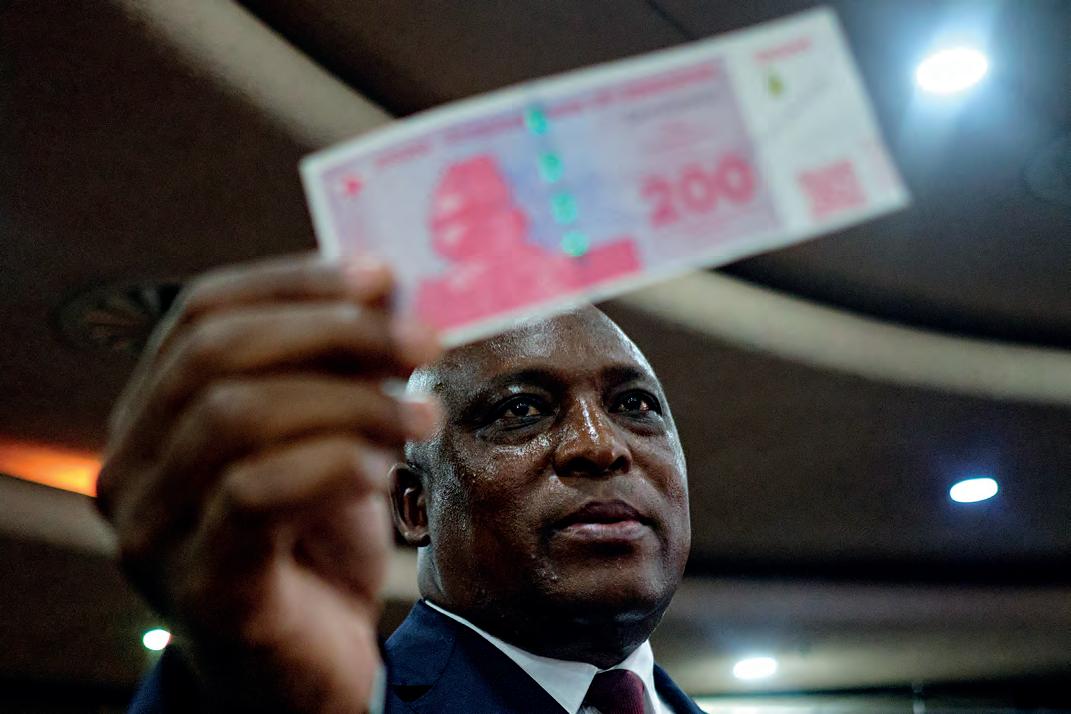
bury University’s Perdue School of Business.
iT HAS NoT beeN eASy For moST AFriCAN CouNTrieS To WeATHer THe STorm oF THe GlobAl reCeSSioN
It is not just multinationals that are feeling the pain. Institutional and individual investors in Africa’s capital markets, private equity firms and venture capitalists are also taking a beating. A case in point is South Africa. Johannesburg Stock Exchange data show that foreign investments outflows have amounted to $53bn over the past eight years. Last year, equities worth $8.3bn were dumped. In the Kenyan bourse, the exodus has been acute in recent times. The trend continued in the first quarter of this year with foreign investors selling $17m worth of stocks.
Repatriation of earnings is just one side of the problem for investors. Another that is more severe is substantial losses when weak domestic currencies are converted to hard currencies like dollars and pounds. “The exits and outflows showcase how powerfully foreign investors can react when their confidence is dented by a cratering currency,” states Jonathan Munemo, Economics professor at Salis-
A combination of factors has conspired to inflame the currency crisis. The basics are an idiosyncratic component related to structural imbalances and external pressure in the form of tight global funding conditions and geopolitical risks. On the global stage, the aggressive rate hiking by the US Fed since March 2022 aimed at tackling stubbornly high inflation stands out. Its effect has been the value of the dollar rising substantially and exerting pressure on Africa’s currencies.
Turning up the heat
Surging global food and energy prices triggered by the war in Ukraine have amplified inflation pressures. Countries with high debt loads are also being forced to spend squeezed revenues on repaying expensive loans, heaping more pressure on currencies already weakened by depleted foreign exchange reserves. Currently, about 40 percent of public debt in the continent is external with over 60 percent of it being in US dollars.
Cases of countries with worsening debt burdens enduring intense exchange rate depreciations are ripe. Kenya offers a perfect example. With a public debt standing at $82bn, persistent fiscal deficits and dwindling reserves, the shilling reflected market concerns of a potential sovereign debt default on
108 | Summer 2024
markets Africa

a $2bn Eurobond that matures in June 2024. Over the period between March 2022 and December 2023, the shilling weakened by 22 percent to the dollar. The freefall was more elevated at the beginning of this year. It was only arrested after the Kenyan government concluded a buyback operation of the maturing Eurobond.
“It has not been easy for most African countries to weather the storm of the global recession, monetary tightening and disruptions to global markets,” observes Christopher Adam, Professor of Development Economics at Oxford University.
While depreciations have battered the operations of foreign companies and investors, hysterical efforts by governments to stabilise domestic currencies have not made the situation any more bearable. Repatriation risks are most acute in countries relying on rigid forex regimes with currency convertibility issues also persisting in countries with flexible regimes. “Persistently high external financing needs tend to stand at the root of repatriation challenges,” explains Erasmus.
Across the continent, it has been a playbook of desperate measures to arrest the currency crisis. In Nigeria, the reform-minded administration of President Bola Ahmed Tinubu is implementing policies like unifying the multiple exchange rates and enabling
market forces to set the exchange rate. The administration also intends to raise $10bn to boost forex liquidity.
lar, building on a 14 percent surge in March, according to Goldman Sachs.
“Currency reforms will be welcomed by foreign investors and could spur capital inflows if they are successful in stabilising the exchange rate,” reckons Munemo.
A hard road ahead
A growing number of African countries are showing willingness to accommodate unpopular policies for long-term domestic currency stability. A few, like Ethiopia, are still clinging to a rigid forex regime. The net effect is subdued foreign interest in the government’s ambitious privatisation and sectoral liberalisation agenda. Despite its rigidity, the country is, however, dangling the carrot to ensure foreign direct investments keep flowing in. In September 2023 the National Bank of Ethiopia approved offshore accounts for strategic investors. Apart from making it easy for investors to manage their financial obligations, the directive also guarantees foreign currency convertibility for dividend repatriation and loan repayments.
“When restrictions are imposed in order to stabilise the exchange rates, private companies and individuals have the incentive to bypass official channels. This forms the basis of parallel or black markets in foreign exchange,” states Adam.
CurreNCy reFormS Will be WelComed by ForeiGN iNveSTorS ANd Could Spur CApiTAl iNFloWS
Crippled by a prolonged economic crisis, Egypt is finally acknowledging that the path to economic transformation requires painful adjustments. The country has agreed to adopt a flexible exchange rate regime in line with International Monetary Fund demands in order to access an $8bn bailout. Beside the bailout, the country has also since secured an investment deal worth $35bn from the United Arab Emirates and mobilised $7bn and $6bn from the European Union and the World Bank respectively. Apart from helping stem a suffocating forex shortage, the war chest has enabled the country to float its currency, easing pressure on the pound.
The effects of policy interventions to tackle structural imbalances cutting across liquidity constraints, market distortions and lack of transparency in the forex market are somewhat yielding fruits. The Naira, for instance, has since taken a drastic turn in fortunes. In April, it was the world’s best-performing currency after gaining 12 percent against the dol-
The parallel or black market continues to thrive in Africa. In some countries, it serves as the lifeline owing to the fact that it typically offers higher rates than the official exchange rate. Granted, the black market is a crucial component of the economy. Primarily, it offers a channel for individuals and businesses to access forex that may be scarce or overregulated in the official market. However, it also has damaging effects. For foreign investors who want to operate in stable, predictable and transparent environments, it can be a huge deterrent.
That deep entanglement with the dollar, and other hard currencies, has caused immense suffering for African countries, is indisputable. This explains why leaders in the continent led by Kenya’s William Ruto have been clamouring for de-dollarisation and development of homegrown local currency debt markets. The anti-dollar revolt is fuelled by popular consensus that advanced countries are often insensitive to how policies designed to provide stability in their own economies end up exporting currency instability to Africa. Additionally, if African countries borrowed more in their own currencies, they would escape the pains of exchange rate fluctuations spurred by rising global interest rates. The continent, however, understands that this is easier said than done. n
Summer 2024 | 109 markets Africa
Zimbabwe Reserve Bank Governor john mushayavanhu
Germany needs another miracle
The global recovery continues at a slow pace despite a surprisingly resilient response to the events of the past few years. In the G7, things look particularly bleak for Germany, whose dwindling growth figures show a country struggling to cope

 WORDS BY Scott Rouse FEaTuRES WRITER
WORDS BY Scott Rouse FEaTuRES WRITER






In what must now seem like Germany’s halcyon days of 2015, then chancellor, Angela Merkel told a press conference in Berlin “I am happy that Germany has become a country that many people abroad associate with hope.” It was a statement recognising Germany’s commitment to those seeking asylum and the additional $6.7bn needed to accommodate the system during the height of the migrant crisis.
How heavily those words must weigh on her successor, Olaf Scholz, and indeed, on his compatriot and President of the European Commission, Ursula von der Leyen, in 2024. While Germany may still hold the hopes of migrants in its hands as applications rose to 2015 levels last year, hope must be in short supply in its halls of power. For Germany as an economic power and figurehead of the EU finds itself somewhat beleaguered these days. Long have the Germans been the adults in the room, shouldering the responsibility not just for a nation but the EU too.
As Merkel herself said in the same speech, helping others “is something very valuable, especially in view of our history.” And it is perhaps towards history that Germany must now turn in order to find a path forwards out of its current slump.
By the end of the Second World War, Germany was, in essence, a ruined state with much of its population displaced and malnourished, its buildings destroyed and its economic infrastructure collapsed. It became known as Germany’s ‘Stunde Null’ or ‘Zero Hour,’ a blank slate as it were, a place from
which everything would have to be built anew. Its people seemed to be facing a bleak and uncertain future, but by the time the Berlin Wall fell in 1989, Germany had the third largest economy in the world, and still holds onto its top three position today. The country needed a miracle in order to recover and it got one.
According to Eichengreen and Ritschl in their LSE working paper Understanding West German Economic Growth in the 1950s, the country’s remarkable turnaround reflected its “convergence to the productivity frontier, a process during which investment and growth were higher than normal.”
The effect was so pronounced that the Germans coined a word for it: ‘Wirtschaftswunder’ or ‘economic miracle.’ In reality, regaining control over inflation, as well as efficient labour practices, was what helped to create the conditions needed for productivity. But productivity relies on industry and industry requires energy, in all its forms.
Energy independence
During a recent speech to the German Chambers of Industry and Commerce, Reuter’s reported Scholz saying “the German economy has faced unprecedented challenges over the past two years or so since Russia’s invasion of Ukraine.”
Germany’s over-reliance on relatively cheap Russian energy was just one of several major problems it has needed to address in recent years. Out of the G7 economies, Germany’s was the only one to shrink last year, with an aging workforce and underinvestment counted among the reasons why.
Germany’s economic advisors have cut growth projections for 2024 to 0.2 percent. In the last quarter of 2023, the economy shrank 0.5 percent. As the IMF reports: “with this
0.2%
Forecast growth in Germany’s GDP in 2024
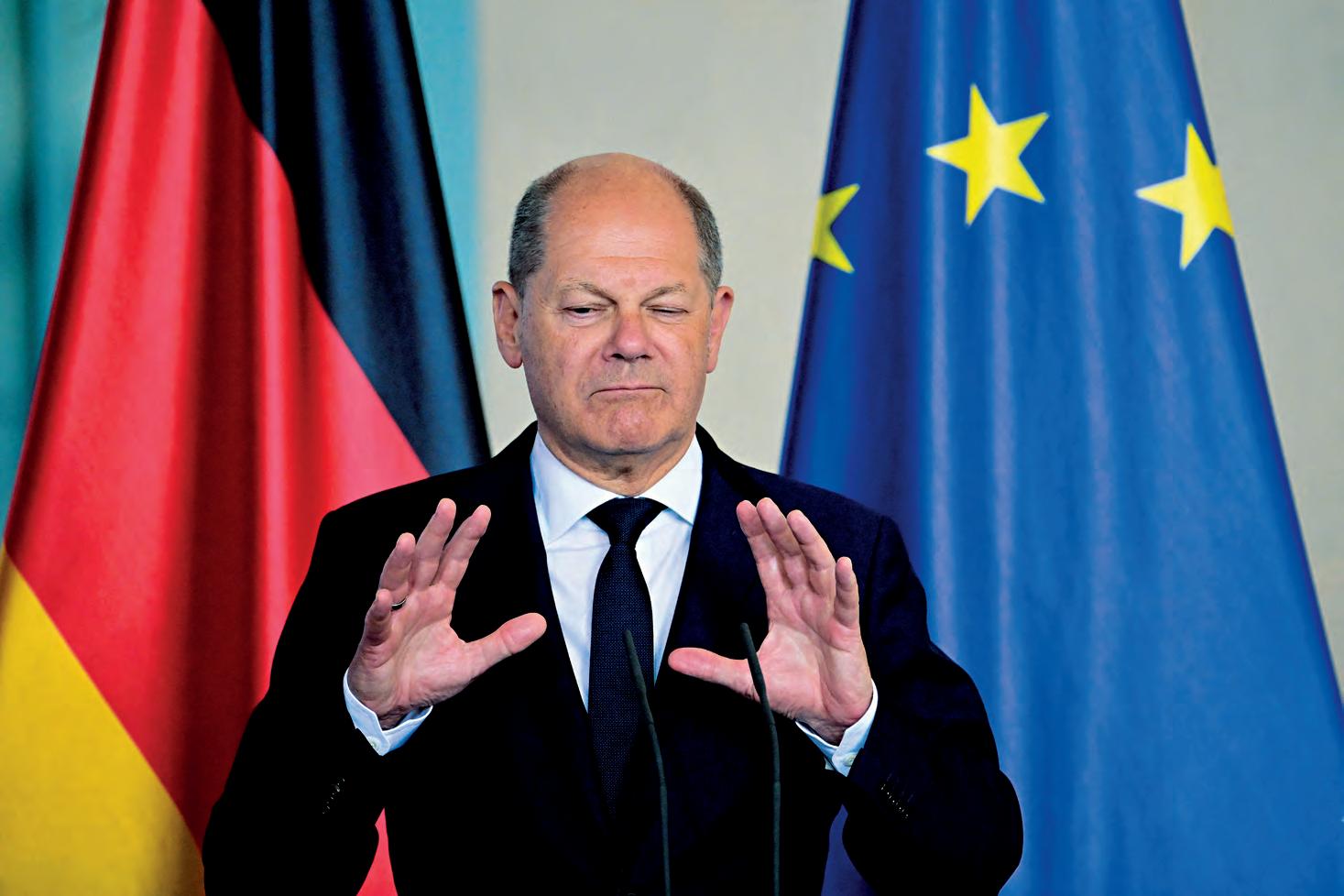
cheap gas no longer available, the German manufacturing model does not work anymore,” and as of last year, Germany’s manufacturing sector has slipped into recession.
A new deal was brokered with Qatar in 2022 for two million tons of liquefied natural gas (LNG) each year starting from 2026, but this alone is not enough to solve Germany’s energy crisis. Markus Krebber, the head of RWE, a German multinational energy company, said in a recent interview: “the root cause for our problems is that Germany did not invest enough money into the electricity supply system for many years.” In order to achieve this, investment and expansion in renewables must be a priority. Krebber goes on to say, “Germany, with its energy-intensive industries, should have started to take action in this regard 10 years ago or even earlier.”
GermANy did NoT
iNveST eNouGH moNey iNTo THe eleCTriCiTy Supply SySTem For mANy yeArS
From this perspective the way forward seems to be: invest in renewables, the lights stay on in the factories and everything else falls into place. But is it that simple? Unfortunately not.
110 | Summer 2024
markets Germany

to 2018 levels, so while energy will always be a factor in production costs and overall competitiveness, it is not the only factor.
A temporary issue such as higher inflation has caused consumers to hit pause on purchases and in order to counteract inflation, the ECB raised interest rates, which in turn caused depression in interest-sensitive areas
Making more market miracles
The German economic miracle following the end of the Second World War was achieved via the introduction of the ‘soziale Marktwirtschaft’ or ‘social market economy,’ which finely balances free-market capitalism with social policy. Germany’s remarkable recovery
we need workers from other countries.”
The chancellor is well aware that Germany needs more workers and more immigration: “Around 13 million citizens of Germany – affectionately referred to as the baby boomers – will soon be heading into retirement. That is why we need factory workers, engineers, doctors, care workers.”
In fact it is clear from his Der Spiegel interview that the chancellor recognises the maladies of Germany’s structural issues and how to treat them, but the world is a changed place, made evident by the rise in popularity of right-wing populist parties such as Germany’s AfD, who are in direct opposition to Scholz’s Social Democratic Party (SPD).
The task ahead of Scholz is not for the faint of heart and I believe that this has as much to do with addressing Germany’s temporary and structural issues as it does with handling the insecurities and anxieties of Europe’s citizens. Kicking off the EU election campaign in Hamburg in April, Scholz rallied behind the SPD with the mantra: “we need hope.” We sure do. n
Summer 2024 | 111
G7: Five year projected change in working age population growth rate pERcENTaGE poINTS Fig 1 SourCE: oECd and imf staff calculations Italy Canada US France Japan EU Uk Germany 0.0 -0.2 -0.4 -0.6 -0.8
German Chancellor Olaf Scholz
The world cannot afford to ignore the poorest countries
The International Development Association was founded on the belief that looking after the weakest economies is beneficial for all. The success stories of former borrowers prove that they were right, and IDA countries need global assistance now more than ever
WORDS BY
Ayhan Kose DEpuTY chIEF EcoNoMIST,






They are home to a quarter of humanity – 1.9 billion people. They possess prized natural resources, including one-fi fth of the world’s copper and gold reserves, as well as many of the rare metals essential for the transition to clean energy. Their working-age populations are set to expand for the next five decades amid demographic decline nearly everywhere else. Yet a historic reversal is underway among the world’s 75 countries eligible for grants and low-interest loans from the World Bank’s International Development Association (IDA).
For the first time this century, the income gap relative to the wealthiest economies is widening in roughly half of IDA countries. And while these countries are midway through what could be a lost decade, the rest of the world is largely averting its gaze. IDA countries have an extreme-poverty rate eight times higher than the global average. They account for 70 percent of all extreme poverty, and they are home to 90 percent of people facing hunger or malnutrition. Many of their national governments, meanwhile, are paralysed, and half are either in debt distress or at high risk of it.
The flow of foreign capital has largely dried up for IDA countries. In 2022, for the first time in 16 years, private creditors took more in principal repayments than they put in via loan disbursements to IDA governments and government-guaranteed entities. Financing from foreign governments dwindled to an 11year low. The remaining lifeline has been multilateral development banks, especially the World Bank, which provided more than half of the $26bn in loans that IDA governments received from multilateral creditors in 2022.
We are witnessing a dangerous retreat from the principles upon which much of the global economic architecture was built after the Second World War. Back then, the wealthi-
est economies wisely recognised their interest in improving the welfare of the weakest. The 17 donor countries that made their first financial contributions to the IDA in 1960 believed that an acceleration of “economic and social progress in the less-developed countries is desirable not only in the interests of those countries but also in the interests of the international community.”
The global prosperity that followed validated this insight. Three of today’s global economic powerhouses – China, India and South Korea – are former IDA borrowers whose growth has transformed them into important IDA donors.
The path to prosperity
Of course, the path to prosperity is rarely linear. Progress often occurs in fits and starts, with some countries advancing and then regressing. But there is no doubt that the IDA’s consistent support for the weakest economies has done immense good for the world. In all, 36 countries that were once IDA borrowers no longer depend on it, with a dozen ‘graduating’ in the last two decades alone.
Today’s IDA countries account for a mere three percent of global GDP. Yet their economic potential is considerable, owing to the demographic dividend inherent in their population growth. These countries will have deep reserves of young workers at least through 2070, long after working-age populations in other countries have dwindled.
growth nor stability unless they can make productive jobs readily available for young people entering the workforce, and that will require substantial investment in health and education. Moreover, lasting benefits from their natural-resource wealth will remain out of reach without government institutions capable of nimbler economic management.
Ensuring that IDA countries achieve their full potential will require a concerted effort involving vigorous domestic reforms and stronger financial and policy support from abroad. South Korea, India and China have shown that when countries undertake the ambitious reforms needed to accelerate investment, a kind of economic magic occurs: productivity surges, incomes rise, and poverty falls.
THe FloW oF ForeiGN CApiTAl HAS lArGely dried up For idA CouNTrieS
Investment needs in IDA countries are immense. In some, improving access to electricity and basic sanitation facilities will require infrastructure investments exceeding 10 percent of GDP. On average, each IDA country today has succeeded at least once over the past 50 years in achieving sustained investment acceleration. But that is only slightly more than half the average of earlier groups of IDA countries. To raise their game, today’s IDA countries will need to bolster fiscal and monetary frameworks, ramp up cross-border trade and financial flows, and improve the quality of institutions.
1.9 billion people live in IDa countries
70% of all extreme poverty is in IDa countries
IDA countries are endowed with a trove of mineral deposits that are crucial for the world’s transition to clean energy – including silicon in Bhutan and manganese in Ghana. Most IDA countries are also well placed to take advantage of solar energy, with long-term daily generating potential among the highest in the world. But IDA countries will enjoy neither durable
Global assistance will also be essential. IDA countries deserve financial support from abroad and fresh policy solutions to make the transition to clean energy. Already, climate change is making them pay a steep penalty for others’ sins. They also need an improved global debt-restructuring system. The current framework consigns them to an indefinite purgatory. And they need global help to tackle food insecurity, especially now that faraway international conflicts and trade disruptions have added to the problem.
In the coming decades, the world will need to summon every available reserve of economic potential to achieve universal peace and prosperity. It simply cannot afford to turn its back on a quarter of its people. n
112 Summer 2024
markets International Development
WoRLD baNK

















Search: Thalesgroup The people we all rely on to make the world go round, they rely on Thales©Getty imagesShutterstock thalesgroup.com




Global public debt has tripled since the mid-1970s and with many economies now in debt distress, there is a growing urgency not just to reduce it, but also for a sea change in our approach to its management, Selwyn parker reports »




114 | Summer 2024

Summer 2024 | 115
ne way of measuring global policy-makers’ concerns about the unprecedented increase in debt around the world is the number of times the subject is raised at highlevel conferences. And it comes up practically every week, most recently when Kristalina Georgieva, managing director of the International Monetary Fund, told the Atlantic Council in April about her fears that the current decade could be remembered as “the turbulent 20s.”
While prefacing her remarks with observations about some of the things to be thankful for, notably falling inflation, she got onto the urgencies; “The sobering reality is global economic activity is weak by historical standards. Prospects for growth have been slowing since the global financial crisis. Inflation is not fully defeated. Fiscal buffers have been depleted. And debt is up, posing a major challenge to public finances in many countries.”
Debt, the main subject of this article, is certainly up. The numbers ring alarm bells. In the so-called OECD area covering 38 member nations, gross borrowing jumped by exactly $2trn in 2023, from $12.1–$14.1trn. It will get worse; in 2024 the OECD predicts a further increase of $1.7trn. Although the US was the chief culprit, borrowing nearly two thirds of 2023’s $14.1trn, it clearly puts pressure on the global debt markets, whose capacity to issue debt is not infinite.
Overall, the markets are awash with debt. The total borrowings – technically ‘outstanding marketable debt’ – of the 38 governments is expected to hit $56trn in 2024. If that is a thought-provoking figure, consider that it will have increased by $16trn in just the last five years. Needless to say, that will be a record.
Perhaps more disturbing, the average debtto-GDP ratio is also off the scale. In real preinflation terms it is up from a pre-Covid 73 percent to about 83 percent in 2023. And it’s certain to rise higher by the time 2024 is out. In the meantime, the cost of new borrowing is rising, with interest rates approaching three percent of GDP.
More trillions
Emerging markets are taking a beating. In the so-called EMDEs (emerging market and developing economy) nations, in 2023 alone nearly an extra $1trn of sovereign bonds were issued, now up to $3.9trn. Although it can hardly be called an EMDE, China has a voracious and rapidly growing appetite for
this kind of debt. In 2021 its share of emerging nations’ bonds was 15 percent; now it is 37 percent. That is a number that is sowing alarm among many issuers inside and out of China.
Unsurprisingly, as EMDEs borrow more against less – because their economies are not growing fast enough – the credit ratings are deteriorating with a commensurate increase in the cost of debt. In the category of lowincome and lower-middle-income countries, which counts some 130 nations with average per capita GDP of $12,300, there were no less than 24 downgrades against six upgrades, reports the OECD.
The unhappy result is that outstanding sovereign debt has been pushed to unprecedented levels. Although these ratios look better when inflation and longer repayment times are taken into account, the debt still has to be repaid. For many nations it is a ticking time bomb.
It is not just the volume of debt that matters but also its composition. As the OECD explains in its annual review of global debt, the US, the world’s biggest economy, faces the prospect of renewing no less than a third of government debt during 2024. That is a small matter of $11.3trn. No doubt the US Treasury will handle the task but, as the Peter G. Peterson Foundation, an economic ginger group, points out, that is equivalent to nearly $103,000 for every single American.
$2trn
Jump iN GroSS borrowiNG iN 2023
~$1trn
VAluE of SoVErEiGN boNdS iSSuEd To EmdES NATioNS iN 2023
83%
America’s debt burden has been growing for years; “a mismatch between spending and revenues,” summarises the foundation, citing the cost of an ageing population, underfunded services and other long-term contributory reasons. At least the US can carry its debt. “In emerging markets decisions on debt composition become even more intricate,” notes the OECD. This is because they have to navigate growing volatility, or what the Paris-based body describes as “exposure to fluctuations in global risk sentiment in an increasingly shock-prone world.”
aVERaGE DEBt-tO-GDP rATio iN ThE oECd NATioNS iN 2023
Another policy-maker to voice her concerns – frequently, in fact – is Indian-American economist Gita Gopinath, the IMF’s deputy managing director. In late 2023 at a conference in Washington entitled ‘Fiscal Policy in an Era of High Debt’, Gopinath cited

116 | Summer 2024 t hE GRE at Debt Dash

alarming figures about the long-run – and accelerating – growth in public debt levels. “Since the mid-1970s, global public debt has tripled to reach 92 percent of GDP by the end of 2022. So, debt levels had been rising for some time.”
Albeit in sober economic terms Gopinath painted a bleak picture, especially for economically weaker nations; “Rising deficits and debts in countries such as the US have serious ramifications for emerging and developing economies, who are hit by rising rates and weaker currencies. And many economies, particularly lowincome countries, are already in debt distress.”
velopment magazine, he goes on to call for a “long-term balance between what people earn and what they spend.” Until then though, we have what he calls “a massive debt supercycle that threatens the global economy. Breaking that cycle is one of the most pressing challenges of the 21st century.”
in 20 years britain’s non-banks have snapped up roughly half of all UK’s financial assets
“The combination of record-high global debt levels, higher for longer interest rates, and weak growth prospects poses a triple challenge for policymakers. In a shock-prone world, very few countries will have the fiscal space to support their economies,” Gopinath continued.
Fracturing fiscal rules
So there is a mounting problem. One of the many complexities of reducing global debt is that the old, more comfortable rules have been broken for several reasons. One is the 2008 global financial crisis (GFC) that overnight brought unprecedented levels of quantitative easing – central banks printing money and lending it at rock-bottom rates to the financial sector to prop them up.
Another is that while most nations have their own fiscal rules, they find it increasingly hard to stick to them and resort to issuing more debt to keep the economy moving. “Deviations from the rules are frequent,” regrets the OECD. “Few have contained debt since the GFC.”
The OECD’s solution is more discipline buttressed by a kind of fiscal police. “We need rules that respond to shocks but with clear mechanisms to correct for non-compliance and that are anchored on spending targets,” it suggests. “Independent fiscal councils can also enhance checks and balances.”
Meanwhile others see the need for a new kind of economics. “Dependence on credit to boost demand imperils the world economy, so we must correct the underlying imbalances,” warns Atif Mian, professor of economics, public policy and finance at Princeton University. In an article in the prestigious Finance & De-
Before that can happen though, habits have to change. Led by largely thriving economies such as the US, government (or sovereign) borrowing has become almost obligatory. And when governments such as Britain sought to reduce its debt in the wake of the GFC, it was widely lambasted for ‘austerity economics’ by citizens who expected continuing largesse from a nation that could ill afford it. France repeatedly runs into the same problems – in fact riotous protests – when the Macron government attempts to follow other nations and slowly increase the age for pension payments, which are steadily undermining the entire economy.
Debt build-up
Debt sprees have been on the rise for well over half a century, starting around the time that the miseries of the great depression began to fade. For example, in the US total debt stood at about 140 percent of GDP between 1960 and 1980, but has since more than doubled to 300 percent of GDP (see Fig 1). And the world has learned from the American example.
As Professor Mian explains; “Not even the great recession of 2008 [the result of the GFC], which in many ways was a result of the excesses of borrowing, could put a dent in debt’s relentless upward march. It would be a mistake to think that 2008 reflected merely some unfortunate policy misstep. The build-up in debt that led to the 2008 crisis stemmed from deep structural imbalances in the economy. Those imbalances persist, as do the dangers associated with them.”
But where does all this debt and dangerous imbalance come from? Most researchers agree that, paradoxically, it derives from a glut of savings by rich people and rich countries. There is no doubt that the rich are getting richer, as in fact they generally have in historical terms. The top one percent of individuals have been accumulating more and more wealth for more than 40 years, many of
Summer 2024 | 117 t hE GRE at Debt Dash
»
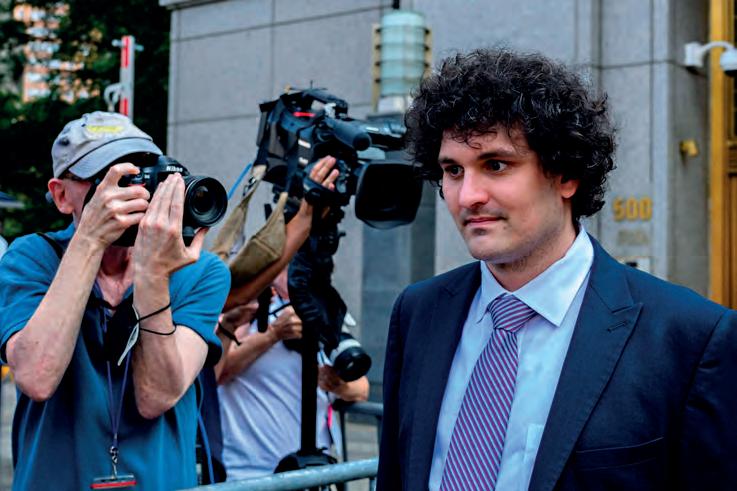
so have certain countries got richer, notably China, whose rising prosperity ends up in do mestic banks and other savings institutions much more than in wealthy western coun tries. Between them, they claim a disproportionately greater share of global income, which in turn creates financial surpluses that fuel the ‘global debt supercycle.’
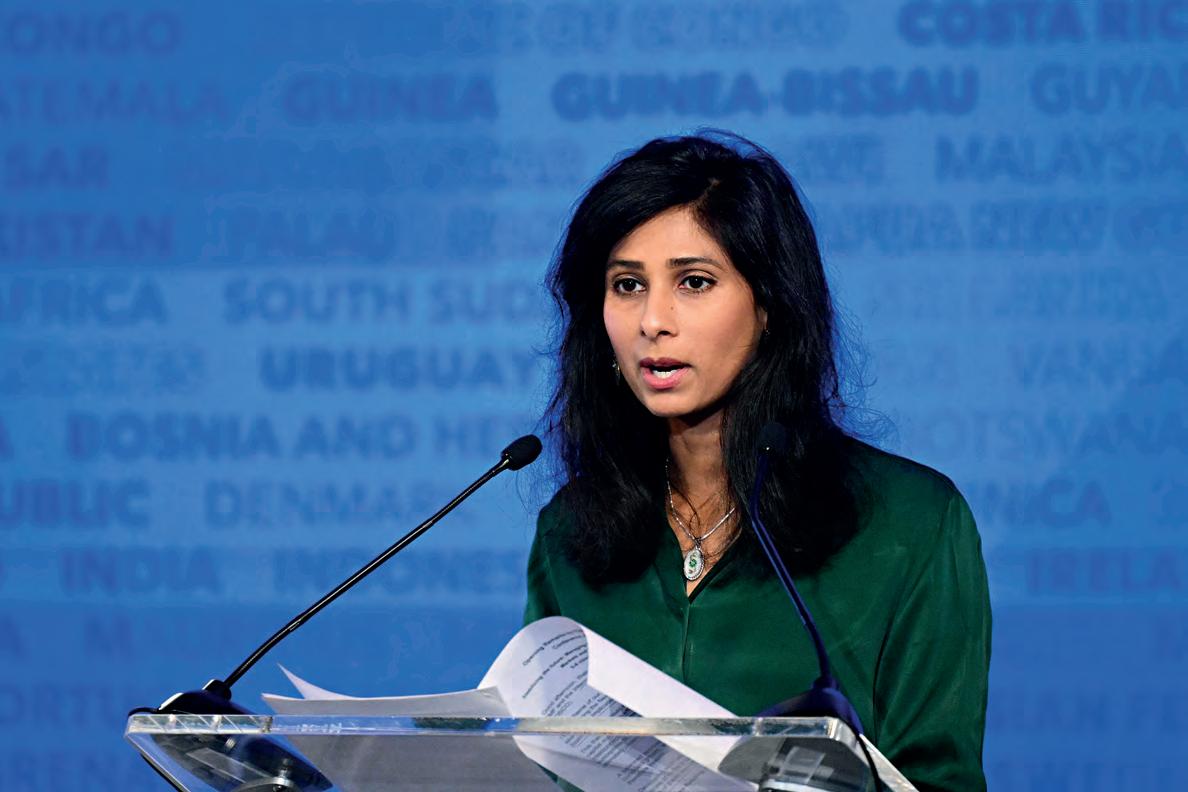
Unfortunately, much of this avalanche of debt is ending up in the wrong place because the financial sector – the man in the middle – has been missing its targets. Professor Mian continues; “A well-functioning financial sector would channel the financial surpluses toward productive investments, such as building and maintaining infrastructure and developing technology. Any debt resulting from such productive lending would naturally be sustainable, because returns from investment would pay it off.”
Mian adds; “Unfortunately, a key feature of the debt supercycle is its failure to finance productive investment. For example, even though total debt as a share of GDP has more than doubled, real investment as a share of GDP has remained stagnant, or even fallen over the past four decades.” The alarming conclusion is that around half of the trillions of new debt issued during the past two years is being wasted. Instead of financing investment, which would help create wealth, it has gone to the debt unproductive consumption by households and governments.
Naturally, collapsing interest rates only feed this cycle. Those with long memories will know that in the early 1980s, the US 10-year real interest rate hovered around seven percent. More recently, it’s plummeted as low as below zero. As these rates flow into consumer finance, it prompts ordinary people to spend rather than save.
central banks have had to manage upheavals in the rapidly growing non-bank financial sector that could easily have spread more widely with dire consequences. Only adroit and largely anonymous crisis management avoided the worst.
“These [non-bank] institutions have grown in significance across a range of markets, including those that households, businesses and governments use to borrow, save or access financial services,” explains the Bank of England’s Nick Butt, head of the future balance sheet unit, in a recent speech. Pretty much from a standing start, in 20 years Britain’s non-banks have snapped up roughly half of all UK’s financial assets including corporate lending. Other European countries have seen the same developments in what amounts to yet another threat to financial stability.
Why? Because non-banks in Britain, but also elsewhere, are big holders of gilts (sov-
Fig 1 uS national debt at $31.5trn
a key feature of the debt supercycle is its failure to finance productive investment
ings are little known outside financial circles, this is where the Bank of England buys and sells giltedged securities. Established in 1996, it is a huge market where billions are transacted every day for the purposes of keeping the banking system liquid. Echoing what other central banks are saying, Butt notes; “The implications of the rise of the non-banks are far from theoretical and have given rise to new vulnerabilities and sources of liquidity risk that have all too real a potential to cause financial instability and impact the broader economy.”
Some might say more actual than potential. In March 2020 the state of the UK government’s bond markets deteriorated rapidly in a general rush for short-dated, cash-like instruments in the middle of the Covid lockdowns. There was a dash for cash right through the financial sector as banks of all types sought to meet their own liquidity obligations. The big dealer banks pumped in around £50bn through the gilt market to help out the central bank but, in a demonstration of the nervousness lurking beneath a highly indebted market, it was barely enough.
The money markets held their breath but got through it. Another crisis in Britain two years later in the immediate aftermath of short-lived prime minister Liz Truss’ shock ‘go-for-growth’ economic policy hit the longdated gilt market in particular, once again exposing what Butt called “vulnerabilities in
118 | Summer 2024 t hE GRE at Debt Dash
Gross federal public debt in the uS (in $ trillion) n Recession SouRcES: Statista, Fed of St. Louis, Department of the Treasury 31.5 35 30 25 20 15 10 5 0 1966 1970 1980 1990 2000 2010 2020 2023
Former FTX chief Sam Bankman-Fried
»
imF First deputy managing director Gita Gopinath

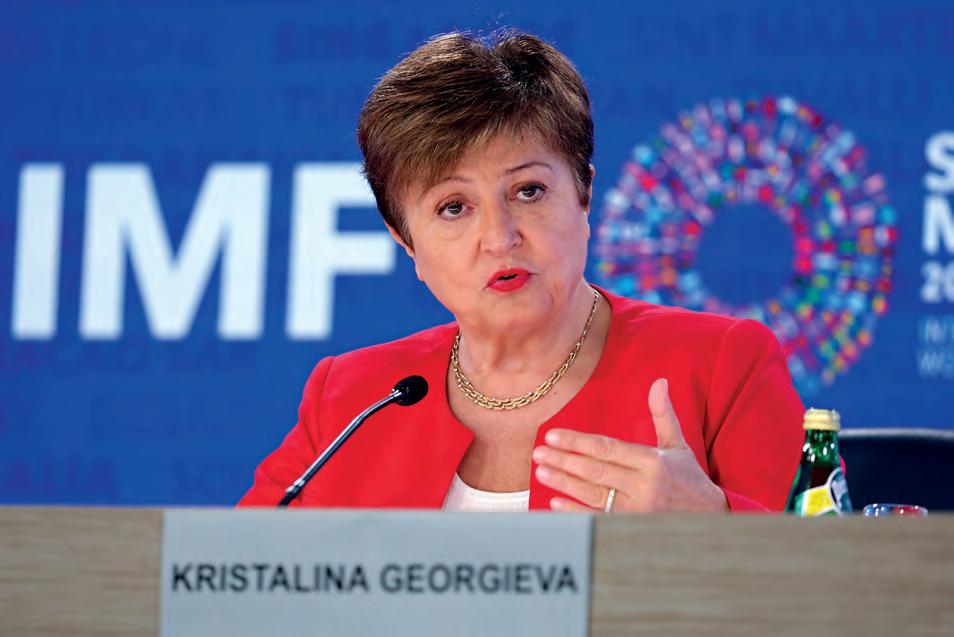
their own creditors hear the alarm bells. Right now, central banks and global regulators are working hard on plugging these holes before they get too big. As recently as 20 years ago, life was easier for the likes of the Bank of England, the US Federal Reserve and other major institutions when they had only to worry about the big retail and investment banks. And when global debt levels were not so high.
Better big banks
On the bright side, most of the world’s big, systemic banks are safer than they were before the GFC. Following the lending excesses exposed by that crisis, they hold more capital – the funds that stand first in line to bear losses – and are in a better position to protect depositors. Most countries have enforced these regulations developed by the Bank for International Settlements, albeit with local variations, and global regulators are breathing much more easily about the giants of the financial sector.
Reforms are continuing, currently through what is known as Basel 3.1. As Bank of England governor Andrew Bailey explains, “the key thing here is that across jurisdictions it is implemented faithfully, neither more nor less.” This doesn’t necessarily mean in a highly illiquid world that the threat of bank failures has been extinguished. In early 2023 alone the US, supposedly the bastion of regulation, saw three failures – Silicon Valley Bank, Signature Bank and First Republic – while Switzerland’s once-mighty Credit Suisse had to be rescued before it collapsed. Following a mire of shoddy regulation and inept management, the Swiss government arranged for rival UBS to buy the
’s not just the volume of debt that matters composition
So what now?
The tight-rope act requires that global debt be steadily reduced and that it is invested much more wisely – that is, in the corners of the economy that will create the right kind of growth. Most economists continue to favour GDP, albeit a more enlightened and nuanced version that focuses on what is good for people and the planet. Good growth, in short. Some, however, argue that growth – and especially the debt-funded version – has passed its time. The ‘de-growth lobby,’ whose figurehead is Greta Thunberg, argues that modern capitalism has got it wrong by focusing on GDP and that living standards are already good enough.
failed institution for $3.25bn, a transaction
There are concerns that social media will contribute to the risk of bank failures through a much-feared run. “The sudden withdrawal of bank deposits – accelerated by digital technology – contributed to the failures of these banks,” notes a thought-provoking study by leading European bankers, citing the speed at which news travels, even if it is wrong. This was not the case even during the disastrous bank runs leading up to the GFC when, the study argues, “social media and mobile banking apps were unheard of or barely existed.”
As they conclude; “As events in 2023 illustrate, the risk of sudden bank runs may generally be affected by advancing digital frontiers in banking.” In short, something else for regulators to worry about.
Crypto craziness
They were certainly worried by the lemminglike race for alternative currencies that was symbolised by the collapse in November 2022 of Sam Bankman-Fried’s cryptocurrency exchange FTX and its affiliated hedge fund, Alameda Research. The exchange folded in days after clients learned that Alameda’s losing bets were being covered by the customers of FTX, unbeknownst to themselves.
In a salutary lesson for proponents of ‘metaverse’ currencies, Bankman-Fried has been sentenced to 25 years in prison and ordered to repay over $11bn. Long before FTX went under, central bankers had been warning against plunging into this wild and unregulated market. However the subsequent flight from crypto currencies does not spell their end. Central bankers see a lot of sense in alternative forms of payment and many are developing them. But they will be run under strict controls and regulations.
Few outside academic circles buy that argument because ‘good growth’ improves lives. However, as the IMF’s latest World Happiness Report, the 10th iteration of this enlightening study, shows, economic growth isn’t everything. In fact, some of the poorer nations are the happiest.
“When we juxtapose GDP per capita with happiness scores from the report, it becomes clear that while GDP per capita is a significant predictor of happiness, it is not the only factor. As the report outlines, other variables, such as social support, life expectancy, freedom, generosity, and the absence of corruption, also help explain varying levels of happiness between countries,” said the IMF report.
In short, behaviour as well as GDP. This is why Costa Rica, famous for its economic concept of la pura vida, which seeks to take everybody’s wellbeing into account, ranks a high 6.61 on the Happiness Index with a GDP per capita of just $20,000 while extremely prosperous Singapore ranks just below. Strikingly, poor nations like Kosovo (6.37 at $11,690), Nicaragua (6.26 at $5,842) and Guatemala (6.15 at $8,262) rank just below Singapore. However it is unlikely that lowest-ranked Afghanistan (1.86) and Lebanon (2.39) would line up behind the de-growth champions.
The IMF’s Gopinath, a strategic thinker, sounds a warning to high-borrowing, spendthrift nations. “In today’s environment –where it is politically difficult to cut spending or raise taxes – debt-financed spending may still seem tempting. But that would be a grave mistake, setting debt on an unsustainable trajectory as borrowing costs rise sharply. Governments need to rethink what they can and cannot do. They cannot be the insurer of first resort for all shocks. Revenues also need to keep up with spending,” Gopinath said.
Overall it appears to come down to living within your means. n
Summer 2024 | 119 t hE GRE at Debt Dash
imF managing director kristalina Georgieva

Unprecedented rain in Dubai raises questions
The recent floods in Dubai exposed its lack of preparedness when it comes to extreme weather events. As climate change takes hold, investors must pay close attention to the associated risks
WORDS BY Maryam Shahvaiz
FEaTuRES WRITER
loss and damage. The bank has instructed all financial institutions to offer a six-month repayment deferment to customers with personal and car loans affected by flooding. It has assured that customers will not be bound to pay any additional amount, interest, or profit charges. Moreover, the principal amount of the loan will also not be increased.
Insurance companies in the UAE were not prepared to manage such claims, and have taken time to settle them, with claims made by customers against loss and damages backed by UAE Central Bank, which is a sigh of relief for many investors. However, it will be quite challenging for consumers to file a claim, especially regarding negligence, even if they have comprehensive coverage. For instance, if you have knowingly parked a car or a vehicle in a flooded area or if you were driving in a rain-affected area. Rejection of these kinds of claims could put a dent in investor confidence.



On April 16, Dubai experienced its heaviest rainfall in 75 years, disrupting lives across the city. While the city is typically associated with a dry climate and scorching heat, residents found themselves unexpectedly rushing for umbrellas to protect themselves against heavy rainfall. It hardly rains in Dubai, which is why the drainage system was not included in city planning. As a result, a significant portion of the water remained stagnant due to urbanisation and inadequate drainage infrastructure, exacerbating flooding in many areas. Blocked roads made it difficult for people to resume their daily activities, with grocery stores unable to restock and several employees having trouble reaching their workplaces.
The storm in Dubai not only caused inconvenience for its residents but has also jolted investors and businesses across the UAE. Dubai is heavily dependent on its tourism industry and all businesses flourish under this industry. Being UAE’s financial hub, Dubai has the busiest airports in the world. Due to the heavy storm, approximately 1,000 flights were cancelled, leading to days of subsequent delays. Motorways remained submerged until the rain stopped. Around 21 people sadly died across the UAE and Oman.
These circumstances do not present a favourable picture to the investors. They had not predicted that natural disasters such as rain would have such an impact and must now be factoring it into their future investment decisions. At present, their main concern will be whether it is a one-time thing or something set to continue.
Meanwhile, scientists and researchers are divided about this sudden rainfall. Some are blaming seeding, whereas many think it is due to global warming. According to Richard Washington, a professor at Oxford University, it is technically quite difficult to blame seeding alone for this storm. As per World Weather Attribution, “heavy precipitation hitting vulnerable communities in the UAE” is set to become “an increasing threat as the climate warms.” If this sort of event is now the norm, it will raise concern for Dubai’s investors. Additionally, it will pose challenges for Western investors, for whom one of the key attractions of residing and investing in Dubai is its weather.
Government response amid crisis
A positive sign for the investors is that the Government of Dubai has assured its residents that it will provide damages for the loss suffered and the UAE has allocated $544m for repairs caused by the storm. The UAE Central Bank, on the other hand, has confirmed that insurance claims will be provided for damaged homes and vehicles if the party holds a comprehensive insurance policy against
1,000
Flights cancelled at Dubai airport
Dubai knows that it cannot afford to lose its reputation as both an attractive travel destination and ‘safe haven’ for investors to mere rain. Therefore, it has deployed thousands of workers to bring back normalcy. Other than banks and financial institutions, many developers in Dubai are also facilitating the repair of residential property damage. As per Khaleej Times, the CEO of Damac Properties, which is the largest property developer in Dubai, has also come forward to provide assurance to its residents that they will repair all their property damages at no cost. But the real question for investors is perhaps not about repairs, but about an upgrade to the city’s drainage system.
$544m allocated by the uaE for repairs
Dubai’s investors will certainly have this playing on their minds while looking for business opportunities. Investors will be looking to see how the Dubai government intends to support them in the case of flooding or other extreme weather events. They will carefully assess and scrutinise how insurance companies will facilitate them, what is covered and what is not. Considering current predictions, the likelihood of more severe rainfall events in the future remains high. Therefore, the government of Dubai must prioritise providing assurance to its potential investors by taking proactive measures to address the city’s inadequate drainage infrastructure and improving insurance policies. By tackling these challenges, Dubai can mitigate these risks and maintain its attractiveness as a destination for investors and residents alike. n
120 | Summer 2024
analysis Dubai
Cars abandoned on a flooded road in Dubai


















WorlD finance 2024 aWarDs


For the 18th consecutive year the World Finance awards continue to honour excellence in a multitude of different industries
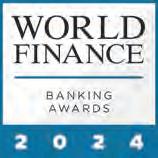
According to Deloitte’s banking outlook for this year, as banks “contend with multiple fundamental challenges to their business models” they will have to “demonstrate conviction and agility to thrive.” There are several factors affecting banks including a divergent economic landscape amid a slowing global economy, higher interest rates, climate change and geopolitical shifts, not to mention the continued march of new technology – genaI, embedded finance, open data and digital money have the power to significantly change the banking landscape. The WorldFinanceBanking Awards 2024 recognise those who are meeting these challenges head on while doing the very best for the clients they serve.
moST SuSTAiNAble bANkS
couNTRY baNK
brazil Itau unibanco
Dominican Republic banco popular Dominicano
Germany KfW
Netherlands Triodos bank
Nigeria access bank
Saudi arabia Standard chartered
Singapore DbS bank
Spain banco bilbao Vizcaya argentaria
Sri Lanka commercial bank of ceylon
Sweden Nordea
Turkey Kalkinma Yatirim bankasi
uaE First abu Dhabi bank
beST iNveSTmeNT bANkS
couNTRY baNK argentina puente
brazil bTG pactual
chile
bTG pactual colombia bTG pactual
Dominican Republic banreservas
France bNp paribas
Georgia Tbc bank
Germany
hong Kong
Deutsche bank
Jefferies
Jordan arab bank
Kazakhstan Tengri partners Investment banking
Kuwait National Investments company
Mexico bbVa Mexico
Netherlands abN aMRo
Nigeria coronation Merchant bank
oman bank Muscat
pakistan hbL
paraguay puente
peru credicorp capital
Taiwan Fubon Financial
Thailand Siam commercial bank
Turkey QNb Finansinvest uS Jp Morgan chase
moST iNNovATive bANkS
REGIoN baNK
africa GT bank
Middle East
Emirates NDb
Europe bNp paribas
asia pT bank Mandiri
Latin america banco popular Dominicano
beST bANkiNG GroupS
couNTRY
baNK austria baWaG Group brunei baiduri bank
chile banco Internacional
china Icbc
Denmark Nordea
Dominican Republic banco popular Dominicano
Egypt banque Misr
Finland Nordea
France crédit Mutuel
Germany commerzbank
Ghana zenith bank Ghana
hong Kong hSbc
India bank of baroda
Jordan Jordan Islamic bank
Kosovo bKT
Macau Icbc (Macau)
Malaysia hong Leong bank
Nigeria Guaranty Trust bank
pakistan Meezan bank
Saudi arabia al-Rahji bank
Turkey akbank
uaE
Emirates NbD uK Lloyds banking Group
bANkerS oF THe yeAr
REGIoN baNKER
africa Segun agbaje (GT bank)
Middle East ahmed abdelaal (Mashreq)
Europe christian Sewing (Deutsche bank)
asia Darmawan Djunaidi (pT bank Mandiri)
Latin america christopher paniagua (banco popular Dominicano)
122 | Summer 2024
analysis Awards 2024




beST privATe bANkS
couNTRY baNK
argentina puente
austria Erste bank Group
belgium bNp paribas Fortis
brazil bTG pactual
bulgaria postbank
canada bMo
chile
bTG pactual
colombia bTG pactual
czech Republic cSob private banking
Denmark Nordea private banking
Dominican Republic banreservas
France bNp paribas banque privée
Germany Deutsche bank
Greece Eurobank
hungary oTp private banking
India Kotak Mahindra bank
Italy bNL bNp paribas
Liechtenstein Kaiser partner
Luxembourg Quintet private bank
Monaco banque Richelieu
Netherlands ING
Nigeria First bank
Norway Nordea private banking paraguay puente poland mbank
portugal Santander private banking
Romania banca comerciala Romana
Slovakia Tatra banka
Spain Santander private banking
Sweden carnegie private banking
Switzerland bNp paribas Wealth Management
Turkey TEb private banking
uaE Mashreq
uK hSbc Global private bank and Wealth
uruguay puente
uS bMo
beST reTAil bANkS
couNTRY baNK
austria Erste bank Group azerbaijan accessbank
belarus belarusbank
belgium bNp paribas Fortis
bulgaria postbank canada bMo
chile
Santander chile
colombia bancolombia
costa Rica bac credomatic
Denmark Nordea
Dominican Republic banreservas
Finland Nordea
France bNp paribas
Germany commerzbank
Greece Eurobank
hungary oTp bank
Iceland Landsbankinn
India IcIcI bank
Italy bNL bNp paribas
Macau bank of china
Mexico banorte
Netherlands ING
Nigeria GTbank
Norway Nordea pakistan Meezan bank
peru bcp poland mbank
portugal Santander
South africa Nedbank
Spain banco bilbao Vizcaya argentaria
Sri Lanka Sampath bank
Sweden Nordea
Turkey Garanti bbVa
uaE Mashreq
uK Lloyds bank
uS bank of america

beST CommerCiAl bANkS
couNTRY
baNK
Austria raiffeisen Bank International azerbaijan accessbank belarus belagroprombank belgium bNp paribas Fortis bulgaria postbank canada bMo colombia Davivienda czech Republic cSob
Denmark Nordea Dominican Republic banreservas
France bNp paribas
Germany Deutsche bank hungary oTp bank
Iceland Landsbankinn
Indonesia ocbc NISp
Italy
bNL bNp paribas Macau bank of china
Malaysia hong Leong bank
Netherlands ING
Nigeria zenith bank
Norway Nordea pakistan hbL poland mbank portugal banco Finantia
Saudi arabia al-Rahji bank
Singapore Standard chartered
Spain banco Santander
Sri Lanka Sampath bank
Sweden SEb
Taiwan Mega International commercial bank
Thailand Kasikorn bank
Turkey Garanti bbVa
uaE
Emirates NbD
uK barclays
uS bMo
Vietnam
Gon J.S. commercial bank
Summer 2024 123
analysis Awards 2024
Sai
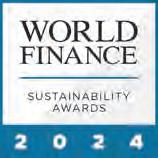
Sustainability has gradually become more prevalent at a company level, driven by the long-term trends of deglobalisation, decarbonisation and demographic change.
Marina Severinovsky, Schroder’s head of Sustainability, North america, believes that “all of these issues now have critical business consequences, and addressing them is essential for economies across the globe and for individual companies.” Investors remain interested in sustainable investment options but real change relies on capital reallocation at scale. The winners of the WorldFinanceSustainability Awards 2024 are those who have not only made this commitment, but are taking action and providing solutions.
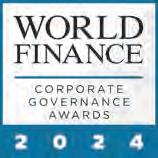
There are fresh challenges to contend with every year for boards and businesses. a continued talking point has been the advent of aI, quantum computing and other technologies, all of which provide as many threats as they do opportunities. The realised need for an ethical approach to aI with the introduction of the Digital Services act and other regulatory measures necessitates a change in the way businesses operate. along with this, there has been a push towards greater diversity and gender parity in the boardroom as well as conversations around organisations taking more concrete action on ESG, a term that has become politicised and weaponised in recent years. The World FinanceCorporate Governance Awards 2024 celebrates those who are facing these issues head on and showing true leadership in their respective fields.
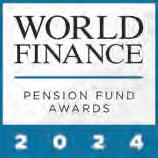
a recent article by Martin Sanders, head of pension Investments at axa, highlighted three key points: subdued global economic growth in 2024, “with some pick-up in 2025,” a continued rise in the demand for sustainable investments, and the observation that “fixed income has become increasingly attractive for pension funds” due to multiyear highs in bond yields. The expectation going forward is that inflation will remain elevated but should slow by 2025, with most developed markets avoiding recession. Meanwhile, pension funds will continue to add “more resources to sustainable and impact investments in all asset classes, most likely equity and bonds.” another potential agitator in the global economy is the uS presidential Election in November. This, along with the challenges that Sanders highlights are what the winners of the WorldFinancepension Fund awards have so expertly navigated over the past year, combining risk, portfolio and investment strategy management, as well as performance evaluation.
moST SuSTAiNAble CompANieS
INDuSTRY coMpaNY
agTech beewise Technologies
airport aeroporti di Roma
asset Management Kbc asset Management
automotive products Supplier REvolve
battery Storage aceleron Energy
building Technology carbicrete
Carbon Offset
DevvStream
clean Energy avangrid
Coffee Processing Nestlé Nespresso
Data centres QTS Realty Trust
Financial Services Dubai International Financial centre
Flag carrier airline
Turkish airlines
Food products Supplier Riverside Natural Foods
Freight Forwarding c h. Robinson
beST CorporATe GoverNANCe
couNTRY
coMpaNY algeria cevital angola banco angolano de Investimentos brazil cpFL Energia colombia Grupo Nutresa
Denmark Maersk
Dominican Republic banreservas
Egypt Elsewedy Electric
Finland Valmet
France TotalEnergies
Germany adidas
Ghana
MTN Ghana
Greece Fourlis Group hungary MoL
India Vedanta Limited
Indonesia Star Energy Geothermal
Italy Enel Spa
Jordan Jordan Islamic bank
beST peNSioN FuNdS
couNTRY
coMpaNY australia unisuper
austria VbV Group
azerbaijan State Social protection Fund of azerbaijan belgium united pensions
bolivia bISa Seguros y Reaseguros brazil bradesco Seguros canada oMERS
caribbean Ncb Insurance
chile aFp plan Vital colombia Grupo Sura croatia pbz croatia osiguranje
czech Republic cSob
Denmark Nordea pension
Estonia Swedbank
Finland ELo
France ERaFp
Germany bosch pensionsfonds
Ghana pensions alliance Trust
Greece
Glass ba Glass
Gravity Energy Storage Gravitricity
healthcare Royal philips
Impact Investment campo capital
Logistic Technology arrive Logistics
Low-cost airline Wizz air
Office Furniture MillerKnoll
packaging Elopak
pulp and paper Suzano
Semiconductor onsemi
Spirits Lunazul Tequila
Telecommunication Swisscom
Transportation cpKc
Water Technology hydraloop
Wine Making Domaine bousquet
Wine products corticiera amorim
Kuwait zain Group
Malaysia Maybank
Mexico banorte
Myanmar Ma x Myanmar Group
Netherlands aSML holding
Nigeria zenith bank
Norway Telenor Group
poland cD projekt
Qatar ooredoo
Romania banca Transilvania
Saudi arabia zakat Tax and customs authority
Singapore uob
South africa Discovery Limited
Spain Santander
Thailand berli Jucker
Turkey SocaR Turkiye
uaE Mashreq bank
uS chesapeake utilities corporation
Vietnam Vingroup
Indonesia bNI
Ireland Irish Life EMpoWER Master Trust
Italy bNL bNp paribas pension Fund
Jamaica JMMb Fund Managers
Macedonia
Sava penzisko
Malaysia Gibraltar bSN
Mexico afore xxI banorte
Mozambique Moçambique previdente
Netherlands Rabobank pensioenfonds
Nigeria Fidelity pension Managers
Norway KLp peru prima aFp
poland oFE pzu
portugal Fp banco Santander Totta
Serbia Dunav Voluntary pension Fund
South africa GEpF
Spain GM pensiones
Sweden
piraeus asset Management
Iceland Frjalsi pension Fund
Swedish Fund Selection agency
Switzerland pensionskasse Manor
Thailand Kasikorn asset Management
Turkey TEb asset Management
uS NYc board of Education pension Fund
124 | Summer 2024
analysis Awards 2024

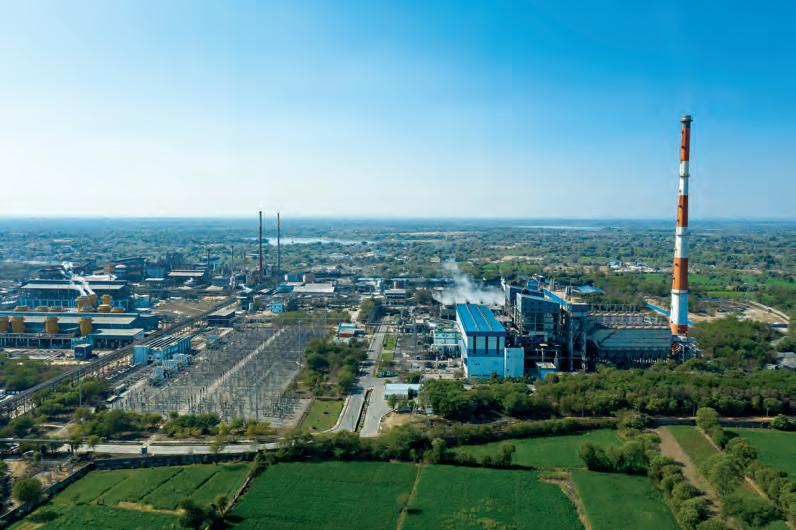
India’s economic ascendancy
India is a country on the rise. By facilitating nation building through sustainable and inclusive growth, the natural resources sector holds the key to unlocking India’s potential
WORDS BY
Priya Agarwal Hebbar chaIRpERSoN, hINDuSTaN zINc & NoN-ExEcuTIVE DIREcToR, VEDaNTa







The world is undergoing an unparalleled evolution, unlike any witnessed in human history. Never before have we witnessed such remarkable advancements in manufacturing, renewable energy, infrastructure development and artificial intelligence, among others. What sets this apart is not just the magnitude of dynamic progress, but also the global distribution of its impacts. This needs action that is both purposeful and that facilitates nation building. With this shift comes the necessity for businesses to accelerate their approach to sustainable, inclusive, and enduring growth for all stakeholders. The United Nations defines sustainable development as development which meets the needs of the present without compromising the ability of future generations to meet the same. By ensuring sustainable and inclusive growth, India aims to leapfrog to a developed economy.
Indian corporates must actively seek to ingrain sustainability and inclusive growth principles in their organisational culture. It is also equally crucial that businesses establish partnerships with entities that share similar dedication and enthusiasm for generating a positive impact on society. Further, instilling an innovation-centric mindset capable of going beyond conventional boundaries and
devising ingenious approaches to accomplish overarching goals is paramount for a country like India. While each industry contributes in its own way, the natural resources sector which provides essential raw materials for various industries and holds a significant potential for sustainable development would play a critical role. From minerals used in renewable energy to metals essential for modern infrastructure, the natural resources sector underpins the foundation of sustainable and inclusive growth.
The role of natural resources
India’s ascent as an economic powerhouse is characterised by its dynamic population and demographic dividend. Central to the country’s economic surge lies the indispensable contribution of natural resources. With the advent of transition in the area of energy and industry, the demand for minerals and raw materials is poised to skyrocket, positioning sectors like mining as fundamental blocks of the India growth story.
India’s mining sector is experiencing healthy growth, driven by the nation’s pursuit of self-reliance and economic prosperity. Today, India is the second largest steel and aluminium producer, fourth largest iron ore and zinc producer and sixth largest bauxite producer in the world. Being a leading group in this sector, Vedanta, with its diverse portfolio encompassing zinc, lead, silver, iron ore, steel, copper, aluminium, nickel, and oil and gas, is uniquely equipped to meet the escalating demand for primary materials, both domesti-
cally and internationally. Vedanta’s strategic assets across the globe amplify its capabilities, enabling it to significantly contribute to ensuring resource sufficiency. Central to Vedanta’s vision is the role it plays in supporting India’s quest for self-reliance in minerals, metals, and energy. A vision that encompasses more than just financial growth – one that aspires to uplift communities, safeguard the environment, and cultivate a culture of broadbased prosperity – is essential for businesses aiming to contribute to the broader agenda of nation-building.
Vedanta’s leadership as a natural resources conglomerate transcends mere scale, embodying a commitment to sustainability and responsible business practices. Vedanta’s zinc business holds around 75 percent market share in India’s primary zinc industry while its aluminium business has about 50 percent market share. Vedanta is the largest private sector oil and gas in India, contributing nearly 25 percent of India’s oil production. As frontrunners in various segments of the natural resources industry, Vedanta’s operations are guided by a holistic value creation process that places equal emphasis on business, social, and environmental sustainability. Vedanta’s contribution to India’s economic success extends beyond its commercial pursuits and includes efforts to empower marginalised communities through its social impact programmes. By uplifting marginalised communities and enabling inclusive growth, Vedanta is contributing towards India’s economic progress. Moreover, Vedanta’s constant efforts are visible in adapting greener mining practices to ensure environmental sustainability.
Leading the charge
Through strategic investments in technology and innovation, Vedanta is spearheading the transition towards sustainable mining while prioritising inclusive and responsible prac-
126 | Summer 2024

50 million
people are positively impacted by vedanta’s philanthropic initiatives each year
$5bn
vedanta’s investment towards achieving net zero by 2050 or sooner
renewable energy, and implement innovative technologies for minimising environmental impact. Vedanta has also invested in community development programmes to help build the resilience of communities and enhance its social license to operate.
Vedanta also places a strong emphasis on innovation and greener product portfolios. By driving innovation in products with lower carbon footprints and embracing renewable energy solutions, Vedanta is consistently aligning its business objectives with environmental imperatives. The company’s commitment to reducing its carbon footprint extends beyond operational efficiencies to encompass initiatives like renewable energy adoption and decarbonisation of vehicle fleets.
Driven by its focus on building a strong foundation, Vedanta’s resilience and adaptability helped the group navigate unprecedented geopolitical and operational challenges in recent years. Despite the unpredictable macroeconomic environment caused by global conflicts and supply chain disruptions, Vedanta achieved commendable operating performance while navigating external shocks and realigning supply chains.
tices. By aligning every business unit with the shared vision of ‘Transforming for Good,’ Vedanta has set the stage for integrated growth and long-term sustainability. For this, Vedanta has embraced a holistic approach towards growth with industry-leading ESG practices, ensuring that economic progress goes hand in hand with social development and environmental stewardship.
The commitment to excellence with the below mentioned nine ESG aims is leading the path for Vedanta to carve its niche in leadership: transforming communities
Aim 1: Keeping community welfare at the core of business decisions
Aim 2: empowering over 2.5 million families with enhanced skillsets
Aim 3: Uplifting over 100 million women and children through education, nutrition, healthcare and welfare transforming the planet
Aim 4: Net-carbon neutrality by 2050 or sooner
Aim 5: Achieving net water positivity by 2030
Aim 6: Innovations for a greener business model transforming workplaces
Aim 7: prioritising health and safety of all employees
Aim 8: promote gender parity, diversity and inclusivity
Aim 9: adhere to global business standards of corporate governance
As India charts a course towards achieving net zero emissions by 2070, Vedanta has emerged as a key enabler, leveraging its diverse portfolio of metals and minerals to drive indigenous manufacturing and bolster supply chains. This contributes to India’s energy security and mineral independence. Vedanta has committed towards achieving net zero carbon by 2050 or sooner with a planned $5bn investment over the next decade and reducing absolute emissions by 25 percent by 2030 from the 2021 baseline. Over the past year, concrete measures have been undertaken in this direction to reduce GHG intensity, use
Transcending operational boundaries
Vedanta’s journey towards sustainable growth exemplifies the power of responsible corporate citizenship with its initiatives serving as a catalyst for positive changes at the community level and beyond. As the company continues to forge ahead, it remains poised to shape a future characterised by prosperity, equity, and sustainability. By weaving sustainability into its core business processes and governance mechanisms, Vedanta has aligned with global best practices while driving value creation for its stakeholders. It has upheld accountability and transparency, setting a precedent for responsible corporate citizenship through transparent reporting and comprehensive sustainability frameworks.
Vedanta’s sustainability focus also transcends operational boundaries, empowering communities and supporting inclusive growth. Vedanta’s philanthropic initiatives positively impact over 50 million lives annually, focusing on childcare, nutrition, women’s empowerment, healthcare, skilling, sports and animal welfare. Through programmes like Nand Ghar – an initiative for enhancing pre-primary learning, health and women’s empowerment – Vedanta is helping uplift millions by providing access to education, healthcare, and nutrition. In the last six years, Vedanta spent over Rs2,200 Crore on CSR. By focusing on the wellbeing of women and children and striving to combat hunger and malnutrition, Vedanta is consistently focused on social upliftment and inclusive growth.
The pivotal focus on inclusive growth permeates every facet of the organisation, shaping its internal processes, governance structures, and business administration mechanisms. Underpinning this vision is the commitment to upholding good governance practices, supported by rigorous policies and frameworks that drive accountability and transparency.
As Vedanta charts its course for the future, the company remains committed to elevating its ESG journey. By setting a horizon for certain ESG plans at 2030, Vedanta aims to set broader targets and programmes with a greater impact. This includes plans to have 2.5GW of continuously operating renewable energy (RE RTC) capacity and completely decarbonising its fleet of light motor vehicles by 2030.
As India grapples with the intricacies of economic expansion and environmental preservation, Vedanta remains at the vanguard of driving sustainable transformation. Vedanta’s vision extends beyond mere profitability, underscored by its emphasis on shared value creation and stakeholder engagement. Championing diversity, supporting marginalised communities, and promoting equality are actions that not only enrich lives and contribute to the strengthening of societal fabric but also improve productivity and resilience of businesses.
By setting ambitious ESG targets and collaboration with stakeholders, Vedanta aims to unlock value while safeguarding the interests of all stakeholders. As the company embarks on its transformative journey, it remains committed to creating a sustainable and inclusive future for India and beyond.
Ingraining sustainability
In the case of Vedanta, its corporate strategy is devised to address and act upon the fundamental expectations of key stakeholders concerning critical issues such as climate change, human rights, occupational safety, environmental conservation, diversity, inclusion and governance. This strategy is underpinned by a three-pillar framework which serves as the driving force behind the company’s efforts to promote sustainability outcomes across our communities, workforce, and the environment. Leveraging its leadership position and innovative technologies, Vedanta is not only catalysing India’s economic resurgence but also shaping a future where economic prosperity is intrinsically linked with environmental stewardship.
In order to contribute in this direction, Vedanta continues to serve as a leading responsible business, driving sustainable development and prosperity for generations to come. n
Summer 2024 | 127 analysis India
Improve your carbon footprint with packaging for tomorrow
Transforming decades-old packaging designs into futuristic, novel concepts that appeal to both customers and consumers, using sustainable materials and new manufacturing processes, is a challenge. However, PAPACKS is firmly convinced that innovation will play a crucial role in shaping the packaging landscape of tomorrow
Tahsin Dag FouNDER & cEo, papacKS



The packaging of the future will be environmentally friendly, lighter, more efficient, and driven by technological advancements. While smart packaging and the Internet of Things (IoT) offer tremendous potential for the future of packaging, the development of sustainable and eco-friendly packaging materials that can be reintegrated into existing waste cycles and are easily compostable is most important.
PAPACKS is now a leading manufacturer of moulded fibre packaging solutions, setting the standard in Europe for sustainable, fibrebased packaging. With production capacities of over 600 million units annually, we are leaders in both production volume and innovation, boasting an impressive array of over 75 patent families, 30 awards, and more than 10 years of continuous development and research. With a focus on climate protection and the conservation of natural resources, we emphasise the use of renewable raw materials and production processes, especially virgin fibres and industrial hemp. This approach enables us to make a significant contribution to reducing the CO₂ footprint, offering tangible benefits to clients and the environment alike.
Following circular design principles, we consider all life stages of packaging – from development to disposal. A key aspect is choosing raw materials that minimise the ecological footprint, like our moulded fibre technology, which is more sustainable than traditional materials and easily recyclable or compostable. We continuously improve our packaging to reduce its ecological impact and meet circular economy demands.
Moulded fibers
Biodegradable and compostable materials are crucial for sustainable packaging, breaking down naturally without causing environmental harm. Compostable materials, especially
useful for food packaging, can be fully converted into compost. Moulded pulp from renewable sources like cellulose or hemp fibres offers a sustainable, cost-effective alternative to traditional packaging, integrating easily into recycling systems.
Moulded pulp packaging is competitive in cost and performance, often providing better protection, durability, and user-friendliness. It is environmentally cost-effective, offers excellent shock absorption, is lightweight, and can be produced in various shapes and sizes. At PAPACKS, we use compostable tree or hemp fibres for our moulded fibre technology. Our virgin tree cellulose fibre, sourced from sustainably managed forests, is high-quality
+600 million
annual production capacity of units at papacKS
pass on to customers, leading to higher consumer prices – especially problematic for industries with thin profit margins. To mitigate future cost increases due to shortages, PAPACKS, in partnership with the European Material Bank (EMBA), has planted over 2,000 hectares of industrial hemp in Ukraine. This strategic move ensures a self-sufficient supply of highquality virgin fibre, insulating us from market fluctuations. Investing in the future of packaging is economically crucial, and companies that do not invest will fall behind. Sustainable,

but resource-intensive. Conversely, industrial hemp is a highly sustainable alternative, growing faster, using less water, and absorbing four times more CO₂ than trees. Hemp fibres match tree fibres in performance, making them an efficient, eco-friendly packaging choice that helps offset CO₂ emissions.
Avoiding rising costs and shortages
The packaging industry faces shortages of virgin fibre raw materials, and a shift to paper-like packaging will exacerbate this scarcity, driving up prices. This will increase production costs, which companies will likely
by iNveSTiNG iN SuSTAiNAble pACkAGiNG TeCHNoloGieS, We CAN TrANSForm THe pACkAGiNG iNduSTry To beNeFiT our plANeT
innovative packaging solutions are essential to addressing plastic and waste issues and will gain industrial adoption rapidly.
As the founder and CEO of PAPACKS, I am also the president of the European Moulded Pulp Producer Association (EMPPA). In this role, I aim to unite the moulded pulp industry, promoting innovation and political awareness to support new legislation like the EPS ban. By investing in sustainable packaging technologies, we can transform the packaging industry to benefit our planet, not just corporate marketing. Further information can be found at www.papacks.com n
128 | Summer 2024
analysis Packaging
WORDS BY










Sailing to a tipping point
In the aftermath of the severe disruption to the world’s supply chains caused by the Covid-19 pandemic, war and climate change are now the major threats impacting the movement of goods through commercial waterways across the globe
BY
WORDS
Selwyn Parker FEaTuRES WRITER





They are known as ‘choke points,’ the canals and rivers through which the world’s trade is transported by ships of all kinds and sizes. And suddenly they are under threat. In fact, two kinds of threat. Missiles fired from Yemen have dramatically cut traffic in and out of the Suez Canal via the narrow Strait of Bab-elMandeb in the Red Sea, a historic choke point between the Indian Ocean and the Mediterranean Sea. It may be years before maritime companies feel safe sending their ships through this route.
Simultaneously, long-running tensions between Iran and neighbouring states continue to jeopardise passage through the Strait of Hormuz, the only sea passage from the Persian Gulf to the open ocean. The importance of these straits can be gauged by the fact that more than half of the world’s total shipped crude production passes through Hormuz, Bab-el-Mandeb and the Suez Canal. That’s quite apart from a huge variety of other cargos. While relief to these sea passages can only come through peace, the Panama Canal and other great waterways face a threat that cannot come through politics.
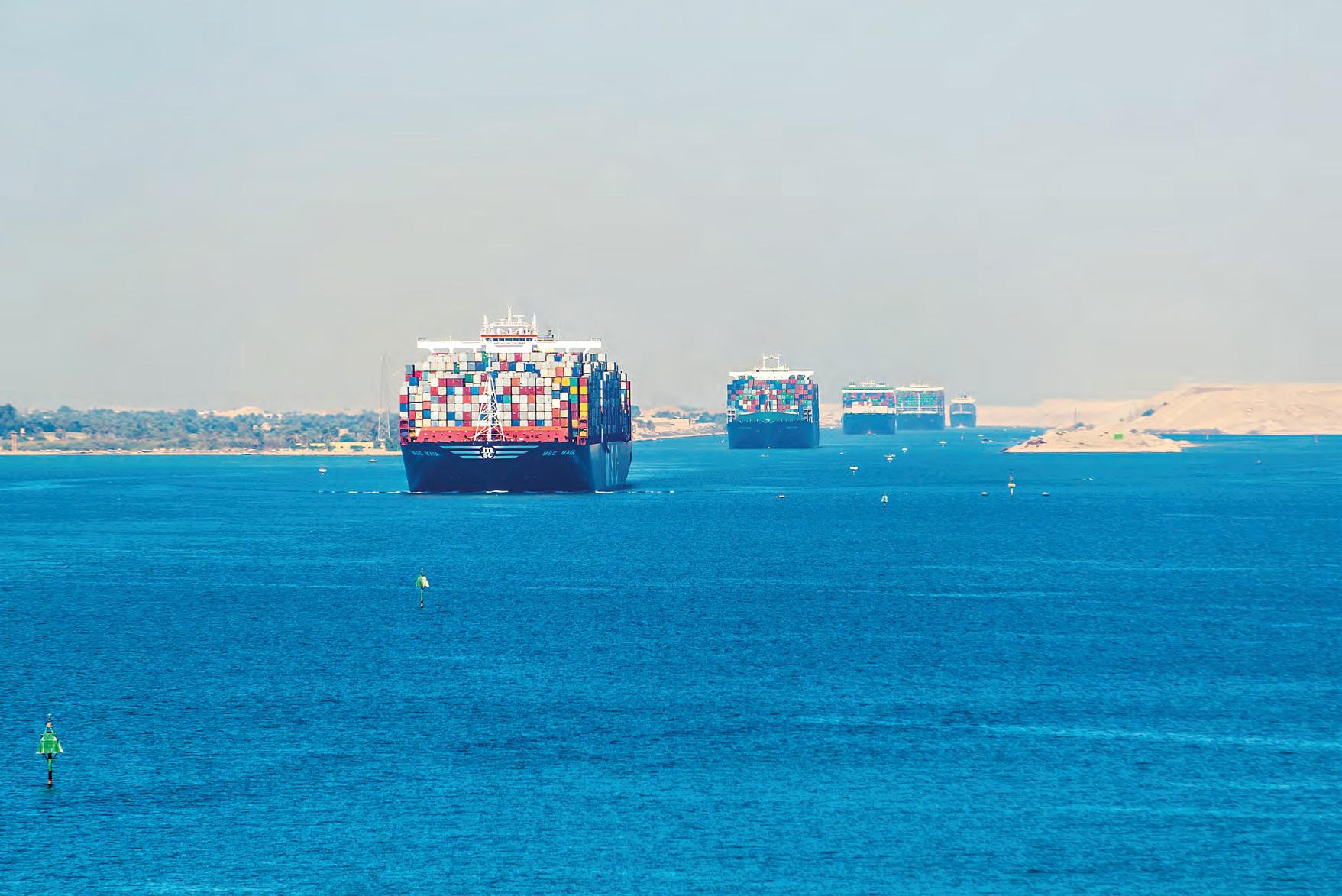
It is the existential risk of record-breaking droughts that affect the Rhine, Mississippi, Mekong and other waterborne trade routes. The prevailing situation proves the vulnerability to terrorism and climate of the supply chains that have evolved over many years, in some cases over centuries.
A thousand ships
To take the Panama Canal first. In more normal times about 1,000 ships go through its locks each month, carrying some 40 million
Happily, there has been some relief in the Panama Canal. The restrictions on passage have been progressively eased – but not lifted – as the El Nino-triggered drought throughout Central America goes on its way. In mid-April the hard-pressed Panama Canal Authority approved the passage of up to 32 ships a day including those with deeper draughts of nearly 14 metres. At the height of the drought in early 2024, approvals had been roughly halved. Some vessels could scarcely clear the bottom of the canal. The resulting disruption to supply chains was profound.
some three billion tonnes of a hugely diverse range of products in a good year to about 100 countries, suffered a nearly cataclysmic drought in late 2022 that made the shipping world wonder about the river’s future navigability. And it still does.
Water levels at one of the giant ports on the 3,915-mile-long river fell to the lowest level since records began in 1865 as simultaneously depths at the river’s many tributaries followed suit. Although officials preferred not to tell the worst, the truth is that the Yangtze was reduced to half its normal width. If another drought hits the region, nobody knows how low the Yangtze could go.
Other logistically important and historic waterways like the Rhine, Mississippi and ClimATe CHANGe iS NoW THreATeNiNG THe SHippiNG lANeS THAT uNderpiN GlobAl CommerCe
130 | Summer 2024
analysis Supply Chains
Traffic on the Suez Canal in Egypt

muddy torrent, it is droughts that create the most damage. “Unlike flood, drought only brings socio-economic hardship to riparian countries, especially riverine communities,” notes the multinational Mekong River Committee, pointing to ruined crops, fresh water shortages and disappearing fish.
Considerable uncertainty also hangs over the war-torn straits. If peace is restored, which looked unlikely in mid-April, their militarily strategic position in an increasingly volatile region makes the case for alternative supply chains even more urgent. Supply chains have many elements and, as Oxfordbased PortWatch explains, delays in these choke points lead to further disruption all along the route, including ports that depend
disruption to the way water moves between the Earth and the atmosphere – the patterns of rain, evaporation, condensation, and runoff that affect how much water flows through the world’s waterways – appears to be here to stay. Global supply chains depend on these waterways. With climate change expected to make extreme weather more frequent, a big rethink of how goods move around the globe is necessary.”
Beached business
Others express similar concerns about future disruption to the world’s complex highways to the sea. “Pressure on global shipping routes is creating stress in global supply chains again, soon after the acute disruption experienced
in the pandemic,” insurer Swiss Re noted in a much-quoted February 2024 report. Enti-
Navigating shipping disruptions: signs of rougher seas ahead, the author more or less echoed the Atlantic Council: “More frequent droughts are likely to jeopardise transit volumes in the Panama Canal, and climate change is already affecting river shipping, as seen in the Rhine and Mississippi. We view these as headwinds to the long-term resilience of global shipping trade.”
But what can be done? Some have suggested shallower-bottomed vessels, others deep dredging. While the first is practicable but would send half the world’s river-going fleet to the scrap yard, the second is routine on most of the great waterways but on nothing like the required scale. Then there are ‘road bridges,’ basically overland transport by trucks and trains that would supplement or even replace waterways when they become impassable.
The boldest alternative by far would be another canal connecting the Pacific and Atlantic Oceans through Nicaragua. A Chinese company established by a certain Wang Jing, supposedly having ties to the Beijing government, has claimed a 100-year concession and a 173-mile route has been drawn up for a waterway that would take far bigger vessels than the Panama Canal, in fact ships like giant bulk carriers with depths of 26 metres. But the project would cost $40bn and would pass through pristine Lake Nicaragua, rainforest and wetlands, not to mention a geophysically unstable region.
As the Smithsonian magazine reported in 2014 when digging was supposed to begin, “the canal route lies in the middle of a hurricane belt.” Other more definite initiatives should help plug emerging gaps in the global supply chain. Abu Dhabi has signed a preliminary deal with Iraq to jointly develop a strategically located new port on the northern tip of the Persian Gulf near Basra. Named Al-Faw Grand Port, it is expected to open by the end of 2025 and link ‘east and west,’ according to its supporters. It will be big enough to take containers, dry bulk and tankers.
As war disrupts sea routes in the region, new supply chains are emerging. In early 2024 Turkey and Iraq unveiled a 1,200-km, $17bn road and rail link project – a land bridge, in short – that will connect Iraq’s main port to the Turkish border and then into Europe.
Ominously for Egypt, it will avoid the Suez Canal entirely. n
Summer 2024 | 131 analysis Supply Chains
Lying in corporate elections
When it comes to proxy contests, the truth matters, and without an urgent overhaul of the current system, shareholders will continue to influence the outcome of corporate votes in underhanded ways
 WORDS BY Kai Haakon E. Liekefett paRTNER, SIDLEY auSTIN LLp
WORDS BY Kai Haakon E. Liekefett paRTNER, SIDLEY auSTIN LLp


We live in polarising times. The current political and cultural environment is arguably the most heated and controversial in decades. One of the most prominent victims of our era: the truth. As Mark Twain famously said; “A lie can travel half way around the world while the truth is putting on its shoes.” Political election campaigns, in particular, are riddled with misleading statements, half-truths and outright lies. Our fragmented media ecosystem and the pervasive influence of social media make it easier than ever to distribute falsehoods to a vast audience near-instantaneously, compromising the integrity of political elections.
While not as extreme as with political discourse, similar issues have emerged in corporate elections. In recent years, it seems there have been more half-truths and outright lies in proxy contests than perhaps ever before. During proxy season, hardly a day goes by without a press release, shareholder letter or investor presentation containing questionable statements.
Public companies, as securities issuers, face heavy scrutiny of their disclosures under areas of federal securities law beyond the proxy rules. A company simply cannot make recklessly optimistic statements about its future prospects without exposing itself to liability.
Dissident shareholders like activist funds, on the other hand, generally escape similar levels of scrutiny. There are rules designed to protect the integrity of corporate elections – the federal proxy rules under the US Securities Exchange Act of 1934. Unfortunately, however, these proxy rules – many of which were adopted decades ago and long before the
advent of the digital age – are increasingly under stress. In fact, many activists repeatedly violate the proxy rules, yet apparently face no repercussions.
Constraints on misstatements
Rule 14a-9 under the US Securities Exchange Act of 1934 prohibits false and misleading statements in a proxy contest. The rule also prohibits the omission of material facts when such omission would make statements false or misleading. The rule provides examples as to potentially misleading statements, including: predicting future market values; making disparaging claims without sufficient facts; obfuscating who is disseminating the proxy solicitation materials in question, and; making claims prior to a shareholder meeting regarding the results of a solicitation.
While helpful on its face, rule 14a-9 leaves substantial leeway for interpretation of a statement. The application of these rules has often failed to rein in even clearly problematic behaviour in proxy contests.
For example, the legality of statements about proxy tallies prior to the closing of the polls remains an unresolved issue. As noted above, rule 14a-9 lists ‘claims made prior to a meeting regarding the results of a solicitation’ as an example of a misleading statement. On that basis, several courts have ruled that such disclosures can spoil the fairness of the voting process by creating a ‘bandwagon effect.’ This is the phenomenon that many shareholders may vote for the purported likely winner in the belief that the outcome has become a ‘foregone conclusion.’
Yet, many courts have been reluctant to intervene even in seemingly clear cases. For instance, in one court case, an activist announced preliminary proxy voting results several weeks prior to the shareholder meeting, claiming that it was clearly leading with 80 percent of the shares voted. These numbers turned out to be false. However, the court declined to issue a preliminary injunction, and the dissident proceeded to succeed in its proxy contest. This explains why we still see leaks of alleged or actual preliminary vote tallies pre-meeting on a regular basis, including in a recent high-profile proxy fight.
SEC review
In the past, the SEC staff in the Division of Corporation Finance, through the comment letter process, strove to enhance compliance with these proxy rules. Whenever a party overstepped boundaries, the other party would send a private and confidential letter to the SEC, noting the violations. To the extent its staff agreed, the SEC would often react promptly to those letters by issuing comments to the offending party. This process ensured that the rhetoric in proxy contests remained significantly less heated and more truthful than in political elections.
In recent years, practitioners have observed a decline in the number and breadth of SEC comments in proxy contests. This surprising trend contrasts with the SEC’s ex-
132 | Summer 2024
analysis Proxy Contests
miSleAdiNG STATemeNTS, HAlF-TruTHS ANd ouTriGHT lieS uNderCuT THe ideAlS oF CorporATe demoCrACy
the defendants by merely filing the complaint with the SEC and stating that they disagree with the lawsuit. This holding is antithetical to the purpose of the securities laws, which focus on accurate disclosure. This ruling has become yet another potential obstacle to enforcing disclosure claims in federal court.
A call for action

We believe iT iS Time For CoNGreSS To level THe plAyiNG Field
tensive focus on proxy contests prior to the adoption of the universal proxy rules in 2021. The SEC’s packed agenda and limited resources have likely shifted attention towards other pressing matters.
Moreover, the SEC’s authority under the proxy rules has always been limited. The Division of Corporation Finance can only provide comments. If proxy rule violators do not comply with those comments, their staff can only refer a matter to the SEC’s Division of Enforcement. However, we are not aware of any enforcement action prior to a shareholder meeting in recent years.
Litigation in federal court
Companies waiting for SEC action can instead bring suit against proxy rule violators in federal court. However, litigation poses significant risks for a company.
As an initial matter, lawsuits are not inexpensive. While there is often insurance when companies are the defendants in a lawsuit, there is typically no insurance available for companies to pursue litigation as plaintiffs. Moreover, proxy advisory firms and investors frequently criticise companies for initiating litigation against shareholders. This is certainly an important consideration in a proxy contest where a company needs to weigh any
potential win in court against a loss at the ballot box.
More substantively, there is also the reality of condensed proxy fight timelines and the burden of proof. Proxy contests are fast-paced and shareholder meetings are typically only a few weeks away. Therefore, a litigant needs to move for expedited proceedings and file for a preliminary injunction to have any hope for a ruling prior to election day. The burden of proof for the issuance of a preliminary injunction, however, is greater than that required in regular proceedings. A preliminary injunction is an extraordinary remedy that generally will be granted only in limited circumstances.
This type of remedy is available generally only when the plaintiff establishes that: 1) there is a likelihood of success on the merits; 2) there is irreparable harm if the injunction is denied; 3) the balance of the equities tips in the plaintiff’s favour; and 4) the public interest favours the requested relief.
This standard requires plaintiffs to clear a high bar – a challenging proposition in the midst of a proxy contest.
A further complicating factor is that many federal judges are not familiar with the intricacies of proxy contests because such cases are relatively rare. As a result, the case law originating from the federal courts has been uneven and inconsistent.
For example, a court last year ruled that certain disclosure claims can be ‘mooted’ by
mANy ACTiviSTS
repeATedly violATe
THe proXy ruleS, yeT AppAreNTly FACe No reperCuSSioNS
It is time to protect the integrity of corporate elections and the shareholder vote. Misleading statements, half-truths and outright lies undercut corporate democracy. We believe it is time for Congress to level the playing field. The SEC should receive more resources to monitor proxy contests. In addition, the proxy rules should be tightened and provide the SEC with more authority to sanction violations. For instance, the SEC should have the right to require proxy rule violators to publicly withdraw false statements. The SEC should also be authorised to enjoin proxy contests and impose severe sanctions on repeat violators (freeze-out periods, for example). Lastly, it should be clarified that the mere filing of a complaint with the SEC is insufficient to ‘moot’ a lawsuit over misstatements in a proxy contest.
These changes would correct a fundamental imbalance in our current system between companies and activist shareholders. Simply put, both companies and investors should be held to the same standard. Some may argue that in our free market system, investors should engage in their own research before voting, rather than relying on a government regulatory agency to police proxy contests. However, in fast-moving proxy fights, even institutional investors do not have the time, resources, or manpower to fact check all statements. Proxy advisory firms like ISS and Glass Lewis, who influence significant portions of the vote, are similarly ill positioned to combat misinformation. Retail shareholders, a major focus of the SEC’s mandate, are even more vulnerable to disinformation in proxy fights. For these reasons, the investor community cannot solve this issue on its own.
Given current trends, it’s already past time for Congress to step in. The SEC takes a leading role to combat misleading or untruthful statements in other contexts – and Congress should enable it to do the same in proxy contests. Lying with impunity should not become a norm in our corporate elections. n
Summer 2024 | 133 analysis Proxy Contests

Unlocking growth in the experience economy
The experience economy is thriving, with consumers more interested in creating lasting memories than splashing out on material goods. Industries must rise to the challenge of creating new and immersive social experiences
WORDS BY Peter Vindevogel
cEo, ThE paRK pLaYGRouND
Learning from industry advancements
Businesses across the industry globally have recognised the importance of focusing on the entire visitor journey. Disneyland Paris Resort, for example, recently announced a huge investment to reimagine the entire guest experience from entertainment to dining and shopping. Similarly, mega developments in the Middle East, such as Qiddiya in Saudi Arabia are integrating entertainment, food and sports into one destination, delivering fresh experiences to guests every time they visit.
Businesses can take valuable insights from these developments by considering how to bring together multiple aspects to create a must-see destination. With guest expectations higher than ever, many businesses are turning to immersive technologies like mixed reality (MR) to meet the demand.
MR technology has hit a level of maturity and is more reliable and accessible both from a usability and an economic point of view, compared to just a few years ago. Additionally, MR can transform spaces into countless fantastical immersive worlds for groups, delivering the kind of social, entertainment-led experiences that visitors want.
Perfect harmony






Today’s business leaders and consumers alike are facing turbulent economic times. The goal of any business is to be profitable but there is no doubt that several recent world events have made it incredibly difficult for some. Amid these challenges, businesses are striving for growth in 2024 but to do so requires the prioritisation of customer satisfaction.
Across the leisure industry, businesses ranging from hospitality through to theme parks have to adapt their ROI models to rapidly changing guest expectations. Today’s consumers want shared entertainment experiences that offer something unique every time. To meet these high expectations, the leisure industry landscape has morphed by merging two previously separate worlds: food & beverage leisure and play & entertainment leisure.
The booming experience economy
Recently, Millennials and Gen Zers have continued to drive the experience economy by spending more on memorable experiences over material possessions, and their expectations for high-quality entertainment-led, so-
cial experiences have grown rapidly. A recent Europe-wide study indicates that this trend among the ‘experience generation’ is likely to continue. In fact, 88 percent of those surveyed planned to prioritise spending the same or more on experiences in 2024 (compared to 2023). The study also reveals that among the top reasons for booking an experience is to socialise with friends and family, while foodrelated or family experiences were among the top experiences of choice. These findings show that investing in delivering high-quality shared experiences is crucial to drive business growth and maintain competitive advantage.
While the experience economy has been in place for a long time, there are a few key factors for its recent evolutions. Following the pandemic we have seen more and more businesses in the leisure industry merge with social activities. Supply chains disrupted during Covid continue to be impacted by an increased cost of materials forcing operators to re-evaluate the profitability of their current business models. In addition, people emerged from lockdown with a new appreciation and desire for spending time with friends and family, and experiencing new and exciting events. These factors have given rise to ‘eatertainment,’ a concept born out of the collision of two leisure sectors – food & beverage and play & entertainment – that is both mutually beneficial to businesses and meets visitors’ needs.
Here are a few key considerations for any business trying to achieve the delicate balance of delivering high-quality guest experiences with profitability. It’s clear that today’s audiences value meaningful, social, entertainment-led experiences so individual digital experiences are going to become less popular than they have been previously. Operators should aim to nurture both entertainment and social aspects equally in available experiences. Audiences want the freedom of choice. It’s important for businesses to build a diverse content library that appeals to all ages and interests and provides guests with the flexibility to choose a different experience each time they visit. Consider integrating newer technologies, such as immersive VR, to make experiences more engaging, interactive and personalised so that it’s different every time it is played. And this doesn’t have to be costly; turnkey solutions can see a return on your investment quickly without the financial upheaval of building solutions yourself.
Balancing customer satisfaction with ROI is an ongoing journey. For the leisure industry, the answer is very much about combining worlds: eating and entertainment, the real and the imagined, the physical and the virtual. By embracing guest experience as a priority and using emerging technologies like immersive VR to meet guest expectations, businesses can navigate the challenging economic landscape with greater confidence. n
134 Summer 2024
Guests playing vr experiences at The park


How one company in particular is tackling challenges in the
iGaming
industry, changing perceptions around sportsbooks and staying ahead of the competition
INTERVIEW WITH
Evgen Belousov
cEo, GR8 TEch
taking on. Belousov says the fast-paced, forever-changing nature of the wider iGaming market can be one of the biggest hurdles for platform providers in the industry, but that the company has been able to “navigate the environment and enjoy the ride” through its expertise.
We believe THAT opeN dATA SHAriNG iS FuNdAmeNTAl To THe AdvANCemeNT oF THe iNduSTry
“The global iGaming industry is incredibly dynamic and constantly changing, so the main thing is keeping up with the pace,” he says. “Providers need to factor in emerging technologies, updates in regulations, the evolving preferences of end users, and shifting priorities of the operators, to name just a few of the considerations.”



“In a world with plenty of good solutions, what makes you truly stand out? What makes your technology great? This was the question we asked when we entered the B2B market,” says Evgen Belousov, CEO at GR8 Tech, an iGaming platform provider that offers products and services to operators in the industry – from an all-encompassing sportsbook and casino platform to various other standalone products.
“Our answer was to offer tailored solutions that cater to industry players’ personalised needs,” he says. “We provide everything needed to launch and run a successful iGaming business, positioning ourselves as a lifetime partner for our clients. We support their successful development and scaling up, with flexible technology that can adjust to the operator’s needs as they grow.”
Sportsbook success
At the core of GR8 Tech’s products is its GR8 Sportsbook – a long-standing and well-known platform with a stellar reputation, designed to provide operators with the chance to tailor their offerings to local audiences.
“One of our strengths lies in offering a strong selection of regional favourites, such as cricket, kabaddi, American football, basketball, hockey, volleyball, and others,” says Belousov. “Depending on where they are located, operators can offer exactly what their
local audiences like, gathering more engagement and support from them.”
“The platform can also manage heavy user loads with real-time anti-fraud processing, balancing the need for attractive player odds with profitability for operators,” Belousov continues. “Its modular nature means operators can flexibly customise their offering as business requirements change.”
Changing perceptions
The success of the platform to date has seen the company recognised with several accolades – including Best Online Sportsbook Provider 2024 at the SiGMA Eurasia Awards –and it isn’t just benefitting GR8 Tech’s clients and their users; it is also helping to change perceptions around the profitability of sportsbooks more generally, according to Belousov.
“One of the interesting challenges we have seen has come from the idea that sportsbooks aren’t that lucrative,” he says. “Typically, sportsbooks are seen more as an engagement tool, while operators rely more on casinos to make money. We have tried to change this stereotype with a high-performance sportsbook platform that is designed to bring tangible financial results for its operators within their first 12 months,” he says.
“Transforming the industry’s conventional view of sportsbooks isn’t a trivial thing, but we are confident in our ability to deliver and change the norm.”
Addressing the challenges
Shifting perceptions around sportsbook platforms isn’t the only challenge the company is
He believes another key issue lies around the availability of data. “The limited willingness among providers to share data is a critical challenge,” he explains. “This restraint limits the ability of operators to make informed decisions and stifles the industry’s collective capacity to innovate and enhance player experiences,” he says. “As we progress into 2024 and beyond, this will become increasingly pronounced, as operators demand more transparency and data access to drive their strategic initiatives.”
To help tackle the data issue, GR8 Tech aims to “lead by example,” providing data to its clients to help them enhance their offerings. “We believe that open data sharing is fundamental to the advancement of the industry,” says Belousov. “This approach not only benefits our clients but also catalyses broader industry growth by fostering a culture of transparency and co-operation.”
Finding opportunities
Beyond data sharing, another challenge lies around regulation, according to Belousov. “Keeping up with the many jurisdictions around the world and ensuring products are flexible enough to adapt to various regulatory requirements can be tricky,” he says.
But the company knows how to turn a challenge into an opportunity. “We see these challenges as a positive,” he continues. “While it means there are additional considerations when developing new products and improving existing ones, it also pushes us to explore new things, be more creative, and ultimately design more robust solutions.”
That nimble approach appears to be working. With a goal to become the “go-to provider for iGaming operators,” GR8 Tech has lofty ambitions – but if its rapid growth over the past year is anything to go by, the company looks set for a promising future. n
136 | Summer 2024
analysis Technology





THEGLOBA L RACEFOR REGULATION

138 | Summer 2024
REGULATORS AROUND THE WORLD ARE GRAPPLING WITH A RAPIDLy EVOLVING TECHNOLOGy WITH MAJOR ECONOMIC AND GEOPOLITICAL REPERCUSSIONS, aLEx KaTSoMITRoS REPORTS >>
eU negotiations are known for dragging on too long, with deals often struck after midnight, products of exhaustion and relentless horse-trading. The one the European Council and the EU Parliament struck the night between December 8 and 9, 2023, was no different. Its final product, the EU AI Act, is the first major piece of legislation governing artificial intelligence (AI), including ‘generative AI’ chatbots that have become the Internet’s new sensation since the launch of ChatGPT in late 2022.
Just two days later, Mistral AI, a French start-up, released Mixtral 8x7B, a new large language model (LLM), as the computational models behind generative AI are known. Although smaller than proprietary equivalents, it is in many ways superior due to its idiosyncratic setup that combines eight expert models. More ominously, its open source code is exempt from the Act’s stricter rules, posing new problems to regulators.
Mixtral’s disruptive potential is emblematic of the difficulties facing regulators who are trying to put the AI genie back in the bottle of the law. For its part, the tech industry thinks it knows the answer: self-regulation. Former Google CEO Eric Schmidt has argued that governments should leave AI regulation to tech firms, given their tendency to prematurely impose restrictive rules. For most policymakers, however, the question remains: how do you regulate something that changes so fast?
Laying down the EU law
Coming into force in May 2025, the AI Act represents the first attempt to answer that question. By covering nearly all AI applications, it aims to establish a European, and possibly global, regulatory framework, given the bloc’s reputation as a regulatory superpower. “Large, multi-jurisdictional businesses may find it more efficient to comply with EU standards across their global operations on the assumption that they will probably substantially meet other countries’ standards as well,” said Helen Armstrong, a partner at the law firm RPC. It is also the first stab at dealing with foundation models, or General Purpose AI models (GPAI), the software programmes that power AI systems. The act imposes horizontal obligations on all models, notably that AI-generated content should be detectable as such, with potential penalties up to seven percent of the miscreant’s global turnover.
The Act follows a tiered approach that assigns varying levels of risk and corresponding obligations to different activities and AI models. GPAIs are classified into two categories, those with and without systemic risk, with
the latter facing stricter rules such as being subject to mandatory evaluations, incident reporting and advanced cybersecurity measures including ‘red teaming,’ a simulated hacking attack. What constitutes ‘systemic risk’ is defined according to multiple criteria, two of which are the most crucial: whether the amount of computing used for model training is greater than 10^25 ‘floating point operations,’ an industry metric, and whether the model has over 10,000 EU-based business users. So far, only ChatGPT-4 and possibly Google’s Gemini meet these criteria.
Not everyone finds these criteria effective. “There could be high-capacity models that are relatively benign, and conversely, lower-capacity models that are used in high-risk contexts,” said Nigel Cannings, founder of the Gen AI transcription firm Intelligent Voice, adding that the computing criterion might encourage developers to find workarounds that technically comply with the threshold without reducing risks. Current AI research focuses on doing more with less by reducing the amount of data required to produce acceptable results. “These efforts are likely to break the compute barrier in the medium-term, thus making this regulation void,” said Patrick Bangert, a data and AI expert at Searce, a technology consulting firm, adding: “Classifying models by the amount of compute they require is only a short-term solution.”
hoW Do You REGuLaTE SoMEThING ThaT chaNGES So FaST? »
The Act’s final draft is the product of fierce negotiations. France, Germany and Italy
Summer 2024 | 139
THE EXPLOSIVE GROWTH OF AI-POWERED FRAUD
initially opposed any binding legislation for foundation models, worrying that restrictions would hamper their start-ups. As a counterproposal, the Commission suggested horizontal rules for all models and codes of practices for the most powerful ones; the selected criteria were a middle-of-the-road compromise. “There was a feeling that a lower threshold could hinder foundation model development by European companies, which were training smaller models at that moment,” said Philipp Hacker, an expert on AI regulation teaching at the European New School of Digital Studies, adding: “This is entirely wrong, as the rules only codify a bare minimum of industry practices – even falling short of them by some measures. But there was a huge amount of lobbying behind the choice of the threshold and hence we have an imperfect result.”
Others find the Act’s purview too sweeping. “It’s far more effective to regulate use cases instead of the general technologies that underpin them,” said Kjell Carlsson, an AI expert at Domino Data Lab, an AI-powered data science platform. Many European startups and SMEs have said that restrictions could put them at a disadvantage compared to their competitors. Compliance is easier for foundation model providers that invest vast sums in training data, amounting to just one
percent of their development costs according to a study by the Future Society, a think tank studying AI governance.
For sceptics, the solution chosen is another brick in the EU’s regulatory wall, stifling innovation in an area where Europe badly needs success stories. The bloc has produced few AI unicorns compared to the US and China, while lagging behind in research. Nicolai Tangen, head of Norway’s $1.6trn sovereign wealth fund, which uses AI in its investment decision-making processes, has publicly expressed his frustration with the EU’s approach: “I am not saying it is good, but in America you have a lot of AI and no regulation, in Europe you have no AI and a lot of regulation.” Hurdles European firms face include a fragmented market, stricter data protection regulations, and challenges in retaining talent, as AI professionals are drawn to higher salaries and funding opportunities elsewhere.

The Act may make things worse according to Hacker, because of its undeserved “bad reputation”: “It is not particularly stringent, but there has been a lot of negative coverage and many investors, particularly from the international venture capital (VC) scene, treat the Act as an additional risk. This will make it harder for European unicorns to attract capital,” he said. Not everyone agrees with this assessment. “For VCs, it is only a new criteria to add to their assessment scorecard: is the company developing a model or product that is and will remain EU compliant, given the Act’s guidelines?” said Dan Shellard, Partner at Breega, a Paris-based venture capital firm, adding that regulation could create opportunities in the regtech space. Some even think it will foster innovation. “Forcing companies to work on problems where they have to be more transparent and responsible will likely unleash a different wave of innovation in the field,” said Chris Pedder, Chief Data Scientist at AI-powered edtech firm Obrizum. Another problem is that technology is evolving faster than regulation. The release of open-source models like Mixtral 8x7B is expected to enhance transparency and accessibility, but also comes along with significant safety risks, given that the Act largely exempts them from regulation unless they constitute
140 | Summer 2024
COUNTrIeS Per reGION WITh BIGGeST INCreASeS IN DeePFAKe-SPeCIFIC FrAUD CASeS FrOM 2022 TO 2023 (IN %)
mEXICO 700 BRaZIl 828 ArGENTiNA 766 alGERIa 1,000 SOUth aFRICa 1,200 UaE 2,200 philippiNES 4,500 CANAdA 477 US 3,000 BElGIUm 2,950 SlOVakIa 1,500 romANiA 1,766 ViETNAm 3,050 JApAN 2,800 IN aMERIca You haVE a LoT oF aI aND No REGuLaTIoN, IN EuRopE You haVE No aI aND a LoT oF REGuLaTIoN the implic at i ons »
Source: Statista, Sumsub Identity Fraud report 2023

pute capabilities available to the open source models – a big chunk of users will be playing with local compute capability rather than expensive cloud-based compute resources,” said Iain Swaine from BioCatch, a digital fraud detection company. “Malware, phishing sites or even deepfakes can be more easily created in an environment that is no longer centrally controlled.”
Divided America
On the other side of the Atlantic, the US remains a laggard in regulation despite its dominance in commercial AI. Its regulatory landscape remains fragmented, with multiple federal agencies overseeing various aspects of AI. An executive order has tasked government agencies to evaluate AI uses and forces developers of AI systems to ensure that these are ‘safe, secure and trustworthy’ and share details about safety tests with the US government. Without the backing of the Republican-controlled Congress, however, it may be doomed to remain toothless, while Donald Trump has vowed to overturn it. Congress has launched its own bipartisan task force on AI, but this has produced little so far. Partisan splits make any agreement before elections in November unlikely. US regulation is expected
chINa WaNTS a SEaT aT ThE TabLE aND To haVE a SaY IN ShapING GLobaL DEVELopMENT oF aI REGuL aTIoN
to be less strict than its European counterpart, given that US governments traditionally prioritise innovation and economic growth.
“AI will be an area in which both Congress and the executive branch take a very incremental approach to regulating AI – including by first applying existing regulatory frameworks to AI rather than developing entirely new frameworks,” said David Plotinsky, partner at the law firm Morgan, Lewis & Bockius, adding that states may fill the vacuum. The risk, he added, is a “patchwork of regulations that may overlap in some areas and also conflict in others.”
The debate is informed by apocalyptic forecasts that the advent of an omnipotent form of AI may pose an existential threat to humanity. Some, including Elon Musk, have even called for a halt on AI development. However, more prosaic issues seem more urgent. A major concern is the rise of monopolies, par-
ticularly in generative AI, although the emergence of several competitors to ChatGPT has allayed concerns that a monopoly of OpenAI, the company behind ChatGPT, is inevitable. “Given the industry’s high barriers to entry, such as the need for substantial data and computational power, there is a real risk that only a few large incumbents, such as top big tech, could dominate,” said Mark Minevich, author of Our Planet Powered By AI.
Policymakers are also mindful of the impact of legislation on US competitiveness, as AI is increasingly seen as an area of confrontation in the troubled relationship with China. US President Joe Biden has directed government agencies to scrutinise AI products for security risks, while another executive order directed the Treasury to restrict outbound AI investment in countries of concern. “The US will wind up needing to adopt some sort of risk-based approach to foundation models,” estimated Plotinsky, who has served as acting chief of the US Department of Justice’s Foreign Investment Review Section, adding: “Any risk-based approach would also need to take into consideration whether the foundation model was being developed in the US or another trusted nation, as well as what controls and other safeguards might be necessary to prevent potentially powerful technology from being transferred to countries of concern.”
The Chinese puzzle China’s ambitions justify such concerns. Its government aims to make the country an AI leader by 2030 through massive government funding. China is already the largest producer of AI research. Its Global AI Governance Initiative, a set of generic proposals for AI rules beyond China’s borders that include the establishment of a new international organisation overseeing AI governance, is indicative of its aim to influence global regulation. The initiative also includes a call to “oppose drawing ideological lines or forming exclusive groups to obstruct other countries from developing AI,” perceived as a reference to US legislation aimed at curbing US investment in China’s AI industry. “In international forums, China wants a seat at the table and to have a say in shaping global development of AI regulation,” says Wendy Chang, an expert on Chinese technology from the think tank Mercator Institute for China Studies. “But domestically, there is the additional task of maintaining Beijing’s tightly run censorship regime, which comes through sometimes quite explicitly such as requiring generative text content to ‘reflect socialist core values’.”
These values may hamstring China’s bid to become a global leader in AI, although the government wants Chinese firms to develop Gen
Summer 2024 | 141
the implic at i ons »
Finance is one of the sectors where the use of aI poses grave risks, with areas like risk modelling, claims management, anti-money laundering and fraud detection increasingly relying on AI systems. A 2022 Bank of england and FCA survey found that 79 percent of UK financial services firms were using machine learning applications, with 14 percent of those being critical to their business. a primary concern is the ‘black-box’ problem, namely the lack of transparency and accountability in how algorithms make decisions. Regulators have noted that aI may amplify systemic risks such as flash crashes, market manipulation through aI-generated deepfakes, and convergent models leading to digital collusion. The industry has pledged to aim for more ‘explainability’ in how AI is being used for decision-making, but this remains elusive, while regulators themselves may fall victim to automation bias when relying excessively on aI systems. “Transparency sounds good on paper, but there are often good reasons that certain parts of certain processes are kept close to a financial institution’s chest,” said Scott Dawson from the payments solutions provider DEcTa, citing fraud prevention as an example where more transparency about how aI systems
AI tools to compete internationally; both Chinese tech giants Baidu and Alibaba launched their AI-powered chatbots last year. The initial draft of the country’s rules for generative AI required developers to ensure the ‘truth, accuracy, objectivity, and diversity’ of training data, a high threshold for models trained on content gathered online. Although recent updates of the regulation are less strict, meaning that Chinese firms are no longer forced to ensure the truthfulness of training data but to ‘elevate the quality’ and ‘strengthen truthfulness,’ barriers remain substantial. One working group has even proposed a percentage of answers that models could reject.
Given the tendency of chatbots to come up with disinformation, such rules may force Chinese firms to use limited firewalled data to train their models. Currently, Chinese firms and citizens are not permitted to access ChatGPT. In one case, the founder of the AI company iFlytek had to issue a public apology when one of the firm’s AI tools produced text criticising Mao Zedong. “Beijing’s need to enforce information control domestically is a
are used by financial services firms could be counterproductive: “Telling the world what they are looking for would only make them less effective, leading to fraudsters changing their tactics.” another concern is algorithmic bias. The use of aI in credit risk management can make it more difficult for people from marginalised communities to secure a loan or negatively affect its size and conditions. In the eU, the proposed Financial Data Access regulation, which will allow financial institutions to share customer data with third parties, may exacerbate the challenges facing vulnerable borrowers. The eU AI Act tackles the problem by classifying banks’ aI-based creditworthiness operations and pricing and risk assessments in life and health insurance as high-risk activities, meaning that banks and insurers will have to comply with heightened requirements. “New ethical challenges are triggering unintended biases, forcing the industry to reflect on the ethics of new models and think about evolving towards a new, common code of conduct for all financial institutions,” said Sara de la Torre, head of banking and financial services at Dun & Bradstreet, a US data analytics firm.
big Achilles heel for its AI development community,” said Chang. “Compliance would pose large hurdles for tech companies, especially smaller ones, and may discourage many from entering the field altogether. We already see tech companies veer towards more businessoriented solutions rather than working on public-facing products, and that is what the government wants.”
The Chinese government has rolled out detailed AI regulations, with a comprehensive national law expected to be issued later this year. Its regulatory approach focuses on algorithms, as shown by its 2021 regulation on recommendation algorithms, driven by concerns over their role in disseminating information, a perceived threat to political stability and China’s concept of ‘cyber sovereignty.’ Crucially, the regulation created a registry of algorithms that have ‘public opinion properties,’ forcing developers to report how algorithms are trained and used. Its remit has recently expanded to cover AI models and their training data, with the first LLMs that passed these reviews released last August.

China’s deep synthesis regulation, finalised just five days before the release of ChatGPT, requires that synthetically generated content is labelled as such, while its cyberspace regulator recently announced similar rules for AIgenerated deepfakes.
Who owns this picture?
Another emerging battlefield is the ownership of the intellectual property for the data that power foundation models. The advent of generative AI has shocked creative professionals, leading to legal action and even strikes against its use in industries hitherto immune to technological disruption, like Hollywood. Many artists have sued generative AI platforms on the grounds that their work is used to generate unlicensed derivative works. Getty Images, a stock image supplier, has sued the creators of Stable Diffusion, an image generation platform, for violating its copyright and trademark rights. In response, the platform’s owners announced that artists could opt out of the programme, tasking them
142 | Summer 2024 the implic at i ons
hopES FoR a GLobaL REGuL aToRY FRaMEWoRK aRE pERcEIVED aS oVERLY opTIMISTIc
»
aI poSES NEW chaLLENGES FoR FINaNcIaL REGuL aToRS

with the protection of their intellectual prop erty. Such legal action has sparked a debate on whether AI-generated content belongs to AI platforms, downstream providers, content creators or individual users. Suggested solutions include compensating content creators, establishing shared revenue schemes or using open-source data. “In the short term, I expect organisations placing greater reliance on contractual provisions, such as a broad intellectual property indemnity against any third party claims for infringement,” said Ellen Keenan-O’Malley, a solicitor at the law firm EIP. So far only the EU has taken a clear position; the AI Act requires all model providers to put ‘adequate measures’ in place to protect copyright, including publishing detailed summaries of training data and copyright policies.
“An outright ban on using copyrighted images for AI training would ban AIs that mass-produce custom art,” said Curtis Wilson, a data expert at the tech firm Synopsys. “But it would also ban image classification AI that is used to detect cancerous tumours.”
A shattered world
As the next frontier in the race for tech supremacy, the deployment of AI has geopolitical repercussions, with Europe and China vying for a chunk of America’s success in the field. Hopes for a global regulatory framework are perceived as overly optimistic across the

ThE Eu haS FIRED ThE FIRST ShoT IN ThE RacE FoR GLobaL aI STaNDaRDS
tech industry, given the rapid development of AI models and the different approaches across major economies, meaning that only bilateral agreements are feasible. A recent Biden-Xi summit produced an agreement to start discussions, without any details about specific actions. The EU and the US have agreed to increase co-operation in developing AI-based technology, with an emphasis on safety and governance, following a similar pact between the US and UK to minimise divergence in regulation. The first global summit on artificial intelligence, held in the UK’s Bletchley Park last November, issued the Bletchley Declaration, a call for international co-operation to deal with the risks of deploying AI. So far, this has not translated into action.
For the time being, the prospect of common regulation for AI seems to be distant, as policymakers and tech firms face the same headwinds that are leading the global economy to fragmentation in an era of rapid deglobalisation. The EU has fired the first shot in the race for global AI standards, opt-
ing for horizontal, and for some overly strict, rules for AI systems; the US, hampered by preelection polarisation and the success of its AI firms, has adopted a ‘wait-and-see’ approach that practically gives the tech industry a free hand; China, true to form, sticks to censorship domestically while trying to influence the emerging global regulatory framework. “The challenge going forward is not allowing China to dictate what standards are or promote policies regulating AI that favours them over everyone else,” said Morgan Wright, Chief Security Advisor at SentinelOne, an AI-powered cybersecurity platform.
A bigger challenge, however, remains catching up with the technology itself. If the advent of loquacious chatbots in 2022 caught the world by surprise, the next waves of AIpowered innovation have left even experts speechless with their disruptive potential. “The field is moving so fast, I am not sure that even venture capital firms not deeply immersed in the field for the last decade fully understand AI and its implications,” said Alexandre Lazarow, founder of the venture capital firm Fluent Ventures.
For regulators, things may be even worse, according to Plotinsky from Morgan, Lewis & Bockius: “The technology has evolved too rapidly for lawmakers and their staffs to fully understand both the underlying technology and the policy issues.” n
Summer 2024 143 the implic at i ons
The race is on in the electric vehicle revolution
All along the supply chain, from pioneering EV manufacturers and battery technology to recycling and charging, companies are fighting to dominate their niche. And for the savvy investor, this opens up many opportunities to capitalise on in this new and exciting market
WORDS BY
Claire Millins
FEaTuRES WRITER






Words like ESG, circular economy, sustainability, global warming, carbon footprint, carbon offset, and net zero have become entrenched in everyday language, and, like it or not, when it comes to transportation, the electric vehicle (EV) revolution is in full swing. We are being encouraged to ditch our combustion engines in favour of cleaner energy, and with good reason: not only is electric kinder to the planet, but oil is a limited commodity and won’t last forever.
However, despite media reporting of a slowdown in sales, EV Volumes’ recent report showed that sales of electric vehicles, both battery electric vehicles (BEV) and plug-in hybrids (PHEV), increased by 35 percent in 2023. Additionally, Statista reports that in 2024, the global revenue in the electric vehicles market is projected to reach $623.3bn.
All of which is good news for investors looking to capitalise on this emerging trend. By looking further down the supply chain beyond car manufacturers, there are many areas in the sector that present attractive investment opportunities, such as battery and other technologies, supporting services and infrastructure, and with enough research investors can position themselves to reap the benefits.
The case for EVs
Excluding water vapour, which varies between 0–4 percent, Earth’s atmosphere comprises approximately 78 percent nitrogen, 21 percent oxygen and 0.93 percent argon, with the remainder made up of trace gases, including the so-called greenhouse gases; carbon dioxide, methane, nitrous oxide, and ozone. While greenhouse gases account for only 0.04
percent, or 400 parts per millions (ppm), of gases in the atmosphere, they, along with water vapour, absorb the heat energy that the Earth gives off, trapping some of it in the atmosphere and emitting the rest back to Earth and space. And this causes a vicious cycle. As the heat energy in Earth’s atmosphere increases, humidity increases, which heats Earth further.
Transportation accounts for approximately 15 percent of all global energy-related energy emissions, and EVs have emerged as one solution to help mitigate the impact of combustion engine emissions and reduce the effects of climate change.
Growth drivers of the EV market 20 years ago, car buyers were encouraged to buy diesel vehicles as they were better for the planet. Obviously we know now that wasn’t the case and with more information at our fi ngertips, car buyers are more aware of the environmental benefits of EVs, but market growth is determined by several factors that affect EV adoption.
Buying or leasing a car is a huge investment, so price remains a major driver of the market. And while prices are slowly coming down, the cost of an EV is still higher than that of a petrol equivalent. Thankfully though, with more manufacturers hopping on the proverbial electric bandwagon, there is now considerably more choice for consumers.
The next growth driver is battery life and range, and though it’s fair to say that while both battery life and range have significantly improved over the last few years, there is still a way to go before consumers feel confident about their EV comfortably covering a long drive without the need to stop and charge several times. A continuously expanding charging
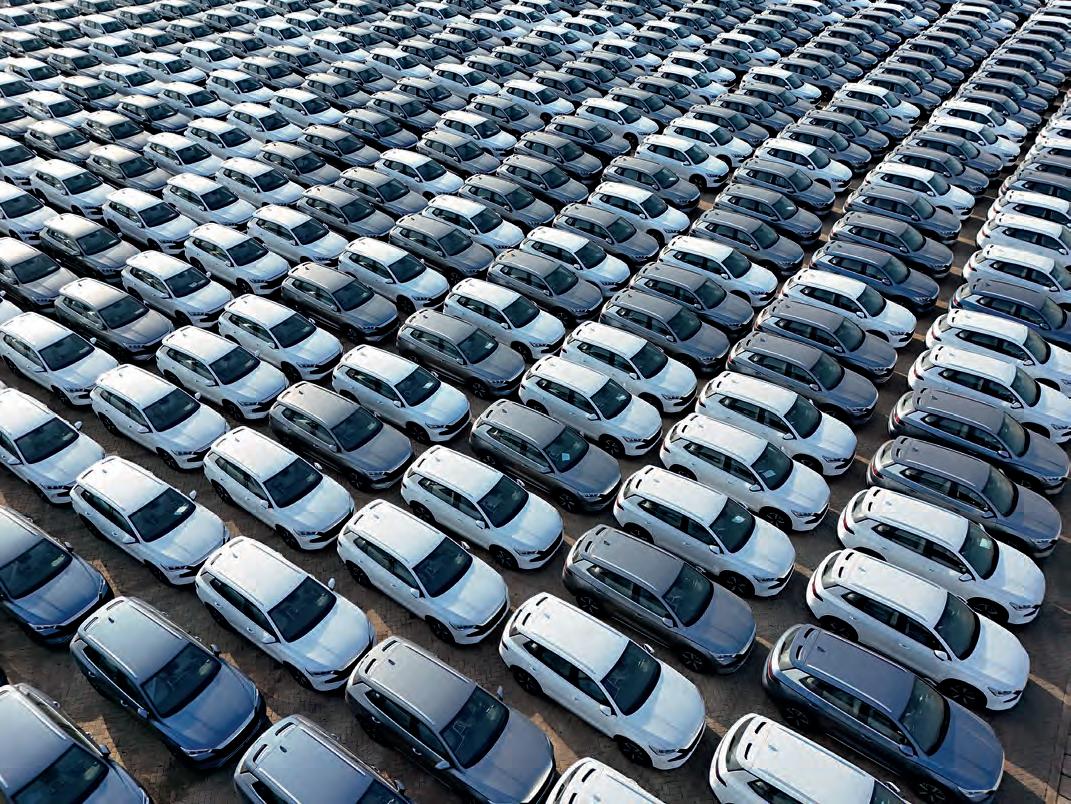
infrastructure along with the potential improvements to use faster, universal charging points will help drive market growth and assuage concerns when it comes to range and journey time.
The final growth driver is the availability of government incentives and subsidies that help consumers reduce the cost of swapping from petrol to electric. Alongside policies that improve and expand the charging infrastructure, this will help to make EVs a more attractive option for consumers.
Investment opportunities
If you are an investor looking to diversify your portfolio and take advantage of the headway being made in the EV market, where should you look? Starting at the top of the supply chain, EV manufacturers are the obvious place for a potential investor to begin sizing up the shape of the market and analysing the relevant data.
Many of the ‘old guard’ car manufacturers such as Ford, Volkswagen and General Motors have added plug-in hybrids to existing car marques while some have even designed futuristic-looking pure electric ranges. Then, of course, there are the new kids on the block such as Tesla and Rivian, to name two, that would require much deeper analysis as they
144 | Summer 2024
strategy Electric Vehicles
ev mANuFACTurerS promiSe boTH riSk ANd reWArd iN equAl meASure

CAr buyerS Are more AWAre oF THe eNviroNmeNTAl beNeFiTS oF evS
sit firmly on the riskier side of a balanced portfolio. So, whether you are after the stability of the tried and tested or a bit more risk with exciting innovation, EV manufacturers promise both risk and reward in equal measure.
With recent advancements in lithium-ion chemistry, energy density, battery life and safety, and the development of solid-state batteries, and more, these links in the supply chain, which includes leading manufacturers, materials suppliers and R&D firms, plays a vital role in shaping the future of EVs. The companies leading these technological innovations are the ones potential investors should analyse because as they position themselves as leaders in the race to power the future, they could yield significant returns.
Leading battery manufacturers include Panasonic, Samsung, LG Energy Solutions, and Tesla, and with the demand for EVs set to increase, it stands to reason that they should grow alongside the industry. Battery manufacturers provide investors with the opportunity to add to their ESG portfolio and potentially capitalise on the battery market. But what about the raw materials needed for the
$623.3bn projected global revenue in the ev market in 2024
35%
Increase in bEV and Phev vehicles in 2023
energy economy. And with about four times lower emissions than virgin materials, recycled battery materials help reduce the carbon footprint further.
When it comes to battery recycling, there are already some big hitters in the sector, such as Ecobat and Li-Cycle Holdings, which is projected to grow from $9bn in 2023 to $56.3bn by 2031. According to McKinsey, driven by several factors including technological progress, supply-chain stability consideration, decarbonisation and ethical supply-chain targets, as well as regulatory incentives and pressure, the battery recycling space is set for significant growth.
Currently, most EVs are charged at home or work, but for higher EV adoption there needs to be a better network of faster chargers to provide the same level of accessibility and convenience that refuelling petrol-powered cars has. In 2022, there were over 450,000 public EV chargers in Europe. This number is set to grow to 1.3 million by 2025 and 2.9 million by 2030. Thankfully there are already some global superstars in this sector including Blink Charging, EVgo and ChargePoint.
Risks and challenges
batteries? For an average EV lithium-ion battery, 60–75 percent of the weight comes from the energy cells, which is roughly 8kg lithium, 35kg nickel, 14kg cobalt and 20kg manganese, with the remaining 25–40 percent taken up by the battery’s metal casing and cables, along with the thermal and battery management systems.
As the demand for batteries increases so does the demand for the raw materials, and while it’s a very risky part of the market, a canny investor might want to take a look at the leading miners of these minerals.
As technology becomes ever more sophisticated, the EV battery of tomorrow will be completely different to that of today, thanks to the efforts of research and development, meaning that R&D firms should definitely make the cut when it comes to looking at potential investments, especially as many governments are providing incentives to support the development of EV technology. For example, the UK government recently announced a £71.5m combined government and industry investment for automotive R&D projects.
For investment purposes, it is also worth considering what happens to a battery once it has come to the end of its life. In the more sustainable conscious world we live in these days, batteries are recycled to help create a circular
Investing in the EV market can look attractive, but like any investment, it comes with its fair share of risks and challenges, with the biggest risk being market volatility. As it’s a new(ish) market, stock prices can fluctuate wildly, making it difficult to accurately predict future trends to help make informed decisions. Additionally, not all companies may survive, especially as research and development of all this new technology requires a significant investment which can affect a company’s overall financial health.
Additionally, government policies and regulations play a vital role in the shaping and growth of the EV market, and any change to regulations or the availability of incentives and grants can impact a company’s potential profitability.
Even if you are a confirmed petrolhead who loves the sound of a V8 engine, there is no denying that, from an investment standpoint, the outlook for growth in the EV market appears promising as governments across the world implement policies to incentivise EV adoption, and advancements in battery technology and charging infrastructure make EVs more accessible and convenient.
However, despite plenty of investment opportunities, market volatility means the EV sector can be a riskier avenue than most, requiring thorough research and analysis to manage the associated risks. n
Summer 2024 | 145 strategy Electric Vehicles
left bYD electric cars are waiting to be shipped for export in china

Sustainably driven
CPKC is steeped in well over 100 years of history but is maintaining a forward-thinking approach to drive sustainable business outcomes. The first single-line rail network connecting Canada, the US and Mexico is keeping sustainability front and centre as it builds its business for the future



 WORDS BY Glen Wilson
WORDS BY Glen Wilson







The creation of Canadian Pacific Kansas City Limited (CPKC) in April 2023 reshaped the North American freight rail industry. With global headquarters in Calgary, Alberta, Canada, CPKC is the only single-line transcontinental railway linking Canada, the US, and Mexico, offering shippers unparalleled rail service and access to major North American ports and global markets. Stretching approximately 20,000 route miles, and employing around 20,000 railroaders, CPKC is a major transportation service provider, employer and neighbour to communities across the continent.
CPKC’s combination of two historic railroads – Canadian Pacific (CP) and Kansas City Southern (KCS) – has steadily built momentum, bringing new competition to supply chains and creating more value for our customers, while remaining steadfast on the integration of our operations, service
and safety. This strategic union also created a unique opportunity to embed responsible business practices as we continue to build our business for the future. Since CPKC’s formation, our progress has been firmly rooted in early-stage integration measures encompassing governance, workforce, and systems integration. These strategic steps have supported us in upholding our commitment to safety, supporting seamless service delivery to our customers, and fostering sustainable operations.
In a year of significant change for our company, we ended 2023 with a strong performance. CPKC led the industry with the lowest Federal Railroad Administration-reportable train accident frequency among Class I railroads, building on CP’s legacy of 17 consecutive years leading the industry in this metric. We established a new climate goal for CPKC’s combined locomotive operations and continued to invest in industry-leading low-carbon technology. We deepened our connections with local communities through impactful community investment initiatives and meaningful partnerships. We also reconstituted our Diversity & Inclusion Council to lead our efforts in this area as we integrate CPKC.
These important measures clearly demonstrate to our employees, customers, suppliers and the communities where we operate our continued commitment to being a sustainability leader. As we move through our second year as CPKC, sustainability remains front and centre of our integration journey.
A sustainably driven culture
Combining two railroads operating in three countries and a diverse team of around 20,000 railroaders is a significant undertaking. People and culture are key drivers to CPKC’s success. A primary goal of our integration has been to foster a culture united in the pursuit of safety excellence, best-in-class service for our customers and responsible business practices.
Safety is foundational to everything we do, and maintaining stringent safety standards is crucial amid the complex changes taking place in our business. In 2023, we rolled out Home Safe, our flagship safety programme, across our Southern US and Mexico operating regions. Through Home Safe, we work to protect our railroaders, our communities, our customers and the environment. Upholding our Home Safe commitment daily, we enhance our safety culture through quarterly safety walkabouts and celebrating safety performance through our annual Safety Awards for Excellence. Safety walkabouts bring together management, Workplace Health & Safety Committee members, frontline railroaders and variSuSTAiNAbiliTy remAiNS FroNT ANd CeNTre oF our iNTeGrATioN jourNey
146 | Summer 2024
aSSISTaNT VIcE-pRESIDENT ENVIRoNMENTaL RISK, cpKc

ous regulators to proactively identify and address workplace hazards while promoting a safe working environment.
Throughout our network, many passionate railroaders embody our Home Safe commitment and actions. Every year, we recognise these individuals at the CPKC Safety Awards for Excellence, honouring their commitment to championing our Home Safe principles and looking out for the wellbeing of their colleagues every day. While we continually work to be safer today than we were yesterday, we also recognise that safety is a journey, not a destination. We will continue reinforcing a robust safety culture in pursuit of our goal of being North America’s safest freight railroad.
With employees in three countries, fostering a culture where all perspectives are heard and valued is essential to unlocking the full potential of CPKC’s workforce. We established a Diversity & Inclusion Council led by senior leaders to champion the development of our diversity and inclusion strategy as we integrate CPKC. The council held 15 virtual Diversity Dialogue engagement sessions to tap into the wealth of CPKC employee perspectives. Over 200 employees participated in these sessions, providing insight to help inform the evolution of CPKC’s strategy.
Expanding our operational reach brings added responsibility. As a neighbour to hundreds of communities across North America, CPKC is dedicated to operating safely and making a meaningful impact in the communities in which we live, work and operate. In 2023, we expanded our emergency response training and public safety awareness engagement with personnel, community first re -
sponders and other stakeholders in communities along our right of way. CPKC organised or participated in 82 community awareness and emergency training events, attended by more than 4,000 emergency responders. In support of local food banks, our annual 2023 Holiday Train programme reached communities across our network in Canada, the US and Mexico, raising CAD$1.8m and collecting over 160,000 lbs of food.
CPKC climate strategy
The transportation sector has a vital role to play in the transition to a lower-carbon economy. Our goal is to be a leader in this transition. Freight rail is the backbone of global trade, moving goods across vast distances with greater fuel efficiency than long-haul trucking. CPKC strives to reduce operational emissions and drive change within freight rail through innovation and collaboration with industry partners, customers, governments, and suppliers on climate solutions.
One of CPKC’s early accomplishments was to release our commitment to climate action, which sets out our commitment to develop an emissions target aligned with a 1.5°C future. At the same time, we announced a GHG emissions reduction target, which was validated by the Science Based Targets Initiative, to reduce our well-to-wheel locomotive emissions by 36.9 percent per gross ton-mile by 2030 from a 2020 base year.
As we refine our climate strategy, we continue to implement initiatives to reduce operational emissions, including exploring and investing in industry-leading low carbon solutions. This includes developing North Amer-
ica’s first line-haul hydrogen-powered locomotive using fuel cells and batteries to power the locomotive’s electric traction motors. Since the programme’s inception in 2020, we have continued to meet key milestones in this pioneering endeavour. In 2023, we completed two hydrogen locomotive conversions and advanced production on a third, as well as the installation of hydrogen production and fueling facilities. Together with CSX, we announced a joint venture to build and deploy hydrogen locomotive conversion kits for diesel-electric locomotives at CSX’s locomotive shop in West Virginia.
FreiGHT rAil iS THe bACkboNe oF GlobAl TrAde, moviNG GoodS ACroSS vAST diSTANCeS
In March 2024, we marked another important milestone with the one-year anniversary of our locomotive biofuel trial project. As part of this initiative, CPKC is collaborating with our industry peers and locomotive suppliers to test the long-term operational impacts of utilising diesel blended with 20 percent biodiesel renewable fuel within our locomotive fleet. In 2023, we completed more than 500 fuelling events and utilised more than 8.2 million litres of B20 fuel in our locomotive operations. For every litre of conventional diesel fuel that is replaced with B20, we reduce total emissions by 18 percent. This pilot project is a critical step in validating the operational impacts of utilising advanced blends of renewable biofuels in CPKC’s locomotive fleet.
In addition to our investments in low carbon initiatives, CPKC continues to upgrade our locomotive fleet and rail network to improve overall efficiency and provide system reliability through our capital expenditure programme. In 2023, we invested CAD$2,468m in capital expenditures to maintain and upgrade our locomotive fleet and network to improve overall efficiency and ensure system reliability.
These accomplishments reflect CPKC’s commitment to operating sustainably and a culture of continuous improvement. As we advance through our second year as CPKC, we are keeping sustainability front and centre in our integration journey. We remain committed to promoting positive change both within CPKC and beyond.
Please see our filings with securities regulators in Canada and the US for additional information and cautionary statements relating to our sustainability efforts, including factors that could affect the forward-looking information in this article. n
Summer 2024 | 147 strategy Sustainability
Airports and sustainable finance: Building a green future
Aeroporti di Roma is on a journey towards environmental excellence through innovative financial strategies. Discover how sustainability-linked bonds are driving decarbonisation and shaping the future of aviation finance
WORDS BY Marco Troncone
cEo, aERopoRTI DI RoMa



Decarbonisation remains at the forefront of the air transport sector, pivotal for both its development and survival. Sustainable finance plays a key role in aligning the industry’s strategies with environmental and social responsibilities. Aeroporti di Roma (ADR) is championing sustainability initiatives, setting ambitious goals for higher levels of environmental responsibility. The company is leveraging cutting-edge financial instruments like sustainability-linked bonds to drive its decarbonisation targets and advance innovative solutions for low-emission aviation.
Sustainable finance at ADR
ADR’s commitment to environmental and social responsibility is reflected in its innovative financial approaches, including the issuance of sustainability-linked bonds, which connect the cost of debt to its environmental performance, incentivising the company to achieve its decarbonisation goals. ADR was the first airport operator in the world to issue a sustainability-linked bond in 2021. Unlike a green bond, which is used to finance specific sustainable projects (and which ADR used in 2020), the interest rates paid to investors are linked to the company’s sustainability goals. For example, in July 2023, ADR issued another 10-year bond (€400m, 4.875 percent
coupon) tied to its targets for cutting Scope 1 and 2 emissions to net-zero by 2030 through initiatives such as new photovoltaic plants, electrifying its vehicle fleet, and using biofuels. For Scope 3, the goal is a 30 percent reduction by 2030 (from 2019) in CO2 emissions per passenger transiting through the airport.
Up until April 2024, ADR’s financing structure is composed of 65 percent sustainability-linked financing instruments of different natures, spanning from a green bond, two sustainability-linked bonds and a sustainability-linked revolving credit line. All financing instruments initiated since November 2020 have been structured in ‘green’ or ‘sustainability-linked’ formats. The goal is to continue on this path.
Furthermore, ADR has established itself as a leader in sustainable finance and plays a pivotal role in the World Economic Forum’s (WEF) ‘Airports of Tomorrow’ initiative. As a corporate champion in this initiative, ADR, together with its parent company Mundys, is leading the fi nance pillar to advance lowcarbon aviation. This initiative, co-led by the WEF and Airports Council International (ACI), aims to address the energy, infrastructure, and financing needs of the aviation industry as it transitions to net-zero carbon emissions by 2050.
The EU taxonomy
ADR’s sustainability performance is also reflected in its alignment with the European taxonomy. ADR welcomes the introduction of the EU taxonomy, a science-based classifi-

cation system to identify economic activities on the basis of their contribution to environmental sustainability objectives. By channelling private investment into the transition to a climate-neutral, climate-resilient, resourceefficient and fair economy, this system sits at the core of the EU’s world-leading sustainable finance agenda, with the additional goal of avoiding greenwashing practices. ADR has always actively participated in institutional dialogue with the EU Commission and its technical bodies to promote and develop the EU taxonomy and its applicability to transport infrastructure, in order to facilitate its enabling role to the net zero 2050 transition. ADR also collaborated intensively with ACI Europe, in shaping guidelines for the airport sector to apply the EU taxonomy.
In 2023, with 75 percent of its revenues, 81 percent of its investments, and 65 percent of its operating expenses aligned with the EU taxonomy, ADR stood out among its peers for its adherence to this scheme. The EU taxonomy serves as a beacon for ADR’s sustainability strategy, guiding its references and best practices, and influencing its role in financial
148 | Summer 2024
strategy Sustainability

AeroporTi di romA HAS eSTAbliSHed iTSelF AS A leAder iN SuSTAiNAble FiNANCe
markets. Such KPIs were possible for a variety of reasons, all linked to ADR’s sustainability efforts. Some examples are:
The energy efficiency of our buildings and terminal. Apart from being certified to the highest standards in sustainability, such as LEED and BREEAM certifications, the terminal of Rome Fiumicino sits among the top 15 percent of the most energy-efficient buildings in Italy.
The provisions of electrical power and preconditioned air to airplanes. Thanks to this equipment, which is present in almost all parking stands in Rome Fiumicino, airplanes can avoid using their APUs, avoiding harmful emissions.
The installation of electrical charging points for vehicles. In fact, ADR has a plan to install more than 5,000 recharging points throughout its airports.
EU taxonomy is not only a ‘reporting tool,’ but it is also a way to drive change inside an organisation. Taxonomy has been and will be more and more helpful in driving sustainable change in ADR, especially regarding actions to foster climate change mitigation and
65%
Of Aeroporti di roma’s financing structure is composed of sustainabilitylinked financing instruments
adaptation. In this regard, to tackle climate change risks and opportunities, Aeroporti di Roma has developed a sophisticated ‘climate change risk analysis’ aligned with international standards and methodologies, such as ICAO guidelines and ISO 14091.
Aeroporti di Roma integrates this comprehensive analysis into its enterprise risk model (ERM), enabling it to manage climate risks with a long-term perspective. This approach includes advanced climate modelling, resilience assessment, and strategic adaptation planning, aligned with the European taxonomy for sustainable investments.
The pursuit of sustainable finance in the aviation sector is crucial for building a green future. ADR, through its pioneering initiatives and alignment with international sustainability standards, demonstrates how airports can lead in environmental and social responsibility. ADR’s innovative use of sustainability-linked bonds and alignment with the European taxonomy showcase its commitment to decarbonisation and sustainable development, setting a benchmark for the industry. n
Summer 2024 149
strategy Sustainability
The sustainable journey of Turkish Airlines
Navigating the skies while prioritising climate action: Turkish Airlines aims for growth with its young fleet and sustainability practices
WORDS BY
Prof. Ahmet Bolat chaIRMaN oF ThE boaRD aND ThE ExEcuTIVE coMMITTEE, TuRKISh aIRLINES





Turkish Airlines’ remarkable journey began in 1933, marked by humble beginnings with five aircraft and fewer than 30 employees. Today, it stands as a global aviation powerhouse, flying to more countries than any other airline worldwide. With an average age of 9.3 years across its fleet of 400 aircraft by the end of 2023, we proudly operate one of the youngest fleets in the industry. Anchored by our flexible structure, dedicated workforce, Istanbul hub, modern fleet, and expansive network, Turkish Airlines continues to soar to new heights in the aviation industry.
2023 marked the 90-year anniversary of Turkish Airlines. As the national flag carrier, we have been growing at a rapid pace throughout, which is undoubtedly the result of successful sustainability management. Turkish Airlines announced its ‘Sustainability Vision’ back in 2009, and we further committed and highlighted our sustainability efforts with the motto ‘Tomorrow On-Board’ in order to ensure that sustainability management processes are managed with a common corporate understanding. ‘Tomorrow On-Board’ represents the path followed, the point reached, and future sustainability practices in light of our ‘Sustainability Vision.’
Commitment to climate action
Turkish Airlines’ sustainability efforts are guided by the United Nations Sustainable Development Goals (UN SDGs), ensuring a focus on environmental stewardship, social responsibility, and economic resilience. With our agility and sensitivity in an ever-evolving environment shaped by regulatory changes and emerging global and sectoral trends, the sustainability agenda and targets are con-
stantly evaluated and developed to stay ahead of the curve.
At Turkish Airlines, sustainability is not a one-time goal – it is a journey of continuous improvement, collaboration, and collective impact. With Turkey’s ratification of the Paris Agreement and its commitment to net zero carbon emissions by 2053, we have reviewed our strategies, also in line with global requirements and stakeholders’ expectations. Demonstrating our support for the global fight against climate change, we have set our target to become a Carbon Neutral Airline by 2050, and we are determined in our pursuit of a more sustainable future for aviation. This long-term emission reduction target has taken its place as the cornerstone of Turkish Airlines’ growth strategy, involving a multifaceted approach that covers fleet modernisation, the continued use of sustainable aviation fuel, increasing collaborations on this issue, sourcing energy from renewable sources, and reducing and offsetting emissions.
Sustainable aviation practices

total fuel savings achieved since 2008 amount to 748,496 tons, with prevented carbon emissions reaching 2,357,764 tons.
Recognising the key role of sustainable aviation fuel (SAF) in reducing emissions, we have integrated SAF into our operations and carried out our first flight using aviation fuel obtained from sustainable sources in February 2022. Since then, use of SAF has been expanded to additional routes and frequencies.
SuSTAiNAbiliTy iS NoT A oNe-Time GoAl
– iT iS A jourNey oF CoNTiNuouS improvemeNT, CollAborATioN, ANd ColleCTive impACT
Turkish Airlines carries out its operations by adopting a comprehensive sustainability strategy aimed at reducing carbon emissions and minimising environmental impacts. Fuel efficiency studies focusing on reducing emissions are at the core of this strategy. We improve our fleet by investing in fuel-efficient aircraft, engine upgrades and utilising the latest technology. Since 2008, more than 100 operational optimisation projects and aircraft configuration projects have been successfully implemented to reduce the carbon footprint. In 2023 alone, these efforts saved 75,148 tons of fuel and prevented 236,751 tons of carbon emissions from being released into the atmosphere. The
In addition to using SAF, we are seeking collaborations to increase the production and use of SAF, which is currently produced in limited volumes globally. By signing the Global SAF Declaration, which signifies a joint commitment by stakeholders in the aviation, space, and fuel sectors to decarbonise aviation, we have reaffirmed our commitment to fighting climate change. In 2023, together with Boeing and Istanbul Technical University, we established Turkey’s first sustainable aviation platform and became a founding member of this initiative.
Moreover, we provide travellers with the opportunity to participate in the fight against climate change through its CO2mission Programme. This programme offers a platform where passengers can easily and practically offset their flight-related emissions. The projects, available in three different portfolios for passengers’ preferences, consist of globally certified, carbon credit-generating climate change combat and social development projects that serve nine separate SDGs. Within
150 | Summer 2024
strategy Sustainability

TurkiSH AirliNeS
remAiNS STeAdFAST
iN iTS CommiTmeNT
To SuSTAiNAble
GroWTH, iNNovATioN, ANd STAkeHolder
vAlue CreATioN
the scope of our CO2 mission, emissions resulting from all duty flights of employees are balanced by Turkish Airlines.
Beyond aircraft operations, we have introduced sustainable practices in passenger services, such as adopting digital boarding passes and providing digital reading materials to reduce paper consumption. These initiatives, coupled with the use of biodegradable packaging and eco-friendly amenities onboard, underscore our commitment to sustainability. Additionally, investments in renewable energy sources and collaborations with stakeholders highlight our holistic approach to sustainability. By harnessing the power of the sun, we aim to further reduce our carbon footprint and promote sustainable energy practices.
In 2023, we participated in the Carbon Disclosure Project (CDP) Climate Change Programme, the world’s most respected reporting platform for climate change and environmental degradation. We achieved an ‘A-’ score in CDP evaluations, which is above the average of the air transportation industry and in the leadership band. We have been continuously increasing our score since joining the CDP. At the beginning of 2023, we became a supporting member of the Task
1933 airlines
Number of aircraft maintained by the airline
75,148
Tons of fuel saved via the airline’s optimisation projects in 2023
value creation. As we embark on this journey towards a more sustainable future, we do so with the conviction that our actions today will shape the aviation landscape of tomorrow, ensuring that Turkish Airlines remains a beacon of excellence, resilience, and foresight in the years to come.
Turkish Airlines has adeptly responded to recent market shifts, aiming to bolster its position as a leading global airline. Despite challenges like geopolitical tensions and fuel price hikes, we maintained a focus on our key values. By effectively managing cash and expenses, the airline navigated through turbulent times and emerged with robust financials, outperforming peers in the European network carrier segment.
Force on Climate-related Financial Disclosures (TCFD) and reinforced our support for the SDGs. Aware of the importance of TCFD recommendations in increasing transparency regarding climate-related risks and opportunities, we aim to publish our Climate Transition Plan in 2024.
Analysing the current situation in the industry, we participated again in the performance evaluations of national and international indices and sustainability rating agencies, meeting stakeholder expectations by providing a transparent communication network with relevant parties. We aim to increase performance by ensuring continued participation with these indices and rating agencies, which include: DJSI, FTSE4Good, MSCI, EcoVadis, Sustainalytics, TPI, and Borsa Istanbul Sustainability Index. The evaluations made by the world’s leading rating agencies and the scores obtained from all ESG performance evaluations of 2023, both on a company basis and on an industry average basis, increased compared to the scores in 2022. As a result of the evaluations made by Ecovadis, Turkish Airlines was deemed worthy of an award in the ‘Silver’ category in 2023.
Achieving competitive success
In navigating the complex interplay of market dynamics, technological advancements, and regulatory landscapes, Turkish Airlines remains steadfast in its commitment to sustainable growth, innovation, and stakeholder
Turkish Airlines’ wide destination network and operational flexibility have been instrumental in setting us apart from the competition. Swift adaptation to changing conditions has enabled us to maintain leadership in daily flight operations, while our air cargo brand, Turkish Cargo, has risen to become one of the top global air cargo carriers through strategic investments and expansions. Strategic investments in fuel-efficient aircraft and subsidiary companies are key to maintaining a competitive edge.
In 2024, we seek to solidify our position through operational and financial success despite pandemic-related challenges, laying the groundwork for future growth. With clear targets set for passenger revenues, fleet expansion, and international market reach, we are poised for accelerated expansion, supported by strategic investments in fuelefficient aircraft and subsidiary companies. In an increasingly competitive landscape, we prioritise understanding customer demands, cost control, and rapid adaptation to market changes. With a clear vision outlined for the next decade, we planned out strategic goals focusing on passenger experience, digitalisation, and sustainability. Looking beyond 2033, we aim to double aircraft and passenger numbers, targeting revenues exceeding $50bn, while also demonstrating a commitment to social responsibility through various initiatives.
Leveraging our extensive flight network and modern fleet, we aim to emerge as a global airline group, delivering value to stakeholders and contributing to sustainable development goals. Our journey towards sustainable excellence exemplifies our commitment to environmental stewardship, innovation, and leadership in the aviation industry. Through strategic initiatives and partnerships, we are setting new standards for environmentally conscious aviation operations, aiming to shape a sustainable future for air travel. n
Summer 2024 | 151 strategy Sustainability
Sustainability
Carbon credits – the DevvStream way
The ‘net zero goal’ should be a top priority for every company and government, yet few have the expertise to achieve it. Discover how carbon credits can help steer companies and governments towards a greener future
WORDS BY Sunny Trinh co-FouNDER aND cEo, DEVVSTREaM


In the realm of business and politics, one promise currently trumps all – namely the ‘net zero goal.’ This ambition is as well-meaning as it is promising, but it’s becoming acutely evident that the majority of those in leadership positions – across both governments and the commercial sector – lack the know-how needed to implement measures that will make a real difference, such as meeting this allimportant milestone. A general consensus of perhaps justified cynicism currently suggests that some players hide behind the fanfare of announcing lofty goals as a smokescreen for lack of action. And, despite grabbing the attention of the world’s media at the announcement stage, there is often very little by way of tangible plans or strategies to deliver what they have just trumpeted.
As the CEO of DevvStream, a Canadabased technology-led ESG company, I have personally discussed the issue with UN representatives, and it’s clear that the UN’s sustainable development goals (SDGs) are nowhere close to being met. So what specific challenges must be tackled to change course, steering more companies and governments towards a greener future – and what is needed to enlighten company leadership teams and governments?
First of all, we all need to establish where the problem lies. Secondly, we need to harness the tools already given to us by nature, alongside the tools that we can invent ourselves through technology. It is also important to be realistic about human nature: we can’t depend on altruistic and charitable behaviour to drive change. Rather, we need to make this issue economically viable and even profitable. And this is why carefully targeted carbon credits are so important. To give an example, we have developed nature-based projects in develop-
ing nations to prevent rainforests from being destroyed by oil and mining developers. This is achieved by showing local tribes that they are able to generate more revenue by keeping the trees – and the ecosystems that depend upon them – alive through carbon credits, rather than simply allowing irreplaceable swathes of pristine nature to be obliterated for the sake of, say, swanky furniture.
As we all know, knowledge is power, and this very much applies in this context – companies and private individuals need to educate themselves so as to take informed decisions tailored to their specific needs and circumstances. This will hopefully contribute to a few myths being busted – such as the belief that nature-based solutions are at the centre of the net zero pursuit. While these types of initiatives – like the one I just referred to regarding the protection of forests – are vital, they won’t contribute anywhere near enough to anyone’s net zero target. A study conducted by American University School of International Service established that nature-based solutions will only contribute up to 20 percent of the reductions necessary to meet the world’s climate change goals. The other 80 percent needs to come from technology – and that’s why we at DevvStream put so much focus on technological solutions.
Technology’s vital role

in the world; so even if a small portion went about switching to this technology, the impact would be significant. Our building efficiency programme packs an equally powerful punch, encouraging reduced energy consumption through activities such as better HVAC systems or LED lighting; and as for the huge source of emissions that is transportation, our carbon credits help promote and pay for electrifying cars and buses, for instance.
Another technology solution benefit is the speed with which it brings about said impact, particularly in comparison to most nature-based solutions. Take reforestation, for instance – it can take a decade for trees to reach maturity and start creating an impact. In contrast, their technological counterparts can be implemented within months – if not weeks – delivering immediate results.
The benefits of technology are undeniable and plentiful. Perhaps most importantly, technological solutions are much more scalable than nature-based alternatives. For example, we have a wastewater treatment solution that reduces the energy consumption over current methods by up to 83 percent. For a small plant, this equates to over 1GWh of electricity savings per year. You will find wastewater treatment plants in just about every city
To continue the comparative count, many nature-based solutions merely keep us at the status quo in terms of environmental impact. You might argue this can’t be a bad thing, and while it’s important not to make matters worse, we still need to reduce our emissions further – and this is where technology comes in. The main source of emissions comes from technology – including infrastructure, transportation, and fossil fuel energy – and it only makes sense to target this very source. On a We
152 | Summer 2024
strategy
Need To mAke THiS iSSue eCoNomiCAlly viAble ANd eveN proFiTAble

positive note, we believe that the technologies needed for us to fight global climate change already exist. We just need to accelerate their adoption and make them economically viable – and carbon credits actively help achieve this.
The benefits of carbon credits
I sometimes get asked the question: are the type of carbon credit projects we develop designed with any particular end-user in mind? I would say they have universal appeal, though the credit structure does vary slightly from case to case. As we all know, global warming is a massive problem, with the main culprit being greenhouse gas emissions such as carbon dioxide. To address this, the United Nations and countries throughout the globe have created emissions reduction goals and have signed agreements to meet them. When an organisation or country takes steps to eliminate, avoid or sequester carbon from the air, they will receive one carbon credit for every metric tonne. Meanwhile, companies and countries responsible for excessive emissions will need to buy one carbon credit for every tonne they’re exceeding – either according to a regulatory threshold or a voluntary goal. These goals are by no means small – it is estimated that we will need to reduce our annual CO2 emissions by 23 billion tonnes by 2030,
and roughly half of this will be driven by carbon credits. This is why the carbon credit market is already massive and continuing to grow. The market was estimated to be worth $1.16trn in 2023 and is predicted to grow to $2.68trn by 2028.
At DevvStream, we approach carbon credit investment in a way that adheres to the principles I have highlighted above – we develop programmes that generate environmental assets such as carbon credits with a focus on technology. We use carbon credits to generate streams of revenue for other companies, organisations or even cities and states. In other words, if a company has developed an ecofriendly technology or has set in motion an activity that helps reduce energy consumption or greenhouse gas emissions, we come in and provide a full turnkey service where we generate carbon credits, turning them into revenue at no additional cost. The additional stream of revenue makes their technology more viable. In turn, we get paid via a portion of the credits we generate. So there is no risk on our clients’ part and it is a win-win for all parties.
The carbon credit future
$1.16trn
Estimated value of the carbon credit market in 2023
$2.68trn predicted size of the carbon credit market by 2028
As for the future prospects of this sector and our role within it, it will no doubt continue to grow as more companies and countries will be making net zero goals, thereby needing to invest in more carbon credits. At the same time, there will be a higher demand for ‘high quality’ credits that offer transparency around the carbon impact. We will be seeing increasing demand for precision in the measurement of this impact, along with pressure to disclose further details around the environmental benefits and so on. The process of registering, validating, issuing and certifying credits will also need to be improved, with heightened efficiency. It can currently take up to 36 months to complete these processes for some projects. By relying on our expertise and menu of technologies – blockchain and AI included –we will help address and simplify these issues. It has been an honour and is also a testament to our achievements in this sector that groups such as the United Nations consider DevvStream a leading expert in the carbon credit space. I was recently invited to the UN’s African headquarters in Nairobi to speak at the UN Environment Programme Science Policy Business Forum. My speech centred on how to tackle some of the problems associated with the carbon credit market today. In addition, we have provided guidance to multiple governments and their compliance programmes. I like to think that we don’t just participate in the carbon market – we are helping to shape it and make it better. n
Summer 2024 | 153 strategy Sustainability
THe TeCHNoloGieS Needed For uS To FiGHT GlobAl ClimATe CHANGe AlreAdy eXiST
Chilled out
While water cooling remains a popular method for lowering data centre temperatures, it requires millions of gallons of water each year. QTS Data Centers’ innovative water-free cooling system has defined the company’s sustainability strategy
BY Travis Wright VIcE pRESIDENT, ENERGY aND SuSTaINabILITY, QTS DaTa cENTERS









As walls rise in the Arizona sun, a group of buildings are quickly coming together that will provide necessary infrastructure for our modern economy to operate. Usually unknown to outsiders, the four walls of the large nondescript buildings enclose some of the most valuable resources on the planet: data. Glendale will soon be home to one of QTS Data Centers’ largest campuses that support mission-critical technology applications for our customers. Thanks to our innovative QTS Freedom standard design, QTS’ data centres will use no water for cooling, saving hundreds of millions of gallons of water per year.
As part of the company’s stewardship of local resources, QTS continues to strive for strong sustainability measures that drive efficiencies and limit environmental impact. Where our locations call home is also home to our employees, customers, and data centre users. We are passionate about environmentally preserving our operational regions and doing our part to enhance those communities.
Globally, QTS has worked diligently to maintain power efficiency standards, replanted hundreds of thousands of trees, and supported the development of new solar projects via long-term power purchase agreements. In addition to our commitment to procure 100 percent of our electricity from carbon-free sources by 2025, QTS has made water conservation a key pillar of our sustainability strategy. Areas like Glendale and Phoenix, situated in the American desert landscape, are rightfully cautious with resources like water. Data centre equipment produces intense heat that requires cooling mechanisms that keep the IT infrastructure load from overheating. This is critical to systems our community relies on,
such as emergency doctors accessing hospital records, e-911 centres transmitting life-saving information, or commuters using ride-share apps. To ensure systems like these are uninterrupted, data centres must keep customers’ IT load efficiently cooled. Traditional data centres often use millions of gallons of water each year to cool their systems. But it doesn’t have to be this way.
A water strategy
100%
Of QTS Data Centers’ electricity will come from carbon-free sources by 2025
The QTS Freedom standard design, which was developed to sustainably manage resources while efficiently managing energy, water, and waste, is incorporated into all new QTS builds, including developments underway. Efficiency is core to this standardised building design, allowing QTS to pinpoint power and cooling to specific spaces to increase efficiency. These closed-loop systems do not consume water. Instead they use a low-pressure pumped refrigerant system that can use outside air to remove heat without using water. The system also employs an economisation mode when outdoor temperatures are below the return air temperature to further increase efficiency. In closed-loop systems like these, the system is initially ‘charged’ with water, refrigerant or both. The system will only need more water if maintenance requires a recharge.
In one Georgia-based data centre alone, by eliminating the use of water to cool Freedom data centres, QTS’ water-free cooling system saves more than 248 million gallons of water annually – the equivalent of water used in more than 2,200 US homes per year.
Philanthropy and partnerships
As part of the success-based giving programme, QTS has partnered with World Vision, a world leader in humanitarian efforts, to sponsor programmes that provide clean
water to individuals and communities in need across the globe. Since the start of this partnership, QTS has provided over 37,000 individuals clean water through 13 global water points. QTS’ commitment to sustainable practices also strengthens its water-efficiency efforts. By committing to sourcing renewable energy, QTS strengthens its water-reduction strategy as wind and solar energy sources do not utilise water to produce electricity. QTS has signed long-term contracts for solar- and wind-generated energy in multiple states, sourcing and increasing the amount of its power from renewable energy sources.
Supporting communities
When choosing locations for new facilities, QTS engages in a comprehensive due diligence process and risk analysis. Access to renewable energy and water scarcity within an area are two major considerations. Many regions that offer solar- and wind-generated power are water stressed, with water demand exceeding supply. Unlike other data centres that need to pull water resources from these already strained areas to cool their facilities, the QTS Freedom design requires no water for cooling. This can save considerable amounts of water given the scale and magnitude of its facilities. The cooling systems QTS uses in water-free systems are also more energy efficient, using close to half the amount of power that water-based systems need.
These practices are transformative in communities like Glendale. As the campus comes together, water usage on this plot will be reduced by hundreds of millions of gallons versus the prior use. QTS is creating a water-positive scenario to support this water-stressed community. QTS is continuing to innovate and lead best practices in the data centre industry. Ongoing commitment to sustainability is paramount to building a strong relationship with communities while providing critical services for customers across the world. n
154 | Summer 2024
strategy Sustainability
WORDS
Data centre campus located in Phoenix, Arizona, using the QTS Freedom standard design for energy and water efficiency © QTS Data Centers

The value and importance of rural development
Sustainability is at the heart of Campo Capital’s endeavours, which are making a positive impact on local communities. Paula Sánchez and Diego Lozano, Managing Partners at Campo Capital, discuss
At Campo Capital, we are firmly convinced that rural development is crucial for both economic growth and social wellbeing. Our primary objective is to allocate capital into rural areas in South America, a mission we have successfully pursued for over 13 years. Our projects have provided work for hundreds of people in remote areas of Colombia and Peru. As well as improving and investing in the living conditions of local communities, our work positively impacts both the environment and the economy of the regions we work in.
We specialise in the development of agroforestry, forestry, and environmental projects, alongside offering consulting services in these sectors, generating significant environmental and social impacts aligned with the Sustainable Development Goals (SDGs) of Colombia.
In previous years, the Colombian government has included Campo Capital on its list of companies contributing to the achievement of the SDGs in the country, an accolade we are very proud of. Through our investment management strategies and operations we contribute to rural areas and promote climate change mitigation.
In addition to our investment management endeavours, we focus on structuring and executing greenfield projects aimed at delivering substantial environmental and social benefits, in harmony with the SDGs. Through our initiatives, we have efficiently reforested over
11,000 hectares, preserved biodiversity, and improved the quality of life for workers and local communities.
We work with a diverse range of clients at Campo Capital. Our clients include international and local entities such as the Global Green Growth Institute, the International Climate Fund, Mirova Capital, Finagro, the Growth Institute, IICA, Corpocampo NGO and Total Energy, among others. We also collaborate with governmental entities like the British embassy and private companies in the agricultural sector.
Making an impact
Both Campo Capital and its Impact Fund are deeply committed to the achievement of SDGs and we have guided our impact policies towards this target. All of the projects managed by Campo Capital and sourced in the fund’s pipeline are evaluated not only from an economic scope, but also thoroughly from a social and environmental perspective.
region’s economic development by commercialising products derived from cocoa and annatto, while also contributing to the environment through reforestation and helping to improve the living conditions of the local communities.
From an environmental scope, we set important targets and indicators for each project. These include taking into account soil conditions, species to be included in order to increase biodiversity, overall carbon sequestration potential from the project’s different activities, total area impacted by reforestation and restoration activities, and many more.
These indicators are periodically measured to make sure each project advances positively and is aligned with our strategy and objectives. At a time of vast and concerning environmental change, investing in sustainable practices is essential and its importance cannot be overstated.
From a social standpoint, our projects have provided and continue to present stable employment opportunities for rural communities that have historically experienced limited or precarious working conditions. We see this as a vital part of making a positive social and economic contribution to each region. Additionally, we consistently pursue certifications, such as FSC, to validate our commitment to social practices concerning our employees and the local communities.
iNveSTiNG iN SuSTAiNAble prACTiCeS iS eSSeNTiAl ANd iTS imporTANCe CANNoT be overSTATed
The next steps for Campo Capital
11,000 hectares reforested through Campo Capital’s initiatives
From an economic point of view, we aim to help regions with their financial development. For example, our flagship project is called Sustainable Agroforestry in the Orinoquia, which is an area in central Colombia of approximately 7,500 hectares. Our aim was to help with the
Campo Capital is positioned to expand its portfolio of operational projects and impact projects that not only offer economic returns but also have social and environmental impacts. We aim to collaborate with large companies interested in contributing to SDGs. The fund is set to close by 2025, with plans to begin investing in forestry, agroforestry, and environmental projects. Additionally, we intend to continue expanding our portfolio through consultancies to gain further insights into our areas of operation. Looking ahead, Campo Capital is currently innovating and developing a technological package focused on native species of the Amazon. This novel endeavour underscores our commitment to strengthening our knowledge base and replicating our success in this field. n
strategy Sustainability Summer 2024 155
Guaviare river, colombia
How Guyana became Latin America’s leading development lab
Oil-rich Guyana is on course to become the world’s largest per capita oil producer and




800,000
The population of Guyana
85%
Of Guyana’s territory is covered by tropical forests
GuyANA oFFerS A promiSiNG model For oTHer oil-riCH CouNTrieS
to combat poverty and accelerate its clean-energy transition. By investing heavily in renewable sources like hydro, solar and wind power, the country aims to reduce its dependence on hydrocarbons, lower energy costs, and attract industrial and agricultural investments. With its proximity to the equator and low population density, it has the potential to become an attractive destination for international investors. To achieve Guyana’s social development goals, the government is investing heavily in education, healthcare, housing, water and sanitation. However, the country urgently needs an influx of migrant workers to meet the labour demands of its numerous construction and infrastructure projects.
A guiding force in Guyana
With more than 85 percent of its territory covered by tropical forests, Guyana is the only Amazonian country with minimal de-
and clean transportation. By capitalising on its nature-positive status to guarantee that green projects in Guyana generate greater environmental benefits than other locations, the country could establish itself as an attractive destination for environmental, social, and governance (ESG) investments.
Drawing inspiration from similar programmes in Colombia and Mexico, Guyana aims to promote green growth and boost employment by developing a comprehensive system of economic transfers. At the same time, the government could foster green cities through accelerated urban development.
To be sure, Guyana faces significant economic hurdles. To keep pace with development and maintain its current growth momentum, the country must adopt immigration policies that would enable it to attract the workforce required to complete existing construction projects, expand its financial
nity has been crucial to neutralising Maduro’s threats and averting a military conflict until the International Court of Justice decides which country the region belongs to.
Owing to its effective leadership and leveraging of hydrocarbon profits to drive socioeconomic change, Guyana is now the leading development laboratory in Latin America and the Caribbean. Its ongoing commitment to sustainability and environmental conservation provides ample opportunities for investors, positioning the country as a key hub for climate-related financial instruments.
Moreover, Guyana offers a promising model for other oil-rich countries. With the support of the international community, major investors, multilateral institutions, and private firms, Guyana is demonstrating how developing countries can harness both renewable and non-renewable resources to escape the poverty trap. n
156 | Summer 2024
strategy Clean Energy
Guyana’s president irfaan Ali













Can extreme weather events threaten the rise of solar?
The frequency, intensity and severity of extreme weather events is making it more challenging to develop utility-scale solar photovoltaic projects that are bankable and address insurance risks
WORDS BY Sara Ver-Bruggen
FEaTuRES WRITER









Solar is the fastest-growing energy source in the world. Between 2013 and 2022, 46 percent of global renewable energy investments flowed into solar photovoltaics, according to the International Renewable Energy Agency (IRENA), which also highlighted that in 2022 solar PV accounted for 60 percent of this investment, around $300bn. But as extreme weather events increase in frequency, insurers and lenders want assurances that potential threats to productivity, performance and resilience of these assets are being addressed.
Towards the end of the last decade, a large loss for a utility-scale solar PV plant would typically be in the region of $100,000 to $200,000, perhaps as much as $1m. According to specialist renewables insurer GCube (owned by Tokio Marine HCC), which has underwritten over 20GW of solar capacity, claims due to damage from hailstorms to solar PV plants in the US now average around $58.4m per claim and account for 54.21 percent of incurred costs of total solar loss claims.
GCube director of operations and legal counsel, James Papazis, says: “The premiums for the solar plant’s construction phase as well as its operational phase have increased, along with increases in deductibles and imposed sub-limits and limits.”
Today $100m-plus losses from hail damage at solar sites in the US are not unusual with sub-limits at $50m–$60m. The loss is shared by multiple insurers and reinsurers. Even then the project is exposed with an uninsured loss for a substantial figure. “This had led to tension between financiers, lenders and insurers. As a result, more due diligence and effort is occurring at the planning stage of projects, and insurance is also being discussed at a much earlier stage of the project’s development because lenders want to know about sub-limits, premiums and deductibles,” Papazis says. As solar PV projects have increased in size and are increasingly being sited in
more remote locations, longer construction phases ensue. Supply chain bottlenecks and limited availability of components and equipment have also impacted projects so they are taking longer to build.
Construction risks
“If project construction phases fall behind it can expose projects to additional risks because it may occur in wind, hail or tornado season and fully complete projects are more resilient to damage than incomplete ones,” says Papazis. According to Paul Raats, principal consultant, energy systems at risk management consultancy DNV, financiers and insurers are paying increasing attention to the risk that comes with climate change and extreme weather events. “In north-east Europe, it has led to additional risk analyses to ascertain a solar project’s viability with increased impacts in the instance of heavy rainfall and winds.”
DNV has advised IRENA on developing a set of recommendations to help the solar PV industry better manage extreme weather event-related risks regarding solar projects and assets. “More attention needs to be given to sudden harsh weather during construction as the PV systems are not at their full bearing capacity and are more vulnerable to heavy loads,” says Raats. Developers and their contractors are advised to schedule construction by considering short-term weather forecasts, a practice that is more usual in offshore wind.

el, installing inverter cabinets off the ground, reinforcing foundations and adding draining systems or modifying existing drainage. Furthermore, insurance against damage should provide an additional layer of financial protection to the projects located in such regions. As well as advising that projects should have an owner’s engineer for oversight, inspectors during plant construction should be employed and contractors should have proper insurance in place, according to DNV.
Wind, rain, floods and landslides
$100m-pluS loSSeS From HAil dAmAGe AT SolAr SiTeS iN THe uS Are NoT uNuSuAl
“In extremely wet or flood-prone regions risks can be better understood and mitigated during the development stage by carrying out detailed geotechnical, hydrological and flood risk assessments,” Raats continues. DNV also advises that assessment of 100-year flood probability should be part of these assessments and any recommendations should be considered in the project design. These can include ensuring increasing the height of mounting systems so the bottom edge of the solar PV module is above the highest historical water lev-
Solar developer and asset owner Lightsource bp intends to start construction works on a 100 megawatt (MW) project in Taiwan once fi nancial close is reached in the next two to three months. The extent and frequency of extreme weather events on the island is increasing. Higher wind speeds, more rainfall as well as flooding and accompanying landslides have to be considered. Lightsource bp’s specific mitigations for its Budai solar project include technical requirements to ensure equipment is high enough – at least 1.1 metres – to account for potential subsidence/landslides, which are determined through historical trends as well as considerations like flash flood events. Double glass modules to reduce the chance of water ingress will also be used instead of those with polymer backsheets.
The developer has also involved reputable international parties with strong local experience like Fitchner, as owner’s engineer, and
158 | Summer 2024
strategy Solar Power
right Rooftop solar panels destroyed by the violent wind in Nantong, china

TÜV Rheinland, as lender’s technical adviser, to check its assumptions and design. In addition, project level insurance is in place to cover force majeure events.
Weather modelling
The frequency, intensity and unpredictability of weather and its impact on solar farm yields, or productivity, as well as its potential for damaging solar assets, can be mitigated by weather monitoring and modelling. US solar plant owners and developers are adopting approaches where they use ground weather monitoring stations – onsite sensors – at their project site for a minimum of a year. The gathered data can then be compared with high-resolution satellite data, sometimes going back 20–30 years, to produce bankable site-specific data. Solargis, which provides this kind of modelling service, counts solar PV project developers and independent power producers, as well as technical advisers and independent engineers on projects, while banks also use its data and services for their financing process.
Accurate historical temperature and irradiation values are crucial for analysing trends, predicting scenarios, and making informed decisions, says Giridaran Srinivasan, Solargis’ Americas CEO. “This allows for more accurate prediction of output, based not only on the best-case scenario but also for periods of extreme or non-typical scenarios. More and more, lenders in the solar PV sector are
46%
f global renewable energy investments flowed into solar photovoltaics between 2013 and 2022
$58.4m
The value of the average insurance claim for solar V plants in the uS
modules in a more vertical position.“Any hail striking the modules will be reduced to a glancing blow rather than a direct hit. It is extremely effective at reducing the force applied by any hail and greatly reduces the potential for damage. Project Whiskyball is now operational across all of our completed solar assets in the US,” Christy adds.
Solar Defender Technologies has developed a protective net that covers modules mounted on single axis tracker systems, used in ground-mounted utility-scale installations, while allowing the modules to move to achieve optimum energy output. A combination of the increased costs of solar technology adaptation plus the tripling of insurance premiums in the last few years, is eroding the profitability of some solar plants. In some cases there may not be the coverage available to give the developer the comfort to build. Papazis says: “This is becoming a big issue for the industry. When lenders have to factor in increased premiums or uninsured hail losses, the economics of projects can change significantly. There isn’t really a clear answer yet.”
including rigorous due diligence procedures for project funding.” As part of this process, they require calculations and simulations that incorporate more extreme event models upfront to account for the worst-case scenario in terms of energy production. The aim is to provide an accurate representation of the solar PV project’s potential performance.
“The use of such models ensures that lenders have a comprehensive understanding of the risks involved in financing a given project so it is important for project managers and developers to incorporate these extreme models in their simulations to secure funding,” Srinivasan adds.
Technological adaptations
More accurate modelling and better data is also helping the supply chain to respond to the challenge. Solar module tracking systems are becoming more mature and mainstream with built-in intelligence models, for example.
Kevin Christy, Head of Innovation & Operational Excellence, Americas, at Lightsource bp, says: “The US is experiencing severe hail events in Texas, Kansas, Oklahoma, to name a few. A large hail stone can do a lot of damage if it hits a solar panel dead on. Our hail monitoring and mitigation system, Project Whiskyball, helps to mitigate damage.”
The trackers that the company uses in its projects tilt in order to maximise the incoming light from the sun. But when the risk of a hailstorm is detected, the trackers stow the
leNderS iN THe
SolAr pv SeCTor Are iNCludiNG riGorouS due diliGeNCe proCedureS For projeCT FuNdiNG
Where developers are building projects that they intend to operate and own for the majority of the operational lifetime, lenders are more comfortable with these sorts of companies to partner with. “This longterm approach does change the economics, making it attractive for those with large balance sheets and large portfolios,” adds Papazis. Portfolios with projects spread across different locations and regions mean that ones in a hail-prone part of a state or by the coast can be offset by others that are in areas where weather is less severe. The main problem with the weather has always been its unpredictability, and climate change isn’t helping.
“Wildfires are the latest issue for the industry. Generally, solar projects in some parts of the US are becoming more expensive to finance and insure due to mitigating against more weather events, not just natural catastrophe,” he says. The industry has options available to support mitigation and underwriting of risks, including paying more attention to site selection, equipment and technology choices and making better use of weather modelling, as well as looking at water tables and frequency of flooding events. “There are multiple factors so use of multiple different modelling tools, including satellite imagery, is important,” says Papazis. n
Summer 2024 | 159 strategy Solar Power
Breaking down barriers and achieving ambitions
A fascinating insight into the experiences of a female leader within the financial services industry and how her company is fostering diversity while facing key challenges
on our strengths and building on our core competencies, putting the emphasis on strategic cost management, innovative business models and digital transformation,” she says.
INTERVIEW WITH
Isavella Korelidou-Evripidou FouNDER & cEo, GFSc GLobaL



“An entrepreneurial spirit led me to start my own ventures,” says Isavella KorelidouEvripidou, Founder and Chief Executive of Global Financial Services Consultants (GFSC Global) – an award-winning consulting group offering services across the corporate, legal, regulatory, financial and banking fields.
“I founded and managed several businesses and thrived on identifying opportunities, with the aim of making a positive impact in the business world,” she says. Today GFSC Global operates in more than 70 countries, providing advice, planning support, structural management and licensing services to clients across the world.
“We work with a broad range of corporate and private clients, including multinational corporations, small and medium-sized enterprises (SMEs), start-ups, entrepreneurs, financial organisations, banks, crypto exchangers, investment funds and high-networth individuals,” she says. “We specialise in worldwide licensing, AML/compliance support, legal support and company formation, providing tailored solutions with over 20 years’ experience.”
Overcoming gender bias
For Korelidou-Evripidou, founding and running the business has come with an abundance of rewards – but it hasn’t been without its challenges, especially when it comes to gender equity. “Breaking into leadership positions as a woman often requires overcoming biases and stereotypes that may exist within organisations,” she explains.
She believes the under-representation of women in senior leadership roles can in turn make it harder for female founders and CEOs to find mentors, sponsors or role models who have navigated similar paths. “The other issue is around work/life balance,” she says. “Juggling demanding leadership roles with personal commitments and family respon-
sibilities can be particularly challenging.” But for Korelidou-Evripidou, being a woman in a male-dominated industry can also offer opportunities. “Female founders and CEOs have a chance to drive meaningful change within their organisations and the industry as a whole, shaping policies, practices and cultures, while contributing to greater gender diversity and inclusion within the industry,” she says. “Successful female leaders can inspire other women to pursue leadership positions in finance and break down barriers for future generations.”
Diverse leadership
Korelidou-Evripidou believes cultivating that diversity doesn’t just benefit women; it leads to better outcomes for everyone involved. “Companies with diverse leadership teams tend to perform better,” she says. “Female founders and CEOs can contribute to improved business outcomes through their unique perspectives and experiences.”
Learning from her own experience, she has made it her mission to encourage greater diversity in all forms. “I believe creating an environment where all team members feel comfortable sharing their perspectives and ideas is crucial for encouraging diversity,” she says. “My top tip for leaders is to encourage open communication, active listening and collaboration among team members to ensure that everyone’s voice is heard and valued.
“It’s also crucial to recognise and celebrate the unique backgrounds, experiences and perspectives that each team member brings to the table, and to ensure that leadership positions reflect diversity by actively promoting and supporting individuals from under-represented groups,” she says.
Adapting to change
That progressive leadership style isn’t just seen in Korelidou-Evripidou’s response to diversity; it is also reflected in the company’s approach to major challenges – most notably demonstrated during and since the pandemic.
Despite the challenges, GFSC Global managed to continue to grow, improving its financial results in 2023. “We did this by focusing
The firm invested in technology to enhance its operations and improve customer experiences, and saw an opportunity to explore new markets and diversify its revenue streams. “With shifts in consumer behaviour and preferences, we sought opportunities in emerging markets and untapped demographics,” she continues. “This involved strategic market research, analysis of consumer behaviour and targeted marketing efforts to effectively engage with new customer segments.”
Future ambitions
The pandemic isn’t the only hurdle the company has faced; Korelidou-Evripidou points to regulatory challenges as one of the key issues for the industry. “As governments around the world strive to protect consumers, investors and the public interest, they have implemented stricter regulations across various sectors,” she says.
“This has led to a greater burden on corporations to ensure compliance with these regulations, resulting in increased legal and regulatory costs. The rapid pace at which regulations are changing makes it challenging for corporations to keep up with the latest requirements.”
FemAle FouNderS ANd
CeoS HAve A CHANCe
To drive meANiNGFul CHANGe WiTHiN THeir orGANiSATioNS
But if the company’s past approach to challenges is anything to go by, these setbacks will only create further opportunities for innovation, adaptation and growth – and the company is already plotting its expansion plans. “We are approaching new jurisdictions for licenses in brokerage, crypto, gaming, banking, investment funds, blockchain and many other projects,” she says.
“We aim to continue the success of 2023 this year and beyond, using our experience and knowledge to deliver the best possible service to our clients,” she says. “We also want to continue cultivating a diverse, supportive team that not only benefits the bottom line, but inspires others to break down barriers and achieve their ambitions – as I am proud to have done,” Korelidou-Evripidou concludes. n
160 | Summer 2024
strategy Management

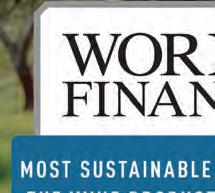

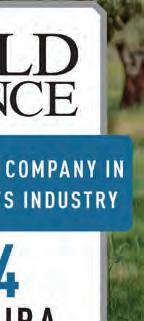


Creative consulting
Following a successful career heading up a division of the largest brewery in Switzerland, Thomas Bargetzi is now on a mission to help supercharge companies, following a strategic approach and incisive, hands-on management
INTERVIEW WITH Thomas Bargetzi
cEo, ThoMaS baRGETzI aG
ment this newly defined business approach, Bargetzi got together with three business colleagues and founded the Swiss Association for Interims Management (DSIM), where over 500 interim managers share experiences and advice for difficult situations.






Thomas Bargetzi, Founder and CEO of THOMAS BARGETZI AG, believes that success is the goal of all works, activities, or things you try to achieve, and the result of many little pieces of performance. “I get up in the morning to be successful, otherwise I stay in bed. Success is a mindset. This means you must be a leader, concentrated and focused on the matters you do, with the people you are working with!” he declares.
Bargetzi also believes that failure is the other side of success and that you can only become successful if you are ready to accept this fact. Likening success in sports to success in life, where sometimes you win and sometimes you lose, he notes that in life, you simply need to win one more time than you lose, which means you have won!
Preparing for success
As a sports addict in his youth, Bargetzi intended to become a professional sportsperson, but his father urged him to get a basic university degree to have access to all the options he needed to perform in his business life, once his sports career was over.
Bargetzi considers this the best advice he ever got, and after he finished his sports career, he went through 13 years of further education, studying finance, management, business administration (an MBA at City University), a postgraduate in controlling, and two bachelors degrees in marketing and sales. Equally important for European operations, he speaks four languages fluently; English, French, German and Italian.
Having reached the top of a very big company, the Feldschlosschen Brewery in Switzerland, at the age of only 37, Bargetzi felt that there must be something else he could aim for, and that goal turned out to be defining a new business model.
you Simply Need To WiN oNe more Time THAN you loSe, WHiCH meANS you HAve WoN!
Bargetzi noticed that consultants often had very good ideas, plans, and strategies, but little or no idea about the best way to make them operationally successful. With this in mind, he defined the business model of ‘operational interims management,’ which involved taking charge of these ideas, defining them clearly and using one’s own talents to realise and achieve success in what others have planned.
Along with his website, www.bargetzi. com, where he describes how one can imple-
As the CEO and owner of his own restructuring/turnaround company, Bargetzi’s modus operandi when having a mandate in a company is to start with 10 days of operational analyses, going through each department, talking to many, many people, going out to visit customers to get their input, get the strategy, and understand the job. Bargetzi follows up by proposing what he would do. “If the customer accepts, I execute what I proposed. I collect as many facts, figures, and data to understand where we make and where we lose money. I then propose actions to achieve the goals,” he explains.
Dare to dream
Bargetzi’s plan for the future of THOMAS BARGETZI AG is to achieve 60 mandates, which means he has five more to go. He also plans to continue working until he turns 70 and to have as much fun as possible in business and his private life. As an avid sportsman, Bargetzi plays sports five days out of seven, mainly after work, to help digest what he has seen during his day. He also finds that movement is the best way to restore and recharge his batteries.
Bargetzi also has his eye on the new generation, hoping to inspire and guide those who will follow in his footsteps. Bargetzi hopes to convey more than ever that “everything is possible. You simply must watch out, try things, be smart, fast, and dare to fail.” n
162 | Summer 2024
strategy Management

Leading the digital transformation
An in-depth examination of how Moldcell’s CEO Carolina Bugaian’s empathetic leadership is shaping the company’s ‘Digitally Human’ customer-centric telecoms, writes Moldcell
Carolina Bugaian’s professional path is marked by her exceptional ability to navigate data intricacies, the relentless pursuit of knowledge and care for people. Joining Moldcell as Financial Director in 2006, she became the company’s first female executive in this pivotal role. Over 13 years, Bugaian took on crucial responsibilities, including leading the finance department of a telecom company in Nepal from 2013 to 2016.
Being a chartered accountant and internal auditor, Bugaian has a PhD in Economics, a Global Business MBA from Oxford-Brookes and specialised training in FinTech from Harvard. With this wealth of educational experience, Bugaian’s elevation to Moldcell’s CEO two years ago marked a transformative era. This move ushered in initiatives that solidified the company’s reputation as a sustainable business aspiring to put technology in the service of human beings.
In today’s dynamic business landscape, characterised by rapid change and technological leaps, leaders like Bugaian are the driving force behind transformative shifts. Her recent recognition in the European CEO Awards 2024 underscores her pivotal role in Moldcell’s evolution into a pioneering ‘Digitally Human’ enterprise.
Bugaian’s leadership blends technological innovation with empathetic strategies, rede-
fining the telecommunications landscape.
From her roots as an auditor to her current position as a promoter of digital innovation, Bugaian’s trajectory epitomises a fusion of financial acumen, global experience and deep market insights driven by human touch. What sets her apart is a combination of pragmatism and empathy that brings meaning to Moldcell’s mission and sets the course for its future. Her strategic vision, combined with a deep commitment to digital empowerment and human-centric values, has not only distinguished Moldcell but also set new standards in the global mobile telecommunications
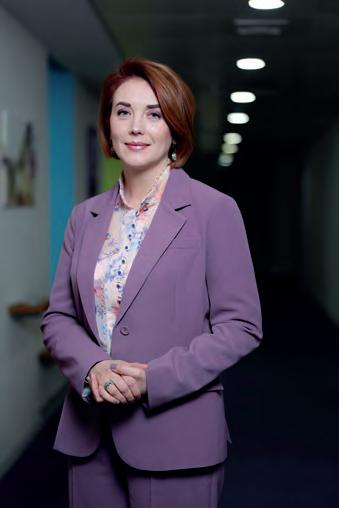
“moldcell’s vision focuses on promoting digital literacy and inclusion among all segments of society”
Transcendent tech
In a competitive and dynamic sector where digital innovation stands at the forefront, fostering transparency, open dialogue, and customer-centric collaboration is absolutely critical for success, and this is where Bugaian’s leadership ethos resonates most. A profound grasp of evolving client and employee aspirations is needed and Bugaian’s philosophy transcends technology’s mere utility, focusing instead on leveraging it to enrich lives and foster community bonds. Moreover, effective communication and transparent decisionmaking form the bedrock of her approach. By championing open discourse and ensuring information accessibility, she harnesses the team’s diverse perspectives and expertise to tackle complex challenges and propel business growth.
Transparency, sincerity and empathy are the hallmarks of Bugaian’s style. These attributes have propelled Moldcell to global acclaim for its investments in employee well-being, earning accolades in the People & Culture category at the World Communication Awards in Amsterdam. Under her stewardship, Moldcell’s purpose to “bring the whole world into your hands so that you could enjoy life even more” reflects a commitment to inclusivity and social responsibility.
With these strategies in place, Moldcell is entering fresh territory, expanding its market reach and solidifying its position as a ‘Digitally Human’ operator. In addition to technological advancements, Bugaian has placed a strong emphasis on customer-centricity and experience. Moldcell’s vision focuses on promoting digital literacy and inclusion among all segments of society, ensuring that Moldcell’s services are accessible and beneficial to everyone.
Bugaian’s impact on Moldcell’s success in the last two years has been undeniable. Her focus on innovation, customer-centricity, and social responsibility has not only driven Moldcell’s growth but also positioned it as a leader in a new and exciting era of telecommunications. Bugaian’s vision foresees a future where digital access transcends barriers, empowering individuals of all backgrounds to thrive in the digital age, and her achievements and contributions continue to shape Moldcell’s journey towards continued excellence and a positive impact on the industry. n
strategy Management Summer 2024 | 163
Carolina bugaian, moldcell Ceo

164 Summer 2024



THE BEST OF TiMes?
Corruption scandals and skyrocketing costs have put many cities off the idea of ever hosting the Olympic Games. But as Paris prepares for a slimmed-down, budget-friendly Olympics, the historic games could be on a new path towards profitability. Rachel Richards reports »
Summer 2024 | 165
olding an Olympic Games means evoking history,” said Pierre de Coubertin, the founder of the modern games as we know them today. On a fateful evening in 1894, Coubertin proposed a revival of the ancient sporting event, which had been confined to the history books for nearly 1,500 years. Setting out his vision to unite the world through sport, Coubertin imagined a future where the world’s major cities would step forward to host the competition – and in 1896 his hopes became reality. The Olympic Games were reborn in Athens, and sporting history was made.
Since then, 23 cities have played host to the summer Olympic Games. The appeal is plain – hosting the Olympics is a surefire way for cities to announce themselves on the global stage. For a few short weeks every four years, the eyes of the world are focused on one specially selected location, giving nations a prime opportunity to showcase their culture, traditions and perspectives to the world. In 1988, the Seoul Olympics helped to accelerate South Korea’s transition to democracy, while the 1992 Olympics completely revitalised the city of Barcelona, creating two miles of beachfront and a five-kilometre seafront promenade which have come to define the modern Catalan capital.
Staging the Olympics can have a truly transformative impact on cities. When managed well, hosting the games can increase tourism, boost local economies, and create a sense of community cohesion and wellbeing. Poorly managed events, meanwhile, can push host cities into fiscal black holes. Over the past few decades, escalating costs have somewhat dampened interest in hosting the games, with some cities dropping their bids after closer inspection of the anticipated balance sheet. There is no doubt that hosting the games comes with a hefty price tag, and cost overruns have become par for the course. The Olympics is in real danger of losing its appeal to potential host cities – and it is clear that something needs to change. That is where Paris 2024 promises to be different.
Breaking the bank
A century has passed since Paris last hosted the Olympic Games, and the city of love is once again gearing up to welcome another summer of sport. As final preparations are put in place, the French capital appears to have pulled off the impossible – it hasn’t blown its budget.

By minimising new construction and maximising the use of existing infrastructure, the city is on track to deliver the cheapest Olympic Games in decades. Most of the games’ events will be held in existing stadiums, all of which are well served by public transport, reducing the need to undertake costly and time-consuming construction projects.
Elsewhere, historic sites will be temporarily repurposed into sporting venues, with Les Invalides set to provide a stunning backdrop to the event’s archery and para archery competitions, and Place de la Concorde to play host to BMX freestyle and skateboarding showdowns. A temporary outdoor arena will allow the Château de Versailles to host the games’ equestrian events, and beach volleyball will be played at the foot of the Eiffel Tower. In total, an impressive 95 percent of events will take place in existing or temporary structures, as the city looks to establish a new model for the Olympic Games.
This radical, low-carbon, low-build approach is a deliberate departure from previous events. For many, the Paris approach represents a muchneeded reset for the games. Over the last 50 years, the cost of hosting the Olympic Games has skyrocketed. Spending has spiralled out of control, and host cities
are too often left burdened with debts once the Olympic torch has moved on.
There are a number of factors behind these ballooning budgets. The first is quite simple –as the games themselves have grown, so have the costs. Over the past half a century, the number of teams and athletes attending the Olympics has almost doubled, and the number of events has steadily increased. At Tokyo 2020, 339 gold medals were up for grabs across 50 sporting disciplines – a far cry from the 43 gold medals and 10 sporting events at the first modern Olympics back in 1896. More competitors ultimately means more people to house and more mouths to feed, with athlete villages coming to resemble small cities in their own right.
The addition of new sporting disciplines has made the Olympics a more inclusive place, opening up the door to athletes from less mainstream sports, and boosting female participation in the games. But these new sports – competition climbing and skateboarding among them – also require high-quality specialised venues, which most host cities will need to construct from scratch.
More athletes and more sports might make for an entertaining Olympics, but the growth of the competition has put increasing strain on host cities. Here, Paris is once again determined to be different. The city will be reducing the number of events held over the course of its 17-day games – marking the first reduction in Olympic events since 1960.
166 | Summer 2024 Going for Gold
ThE GroW Th oF ThE CompETITIon h A s puT
E A sInG
A In on hosT CITIEs”
“
InCr
sTr

The security bill
For many, the Olympic Games symbolise peace and global unity. But the high-profile nature of the competition has sadly made it a target for terrorism. In 1972, tragedy unfolded at the Munich summer Olympics, when gunmen killed 11 members of the Israeli national team. The incident had a profound impact on the approach to security at the games, and made event organisers acutely aware of the threat of terrorism at large-scale sporting events. In 1996, the games were once more devastated by violence, when a pipe bomb exploded in a crowd at Atlanta’s Centennial Olympic Park, killing one person and injuring over 100 more.
The terrorist attacks of 9/11 raised the threat of terrorism around the globe. Security at global mega-events suddenly became paramount, and spending on Olympics safety precautions quickly began to escalate in the post-September 11 era. In 2012, London’s security bill is thought to have ballooned to over £1bn, as event organisers initially underestimated the number of staff needed across its venues. More than 2,000 army reserves were called in to beef up security, with over 23,700 security staff ultimately needed to police the event. Since then, host cities have routinely racked up significant security bills, as threat levels remain high.
In addition to terrorism and potential violent disruptions, event organisers are now facing a new security risk: cyber attacks.
95%
Of events will take place in existing or temporary structures
£1bn
The cost of security for the London Olympics in 2012
£320m
The cost of private security at Paris 2024
$1.6bn
The debt incurred by Montreal for the 1976 games
172%
The average cost overrun for the Olympics
“ThE pA r Is A pproACh r Epr EsEn Ts A muChn EEdEd r EsET For ThE GA mEs”

During Tokyo 2020, security staff thwarted more than 450 million attempted cyber attacks, while a successful incident at the 2018 Pyeongchang Winter Olympics came close to shutting down the opening ceremony. Largescale sporting events have become prime targets for cyber threats, due to both their global profile and their increasing reliance on digital infrastructure. Venue Wi-Fi networks, app-based ticketing systems and credential scanners are all vulnerable to attack, and if compromised, could bring an event grinding to a halt. Such an attack – as narrowly avoided at Pyeongchang – would prove as costly as it would disruptive.
Paris is on high security alert ahead of the Olympics. The French capital has experienced some of the most deadly terrorist attacks in modern European history, and the 2015 Bataclan musical hall massacre looms large in the national consciousness. April’s IS-claimed concert hall attack in Moscow has further added to security concerns, while recent threats made on a pro-IS media channel have caused growing unease. Amid these mounting anxieties over safety, the President of Paris 2024 has sought to reassure attendees that security is the games’ top priority. In an interview with BBC Sport, Tony Estanguet stressed that the event will be taking place under an “unprecedented” security protocol, with over 2,000 private security agents joining 40,000 police and gendarmes to provide enhanced protection across the games.
While Estanguet insists that the budget remains balanced, this additional security comes at a cost. Paris 2024 will be spending £320m on private security – but delivering a safe and secure summer event may ultimately prove priceless.
The good, the bad, and the costly For better or for worse, each Olympics host city leaves its own lasting legacy. Some go down in history for all of the right reasons, while others live on in infamy due to mismanagement, corruption and controversies. Sydney’s Olympic legacy continues to live on, almost 25 years after it pulled off one of the best ever games. Montreal, meanwhile, is routinely held up as a cautionary tale for prospective hosts, after the 1976 games left the Canadian city $1.6bn in debt.
When Montreal’s winning bid was announced, confidence was high. With the initial budget coming in at a modest £65m, the city looked forward to an economic windfall during the games. Montreal mayor Jean Drapeu even claimed that “the Olympics can no more lose money than a man can have a baby.” This early optimism was profoundly misplaced. Construction costs quickly ballooned, and poor project management resulted in lengthy delays to the erection of the Olympic Park. Union strikes and cost inflation further slowed delivery, and the opening ceremony was forced to take place in an incomplete stadium. When construction finally
Summer 2024 167 Going for Gold
»
completed, Montreal’s Olympic budget was 13 times more than originally predicted. The city was saddled with $1.6bn in debt, which took until December 2006 to fully pay off. In the years that followed, a number of fraud and corruption charges were brought against top officials and contractors, and an official inquiry was launched into the disastrous costs of the games.
To this day, Montreal continues to feel the effects of the summer 1976 games. Public services suffered for decades as the city grappled with the Olympics debt burden, with city hall pushed to the brink of financial ruin. The ‘Big O’ Olympic stadium has become an undeniable feature of the Montreal cityscape, but costs C$32m each year to operate and maintain. Earlier this year, the Quebec government announced that it would spend a further C$870m to repair the stadium’s dilapidated roof – a mammoth renovation that will take four years to complete.
Montreal may be the most infamous example of Olympics mismanagement, but it certainly isn’t the only host city to struggle to balance the books once the games have moved on. The final bill for Athens 2004 is thought to be an eye-watering $11bn, and helped push Greece towards bankruptcy in the wake of the global financial crisis. Rio de Janeiro’s 2016 summer games left Brazil with a $32m debt pile – which has risen to an astonishing $113m in the years since.
According to research carried out by Oxford University, the average Olympic Games experiences a cost overrun of 172 percent, with inadequate cost estimates, poor contingency planning and mission creep all contributing to skyrocketing final bills.
For many cities, the financial burden of hosting the games simply outweighs any short-term benefits it might bring. Interest in holding the prestigious competition has waned in recent years, and public spending has grown ever more constrained in a postCovid world. Rome, Hamburg and Budapest all withdrew their bids to host the summer 2024 games, leaving Paris and Los Angeles as the only remaining candidates. As bids and enthusiasm dwindle, the Olympics desperately needs to find a path to profitability – and the solution may not be as complex as commonly supposed.
Going for glory
After the financial debacle of the Montreal 1976 Olympics, hosting the games became an unpopular gig. Los Angeles was the only city to bid for the 1984 event, and despite the doubters and naysayers, the city achieved the seemingly impossible – it pulled off the first profitable Olympics since 1932. The city’s strategy was simple: low build, low spend and

with the famous Pasadena Rose Bowl and majestic LA Memorial Coliseum both reused after featuring in the 1932 LA Olympics. Just two new venues were constructed specifically for the 1984 games, and were made possible by generous corporate sponsorships from 7-Eleven and McDonalds. The private sector picked up the tab for the state-of-the-art communications infrastructure required for the summer’s events, and broadcast deals brought in a healthy stream of income for the city. The organising committee sold the television broadcast rights to ABC for $225m, marking one of the most expensive deals in the history of televised entertainment.
sector sponsorship, but also rejects excess in favour of using existing venues and infrastructure. It shows that spending big is no guarantee of success, and that hasty, expensive construction projects are often more trouble than they are worth.
“ov Er ThE
pA sT FEW
While critics at the time bemoaned the over-commercialisation of the Olympic Games, the private sector support at Los Angeles 1984 saw the city turn a tidy profit of $223m. The Olympics windfall allowed the organising committee to establish the LA84 Foundation, a non-profit that promotes youth sports opportunities across Southern California, ensuring a lasting legacy for the event.
dECA dEs, EsCA l ATInG
CosTs h Av E somEW h AT dA mpEn Ed
In TEr EsT In hosTInG ThE GA mEs”
But the impact of Los Angeles 1984 extends much further than the city itself. The event showed the world that a profitable Olympic Games is possible –
In the years that followed, however, the world turned its back on the Los Angeles Olympics blueprint. Overspending once again became the norm, with cities falling back into the trap of white elephant vanity venues and poor legacy planning. That is, until Paris. The French capital is looking to reverse the trend of cost overruns and blown budgets, and is wholeheartedly embracing private sector funding. In total, private funding will cover an impressive 96 percent of the cost of the Paris Olympic and Paralympic Games, with public authorities left to cover just four percent of the bill. With the French state well cushioned against costs, this could be the first Olympics to officially break even since the year 2000.
A new era
In 1896, a millennia-old tradition was revived and reinvented for a new age. In 2024, the Olympic Games are undergoing another profound transformation. The days of pure spectacle and excess are over, replaced by a new focus on financial, social and environmental sustainability.
“We want the legacy to be different,” Olympics Chief Tony Estanguet explained in an interview with Time. “Not a legacy of having
168 | Summer 2024 Going for Gold
»


The olympics attract millions of spectators
fantastic venues, but how this project can help
Just two new purpose-built venues have been constructed for the Paris Games, and both are specifically located in lower-income areas of the city. The Porte de la Chapelle Arena, known as the Adidas Arena after its corporate sponsor, has been built in one of Paris’ most deprived neighbourhoods. Far from the bustling tourist hotspots of central Paris, the Porte de la Chapelle sits to the far north of the city centre, and has long been associated with drug dealing and crime. The new stadium is a key part of the Olympic Committee’s urban regeneration strategy, and looks to kick-start a programme of further renewal and redevelopment in the disadvantaged neighbourhood. New apartments are set to be built in the area, with 35–50 percent of units earmarked for social housing. Once the games have moved on, local schools and clubs will be able to make use of two onsite gymnasiums at the Adidas Arena, in an effort to boost sports participation in the area.
A few miles north, on the other side of the Paris périphérique ring road, a state-of-theart aquatics centre has been built in the lowincome neighbourhood of Saint-Denis. One of the poorest départements in the Greater Paris area, over a quarter of Saint-Denis residents live below the poverty line. The regeneration of this much-maligned area was at the very heart of Paris’ winning bid to host the Olympics, and many have high hopes that the games will help to fast-track further investment into the neighbourhood.
Along with the new, eco-friendly aquatics centre, Saint-Denis will also be home to the Olympics Village, welcoming 14,000 athletes over the course of the games. And once the Olympic torch has moved on, the village will be transformed into housing for up to 6,000 people – with a quarter of those homes reserved for public housing.
This programme of regeneration and investment may not be a silver bullet for Paris’s poorer neighbourhoods. But it does demonstrate a clear ambition to leave a lasting legacy of inclusive growth – and the games could prove to be a much-needed catalyst for change. Aside from its commitment to urban renewal, the Paris Olympics Committee is also dedicated to delivering the ‘greenest-ever’ games. Organisers have promised to halve the carbon footprint of previous games, and have vowed to double the amount of vegetarian food on offer at venues, in a sustainable approach to feeding athletes and spectators. The games’ limited construction has primarily used natural, bio-based building materials,
“ W E WA n T To dEmonsTr ATE Th AT pA r Is A nd Fr A nCE CA n dElI v Er A GA mEs In A dIFFEr En T WAy ”
and the Olympics Village will be powered by geothermal and solar energy.
“We want to demonstrate that Paris and France can deliver a Games in a different way than in the past,” Estanguet said in an interview with BBC Sport. Paris is setting the stage for a new wave of cost-effective, low-carbon and low-build Olympic bids. Its slimmeddown approach has, so far at least, proved better for the budget and better for the planet, and its legacy planning seeks to kick-start positive change for the city’s most disadvantaged citizens. As tourists flock to the French capital in their millions, Paris could take in up to $12.2bn over the course of the event, according to predictions by the International Olympic Committee. If it is able to pull this off, the city may just turn the Olympics from financial burden to economic boon.
The stage is set for a truly momentous event. And away from the excitement and spectacle of the medal ceremonies, the city of Paris may just emerge as the greatest winner of all. n
Summer 2024 | 169 Going for Gold
Number of tickets sold for the past six summer Olympic games 6.7m Sydney 2000 3.6m athens 2004 6.6m Beijing 2008 8.2m london 2012 6.2m Rio de Janeiro 2016 4.5m Tokyo 2020 SouRcE
Statista, Ioc
Finance
World
The Econoclast

 David Orrell auThoR aND EcoNoMIST
David Orrell auThoR aND EcoNoMIST
Grow your own
Canada is trying to bump up its population growth through immigration amid dwindling birth rates, but a better economy doesn’t equate to a larger one and this approach could prove to be no more than an economic stopgap
This article is about the economic effects of immigration, so as a Canadian citizen, let me begin with the customary acknowledgement that I am totally pro-immigrant! Yes I was born in Canada, but my parents were immigrants. My wife is an immigrant. Even one of my daughters was born outside the country and technically immigrated. And immigration is a difficult subject anywhere because politicians often deflect problems by blaming them on migrants.
Anyway, now that is out of the way, and purely from the point of economics – why is Canada trying to ramp up its population growth through immigration? In 2023 the rate was 3.2 percent, which was the highest in the OECD.
The usual argument put forward by economists in favour of boosting immigration is that we need young workers to support all the Boomers who are collectively easing into what looks like being a very expensive retirement. There is huge demand for workers in sectors such as agriculture, construction, healthcare, and so on – jobs which are often eschewed by locals because the pay is low.
However, the availability of cheap immigrant labour means that firms have less incentive to invest in productivity-enhancing machinery – which helps explain why Canadian productivity has slid in recent decades to about 72 percent of that of the US.
And of course immigrants age and retire and bring in older family relatives themselves, so immigration might give a temporary boost to the work force but is not a viable long-term solution. Finally, immigration may be contributing to the problem it is supposed to solve.
According to Statistics Canada, 32 percent of Canadians in their 20s “did not believe they could afford to have a child in the next three years” due to lack of “suitable housing.” This might explain why Canada’s birth rate has
plummeted to 1.33 births per woman, which is nowhere near the replacement number of 2.1. But excessive levels of immigration boost inflation and competition for scarce housing, which will make finding rooms for babies even less affordable.
Another reason put forward for the low birth rate is anxiety about things like climate change. Some young couples are reluctant to bring children into a world they see as being on the edge of environmental catastrophe. Since Canada is one of the highest per capita greenhouse gas emitters on the planet, growing its size also directly damages the environment. So what is going on?
We juST doN’T HAve eNouGH HouSiNG. iT iS juST A mATHemATiCAl THiNG – CANAdA HAS THe FASTeSTGroWiNG populATioN iN THe G7
Buy my house
There is also another economic reason why some governments want to maximise immigration, which is that in theory it supports house prices. After all, as they say, immigrants don’t carry houses on their backs when they come in. And house prices are very important to debt-addled Canadians (ratio of household debt to GDP highest among the G7 countries).
As Finance Minister Chrystia Freeland previously explained, “The core problem with housing in Canada is we just don’t have enough housing. It is just a mathematical thing – Canada has the fastest-growing population in the G7.”
To homeowners, that decodes to: house prices will go up! Our investments (and retirements) are safe! This is especially useful given that much of Canada’s economy is based on real estate – from realtor fees to financing to insurance to construction.
But (speaking as a quantum economist) Freeland was using the wrong kind of math. The housing boom which underpinned the economy over the last few decades had less to do with population growth than with declining interest rates; and just as immigrants don’t come in bearing houses, most of them don’t also come in bearing massive downpayments. So the fact that we have a housing shortage doesn’t necessarily translate to higher prices – it might just mean that people have to pack themselves into smaller spaces (ask an international student in one of our overcrowded university towns).
From a purely economic standpoint, immigration does boost the total size of the economy – if you double the population then the economy is twice as large – but what is the point? A better measure is quality of life, which is a separate thing – and according to metrics such as per capita GDP is in decline. The whole approach seems outdated in a world where what matters (or should matter) from an economic perspective isn’t headcount or house prices but things like technology, innovation, resources, and environmental protection.
These problems are of course not limited to Canada, which is why housing, immigration and climate change are huge political issues in countries such as the UK, Australia, New Zealand, France, and so on. And why economics Nobel winner Angus Deaton wrote in March 2024 that he no longer subscribes to what he calls the “near consensus among economists that immigration to the US was a good thing.”
The reality is that immigration is great in moderation, and enriches us in many ways (not just economic), but it is not an all-ornothing binary choice.
If a country like Canada wants a better economy in the future, as opposed to just a larger one, then maybe it is time to focus a little more on growing its own. n
170 | Summer 2024




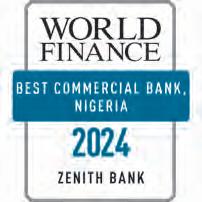
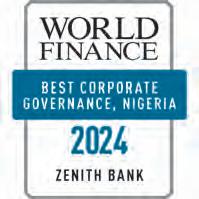

















AFRICAN ROOTS, WORLD CLASS SERVICE. PEOPLE | TECHNOLOGY | SERVICE












































 Raman Bhatia CEO
Starling Bank
Raman Bhatia CEO
Starling Bank
 Manmohan Mahajan CFO Walgreens Boots Alliance
Manmohan Mahajan CFO Walgreens Boots Alliance


































































 Bremmer
Bremmer













 Lawrence Summers
chIEF EcoNoMIST
Lawrence Summers
chIEF EcoNoMIST








































































































 WORDS BY Frank Van de Vel
chIEF INVESToR SuppoRT oFFIcER, Kbc aSSET MaNaGEMENT
WORDS BY Frank Van de Vel
chIEF INVESToR SuppoRT oFFIcER, Kbc aSSET MaNaGEMENT





































































 WORDS BY Scott Rouse FEaTuRES WRITER
WORDS BY Scott Rouse FEaTuRES WRITER






























































































 WORDS BY Kai Haakon E. Liekefett paRTNER, SIDLEY auSTIN LLp
WORDS BY Kai Haakon E. Liekefett paRTNER, SIDLEY auSTIN LLp


























 WORDS BY Glen Wilson
WORDS BY Glen Wilson



































































 David Orrell auThoR aND EcoNoMIST
David Orrell auThoR aND EcoNoMIST













